“It is so difficult to find the beginning. Or, better: it is difficult to begin at the beginning. And not try to go further back.”
—Ludwig Wittgenstein[1]
Only through the lens of a philosopher at war with himself can we understand a game at war with itself.[2]

Photograph of Wittgenstein at Swansea, Summer 1947. Taken by Ben Richards. (Source.)
Xenoblade Chronicles 3 does not exist in series with Xenoblade Chronicles and Xenoblade Chronicles 2: it exists in conversation with them. Where the worlds of Bionis, Mechonis, and Alrest invite Shulk, Rex, and the player to challenge clear and rigid pictures of how the world works, Xenoblade Chronicles 3 invites Noah, Mio, Eunie, Taion, Lanz, Sena, and the player into Aionios with a more basic question: is a picture the right way in which to understand the world at all? In so doing, it sets its heroes on a journey to understand and overcome a deeply human impulse that imprisons real gamers just as much as it imprisons Noah, Mio, and their friends: the impulse to feel safe in an unsystematically diverse world by imposing artificial, untenable limits on our position, capacity, and relationships within that world.
My earlier work on the franchise reads Xenoblade Chronicles as a representation and repudiation of Leibnizian metaphysics, and Xenoblade Chronicles 2 as a representation of Platonic metaphysics and the cultivation of a Platonic philosopher-king.[3] To understand a game that poses a more basic philosophical question and compels us to challenge our own views, along with our very nature, in order to answer it, I want to convince you that we are again best served by looking to philosophy as a cipher, but that we need to look to a different kind of philosopher with a different kind of philosophy: Ludwig Wittgenstein, regarded by many as one of the most influential thinkers of the 20th century.

Portrait of Wittgenstein in 1929, on the occasion of his being awarded a scholarship from Trinity College. By Clara Sjögren. (Source.)
The influence of Wittgenstein’s philosophy is felt across the domains of logic, philosophy of language, philosophy of psychology, epistemology, philosophy of action, metaphilosophy, and probably most other philosophical areas you could think of. He widely published only one major written philosophical work in his lifetime, the Tractatus Logico-Philosophicus, which was a key influence in catalyzing the tradition of logical positivism in philosophy;[4] he later developed a radically different approach to language and philosophy, which he used to challenge many established philosophical works—including the Tractatus Logico-Philosophicus. Throughout his life, he wove in and out of roles—student, soldier, lecturer, architect, professor, gardener, elementary school teacher, engineer, research assistant—while wrestling with a deeply personal despair, recognizing salvation as crucial yet beyond him.
As Ray Monk said by way of framing his biography of him, it is possible to see in Wittgenstein a “unity of his philosophical concerns with his emotional and spiritual life.”[5] My claim is that this unity offers us a holistic lens through which to read Xenoblade Chronicles 3: by interpreting the game as a clash between two different perspectives derived from elements of Wittgenstein’s life and work, we can discover a meaning that ties its core conflicts, characters, and interactive content together as one. A Wittgenstein-inspired reading of Xenoblade Chronicles 3, I want to convince you, challenges us to reconsider the relationship between what we do in video games and how we think about them—not just in this game, but in games as a storytelling medium generally.

The title screen of Xenoblade Chronicles 3. All images screenshots from Xenoblade Chronicles 3 except where otherwise noted.
This study proceeds in 2 Parts, the first treating the antagonists of Xenoblade Chronicles 3 and the second the protagonists. The parts have parallel structures:
- I first compose a perspective on Wittgenstein by synthesizing elements of his work, views, and life for the purpose of literary interpretation—drawing connections along the way, through images, to allude to some of the moments and relationships in the game that particular elements of Wittgenstein will empower us to see in a new light.
- I then study how that perspective manifests itself through the characters of the game.
- I finally show the processes through which those characters enact the philosophy of the relevant Wittgenstein perspective upon and within their worlds.
Ultimately, we’ll see why the philosophical view and emotional impulse driving Moebius are all-encompassing, deeply relatable, seemingly inescapable, yet entirely self-undermining—and how the philosophical view and activity of Ouroboros present a therapy for everyone, including the player, to reintegrate that perspective into an enlightened empowerment that engages the diversity of the world rather than denying it.
I’d like to offer 4 editorial notes before we begin:
- From the next section onward, there will be spoilers for Xenoblade Chronicles, Xenoblade Chronicles 2, Xenoblade Chronicles 2: Torna — The Golden Country, Xenoblade Chronicles 3, Xenoblade Chronicles: Future Connected, and Xenoblade Chronicles 3 Expansion Pass: Volume 2. Our study most naturally begins with material very late in the story of Xenoblade Chronicles 3, so I recommend that you not read this until you have completed the game. More broadly, like Xenoblade Chronicles 3, this study can be read in the context of that game alone but operates within the context of all 3 games, so I especially recommend it to the reader familiar with the overall series. There are also minor spoilers for (1) the premise of The Legend of Zelda: A Link Between Worlds, (2) a single math class, without story content, in Pokémon Violet, and (3) the eponymous game mechanic in The Legend of Zelda: The Wind Waker.
- There are many different lenses through which one can view games as complex and nuanced as Xenoblade Chronicles 3, and I am by no means arguing that this is the only such lens, the best such lens, or the lens that was somehow literally intended by the game’s flesh-and-blood developers. My goal here is to show, to both you and myself, that reading Xenoblade Chronicles 3 as a conflict between two faces of Wittgenstein is one such lens, one that is especially holistic across the game and useful to players beyond the game. We’ll ultimately see that, far from silencing other interpretive approaches to gaming, the Wittgensteinian study encourages a diverse conversation of video-game-story interpretations in an unusual, healthy way.
- Wittgenstein himself was concerned with whether he and his work would be understood by anyone in his lifetime or beyond; he even doubted that he ever succeeded, in the first place, in expressing what he wanted to express.[6] As the Stanford Encyclopedia of Philosophy details, there are diverse, evolving, and disagreeing schools of thought regarding what Wittgenstein meant in works from basically any “period” of his life.[7] What I am doing here faces not only this core interpretive issue, but also two further difficulties: (i) I am interpreting a relationship between Wittgenstein’s life and his work, and (ii) I am using this synthesis of philosophical and biographical content as a framework for the interpretation of a separate literary work. The “Wittgensteins” with which we are working in this analysis are tools designed to help us read a story, not portraits of a flesh-and-blood man or a taxonomy of his work. My hope is that, by building these tools piece-by-piece in each Part, I will make clear to the reader the reasoning according to which we’re arriving at our perspectives on Wittgenstein from the man’s actual life and work.
- There are both textual and pragmatic reasons for the length and scope of this study. Textually, we are reading a game that, at least by my reckoning, is longer, with a greater diversity of narratively significant content, than its very long predecessors,[8] while also being in dialogue with the material from those predecessors; on top of that, we are treating this game not through the lens of a singular philosophical worldview, but rather through the interaction between two related-yet-distinct worldviews informed by the philosophy and biography of one person. Pragmatically, then, my hope is to sufficiently cite, illustrate, and explain the reasoning behind my view to really leave a player of Xenoblade Chronicles 3 with the feeling that the whole of the game fits within it in a useful way. This hope comes from a very personal need I have for an understanding of how the hundreds of hours spent playing the typical JRPG fit together as a single meaningful story.[9] I speak most directly, then, to those gamers who have felt that need in their own journeys through the medium; in Wittgenstein’s spirit, “I must be nothing more than the mirror in which my reader sees his own thinking with all its deformities & with this assistance can set it in order.”[10] In hopes of making the study easier to navigate (and an homage to Wittgenstein’s notation), I provide a table of contents below; the unique section numbers may be used to find specific sections within the study from the table of contents.
Table of Contents
§1: Part 1: The Alphabet of Thought
§1.1: Wittgenstein’s Amphitheatre
§1.11: What a Picture Does: Meaning in the Tractatus Logico-Philosophicus
§1.111: The Picture Theory of Language
§1.112: What Can Be Said, and What Can Be Shown
§1.12: Registers of Faith: Wittgenstein’s Challenge with Predestination
§1.13: Wars Within, and Wars Without
§1.14: Defining Wittgenstein
§1.2: Z’s Amphitheatre
§1.21: The God of Moebius: Z
§1.22: The Godhead of Moebius: X, Y, and Z
§1.23: The Confederates of Moebius: Recruits from Aionios
§1.231: Persecution of the Self: Joran and Shania
§1.232: Persecution of the Other: M and N
§1.233: The Game of Persecution: D, E, K, R, and V
§1.234: Quitting the Game: Triton and Crys
§1.24: A Visual Field Without Limit: The Endless Now
§2: Part 2: Freedom of Thought
§2.1: Wittgenstein’s Therapies
§2.11: What Games Do: Meaning as Use
§2.111: Language-Games: A “Reverse Instruction Booklet”
§2.1112: The Accessibility of a “Private” Language
§2.1113: No Walks to Infinity without Walking: Series and Rule-Following
§2.112: The River-Bed of Thoughts
§2.113: Ducks, Rabbits, and Other Aspects
§2.114: Philosophy as Therapy: The Choose-Your-Own-Adventure Tour Guide for Your Hometown
§2.12: A Fully-Loaded Toolkit of Interpretations
§2.121: Interpretations as Tools for Understanding Our Lives
§2.122: Absolute Safety: Interpreting the Believer’s Relationship with God
§2.13: Performing Life’s Score
§2.131: The Language of Music
§2.132: Pursuing Useful Forms of Life
§2.14: Defining Wittgenstein 2
§2.2: Ouroboros’ Therapies
§2.21: The Player and Absolute Safety
§2.22: Queens of Aionios, Architects of Trinkets
§2.23: Private Conversation: How Ouroboros Destroys the World
§2.24: Heroes’ Family Resemblance, and Colonies’ Cultures
§2.241: Zeon: Breathing a Form of Life into Roles
§2.242: Alexandria: Of Tool-Makers and Tool-Users
§2.243: Segiri: Therapy for the Mechanized
§2.244: Ghondor: Aspects of Motherhood
§2.245: Ino: How to Turn a Metaphysics into a Language-Game without Destroying a World
§2.25: Life’s Inevitability: The City and the Lost Colony
§2.26: Ending the Endless Now
§2.261: The First Chapter
§2.262: The Second Chapter
§2.263: The Third Chapter
§2.264: The Fourth Chapter
§2.265: The Fifth Chapter
§2.266: The Sixth Chapter
§2.267: The Seventh Chapter
§2.3: Enlightened Empowerment
§3: References
§3.1: Non-Game-Screenshot Images
§3.2: Video Games
§3.3: Written Works
§1: Part 1: The Alphabet of Thought
“Death is not an event of life. Death is not lived through.
If by eternity is understood not endless temporal duration but timelessness, then he lives eternally who lives in the present.
Our life is endless in the way that our visual field is without limit.”
—Ludwig Wittgenstein, Tractatus Logico-Philosophicus, 6.4311
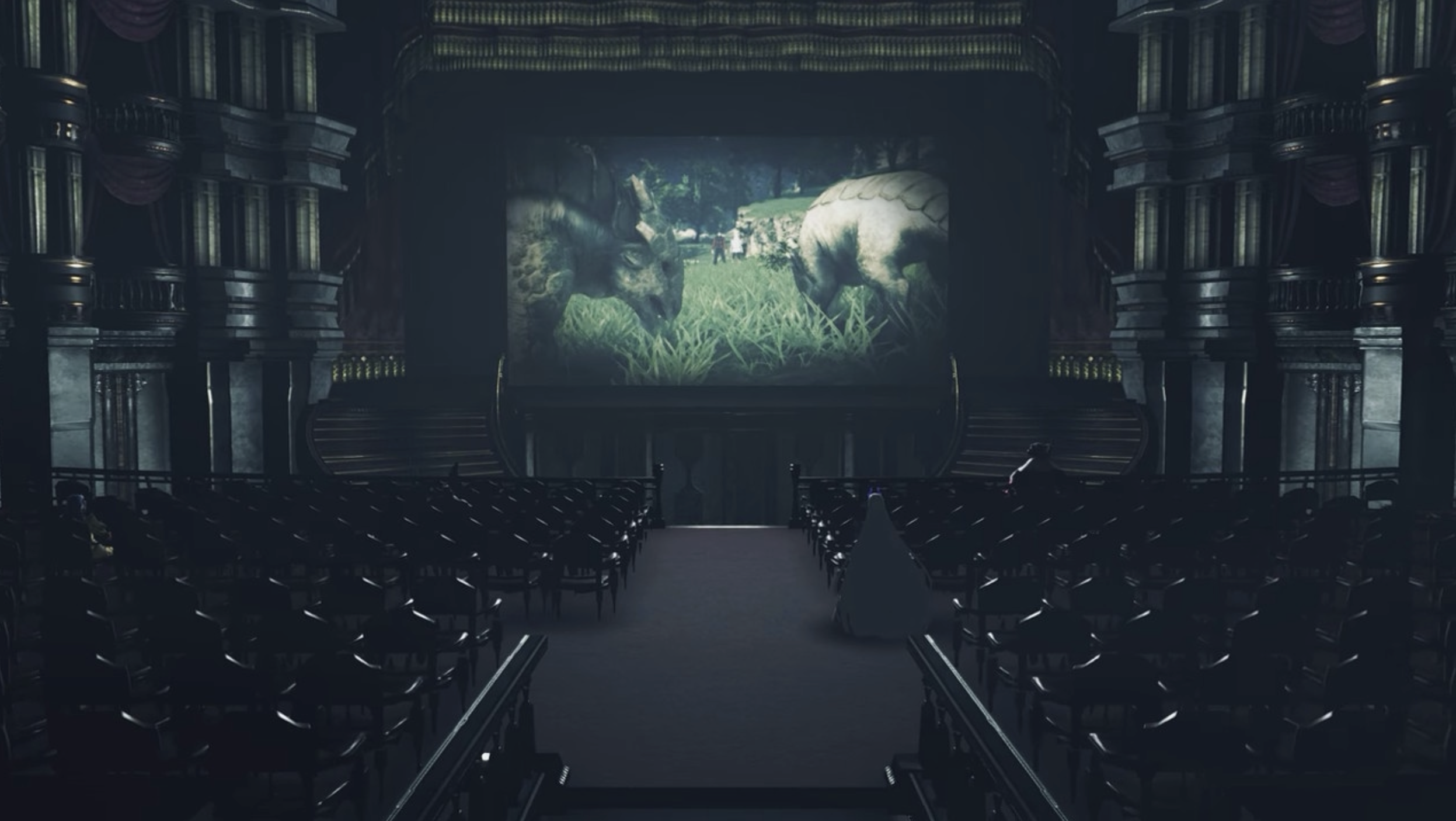
Z and other members of Moebius watching the progress of Ouroboros from the seats of the Amphitheatre.
Z and Moebius are unlike previous Xenoblade antagonists in 3 ways:
- Where Zanza and Malos were characters with relationships, histories, and multifaceted lives, Z is “not a person, but a concept.”[11]
- Where Zanza and Malos scheme and rail against the world alone, strutting and fretting their hour upon the stage, Z strategically brings others into his mode of existence “under the form of eternity,” welcoming not only secondary characters but also aspects of bona fide party members, Noah and Mio, into the fold of Moebius.[12]
- Where Zanza and Malos live out lives within the worlds of Bionis, Mechonis, and Alrest, Z surveys the world of Aionios from without: he confines himself to the Amphitheatre and influences the rules according to which events unfold within the world, rather than influencing events as an actor within the world.
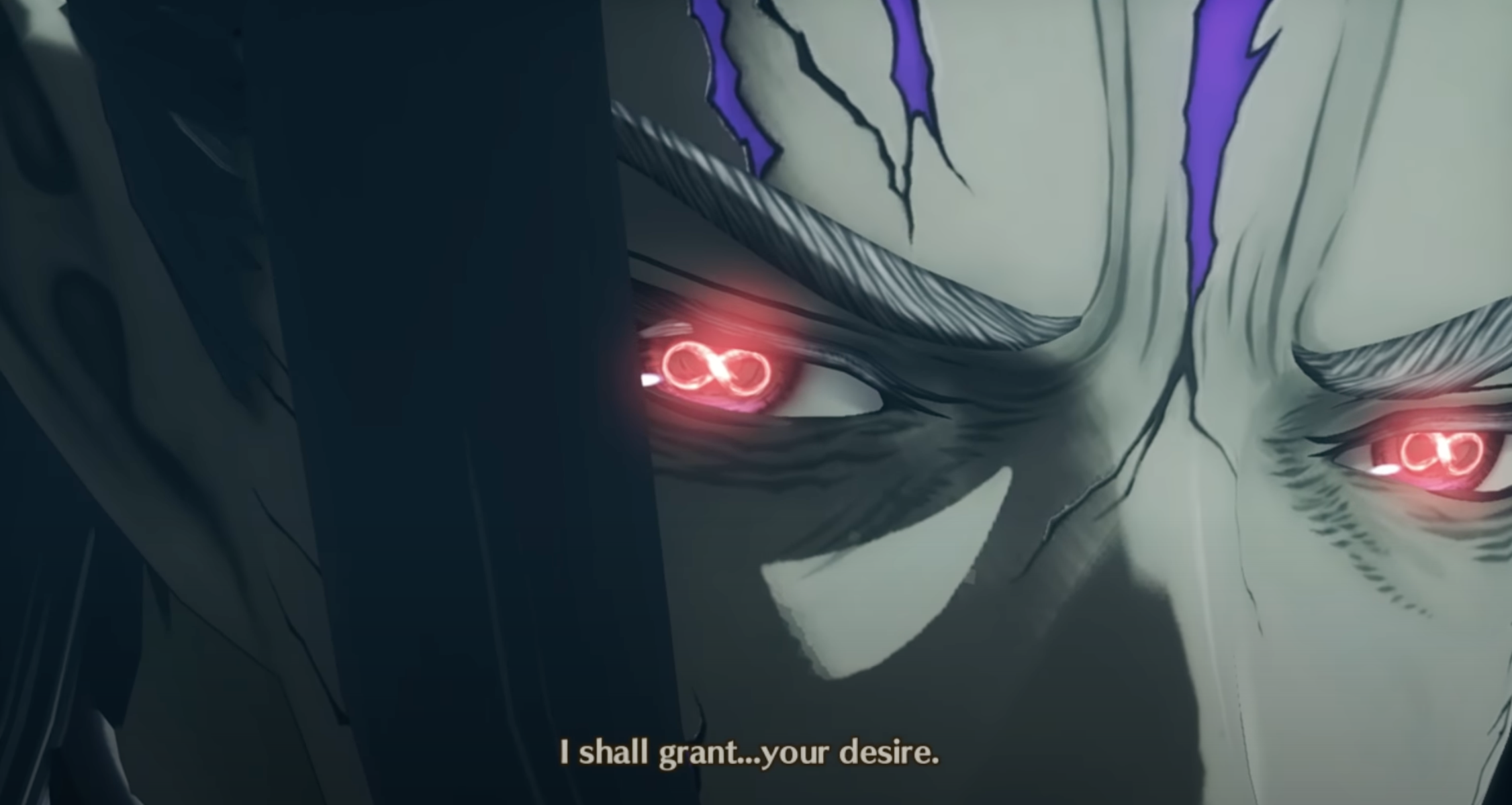
Z speaking to Noah in the Amphitheatre, before Noah became N.
In Part 1, I want to convince you that these 3 characteristics of Z shape him into a hauntingly relatable antagonist in which not only the party members, but also the player, recognize aspects of themselves. The relatability, I argue, establishes through Z a worldview that philosophically mirrors the prison of the “Endless Now” imposed upon Aionios, a worldview that marries 3 threads of Wittgenstein:
- Core views from the Tractatus Logico-Philosophicus, particularly the picture theory of language and the distinction between what is said and what is shown.
- Wittgenstein’s later efforts to understand the religious notion of predestination, especially in the form of election by grace taught by Paul in the Epistle to the Romans.
- Wittgenstein’s personal, lifelong struggles against despair in war and intimate relationships.
I begin by outlining the 3 above threads of Wittgenstein and weaving those threads together into a Wittgenstein-inspired model that we can use for our subsequent literary analysis, a model which I call ‘Wittgenstein 1’ to contrast with Wittgenstein 2, the model I set against it in Part 2. With that in place, I sketch a picture of how we can understand, successively, (1) Z, (2) X and Y, and (3) the Aionian Consuls as aspects of a singular, unified Moebius embodying the perspective of Wittgenstein 1 upon Aionios. I then illustrate how the anatomy of that world called “eternity”[13] is a product of Wittgenstein 1’s process: the Endless Now, a seemingly impregnable activity of enforcement that prevents its victims from seeing anything beyond the Wittgenstein 1 perspective.
We’ll see through a side-by-side study of the philosopher and the game why this worldview would be alluring to members of Aionios like Noah. We’ll see, too, why it would be enticing to the player—and why, therefore, it’s so pressing and personal a challenge for the player to overcome this worldview.
§1.1: Wittgenstein’s Amphitheatre
My overarching claim in my study of Xenoblade Chronicles 3 is that Wittgenstein’s life and work can provide a unified way in which to see, play, think about, and talk about this game. To reach that conclusion, I want to show you a view according to which the main protagonist forces and antagonist forces of Xenoblade Chronicles 3 represent two different personal and philosophical perspectives on Wittgenstein in conflict with one another.
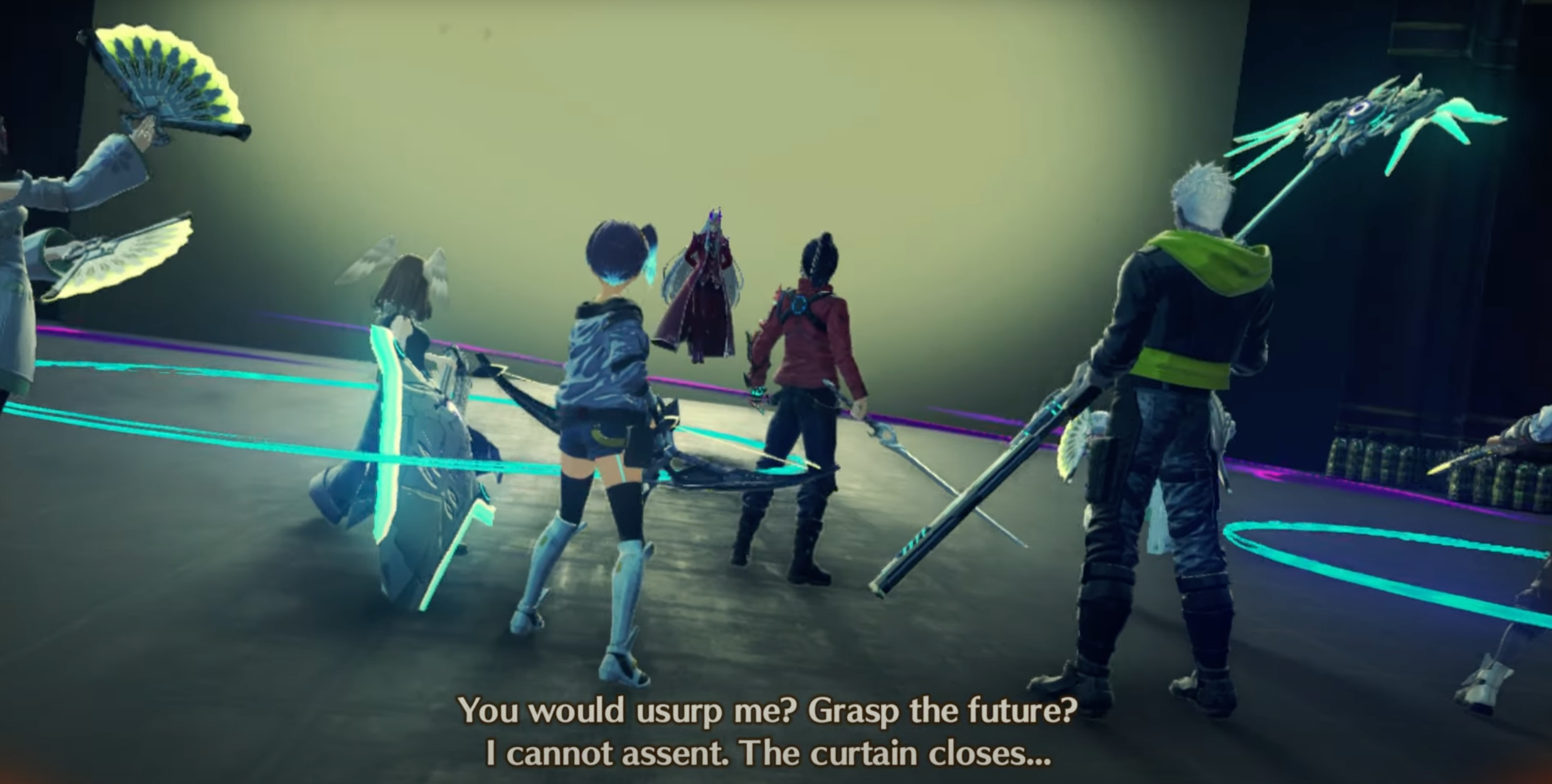
Z rejects Ouroboros’ attempt to change the world.
By ‘perspectives’, I mean representations of Wittgenstein that roughly correspond to different stages, focuses, and styles of his work. Scholars often—though certainly not always[14]—speak of an “early Wittgenstein” and a “later Wittgenstein,” corresponding, respectively, to (1) Wittgenstein’s views, focus, and style in the Tractatus and (2) Wittgenstein’s views, focus, and style in his later Philosophical Investigations.
I think that the interesting Wittgensteinian foundation to the story of Xenoblade Chronicles 3, upon which plots and themes are constructed, is the pitting of early Wittgenstein against later Wittgenstein. However, these representations are rough not only in the sense of ‘early Wittgenstein’ and ‘later Wittgenstein’ being interpretive and controversial terms, but also because I am introducing other elements of Wittgenstein into those representations that do not coincide in timeline with the work often attributed to early and later Wittgenstein: biographical elements, as well as cultural, religious, and aesthetic views, selected from across the entirety of his life. All the same, I think that these two perspectives possess a sense of thematic coherence anchored by the philosophical views of early and later Wittgenstein; I introduce these other elements to capture distinct motives and characteristics visible in Wittgenstein’s life, analogous to the despair and hope of Moebius and Ouroboros, that inspire these philosophical views in compelling ways that are useful for applied artistic interpretation, even as the perspectives diverge from Wittgenstein’s biography and chronology.
With that said, for ease of reference—and so as not to reduce these perspectives on Wittgenstein to the concepts of “early Wittgenstein” and “later Wittgenstein”—I’m going to call the first of these perspectives, which I sketch below, ‘Wittgenstein 1’, and the second perspective, which I sketch in Part 2, ‘Wittgenstein 2’. In both sketches, I proceed in the order of addressing first his philosophical work, then his broader intellectual views outside of what is typically seen as his “work,” and, finally, biographical elements of Wittgenstein. In the case of Wittgenstein 1, this moves from the Tractatus Logico-Philosophicus to his views on predestination and concludes with his personal sense of despair, as related to his involvement with war and intimate relationships.

Wittgenstein’s military identification card from World War I. From the Vienna Kriegsarchiv. (Source.)
In the spirit of not only showing my inferential steps but also making Wittgenstein 1 a wieldy tool for studying Xenoblade Chronicles 3, my process advances in three steps:
- I provide the relevant data of Wittgenstein’s work or life.
- I derive from those data 8 slogans, propositions that represent our interpretation of the data and which Wittgenstein 1 would endorse.
- I derive from those slogans 3 connections, propositions that thematically unify subsets of the slogans, which Wittgenstein 1 would endorse, and which I jointly take as a description of Wittgenstein 1’s central thematic content in a story.
These slogans and connections provide us with a shorthand for tracking the pertinent takeaways from Wittgenstein 1 and for interpreting Moebius through that perspective thereafter; the process takes the same form in the case of Wittgenstein 2 and Ouroboros in Part 2.
§1.11: What a Picture Does: Meaning in the Tractatus Logico-Philosophicus
The Tractatus Logico-Philosophicus is a series of 7 numbered statements, all but the last of which is followed by a sequence of intermediate statements numbered with decimal points and varying numbers of significant figures, designed to show “the logical importance of the propositions, as well as the structure of which subordinate propositions comment on which superordinate propositions.”[15] These are the 7 highest-order propositions:
- The world is everything that is the case.
- What is the case, the fact, is the existence of atomic facts.
- The logical picture of the facts is the thought.
- The thought is the significant proposition.
- Propositions are truth-functions of elementary propositions. (An elementary proposition is a truth function of itself.)
- The general form of truth-function is
 . This is the general form of proposition.
. This is the general form of proposition. - Whereof one cannot speak, thereof one must be silent.
With these 7 propositions and their supporting propositions, Wittgenstein believed that the many problems which philosophy purports to treat had “in essentials finally been solved,” and that this demonstrated “how little has been done when these problems had been solved.”[16] There are many distinctly influential positions contained within the Tractatus, virtually all of which have presented some degree of interpretive ambiguity in the century since its publication, but its objective, as Wittgenstein put it, is to “draw a limit […] to the expression of thoughts […] and what lies on the other side of that limit will be simply nonsense.”[17]
Wittgenstein was keenly interested in what rested on both sides of that limit. The Tractatus argued that the structure of language and thought was such that our language and thoughts meaningfully picture states of affairs within the world to be a particular way, and that other subjects which we may wish to discuss—subjects like ethics, aesthetics, metaphysics, or even logic—cannot be said through such pictures, but only shown by the overall structure of such pictures. I want us to keep in mind these two concepts—the picture theory of language, and the saying/showing distinction—as we read Z and Moebius.
§1.111: The Picture Theory of Language
Imagine that you open a newspaper and read an account of a legal case about a car accident; the article describes how the trial of the case involved using a model of the accident within the courtroom in order to represent how the accident actually happened.
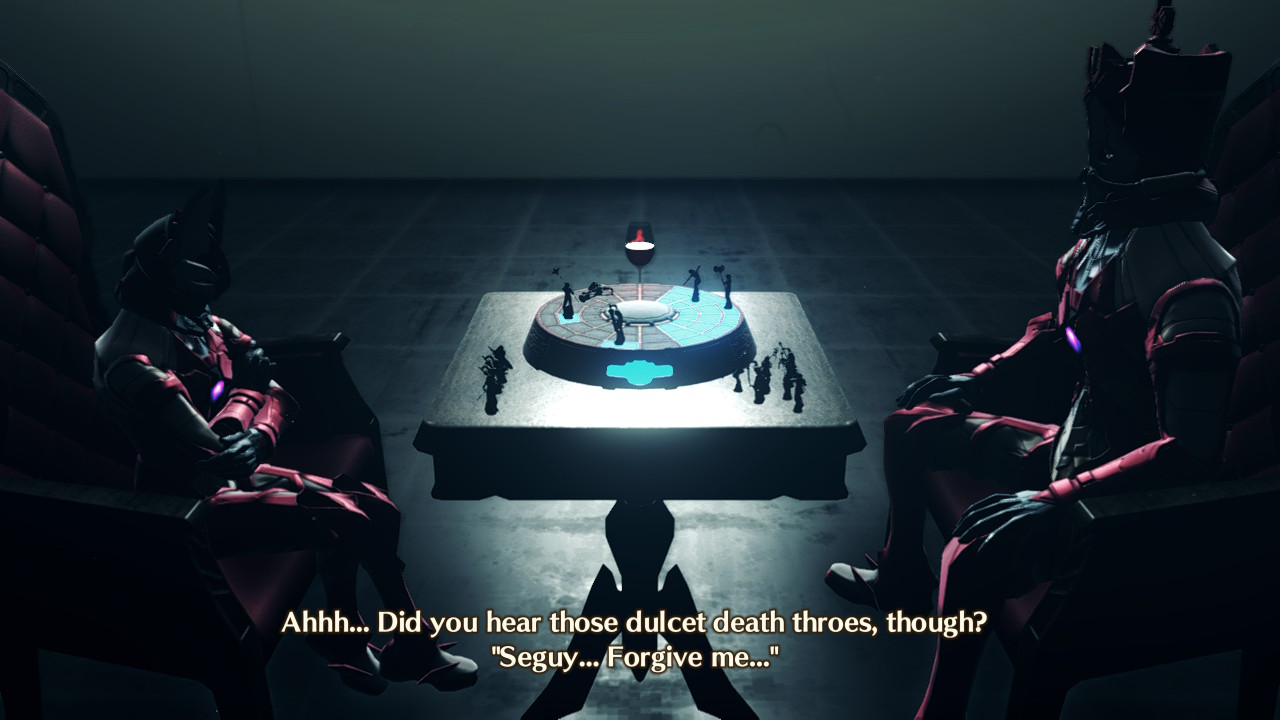
Consuls R and V in the Amphitheatre, discussing their war game following V’s victory.
As Wittgenstein told it, this very experience led him to formulate the picture theory of language.[18] After stating that “[t]he world is a totality of facts” and spelling out the relationships between simple objects so as to clarify what these facts consist in, Wittgenstein states that, through language, “[w]e make to ourselves pictures of facts,” where “[t]he picture is a model of reality.”[19] The relationships in which the parts of our picture stand to one another represent that the objects represented by the parts of that picture stand in those relationships to one another, and thus the picture’s structure (that is, “[t]his connexion of the elements of the picture”) represents the possibility of things in the world being related as they are in the picture.[20] If I say that Noah plays a flute, for example, it’s possible for my statement to have meaning because its grammar puts two names in a particular relationship to each other, which corresponds to the way in which two things would be related to each other in the world if the statement were true. These pictures, then, which form the basis of our language and thought, “[reach up]” to reality, establishing a link between language, thought, people, and the world.[21]
Put as Slogan 1: We say and think significant things about the world by holding pictures of how things could be up to it.
In constructing Wittgenstein 1, it is important to also recognize that Wittgenstein saw this as the way in which language and thought express significant propositions about the world: not one particularly useful form of expression for which he was advocating, but rather the one and only form. Even if colloquial language doesn’t always directly show the logical pictures of thoughts that they’re meant to represent, this is only because “language disguises the thought; so that from the external form of the clothes one cannot infer the form of the thought they clothe, because the external form of the clothes is constructed with quite another object than to let the form of the body be recognized.”[22]
§1.112: What Can Be Said, and What Can Be Shown
The picture theory of language may seem intuitive, as least as far as intuition goes in the relationships between logic and how we talk and think about the world, but Wittgenstein draws profound, less intuitive consequences from this view. These consequences drive to the heart of what Wittgenstein meant when he said that not much had been done by solving all the problems of philosophy with the Tractatus.
What a picture’s elements can propose about the world—and, therefore, the realm of significant propositions we can say or think—is basically limited to the domains of the natural sciences’ verifiable claims. Other domains—like most of which we’d associate with philosophy—can only, if anything, be shown by the overall structure of this picture, not expressed through the picture’s content in the way that would make possible a proposition with a sense.
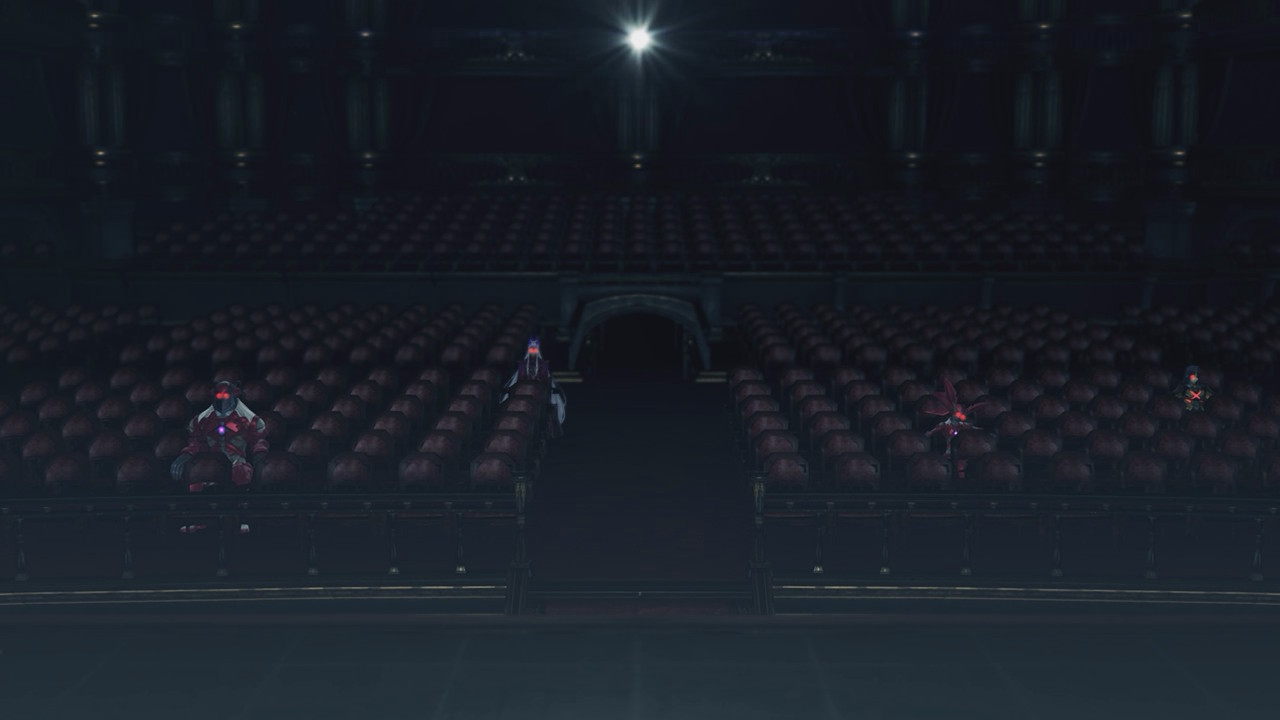
Amphitheatre view from its stage.
The reason for this is that, according to Wittgenstein’s logical analysis, a proposition is something that “shows how things stand, if it is true. And it says, that they do stand.”[23] To show how things stand requires representing objects in a certain relation to one another through names that are in a certain relation to one another,[24] and propositions can’t say that things “do stand” in any sort of relation when the “things” in question are the tools on which propositions’ capacity to picture things is predicated:
Propositions can represent the whole reality, but they cannot represent what they must have in common with reality in order to be able to represent it—the logical form.
To be able to represent the logical form, we should have to be able to put ourselves with the propositions outside logic, that is outside the world.[25]
For this reason, metaphysical, aesthetic, and ethical claims can’t have sense: to utter a significant proposition is to say something about the things in the world, and saying things about the nature of the world as a whole would require being able to comment it from outside the limits imposed by our position within that world. Wittgenstein asks, “Where in the world is a metaphysical subject to be noted?” He draws an analogy with the subject of our eye and its relationship to our field of sight: we should realize, he says, that there’s no meaningful way in which we “see [our] eye,” nor anything we can infer about our eye, from our visual field.[26]
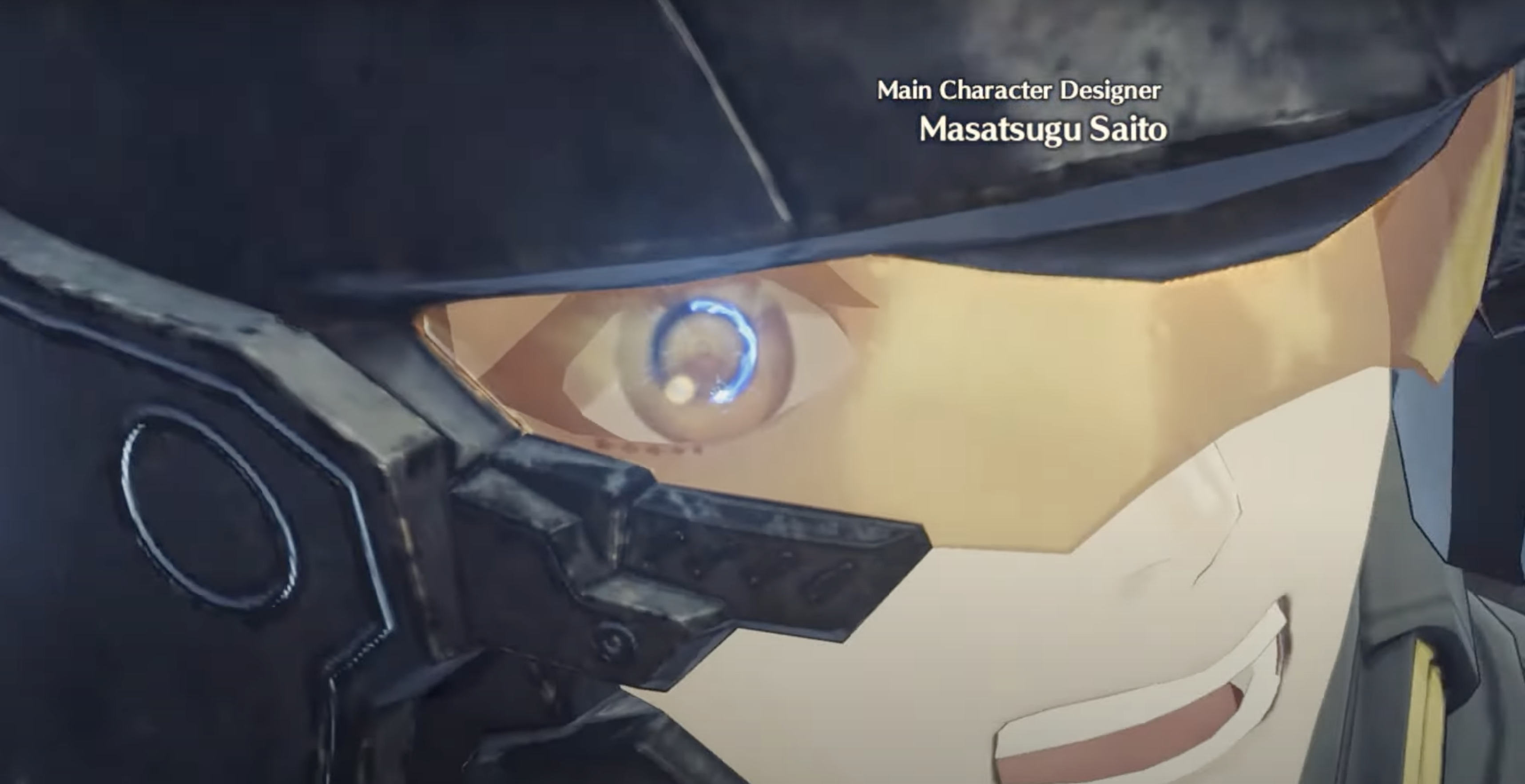
The Iris of a Colony 9 soldier as the Colony’s Flame Clock is filled with life during a battle with Colony Sigma.
The analogy with the eye is important to us not only because of the prevalence of eye imagery within the story of Xenoblade Chronicles 3, but also because of how Wittgenstein links the “eye” with the “I.” Because the subject limits her own realm of what can be sensibly said and thought to her perspective, solipsism is true in a way that is shown yet unsayable:
That the world is my world, shows itself in the fact that the limits of my language (the language which only I understand) mean the limits of my world.
The world and life are one.
I am my world.[27]
To significantly utter the truth of solipsism would require speaking about the world and one’s place in it sub specie aeternitatis, or “under the form of eternity,” a philosophical term which Wittgenstein used to refer to the sort of outside perspective on the world that would be required to say significant propositions about metaphysics, ethics, or a work of art. That vantage point is only available to God, who “does not reveal himself in the world.”[28]
In the words of Slogan 2: We can only meaningfully talk about the things within the world; to talk about the rest would require getting beyond the world and its limits.
A consequence of this, which Wittgenstein renders in the famous analogy of the Tractatus’ penultimate proposition, is that the Tractatus’ own statements “are elucidatory in this way: he who understands me finally recognizes them as senseless, when he has climbed out through them, over them. (He must so to speak throw away the ladder, after he has climbed up on it.)”[29] The Tractatus itself treats the totality of the world and language in the exact way that it claims one cannot, making it not so much a set of propositions proposed to be true but rather a sort of therapy to help its reader “[see] the world rightly,” a theme we see recur in different guises throughout Wittgenstein’s life and work.[30]
§1.12: Registers of Faith: Wittgenstein’s Challenge with Predestination
If you read the Tractatus for the first time without any sort of outside guidance, you might suppose that Wittgenstein wanted to do away with domains like ethics, metaphysics, religion, and everything else beyond the natural sciences; after all, the last (and probably most widely known) proposition in the work is “Whereof one cannot speak, thereof one must be silent.”[31] But in speaking with potential publishers, Wittgenstein was adamant that the Tractatus “consists of two parts: the one which is here, and of everything which I have not written. And precisely this second part is the important one.”[32]
Wittgenstein meditated on topics like music, ethics, and religion throughout his life; the Tractatus just expressed his feeling that those registers of life must be lived rather than discussed. These domains capture something like the sense of life—yet “men to whom after long doubting the sense of life became clear, could not then say wherein this sense consisted.” Holding this view does not deny those men their clarity, for Wittgenstein wants to affirm that “There is indeed the inexpressible,” the mystical: the content of life that cannot be said.[33]
We see, in this spirit, Wittgenstein wrestled across his life with mystical topics, including religion. One religious doctrine evidently occupied him for over a decade later in his life, about 30 years after the Tractatus: election by grace, a New Testament conception of predestination. The source (to the best of my knowledge) is the teaching of Paul in Romans 11:1-6,[34] that God had pre-selected a handful of people for salvation, and that the rest were pre-selected for damnation as punishment for the kinds of lives they would lead.[35]
Wittgenstein’s trouble with the doctrine seems to be that it combines (1) a perspective on God’s relationship with creating the world and (2) punishment for the actions of people within that world. “‘He has chosen them, in his goodness, & you he will punish’ really makes no sense,” he says, because “[t]he two halves belong to different kinds of perspective. The second half is ethical & the first not. And taken together with the first the second is absurd.”[36] Wittgenstein doesn’t see any way to connect the notion of a god having created things thus-and-so with the concepts of ‘punishment’ or ‘reward’ for actions—particularly when there’s nothing barring God from being completely arbitrary in choosing those who are to be saved, if he really does so.[37]
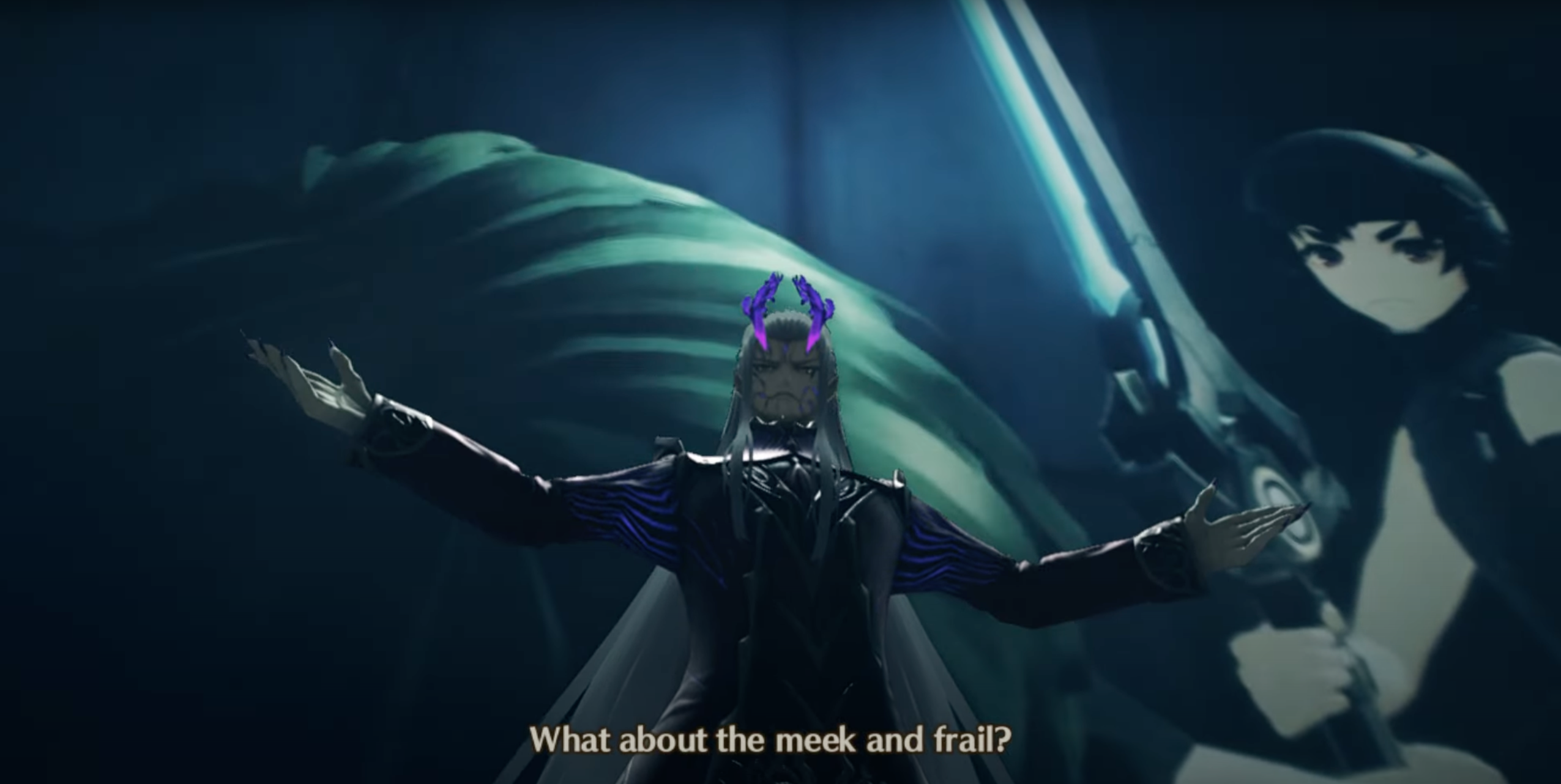
Z challenging Ouroboros’ worldview as they confront him in the Amphitheatre.
Wittgenstein recognizes, though, that his lack of understanding on this subject may be due to a limit on his perspective. He considers that it may be possible to understand ‘punishment’ in the context of election by grace by saying “here there is punishment, where punishment by human beings would be impermissible”—in which case we may have to recognize that we’ve moved beyond our concept of ‘punishment’ and introduced something different in its place.[38] What that “something different” is, though, seems to be something he saw himself as unable or unfit to grasp. Making sense of the doctrine’s expression, as with many religious ideas, requires one to have a certain level of devoutness, commitment to living out religion:
In religion it must be the case that corresponding to every level of devoutness there is a form of expression that has no sense at a lower level. For those still at the lower level this doctrine, which means something at the higher level, is null & void; it can only be understood wrongly, & so these words are not valid for such a person.
Paul’s doctrine of election by grace for instance is at my level irreligiousness, ugly non-sense. So it is not meant for me since I can only apply wrongly the picture offered me. If it is a holy & good picture, then it is so for a quite different level, where it must be applied in life quite differently than l could apply it.[39]
Wittgenstein is seen here wrestling with the exact subject matter that cannot be sensibly uttered in the world of the Tractatus. How can we understand or engage in conversation with an entity like God, who dwells beyond the limited perspective that we must have on the world by virtue of existing within it? It must have to do with the nature of how we live: with different levels of the mystical feeling, which reveal themselves only in certain forms of life.
For our purposes, there are two key takeaways here:
Slogan 3: An entity existing outside of the world could act upon the world in ways that seem arbitrary to those inside the world.
Slogan 4: There are different levels of religious understanding available to one according to one’s devoutness.
Presumably, the two slogans are related: one might seek to become more devout, in the hope that one would thereby view the realm of God as less arbitrary relative to oneself.
§1.13: Wars Within, and Wars Without
As much as Wittgenstein found himself incapable of living a religious life, he seemed to always be waging some kind of war in pursuit of the clarity he thought that higher register of devoutness might afford him. Some of these wars were literal, and some were figurative; all of them help us to link the substance of Wittgenstein’s thinking with Aionios, the essentially warring world constructed and enforced by Moebius.
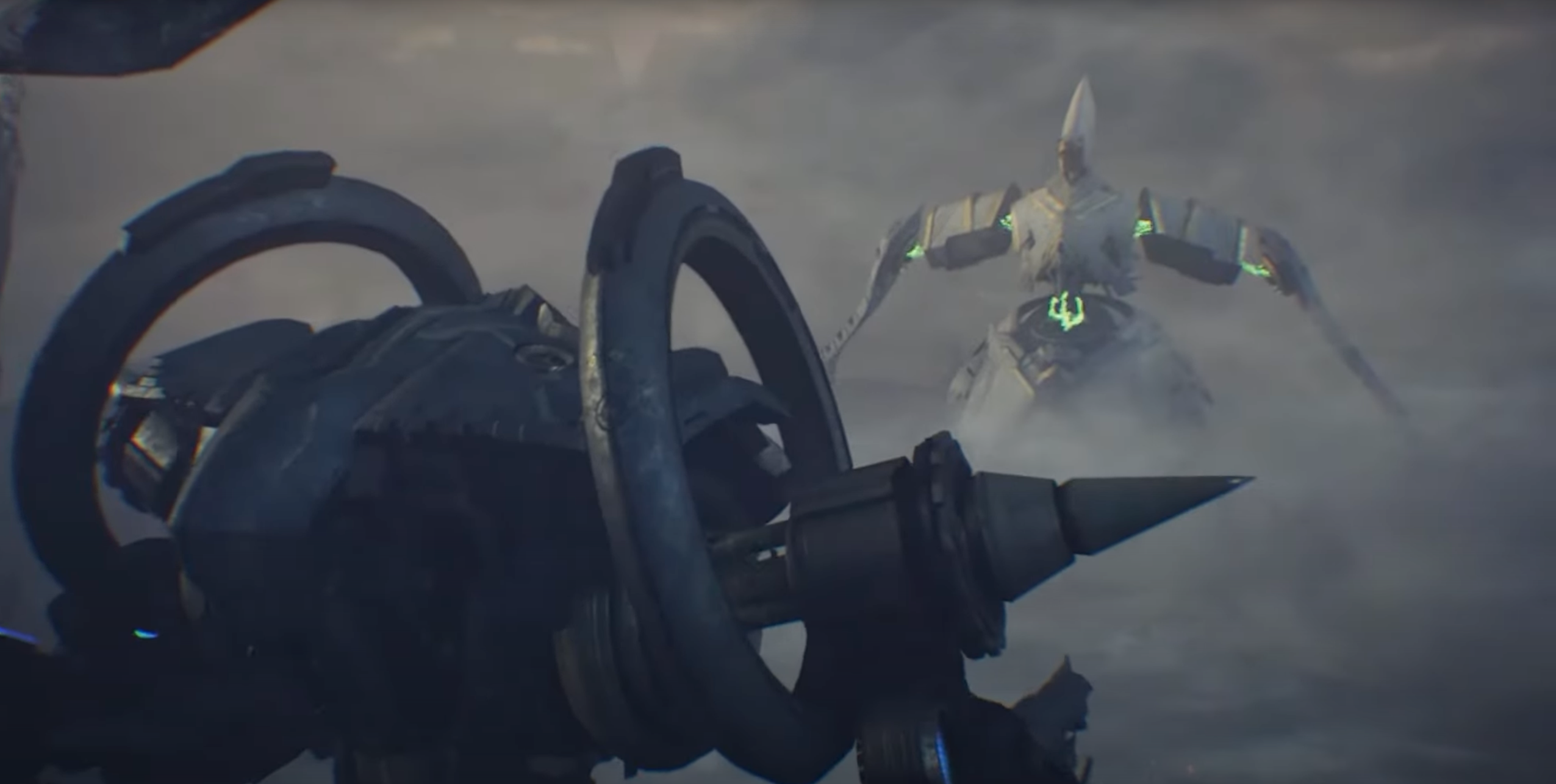
Colony 9 and Colony Sigma square off.
After the beginnings of his work in philosophy at Cambridge, Wittgenstein volunteered to serve his native country of Austria in World War 1. He developed many of the key ideas of the Tractatus, and composed the work itself, during his service.[40] Consistent with the diversity of his projects across life, Wittgenstein’s wartime occupations ranged widely: from the pilot of an artillery ship’s searchlight, to numerical clerk, to military official, to the supervisor of the forge at an artillery workshop, to head of the artillery workshop, to a soldier on the observation post of the front lines, to artillery officer, to Lieutenant, to prisoner of war.[41]
Monk argues in his biography of Wittgenstein that he seemed to see the war, at least in part, as an opportunity to cultivate his spirit in a way that could only happen in the face of death.[42] Wittgenstein’s diaries from wartime show that he saw his encounters with enemy forces as “the chance to be a decent human being […] standing eye to eye with death”; he hoped that “[p]erhaps the nearness of death will bring light into life. God enlighten me.”[43] Much later, in 1944 and in the midst of World War 2, he counseled a wayward friend similarly to try to join a unit near the war’s frontlines if possible, because there, he could “at least live some sort of life […] I have found that whenever, after a long struggle, I have screwed my courage up to do something I always felt much freer & happier after it.”[44]
Despite Wittgenstein’s feeling later in life that higher levels of religious thinking were beyond him, he sought out Christianity throughout World War 1, reaching out to God as in the above remark, and keeping Tolstoy’s Gospel in Brief close to him like “a kind of talisman” after finding it in a bookshop during his first month of the war.[45] It was only once he was in the thick of combat, truly standing eye to eye with death, that his intellectual work transitioned from the more logic-oriented parts of the Tractatus to its perspective on the mystical—what cannot be said, but only shown.[46]
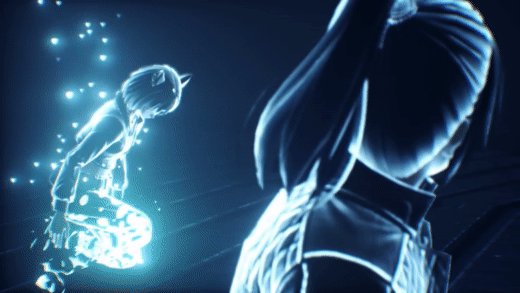
Noah despairing over the loss of Mio in a past iteration of his war against Z.
It’s no simple matter to say exactly what darkness Wittgenstein was seeking to banish from his life with the light of religious insight, but it is clear that he was plagued by despair in many forms throughout his life. Two of his own brothers committed suicide, with a third presumed to have done so as well;[47] Wittgenstein frequently contemplated taking his own life at various junctures. Before Bertrand Russell encouraged Wittgenstein to pursue philosophy, Wittgenstein, working as an engineer, had considered himself to be unwanted and unnecessary, and had felt ashamed for having not killed himself;[48] in the early days of the war, isolated on a warship with no letters yet from his closest friend, he thought of suicide;[49] after the war, amidst tremendous difficulties in getting the Tractatus published, he wrote to a friend of a suicidal depression caused by what he saw as his “baseness and rottenness.”[50]
Two related, personal “wars” of Wittgenstein’s may help to explain the sense of despair that he and others frequently saw in him: (1) the strain of philosophical work and (2) the intentional distance he maintained between himself and the people for whom he cared.
Throughout his life, Wittgenstein struggled with only being able to make progress in his philosophical work under certain conditions. He complained of his thoughts being “tired” and became philosophically unproductive during stints of his more tedious and mundane duties in World War 1;[51] he “exiled himself” to Norway more than once, even having a secluded hut built for himself there so that he could produce “infinitely more and better work” than would be possible in a more populated and distracting place.[52] He often kept those for whom he cared at arm’s length for the sake of his work, and he seems to have resented himself for it.
When Wittgenstein returned to Norway later in life to work on completing his Philosophical Investigations, he denied Francis Skinner, his close friend and romantic interest, the opportunity to join him, despite Skinner’s strong desire to do so.[53] In Norway, Wittgenstein remarked in his diary that he only really appreciated Skinner when they were at a distance from each other;[54] when they later reunited and were intimate with each other, Wittgenstein recorded their time together in his diary, alongside a note that he had “also been unjust, edgy, and insincere towards him, and also cruel”—a juxtaposition that seemed to haunt him, especially after Skinner’s death.[55] As Wittgenstein’s biographer, Monk proposes that this points to a broader pattern in Wittgenstein’s life, according to which he practiced a kind of “emotional solipsism” not merely with Skinner but rather with all objects of his romantic affections: just as the Tractarian Wittgenstein held up the unutterable truth of philosophical solipsism as an attribute of the subject’s relationship with the world, so the biographical Wittgenstein seemed to find a safety in keeping his romantic interests at a distance, not caring whether they reciprocated but rather defining the entire world of their “relationship” by his feelings directed at them.[56]
This emotional solipsism kept the passions of his life at the safe distance he seemed to think his intellectual work sometimes required—despite how closely tied his experiences were to his work, such as World War 1 driving development of the Tractatus—while also stoking his torment over his inner nature, which he described once in a letter to a friend as “a swine” who wished “to invent a machine for becoming decent.”[57]
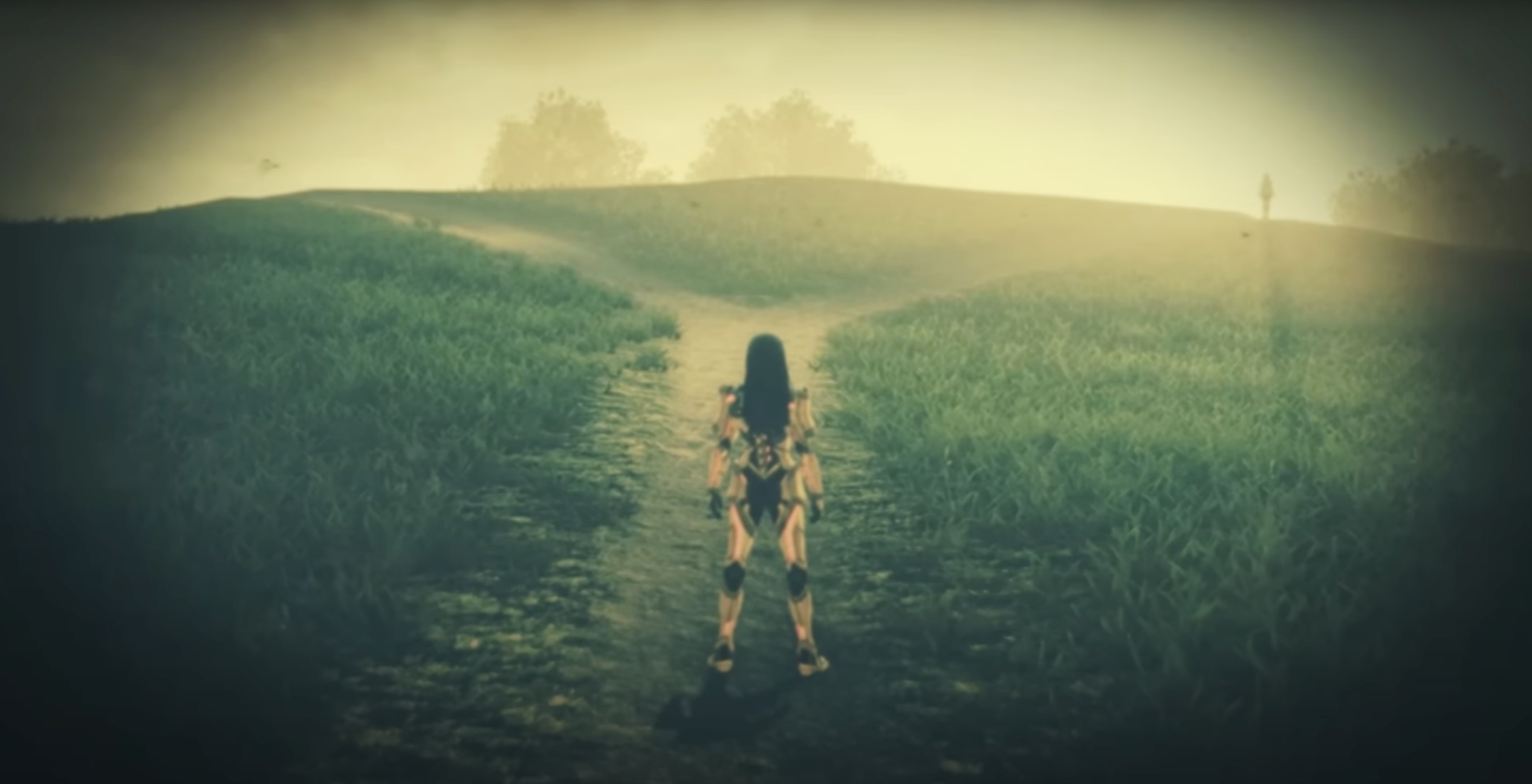
N faces the choice of paths offered to him by Z.
Work and personal life both saddled Wittgenstein with chronic mental strains, but he wasn’t without coping mechanisms, tactics to manage his morale in these internal wartimes. In particular, those who knew him recall how he would seek to free his mind from the burden of his philosophical thoughts by taking in films. When he lectured at Cambridge later in life, his student and friend, Norman Malcolm, recalls that he would often rush to a “flick” afterward, “sitting in the very first row of seats, so that the screen would occupy his entire field of vision, and his mind would be turned away from the thoughts of the lecture and his feelings of revulsion.”[58] When he was contributing to a research team studying the concept of “shock” in victims of war-related traumas, one of his fellow researchers remembers that he would end most evenings by taking in films rather than socializing with his team, and that “he could not remember anything about the films when asked about them the following day. He just went to relax.”[59]
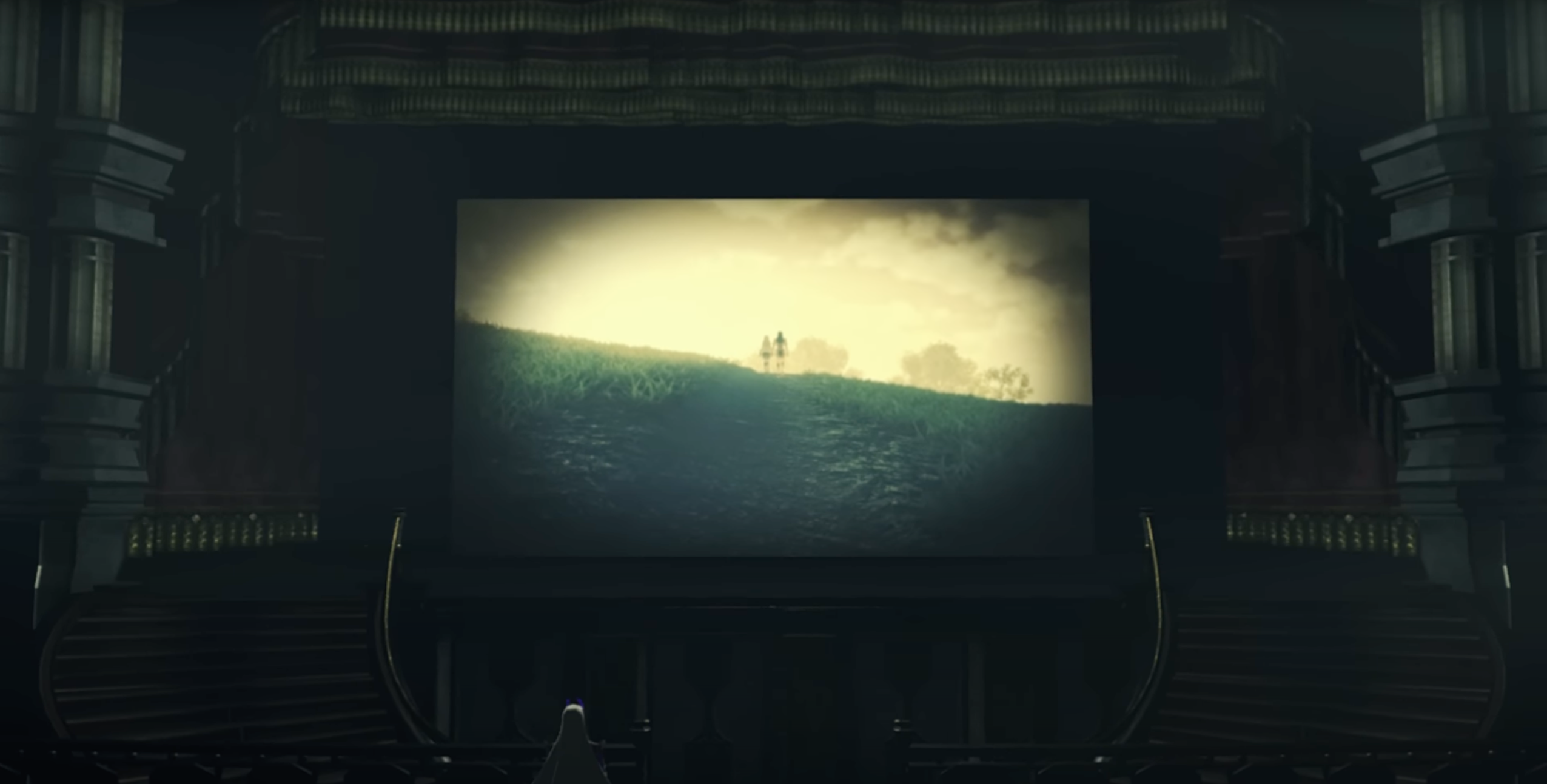
Z taking in a “flick” as Noah makes the choice to become N in pursuit of Mio.
It’s impossible to capture a person’s life in mere snapshots, but in order to serve our goal of constructing a lens through which to read Xenoblade Chronicles 3, I’m going to distill insights from Wittgenstein’s life in the same form that I distilled his philosophical views: slogans that we stipulate our perspective on Wittgenstein, Wittgenstein 1, endorses. In relation to Wittgenstein’s actual life, this is, of course, a heuristic at best, and since this method is based on inferential reasoning from primary, secondary, and tertiary sources about a single life, we should recognize there’s no guarantee that the flesh-and-blood man himself would endorse these slogans.
Here, then, are 4 slogans to derive from this first picture of Wittgenstein’s life:
Slogan 5: Nearness to death, as in war, can help to cultivate one’s character.
Slogan 6: Despair at one’s place in the world can be offset by cultivating one’s character, or by producing a great work.
Slogan 7: Objects of love are best kept at a distance.
Slogan 8: Entirely occupying one’s senses with a fictional, pictured world can alleviate the strains on one’s life.
§1.14: Defining Wittgenstein 1
In studying Wittgenstein’s Tractatus, challenges with understanding religion, and relationships with external and internal wars, we’ve derived 8 slogans with which to compose Wittgenstein 1, through which we’ll read Z, Moebius, and antagonism within Xenoblade Chronicles 3:
- We think and say significant things about the world by holding pictures of how things could be up to it.
- We can only meaningfully talk about the things within the world; to talk about the rest would require getting beyond the world and its limits.
- An entity existing outside of the world could act upon the world in ways that seem arbitrary to those inside the world.
- There are different levels of religious understanding available to one according to one’s devoutness.
- Nearness to death, as in war, can help to cultivate one’s character.
- Despair at one’s place in the world can be offset by cultivating one’s character, or by producing a great work.
- Objects of love are best kept at a distance.
- Entirely occupying one’s senses with a fictional, pictured world can alleviate the strains on one’s life.
As we proceed, I invite you to take these 8 slogans as a set—call Slogan 1 ‘S1’, and so on—and draw your own connections between them; as we use Wittgenstein 1 to interpret the antagonists of Xenoblade Chronicles 3, ask yourself whether your own connections lead you to different, yet thematically consonant conclusions about those aspects of the game. These, however, are the key connections I’d like us to keep in mind explicitly for the analysis as written (coded with the slogans which I take to be connected by them):
Connection 1: There are different levels of understanding in the world, some of which we can only understand through certain actions or states, and some of which we cannot understand. (S2, S3, S4, S6)
Connection 2: Our inner life can be managed by controlling the literal or figurative distance between ourselves and the people and concepts who relate to that inner life. (S4, S5, S6, S7, S8)
Connection 3: Our capacity to relate to worlds consists in our capacity to conceptually arrange things within those worlds as we would a picture. (S1, S2, S8)
These three connections (call them ‘C1’, ‘C2’, and ‘C3’) aren’t meant to be claims deduced from the connected slogans, nor is this an argument that Wittgenstein would endorse these connections: my view is that these connections are useful in applying our slogans to the thematic content of Xenoblade Chronicles 3, and that each connection is echoed, in a narrower context, by each of the slogans which it connects. Let us take them, then, as characteristic of the Wittgenstein 1 perspective, and see how the antagonists of Xenoblade Chronicles 3 manifest them in artistic form.
§1.2: Z’s Amphitheatre
The villains of Xenoblade Chronicles 3 teach us what it means to seek safety within the world by placing yourself outside of that world, building a house of cards atop which to view all of existence sub specie aeternitatis.
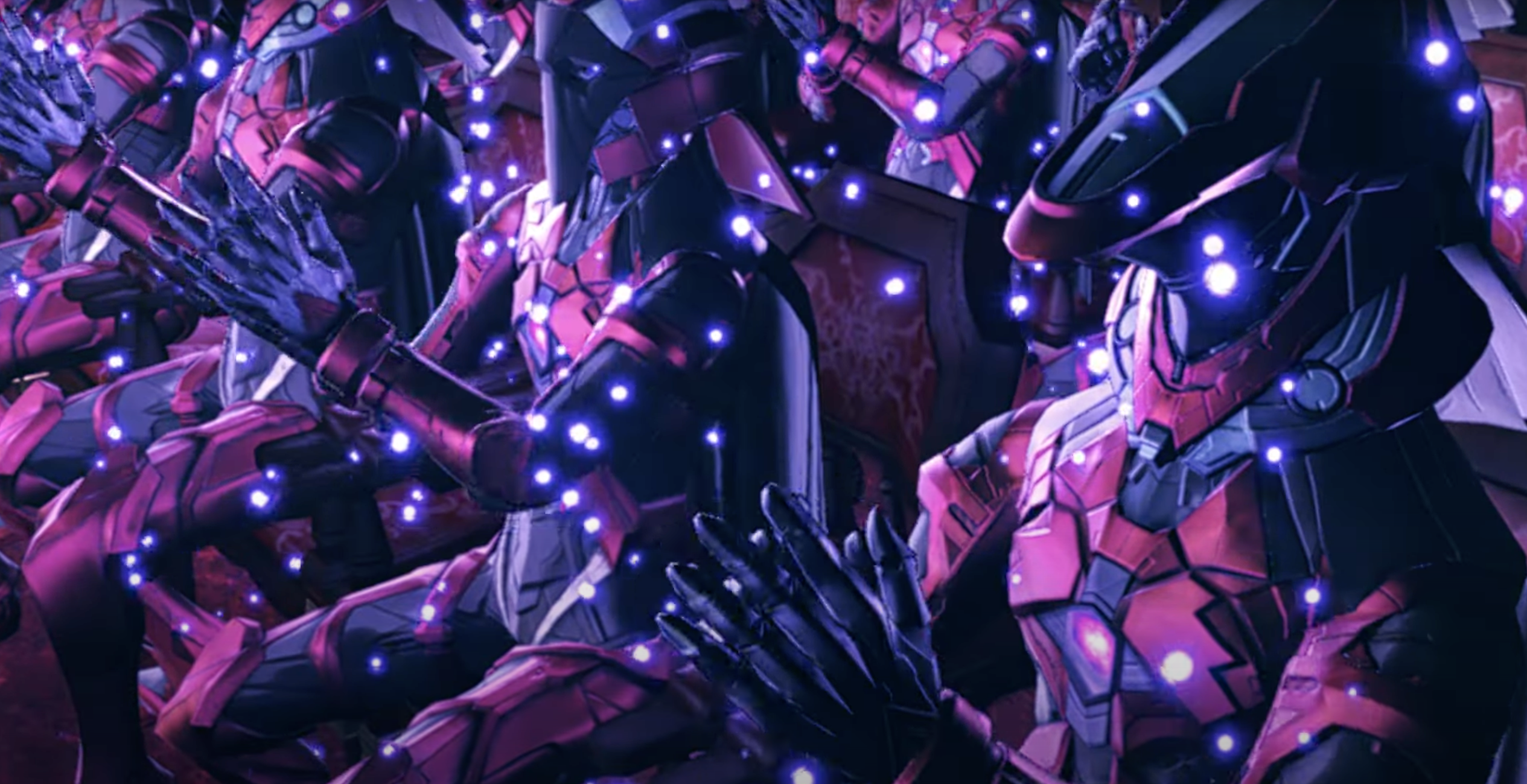
Ranks of Consuls filling the Amphitheatre with their applause for Z and Ouroboros.
In the remainder of Part 1, we’ll use Wittgenstein 1 to unify Z, Y, X, the Aionian Consuls, and the Endless Now as a seductive picture of how anxieties about our inner life can motivate a parasitic, totalitarian, self-undermining relationship between ourselves and our world. By the end of that analysis, we’ll see how easy it would be for a player to look upon Z and see herself, as Noah and the rest of Ouroboros do in the game’s finale—and we’ll have to turn to these heroes, in Part 2, in hopes of finding out how we, as players, can escape the fate of becoming Z.
§1.21: The God of Moebius: Z
Alone in a theater sits Z, the “true adversary.”[60]
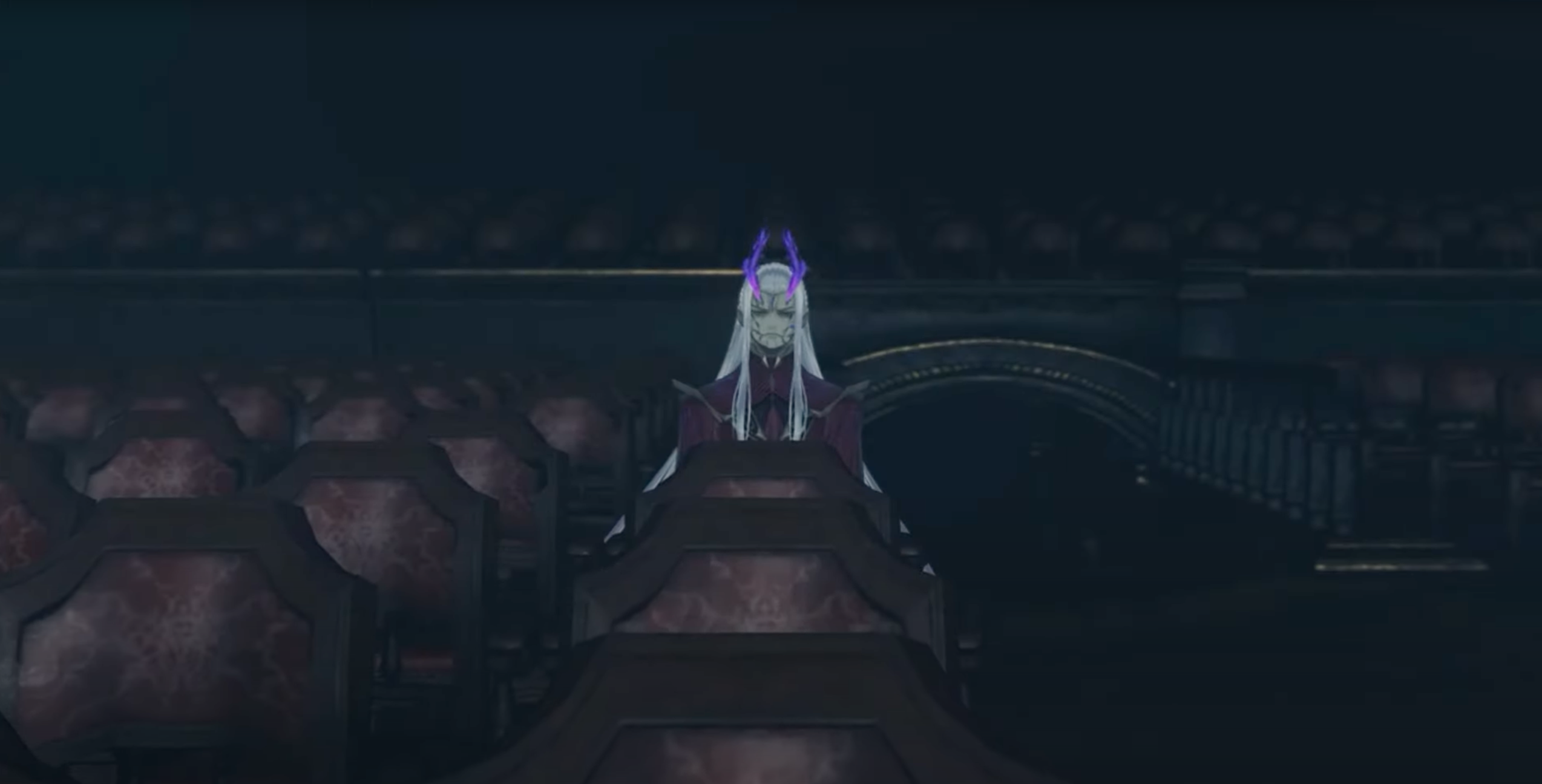
Z, watching Ouroboros’ journey from the seats of the Amphitheatre.
We don’t have many direct sources of information about Z per se: he resides within Origin—apart from the land of Aionios, “beneath the sea where none may tread”[61]—and not even all members of Moebius seem to have a full grasp of who or what he is, though it is he who personally turns Aionians into Consuls.[62] What we do learn about him predominantly comes from Queens Nia and Melia, X and Y, N’s memories of recruitment into Moebius, and Ouroboros’ own interactions with Z in the game’s finale.
We learn from Melia that Z is a concept, the coagulation and personification of people’s tendencies to feel uncertain and frightened;[63] we learn from Nia that his authority consists in “command[ing] the world’s very fabric” from Origin, weaving a set of rules by which Aionios, frozen in time and endless war, sustains the vitality of Moebius—a method that not even all Moebius members fully understand.[64] From Z himself we learn that he coagulated into existence because those human desires that Melia described represent a longing for the suspension of existence within the present moment, the ruleset he has imposed upon the world; and, chillingly, we learn that Z relishes the game of manipulating the lives of those in Aionios because it “amuses” him.[65]
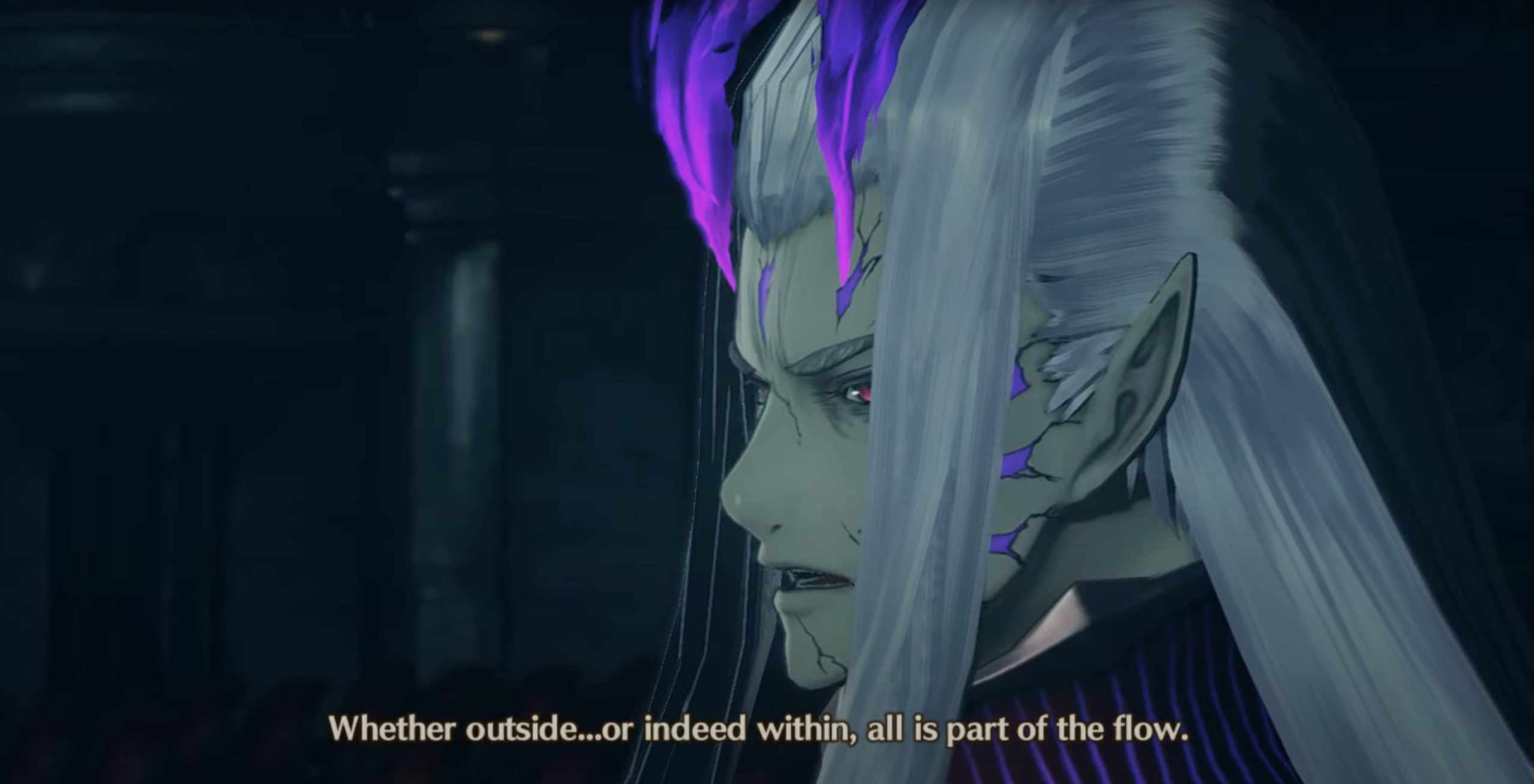
Z speaking with X and Y in the Amphitheatre following the unexpected defeat of N at Agnus Castle in Chapter 6.
From Z and Y, we learn more about the balance Z strikes between his being the world’s “foremost audience”[66] and instigating events within the world for his amusement. Y says that “we who are [Z’s] avatars enjoy powers beyond mortal ken” in order to use those powers to enact Z’s desire, “the betterment of Moebius”;[67] yet when things go wrong, like Ouroboros and the Sword of the End overcoming Z’s power beyond mortal ken during the Homecoming atop Agnus Castle, Z counsels that “we acknowledge and accept” the unexpected outcome, taking it as yet another element of the order he has imposed upon the world and from which he can derive amusement as its primary audience member.[68] As when Z watches various Moebius members play out on the Amphitheatre’s stage the literal war games that correspond to Colony battles on Aionios,[69] his perspective seems to be that even unexpected outcomes within the broader story of the world he’s co-opted ultimately serve the Endless Now, the overarching game he’s imposed upon the world and over which he views himself to be the final arbiter.
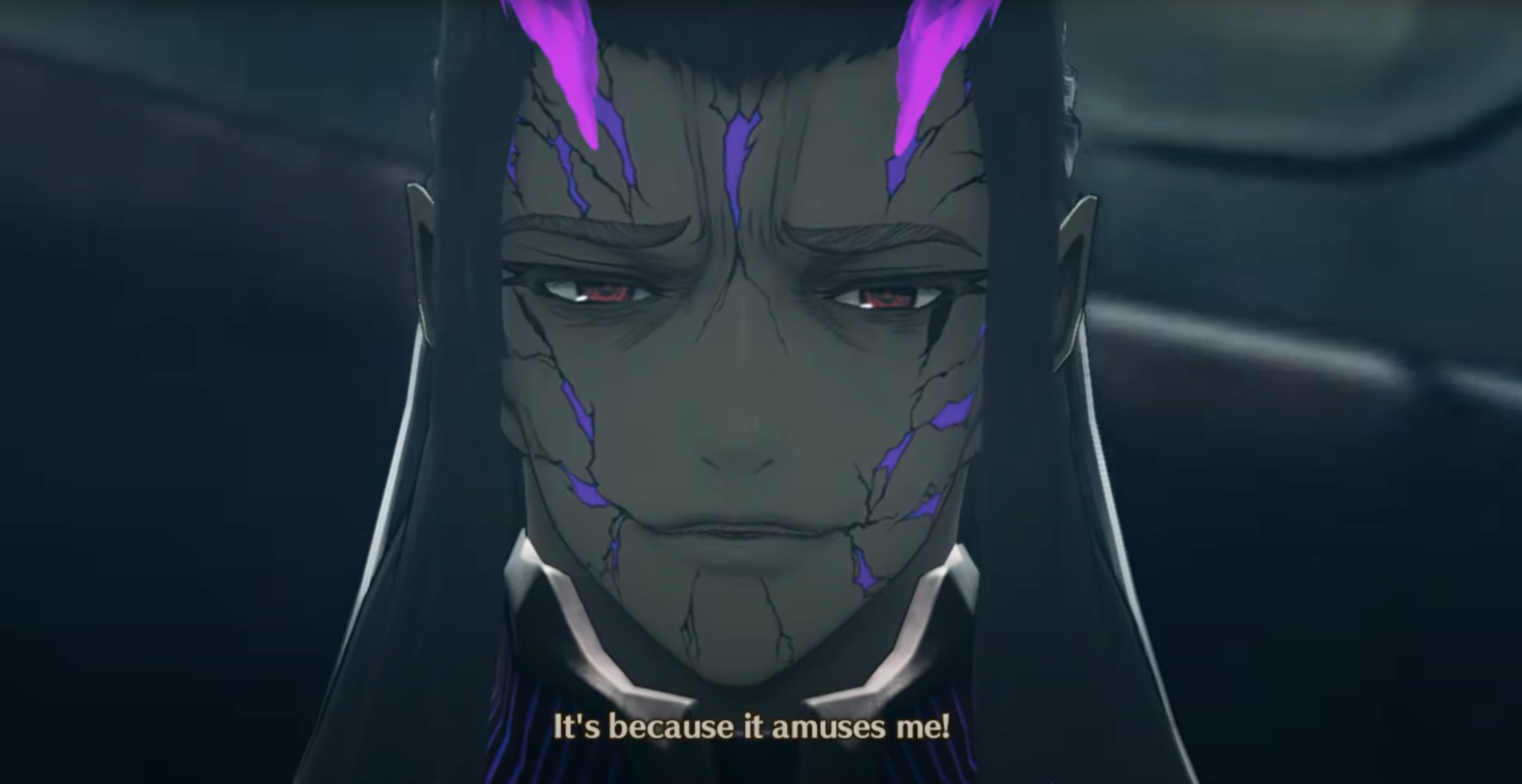
Z exclaiming, to Ouroboros, his reasons for turning their friends into members of Moebius.
In the “ringleader” of Moebius,[70] we see the three connections we identified in Wittgenstein 1; in how his influence radiates out to Moebius and Aionios, we see the consequences of the Wittgenstein 1 worldview reaching so far as to envelop the world sub specie aeternitatis.
Z literally personifies the aspects of our inner life that are conducive to despair: uncertainty and fear over a world in which the distance between us and the people and concepts we care about are subject to change. His solution is C2: to rigidify those distances through a system that isolates him from a world with which he only interacts through his avatars, isolates the rest of Moebius from Aionios through their exemption from death and radically different relationship with the people of Aionios (viewing them as tools or fuel rather than equals), and isolating the people of Aionios from the meaning of their very world by imposing the Endless Now and the accompanying war games upon them.
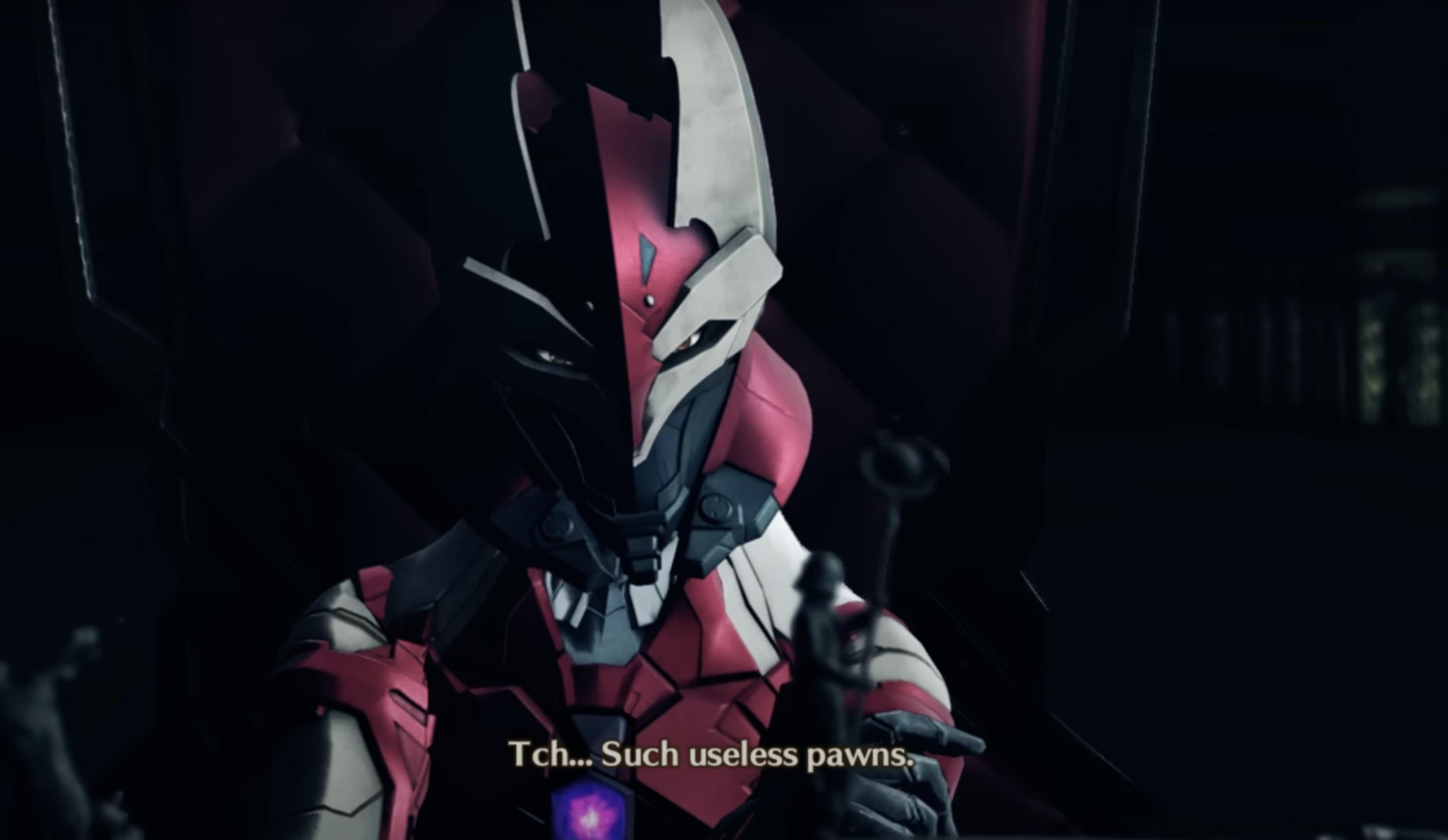
R, speaking in reference to the members of her Colony after losing in battle to V and his Colony.
In so doing, he imposes upon the world of Aionios a limit to what can be expressed within it: in a symbolic echo of the inspiration behind the picture theory of language, all that can happen in the world can be literally pictured by the projector in the Amphitheatre (C3). As Wittgenstein 1 has it that language and thought can only express significant content by proposing a structure of relations within the world that might be verified or falsified depending on how things actually are related to one another, Z has it that those in Aionios may only express anything meaningful insofar as it represents something within “the action-packed drama of [their lives],” which Z has contrived to be a form of entertainment for him and Moebius.[71]
This, I think, is why Z isn’t frustrated when Ouroboros does things that seemingly contradict his imposed order upon the world, up to the point that they actually overpower him directly in the Amphitheatre: in seizing Origin, Z hasn’t so much co-opted facts about the world (e.g., who can and cannot use the Sword of the End, whether the intentions of a Moebius member can diverge from their person and be placed back into the cycle of death and rebirth on Aionios) as he has co-opted the systems according to which things in the world are meaningful. Thus, even “rebellion” is rebellion in service of his imposed system of meaning and Moebius’ entertainment; thus, when the party objects to Y that one’s feelings and memories define who one is, Y chides them that they are “simply deceiving [themselves], wishing to divine some meaning from something that is devoid of it.”[72] To Z, if a person’s form of expression appears to diverge from Z’s mode of consumption, that appearance is only because “language disguises the thought; so that from the external form of the clothes one cannot infer the form of the thought they clothe, because the external form of the clothes is constructed with quite another object than to let the form of the body be recognized.”[73]

Noah and Mio observing a family of Armus—and Z observing them as they do so.
By completely seizing the apparatus of meaning-making in Aionios and placing himself outside of Aionios in the Amphitheatre, Z represents himself as the sort of God imagined in Wittgenstein 1. He can see the whole of the world in a way that is impossible to anyone within the world, represented by the paradoxical “view from nowhere” through which he can see Aionios on his projected screen: just like in many films, paintings, video games, and other visual representational art forms, the view which the projector represents through the “camera’s” footage doesn’t correspond to anything within the world of Aionios—we don’t imagine a camera popping here and there to get footage for Z—and so he’s seeing into the world from a perspective that seems both to spatially exist yet not exist within that world.[74] (The image of Z watching Noah and Mio gazing up Armus, shown above, illustrates this paradox: Noah and Mio’s gazes have a point of origin within Aionios, whereas the gaze Z sees on the projector does not.[75]) Like the Tractatus, the structure he imposes upon the world undermines the sensibility of his own existence; like the God of Wittgenstein’s conception of predestination, he makes choices in ways that feel unnervingly arbitrary to those from within the world, as in the bewildering moment in which he tells Ouroboros that he toys with their friends’ existence because it amuses him.
Yet like Wittgenstein 1, Z is born from feelings of inner pain, and with that model in mind, we can almost imagine him similarly pressing his sensory experience all the way up against the visual screen in the Amphitheatre, quieting his own mind through the world he has molded in his image (S8). And in this way, with Z either sympathetic or totally alien depending on the perspective from which you see him, we see that he has also stratified levels of understanding in his world: Ouroboros—and, indeed, we players—can come to understand him in ways totally unavailable to those at the mercy of the Endless Now’s cycle (C1).
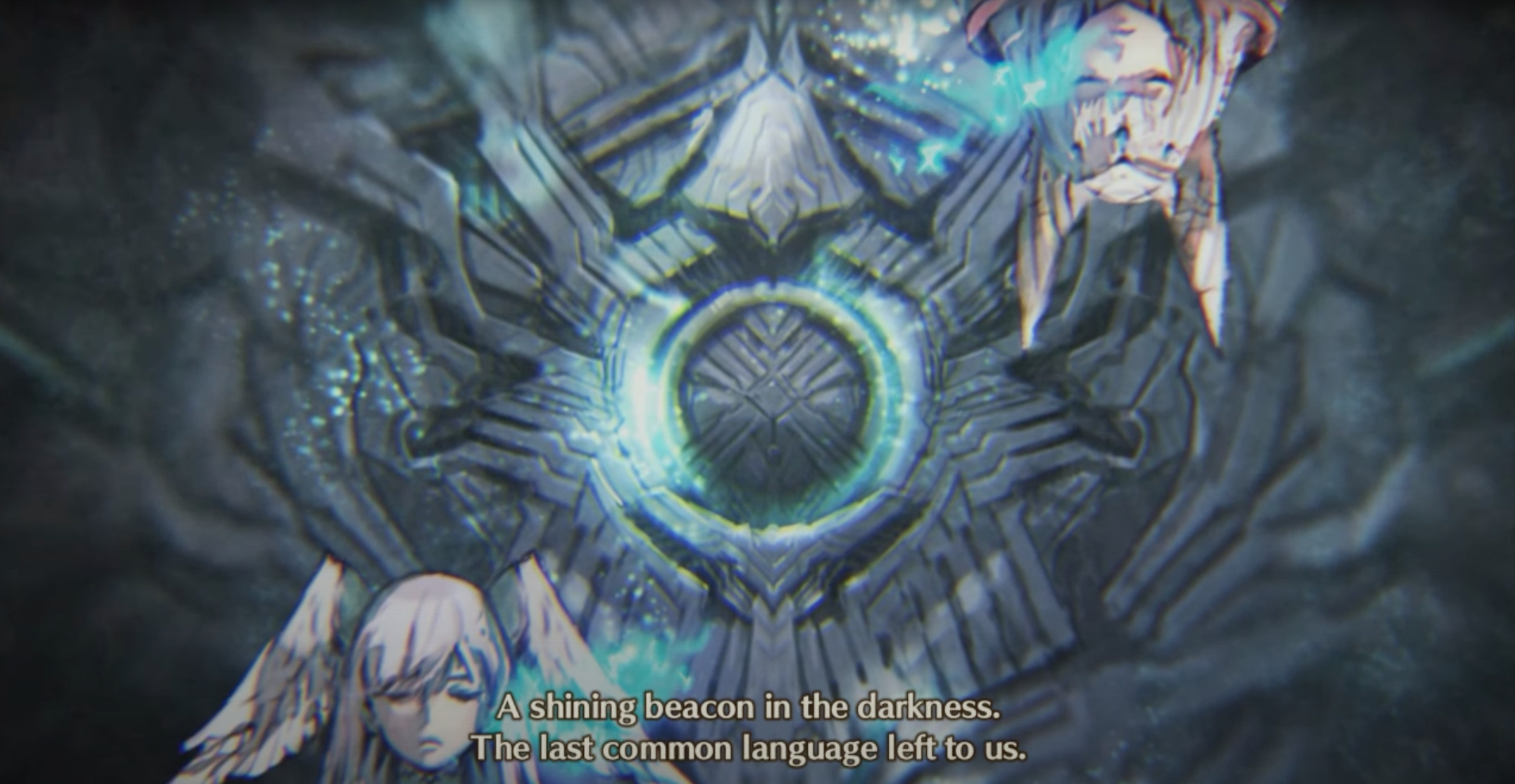
Nia’s story of how she and Melia came to communicate through light and jointly develop Origin from across their separate-yet-related worlds.
When she wakes from her slumber, Queen Nia tells Ouroboros that the construction of Origin was made possible by communication between herself and Queen Melia, literally worlds apart, through light, which she describes (above) as “the last common language left to us.”[76] Z’s crime is the hijacking of that language—imprisoning Melia in order to gain access to Origin, whose data were the product of that language[77]—to impose a different language: a singular mother tongue for Aionios within which meaning can only be communicated if it is communicated in service of Z’s picture.
Z is changing the rules according to which things can be meaningful in the world, stealing a Queen in order to turn the world into a game with a ruleset rather like chess: two sides must fight each other, all their possible actions are captured by the board and its pieces, and suddenly, the Queen as a monarch is transposed into a Queen as a chess piece—in a world where Z, true to his combat move of the same name, is a “Grandmaster” of the game.[78] Our next task is to see what the ruleset of this game looks like and how its grandmaster enforces it upon the world.
§1.22: The Godhead of Moebius: X, Y, and Z
If Z is at all able to quiet his mind through amusement at the events of Aionios, it is thanks to the work of X and Y, his enforcers and avatars.
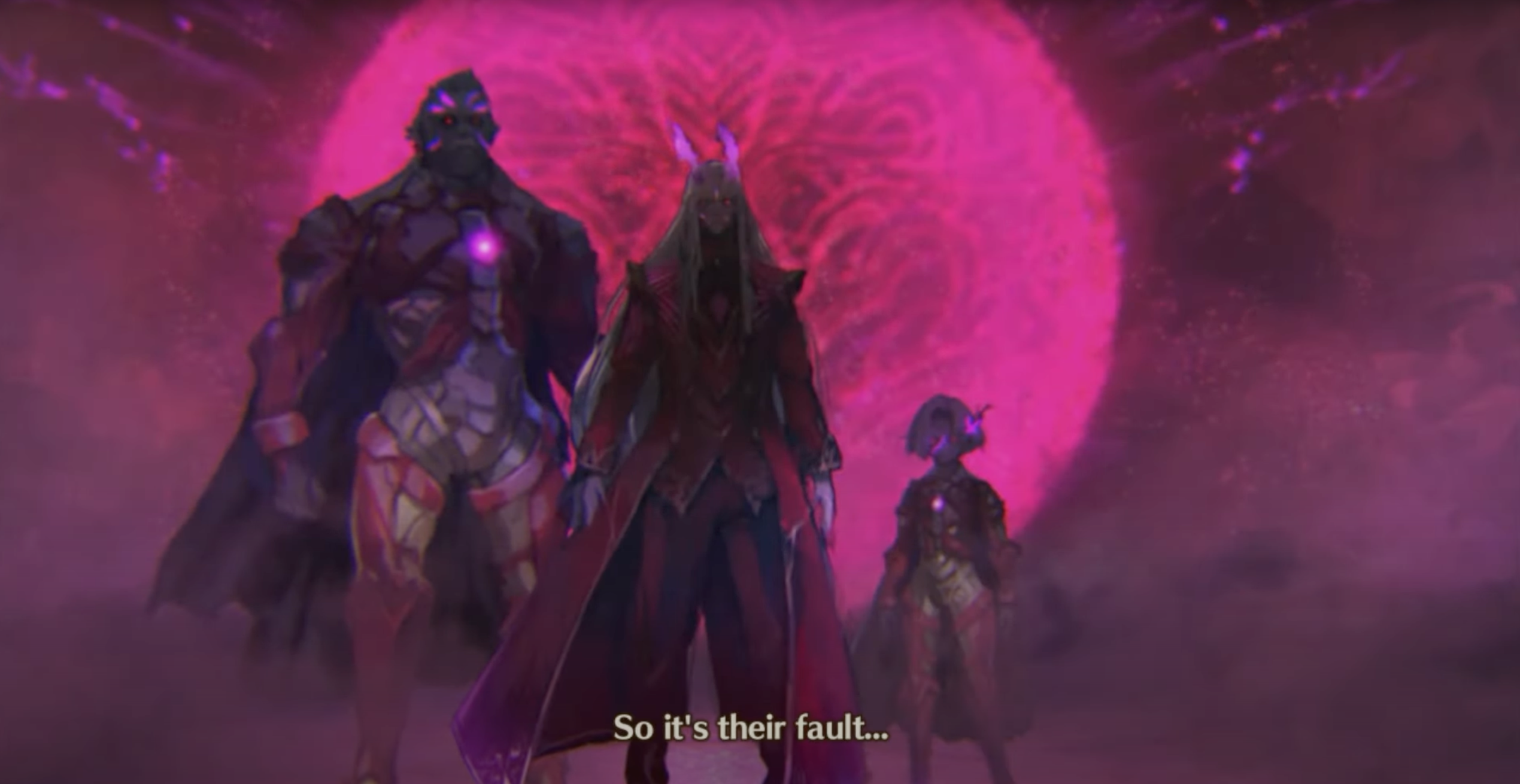
The representation of Moebius’ theft of Origin in Nia’s story to Ouroboros.
When Y identifies himself as one of Z’s avatars, he’s ambiguous as to which and how many Moebius operate in that role. I want to show that the relationship between X, Y, and Z is such that it makes sense to infer that X and Y, distinct among members of Moebius, are Z’s avatars. This inference lends itself to a broader understanding of X and Y as officers with unique authority to impose the Wittgenstein 1 worldview upon Aionios. It lends itself, too, to a parallelism that makes it all the more inviting for the player to see herself in Moebius.
Throughout the events of Xenoblade Chronicles 3, we find indications that Consuls X and Y are related as Moebius with Z in a way that does not extend to Moebius’ other members:
- In Nia’s story of the history of Aionios, told at the beginning of Chapter 7, she distinguishes between the “will of Moebius” that froze the worlds of Bionis/Mechonis and Alrest at their moment of collision, and the Moebius that could only propagate after Z captured Melia, gained control of Origin, and bent the memories within it to his will.[79] This distinction between two senses of ‘Moebius’, I take it, corresponds with Melia’s later distinction between those conceptual beings that are “true Moebius” (the first sense of ‘Moebius’ discussed by Nia) and “those people who were granted a Moebius body” (those who were added from Origin’s data to compose the second sense of ‘Moebius’ discussed by Nia).[80] In the visual representation of Nia’s story (above), X, Y, and Z are implicitly identified as the referents of ‘Moebius’ in the first sense (i.e. “true Moebius”), whereas legions of other Moebius are added in the background to later indicated ‘Moebius’ in the second sense (those granted Moebius bodies). Mio also later distinguishes between X and Z as the type of Moebius who “were Moebius from the beginning” (an attribute that would presumably extend to Y as well), and N, M, and Joran as “humans… who became Moebius.”[81]
- X, Y, and Z each manifest as their own final representation of Moebius fought in the game.[82]
- X and Y share Z’s otherwise unique attribute of purple, scar-like markings radiating from their faces.
- X and Y are shown to converse with Z as something of a cohort, as in the Amphitheatre following N’s downfall.[83]
- While all Moebius members seem to have characteristic abilities,[84] those of X and Y seem different from the rest: whereas other Moebius possess an ability they can exert on things within the world (e.g., overriding people’s will, creating dolls, altering perception), X and Y are associated with systems that undergird Moebius’ hold on the world as a whole: Y identifies himself as responsible for the creation of the Flame Clocks, and X, in her similarly structured moment in the plot (i.e. the climax of a Side Story: Eunie’s in X’s case, and Mio’s in Y’s case), pontificates on the fact that Moebius invented the Colony Rank system.[85]
I think that these are jointly sufficient data to support the view that X and Y stand in a special relationship with Z vs. Z’s relationships with other members of Moebius, and I think that following Y’s lead in thinking about this relationship as one of avatars’ relationship with a player gives us a better grip on what’s going on here and elsewhere with Moebius and the Endless Now.
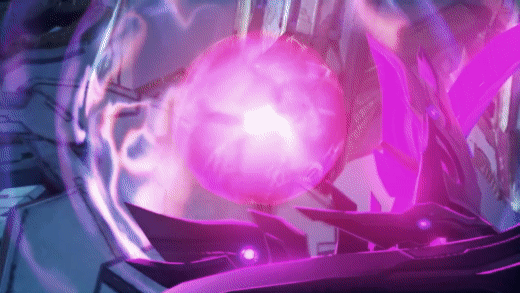
X acting on Z’s orders, interceding in Ouroboros’ first battle with N.
X and Y act as avatars in the hegemonic way that I described in my study of Okami: they participate, at their player or god’s direction, in the events of the world in which they exist, but they also shape and limit the possible systems of meaning within that world according to the meaning which their player or god wishes to consume from that world.[86] With the Colony Ranks, X imposes a single system of motivation within the world: the population of Aionios is limited to goals and aspirations within the context of winning the war game imposed by Moebius, ensuring that the game fully describes all available actions. With the Flame Clocks, Y imposes a single system of output within the world: the only meaningful byproduct of the population’s actions is the life energy released through death and siphoned off to Moebius: the architects, players, and audience of the war game.
These twin pillars of motivation and output are one lens through which we can characterize not just how societies and worlds can be limited, but also how avatars in video games often relate the other characters in the game to the player of that game. As the focus of a video-game story’s point-of-view (not necessarily, but very commonly), the avatar(s) acts as the video game’s main character(s). Other characters take actions that relate to the main character’s journey, and the events of that journey, including the avatar’s interactions with other characters, coalesce to convey some kind of meaning to the audience, the person engaging with them.
I don’t think we need to view this structure as intrinsically hegemonic—it’s really just a statement of how characters, plot, and story relate in any storytelling medium—but I think that the element of agency afforded to the player of a video game creates a potential for us to view this structure as hegemonic (and, consequently, for some video games to tell stories about such hegemony). As we act as players and bring about more events in the game’s world, our avatar’s actions are the most immediate content of those events, with any other character we encounter seemingly reactive to the avatar’s journey and behavior. So it can sometimes feel as though our actions as players were binding the other characters to the avatar and the story, as though we were dictating, through our focus on the avatar, that the motives available to other characters are constrained to only those that provide an interesting output for the avatar’s journey unfolding before us. X and Y show us what it would look like if that binding of motive and output really were present as a causal force within a video game’s fiction.
This structural similarity between (1) X and Y’s relationship with Z and (2) an avatar’s relationship with a player goes some distance toward explaining why we can find ourselves sympathizing with Moebius’ actions even as we detest them—an uncanny juxtaposition of sentiments most clearly on display in the game’s first showcase of Y’s handiwork.
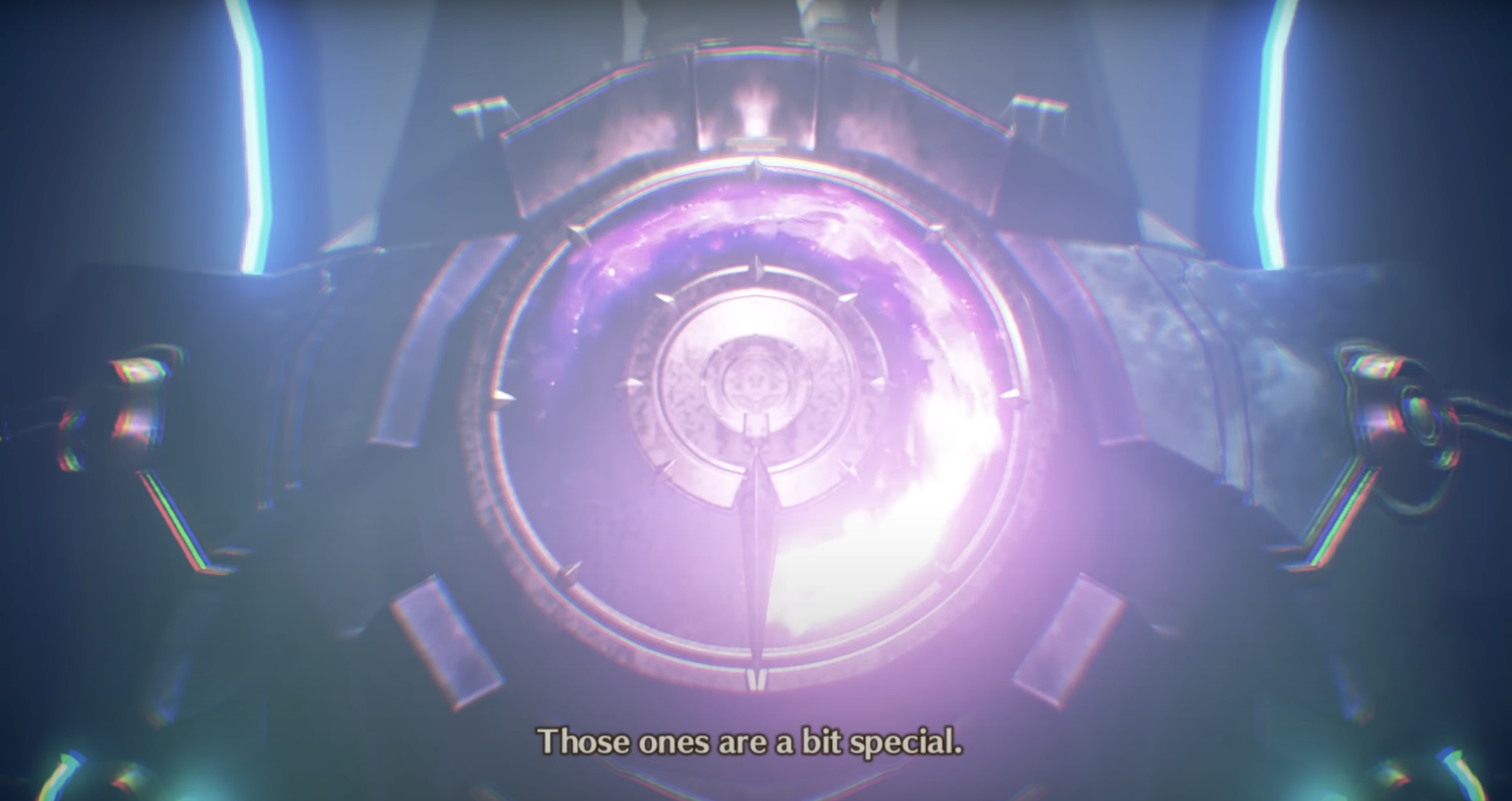
Y’s Flame Clocks specialized for Ethel and Cammuravi’s Ferronises, which directly feed Moebius based on Ethel and Cammuravi’s combined vitality.
The duel between Ethel and Cammuravi stands in my mind as one of the most memorable and moving sequences from the whole of Xenoblade Chronicles 3, and there’s reason to think that the overall story is coordinated to highlight it in exactly this way. Following their rejection of O & P’s control and their full expenditure of their life force, Ethel and Cammuravi’s Ferronises stand immortalized in Engardo Pass, frozen in combat with each other, for the rest of the game, one of the few true monuments to come into being from the events of the game’s plot. The duo’s living testament to the bond of rivalry is overwhelming, particularly as a moment in which two Colony leaders take it upon themselves to overcome Moebius—inspired by Ouroboros, but on their own terms rather than through collaboration with Ouroboros.
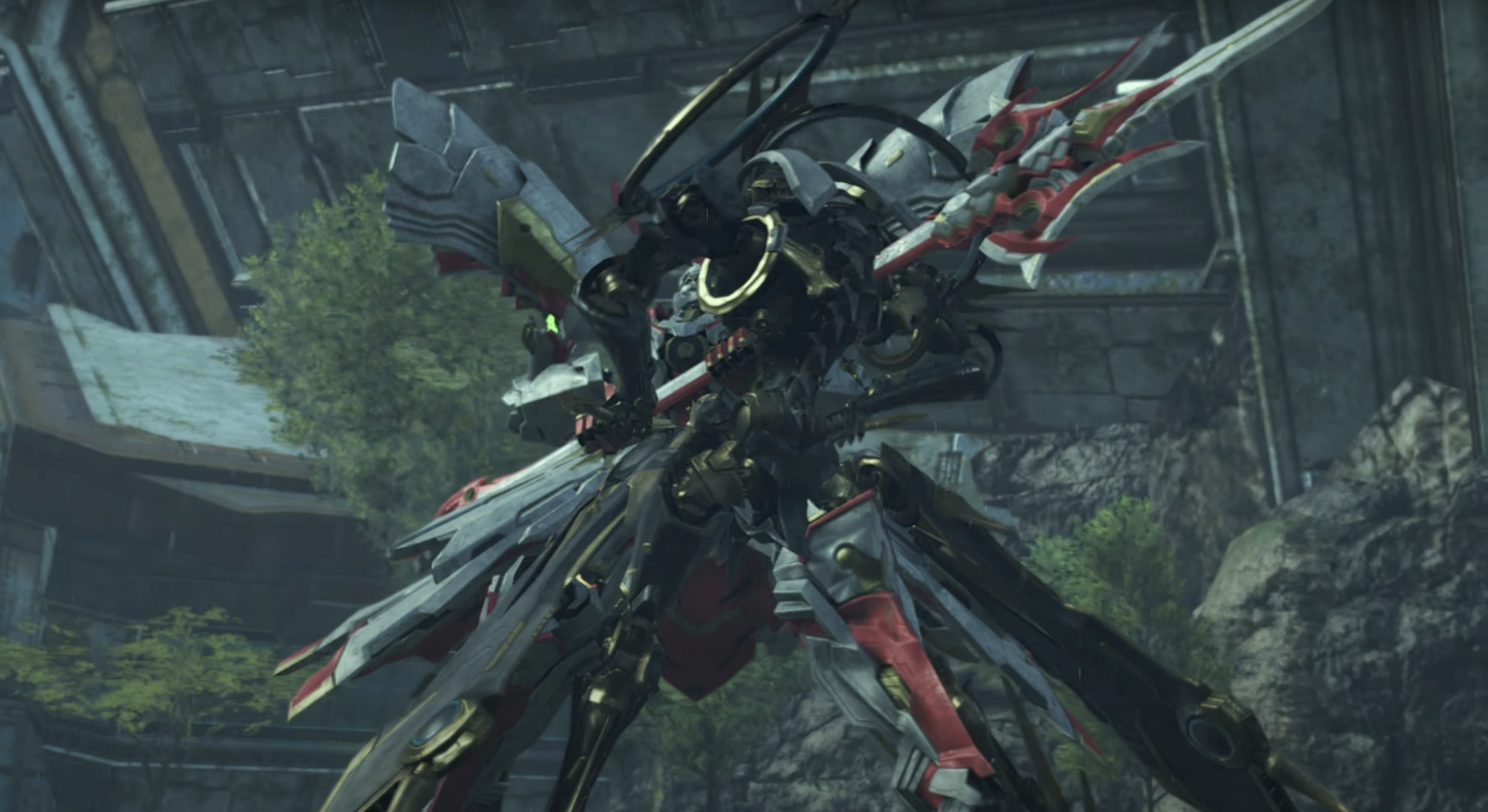
Ethel and Cammuravi’s Ferronises, a living testament to the rivals following their fatal duel.
Yet there’s an uncomfortable sense in which Ethel and Cammuravi don’t overcome Moebius, and it’s in that sense that our own similarities to Moebius make themselves known. Not only are the two reborn back into Moebius’ cycle of death and rebirth—liberated from nothing, until the City and Ouroboros intervene—but Moebius also indicates, both before and after the encounter, that they had fully anticipated and orchestrated the entertainment value of the duel. When N introduces to Ethel the plan for her to join with Cammuravi against Ouroboros, he smiles that he is effecting this team-up for “entertainment,” that it would be more “fun” to do this than to force the liberated Ethel back under the Flame Clock’s yoke through a simple execution and rebirth.[87] When Ouroboros later meets Y, Y smiles at Ethel and Cammuravi’s modified Flame Clocks as “some of [his] finest work,” and he asks the party, like a proud father speaking of his children: “Did they not thrill you? The ebb and flow of their lives…! Ahhhh…”[88] The Flame Clocks in which he takes such fatherly pride were altered specifically so that each was linked to both Ethel and Cammuravi’s life energy, so that “the more the two of [them] get heated up, the more [their] power grows”—and the more energy is sent “straight to Origin,” to Moebius.[89]
Ethel and Cammuravi may both free themselves from the influence of the Moebius Iris during the events at Engardo Pass, but their life force is drained by Flame Clocks designed to turn their unique rivalry into a form fit for Moebius’ consumption.
As the player, we recognize that their confrontation really is great “entertainment,” just as Moebius believes; we derive value from the act as a part of Xenoblade Chronicles 3’s story, just as Moebius directly thrives off of its energy. Our own experience of Ethel and Cammuravi’s rivalry is evidence to us that Moebius was right, which seats us in the Amphitheatre next to Z. Just as our own avatars act within games in ways that bring about entertainment for us, so has Z’s implementation of avatars warped an entire world into an inescapable system of entertainment.
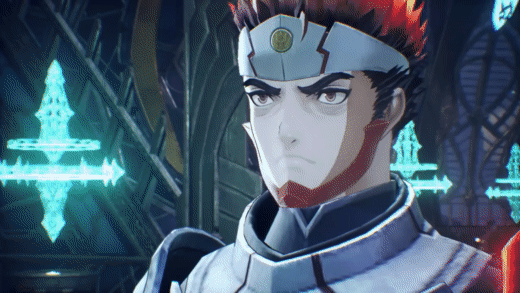
N foreshadows that Ethel and Cammuravi’s duel will make for great entertainment.
This system is inescapable for characters like Ethel and Cammuravi because, true to the nomenclature of Moebius and the worldview of Wittgenstein 1, Z has usurped the most basic elements of language and meaning in Aionios. Wittgenstein 1 proposes a singular logic that underlies all the “disguises” worn by language in all its colloquial forms, so that the only apparatus we have for expressing significant thoughts—the 26 letters of the alphabet, in the English language (and in the symbolism of the English-language version of Xenoblade Chronicles 3)—is exhaustively described by that logic.
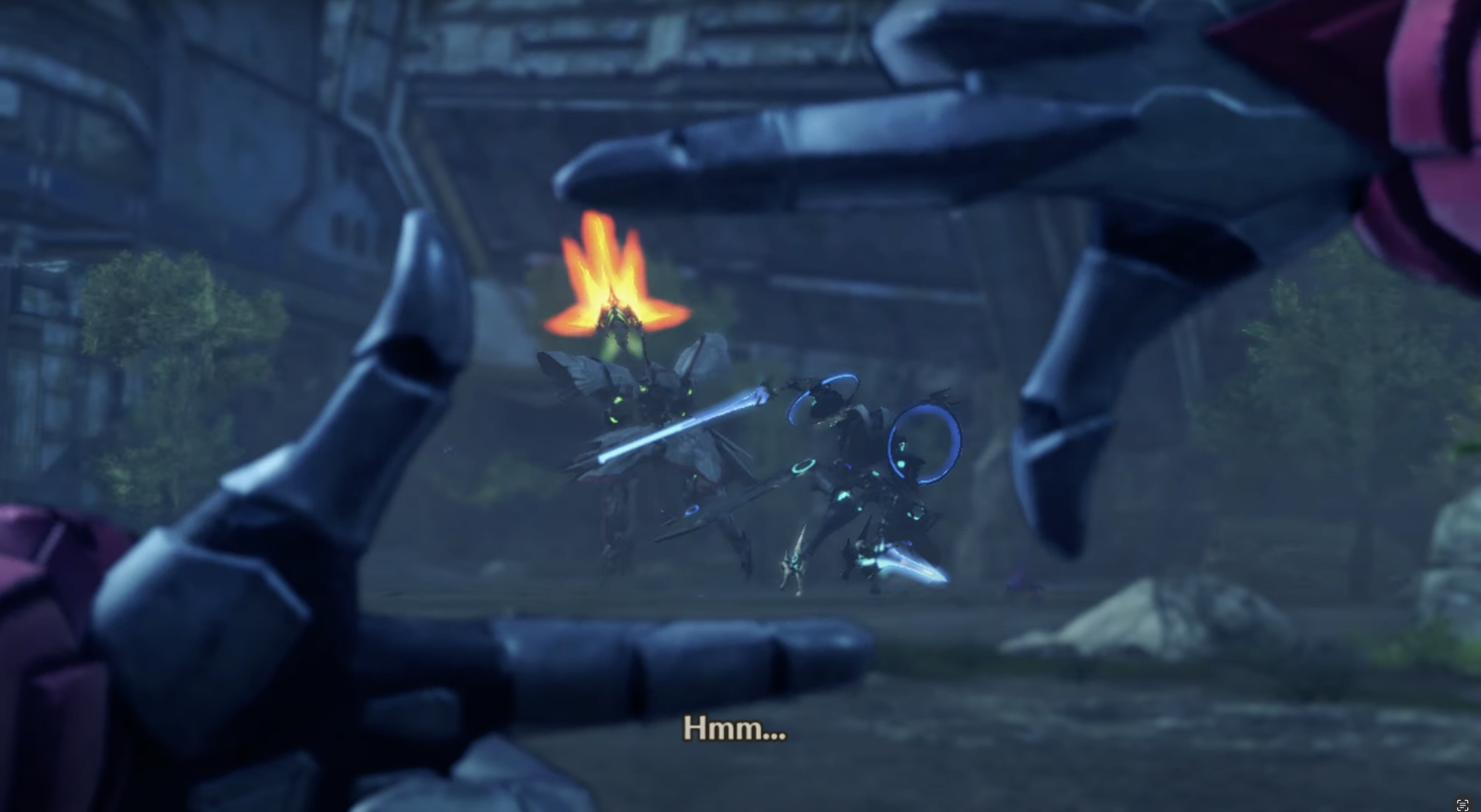
O frames the “shot” of Ethel fighting Cammuravi as he contemplates exerting more direct influence on Cammuravi—a useful image to keep in mind as a model of how Moebius frames meaning within Aionios.
We don’t just see this symbology play out in the convention of Moebius members taking the first letters of their Aionian names as their names within Moebius, collectively turning Moebius into the world’s alphabet: the distinction between X, Y, Z, and the rest of Moebius also tracks the notation of the logical language deployed in the Tractatus to explain how language relates to the world—the explanation of what language is, such that it is the right sort of thing to form pictures of the world (S1).
The Tractatus says that language is the totality of propositions, where the simplest of those propositions (i.e. elementary propositions) assert atomic facts about the world by connecting together names, which refer to the objects that constitute the world, and all other propositions are built out of those elementary ones.[90] In composing the logic that he takes to define and limit language, Wittgenstein typically uses letters like x, y, and z to represent variables in his notation, whereas letters like a, b, and c represent particular names within the range of a variable, and letters like p, q, and r represent particular propositions.[91] In other words, within the notation of Tractarian logic, x, y and z are the “real” variables that may be filled in by any name or proposition, whereas a, b, c, p, q, and r are “apparent” variables, only referring to specifications derived from a real variable.[92]
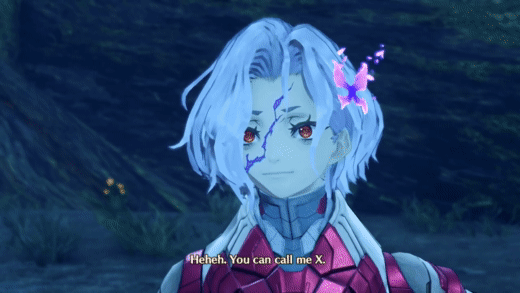
X identifies herself and Moebius L.
The notational relationship between real and apparent variables in Wittgenstein’s logic helps us see how X, Y, and Z’s relationship links up to the other Moebius members and exploits those members to manifest their one and only meaning within the world of Aionios. As real variables, x, y, and z contribute to the logical symbolism that, remember, the Tractatus says does not belong to the realm of what can be said: they operate within the arguments on account of which the Tractatus’ own propositions are to be treated as nonsense once the reader understands what they are trying to indicate. They don’t exist within the world, and yet they structure what meaning is possible within it, much as X and Y participate in enforcing motivation and output for Aionios without themselves really having Aionian history, identity, or a basis in Origin’s source data about the worlds from which Aionios derives.
Apparent variables, on the other hand, are in a certain sense more concrete, and metaphorically (at least as far as Xenoblade Chronicles 3 goes) all the more precious for it. While still part of logical symbolism and thereby susceptible to the same charge of nonsense as the real variables, they specify, from the real variables, particular values; these values, names and propositions, are able to do the sensible work of referencing real objects and facts. In this regard, the rest of the alphabet is at least one less step removed than x, y, and z from touching the world as significant propositions do. If we imagined some of the Tractatus’ significant content personified, deciding that it would feel safer within the world by finding a way to abstract itself away from that world, I think we would be picturing the exact sort of paradoxical dissociation that would come from a name or proposition aspiring to become an apparent variable that could stand for itself—and we’ll see that this psychology captures the phenomenon of people within Aionios deciding to become a part of Moebius, a specification of particular values from X, Y, and Z.
When X confronts Eunie and her friends in the remains of Colony 5, she is joined by Moebius L, whom she dismisses as “just some underling” whose name she doesn’t care to remember.[93] To me, this is the key image of how X and Y, as Z’s avatars, channel and bring about the worldview of Wittgenstein 1. Their sculpture of motivation and output crafts the picture through which Z relates to the world (C3), but that sculpture is insufficient to make the picturing work: they need the more specific elements, which more closely relate to the world, in order for their system to fully capture all possibilities of meaning within Aionios. To that end, they involve members of the world as members of Moebius; and, just as we sometimes think of NPCs as mere tools in service of the player and avatar, so X seems to suggest that, even in ascension to Moebius status, these people are mere tools to her and Y: underlings who can reach a different level of understanding by virtue of becoming Moebius, but who can never fully step outside the picture of Aionios and therefore can never attain a state according to which they would really matter (C1). And as callous as X’s reasoning is here, there’s a sense in which it seems justified: just as the Flame Clocks and Colony Rank system control the inner lives of those in the Colonies (their goals, concerns, etc.) by defining figurative distances which people must travel in order to achieve anything of value (the killing of a certain number of enemies, the acquisition of certain rations, etc.), so too it seems that people who become Moebius are so thoroughly brainwashed that they subsequently manage their inner lives by standing in, and dwelling on, distanced relationships to their past lives on Aionios (C2).
The apparent variables can never fully reach beyond the existential despair that X and Y created for them in the first place—an activity that was carried out at the behest of Z, who, we’ve seen, instigated it to escape his own despair.
§1.23: The Confederates of Moebius: Recruits from Aionios
Perhaps the saddest consequence of X, Y, and Z’s world order is that it impels talented, original individuals to re-conceive themselves as “swine” and seek Moebius as “a machine for becoming decent”[94]—though, in this case, “worms” may be more appropriate than “swine.”
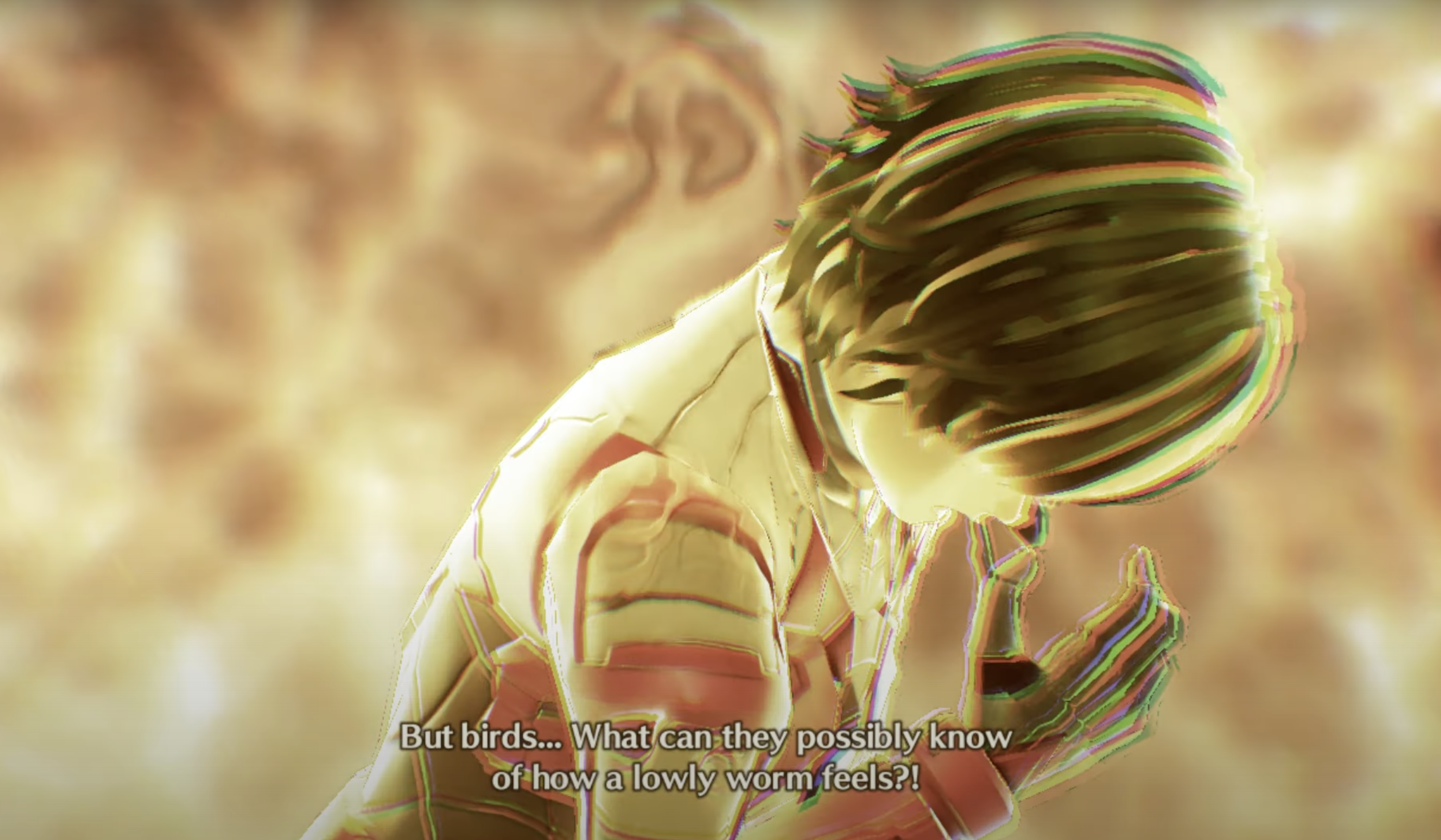
Joran, lamenting the course of his pre-Moebius life.
The alphabet soup of Moebius offers us a wide array of windows into how Aionian people become members of Moebius and how they react to the transition, both in the short term and the long term. I want to arrange 11 of these windows in a perspicuous way for seeing how the struggles and choices of these individuals fold into Z’s totalitarian imposition of the Wittgenstein 1 worldview upon Aionios:
- J and S show how Moebius invites Aionians to persecute themselves based on their individuality and to escape this persecution by joining Moebius.
- M and N show how this escape from self-persecution leads not only to objectification of oneself, but also to objectification of others about whom one cares.
- D, E, K, R, and V show how participation in Moebius is participation in the playing of a game.
- C and T show how Moebius’ players can stop playing the game.
§1.231: Persecution of the Self: Joran and Shania
There’s a particularly pitiful sort of self-defeat that comes from joining a system in order to escape the pain brought about by that very system, and that’s what we see in the Aionians who elect to become Moebius. Joran’s story showcases how easy Moebius makes it for such people to deny themselves in a misdirected effort to save themselves.
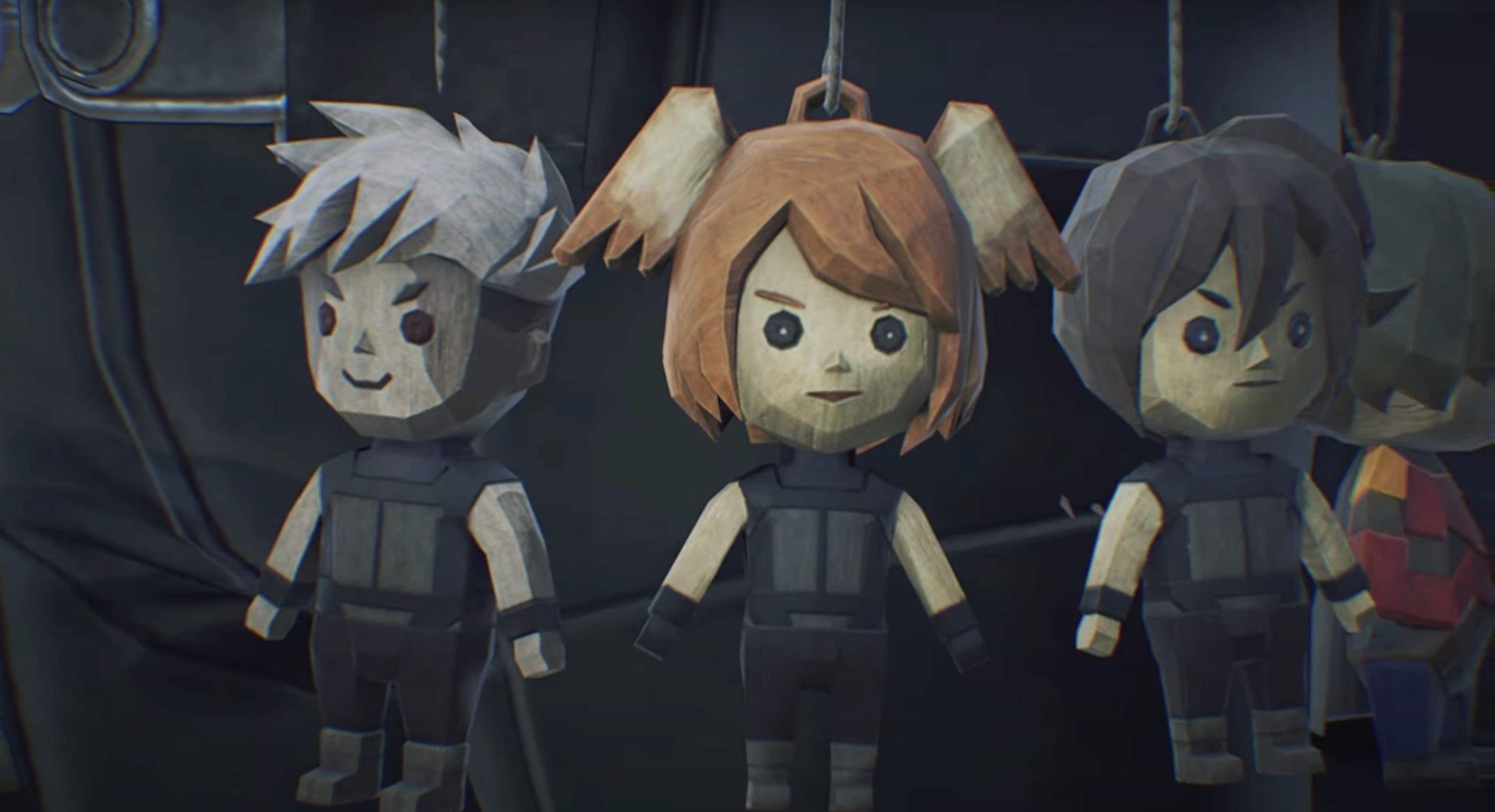
Joran’s wooden dolls of Lanz, Eunie, Noah, and J.
We see that Joran has a talent, one which his friends admire: in Young Noah’s words, Joran can create beautiful dolls, whereas “All we can do… is slash and shoot each other.”[95] Yet Joran recognizes that this talent is one that has no place in the war-based world which Moebius manufactures and enforces: in that very same flashback where his friends stand in awe of his talent, we see Joran’s doll of himself, which foreshadows his transformation into J, and which he describes as “what I wanna end up like, someday.”[96] This mirrors what Joran tells Ouroboros later when he rails against his pre-Moebius self: he sees that self as “useless,” which his talent literally is, when considered in the context of a Moebius world that makes no space for uses outside of warfare.[97]
The sad irony of Joran and those who share his lot is that, by joining Moebius, he is attempting to overcome his sense of uselessness by perverting his talent into a form that has a use within the system that suppressed it in the first place. When J became a Consul, Moebius gave him a unique, “incredible power,” as each Consul is given: in J’s case, the power to fashion “mudpuppets” out of people’s memories.[98] He seems to think that this power gives him the sense of place for which he always envied his friends: he calls them “birds” who took pity on him, a “worm” who wanted to fly, and he calls his Consul power, gleefully, the ability to “‘[r]efashion my wings”—becoming a bird after all.[99] What Joran mischaracterizes in his friends as the ability to soar freely like birds is not freedom but rather their competency within the system of meaning that Moebius imposes upon Aionios; what he mischaracterizes as wings in his ascension to Moebius is not freedom but rather the ability to use his talent in a way that imposes that same system on others, thereby conferring upon it a value within that system.
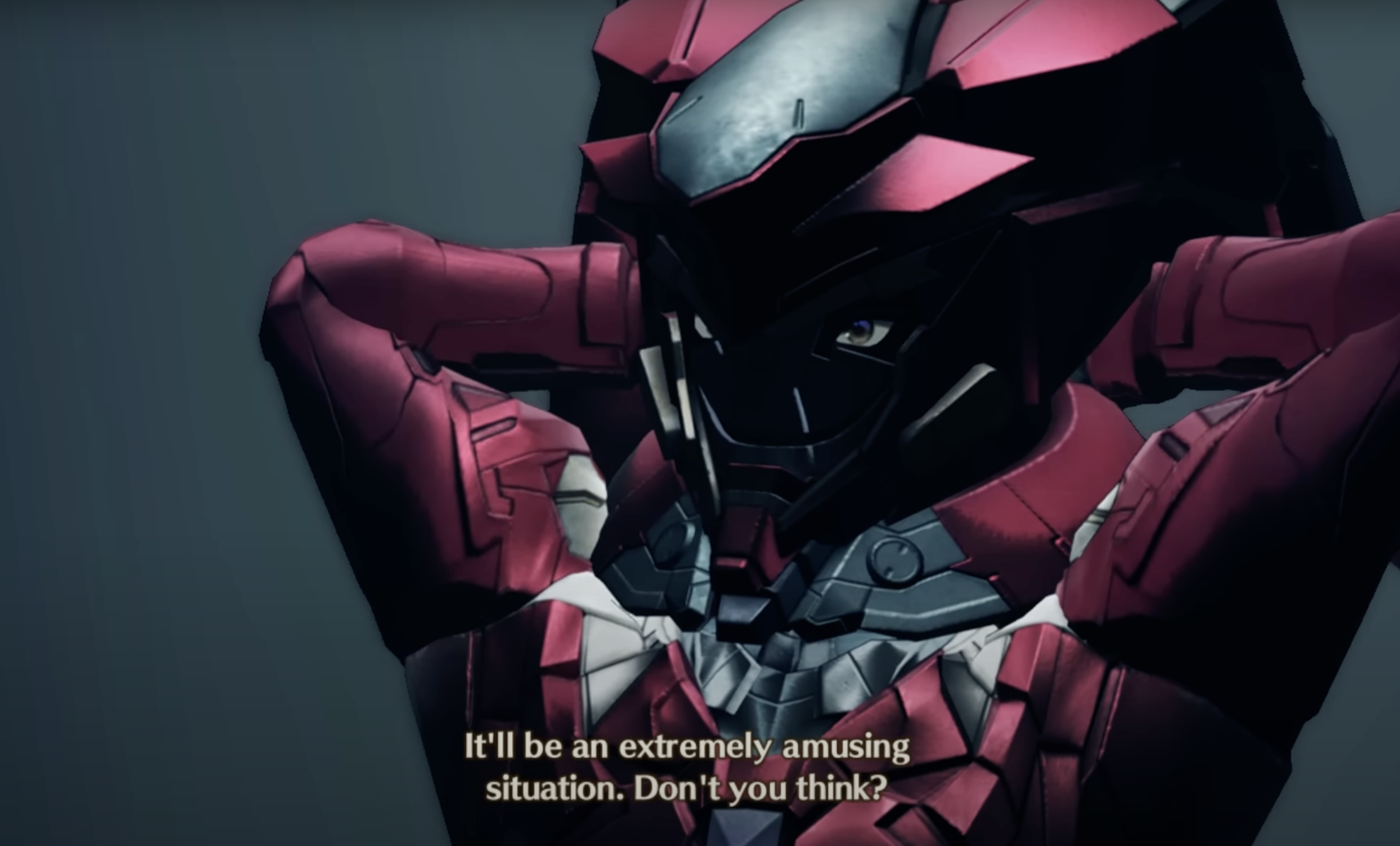
Joran as J, forecasting the amusement of his presenting himself before his old friends for the first time as Moebius.
Recalling our model of Wittgenstein 1, this model of ascension to Moebius is a little like someone being persecuted for not being able to participate in a singular world religion and seeking inner peace by restructuring his character in a way that allows him not only to be accepted by that religion, but to become a clergyman within that religion (C2). J distances himself so much from the Joran whom he views as cowardly that he has trouble even recollecting his pre-Moebius past,[100] reducing it to a singular picture of worm-ness that he surmounted and drawing strength from that finite meaning which he permits his former self (C3). Yet, in place of those authentic emotions of compassion, friendship, envy, and sadness that Joran felt in living his life with his friends, J doesn’t show a sudden sense of inner peace or a vibrant emotional life: instead, as in the above image when he proposes to other Moebius members his intercession in Ouroboros’ journey, he seems to prize that same sort of amusement advocated by N, Z, and other representatives of Wittgenstein 1—an amusement that, we’ve seen, has its origin in the service of Z (C1).[101]
This is characteristic of becoming Moebius: in trying to escape from a state of existential poverty in which one’s understanding seems to leave one feeling like swine, one enslaves oneself to a system in which one’s nature cannot be said, but only shown—and is shown, like the Tractatus, in a way that undermines oneself (S2).
We might hope that the City—held up so often in the game as a symbol for the potential of life not bound by the fetters of Moebius, nor even sourced from Origin’s data—might also hold itself up as proof that new life can avoid Z’s influence in a way unavailable to those within the Colonies. The flashback to Joran’s doll-making talent is even triggered by Ouroboros witnessing a child crafting similar dolls in the City, almost as if to suggest that Joran’s path to becoming Moebius was entirely dependent on his having been born in Moebius’ cycle of death and rebirth.[102] Sadly, the game goes out of its way to dash those hopes.
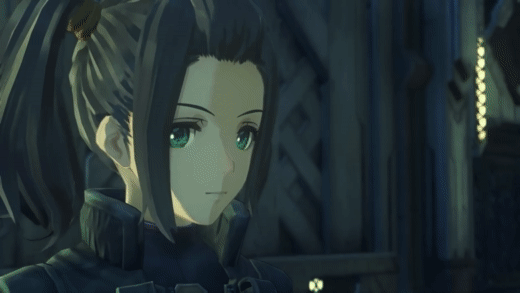
Shania’s voluntary submission to Moebius.
Shania and Joran’s stories share the structure outlined above. Like Joran, Shania sports a creative talent that doesn’t fit within Moebius’ war-oriented system of meaning: where he crafts dolls in the image of those with whom he relates, she crafts paintings. Where J is gifted with mudpuppets as a perversion of his talent, S is gifted with the ability to freeze local areas of the physical world, “[e]xactly like a painting on a canvas!”[103] Where Joran joins Moebius after shunning his friends’ encouragement of his talent, Shania joins Moebius after Ghondor and her own father imply to her that her talents lie in artwork rather than in combat.[104] The key distinction is that Shania reflectively chooses the path of becoming Moebius after being born and raised in a culture that represents itself as empowering its people to choose any path, free from Moebius; Joran, as we’ve seen, lacked the capacity to even conceive of other paths in life.
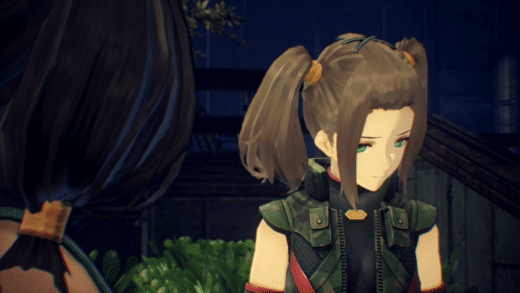
Shania, advocating her family heritage rather than her talent as her path in life.
What’s tragic and instructive about Shania’s case is that someone who is demonstrably able to choose, in a way that those fettered by Flame Clocks and Colony Ranks cannot, can cultivate a self-concept according to which she believes herself to be just as bound as those in the Colonies, and can therefore be led to join Moebius for the same reasons that someone in the Colonies would. We see in Shania’s flashbacks the tremendous pressure to which her mother subjected her, shaming her for not being to protect the “legacy” and “honor” of her family by becoming an Ouroboros candidate; we see how this leads her to shred her artwork, after her father and Ghondor had encouraged her talent earlier in her life.[105] The City’s culture of honoring its founding families’ heritage in combatting Moebius, ironically, fosters the expectation that at least a certain class of its citizens will serve a combat- and Moebius-related role—and, as Joran’s dolls were useless in his role as a Colony citizen, so is Shania’s painting useless in the role her heritage suggests for her.
Of course Shania could choose to go against her mother and the City defense’s expectations, and of course the people who know her best can even encourage her to do so—but the weight of a legacy tied to the founding of one’s home (and to the very possibility of one’s existence) can cripple one’s aspirations and lead one to internalize that pressure as a goal rather than cultivating one’s own interests. We saw how X and Y help the player to sympathize with Z; Shania invites a similar sympathy for those who choose to join Moebius. Where Joran and others are embedded in the rules of a fantastical world that denies choices in ways dissimilar to our real world, Shania leads herself to the same despair and untenable self-persecution through considerations of family and community expectations—considerations to which many of us can relate, and which might invite real people to feel as though they have no choice of role even when, strictly speaking, they do. Small wonder, then, that even people with many options—people in positions such as that of the biographical Wittgenstein, who explored many jobs over his life and was born into one of the wealthiest families in Austria—can reach the point where they avow the dogma of Moebius, calling their own peers “pawns” just as fully-fledged Consuls refer to those in the Colonies.[106]
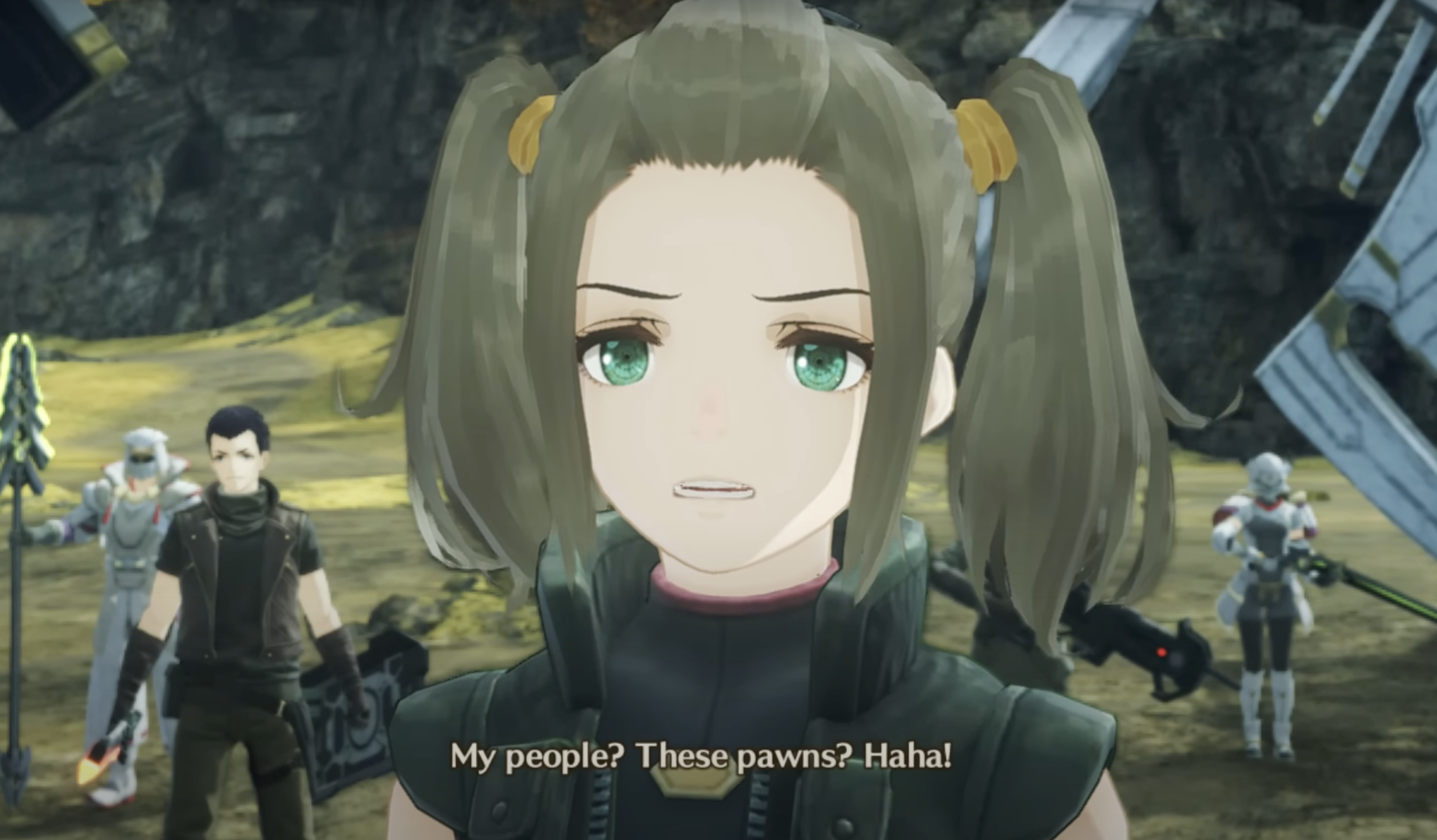
Shania after defecting to Moebius, laughing at the thought that those in the City would ever qualify as equals whom she could betray.
In Shania, we see the sinister gravity of Moebius at work: even those outside its most immediate domain of influence can be pulled in, to the point that she chooses suicide as a desperate effort to reach a different level of understanding in the world (C1, S5, S6). This gravity goes beyond influencing individuals’ self-concepts: as the case of M and N shows us, it also pulls in those who want no part in it, by influencing individuals’ conception of others.
§1.232: Persecution of the Other: M and N
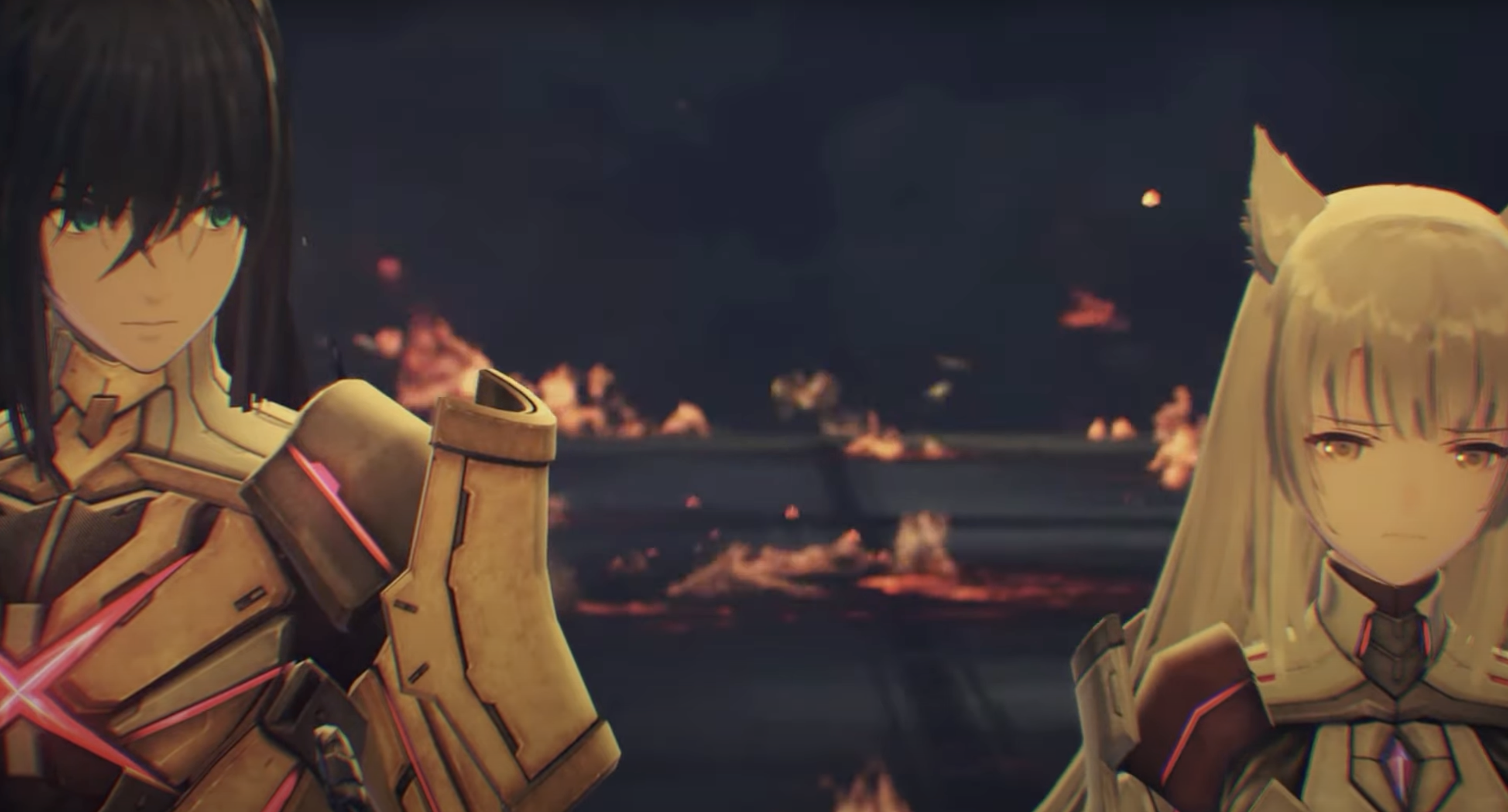
Mio’s moment of cold realization that N has slaughtered the City and trapped her in the Moebius form of M.
Twice over the course of Xenoblade Chronicles 3, we see Noah bullied to the point of submission to Moebius: once in Noah’s recollection of his past encounters with Z, in which he was eventually convinced to become N, and again when N imprisons Noah and the rest of Ouroboros in Agnus Castle in anticipation of executing Mio during the eclipse, an experience that Noah later admits brought him to the point of pure empathy with N.[107] (After Wittgenstein had finished the Tractatus, he was also captured as a prisoner of war in Italy for almost a year, at the end of World War I, during which time he disseminated and discussed the work through authorized correspondence with his closest intellectual circle: Bertrand Russell, Gottlob Frege, and Paul Engelmann.[108]) On both occasions, the despair to which Noah is driven is similar to Joran and Shania’s, but it is more explicitly other-oriented.
Joran and Shania’s talents both involve others by representing the people they care for in doll and painting forms, but their despair is more closely related to their own sense of alienation in a world that doesn’t permit those talents; Noah’s analogous source of meaning comes from Mio, with whom he has a specific relationship “thriving and persisting far beyond Homecoming”—and whom he can never save from death and rebirth at the hands of Moebius’ war.[109] Like the meaning to be found in relating to people through doll-crafting and painting, the meaning to be found in an intimate relationship—whether intrinsically valuable, romantic, a propagation of humanity, or anything else—has no place in a world where people are pawns, only related to each other in the sense that different roles in a military unit are related to one another (a tension at play early in the game when Noah’s Colony 9 unit bathes together with no concept of intimate relationships[110]).
If Moebius’ path to comfort within its totalitarian worldview is to pervert an individual’s talent into a method of enforcing that same worldview, what might you expect that path to look like when the “talent” is a relationship with someone else? I recently replayed The Legend of Zelda: A Link Between Worlds, and I think it might look a lot like the main villain’s power in that game: taking a three-dimensional individual and literally capturing them within a static, two-dimensional painting.

Yuga sealing Osfala, one of the Seven Sages, within a portrait at the outset of The Legend of Zelda: A Link Between Worlds.
This is what Noah does when he decides to accept Z’s offer for him and Mio to become N and M: he objectifies Mio in the sense of treating her as an abstraction, the object of his feelings and the source of his personal meaning, rather than as a person. The ascension of Noah and Mio to their status as leaders of the Kevesi and Agnian Consuls is entirely about Noah’s actions in response to his despair, with Mio totally reactive to Noah. Mio has no say in becoming M: after Noah decides to become N, she is represented on the Amphitheatre’s stage as someone unconscious, on the brink of death and rebirth, whose future N must decide.[111]
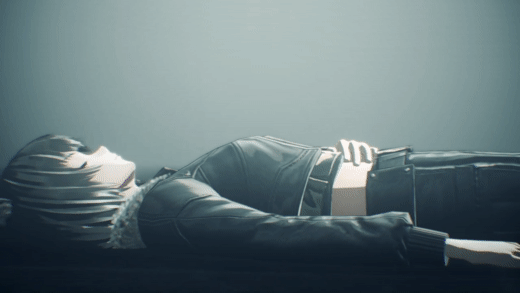
Mio onstage at the Amphitheatre, effectively a prop for Z to motivate N’s destruction of the City.
M’s own feelings about her treatment are clear not only in what she says, but perhaps even more in what she does not say: in a game with hundreds of hours of story and enough dialogue to fill a library, M utters perhaps a few minutes’ worth of words to N. We learn from X that, contrary to N, M is barely engaged with the activities of Moebius—and when she is, it’s to propose the institution of such practices as Homecoming, directed more toward the well-being of the Aionians than the Consuls.[112],[113] This paints a vivid picture of M’s imprisonment within Moebius: once she sees, in horror, that N massacred the original City, their descendants, she understands that Noah completely warped not only himself but also their relationship in order to fit it into a mold that Moebius could accommodate.
Noah named the child who seems to be represented as the first of their descendants who would populate the City, a child whom Mio called their “hopes and dreams made into a little person”;[114] N slaughtered those descendants and later tells Noah that they were “mere chaff […] superfluous to us Moebius,” proclaiming that, as their creator, he was entitled to decide their lives and deaths—a different face of the same sentiment we saw in Shania and R’s reference to Colony members and Cityfolk as “pawns.”[115] It feels inevitable that M should resign herself to the oblivion of a systemic existence as a concept rather than as a person, when the very evidence of her personhood—her progeny—was annihilated (resign herself, at least, to pass on the key to the Cloudkeep and see whether Nia’s promise to her will come to pass: that one day, M and N’s “true selves” will return, and the authenticity of their relationship along with them[116]).
M and N demonstrate how the self-directed despair of Moebius claims others as casualties: if two people in a relationship were both to despair and jointly decide to join Moebius, then their relationship could pervert into a form that would be sustainable for the two members of Moebius. But two people who stand in a genuine, bidirectional relationship to one another would presumably be able to see each other’s despair and help each other out of it by virtue of that relationship (as, we’ll see, Ouroboros and their communities do);. The solipsism of Moebius, theoretically and emotionally, makes the relationship itself the object of one party’s (in this case, N’s) despair, in which case the other party to the relationship (M) must be warped against his or her consent in order for the despairing party to quiet his or her mind (S2, S7, S8, C2). With M and N as the heads of the Kevesi and Agnian Consuls, we might even suppose that this relationship of objectification, binding one Consul to another, is exactly what’s required to bind one world to another: a marriage that devalues both parties in pursuit of an unambiguous and unitary value.
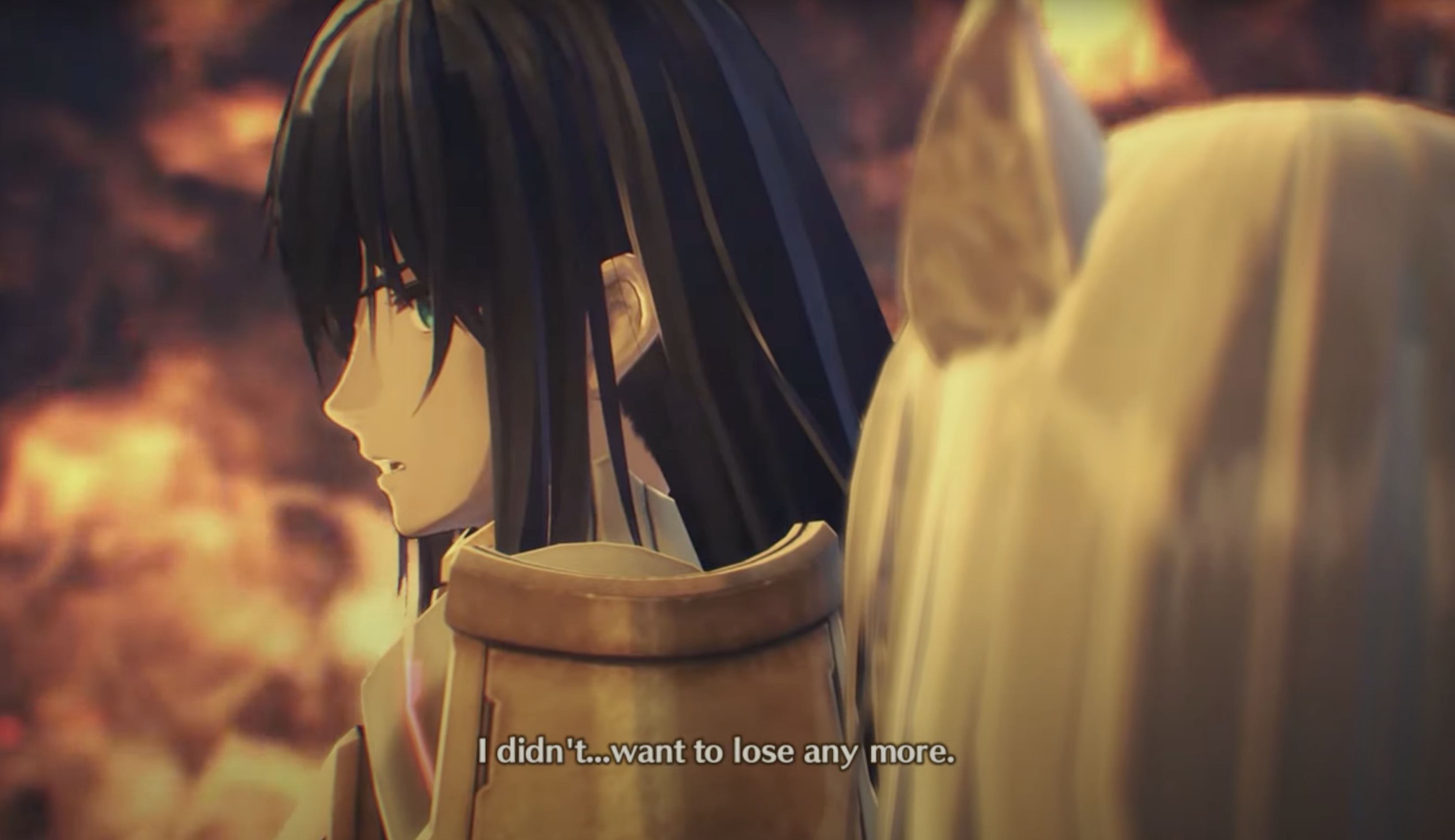
N’s best explanation for his choice to commit the genocide of his own descendants.
As Wittgenstein kept the objects of his love at a distance, quieting his mind at the cost of stoking his despair over the frictions of his relationships, so N undermines the two things he values—the City and Mio—in an effort to stop losing the game that Moebius’ system compelled him to play.[117] Yet once he’s in the company of Consuls, like all the rest of them, N starts playing the game of imposing that system upon Aionios. For as much as Z and others represent the Endless Now as a static state in which the world must be held, other Consuls show us the dynamism of this game.
§1.233: The Game of Persecution: D, E, K, R, and V
R and V demonstrate how literally this war game is a game for Moebius. Their game upon the Amphitheatre stage near the end of Chapter 3 shows Colony skirmishes to be treated as an actual tabletop game, with pieces representing the fighters we see in the real skirmish, colored lights indicating their life force, and a wine glass filled with a radiant red fluid representing the Colony life force, to which the winning Consul is entitled.[118]
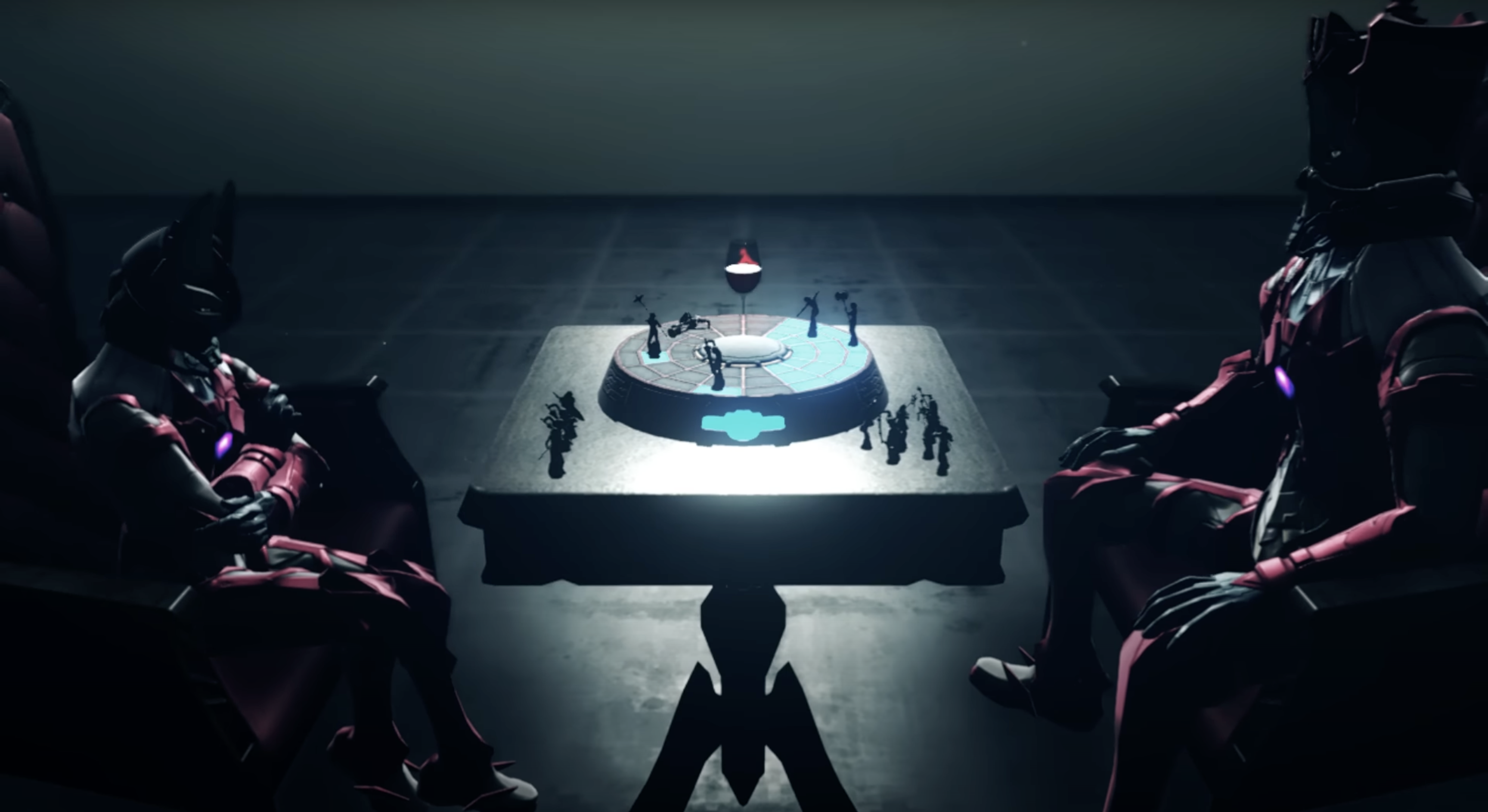
R and V playing out a skirmish between their respective Aionian Colonies on the Amphitheatre stage.
The game highlights that Wittgenstein 1 world order of the Endless Now, which Z and others represent as a kind of physical or metaphysical law ensuring the stability of Aionios, is just one activity that Moebius has manufactured and elected to impose upon Aionios. Remember, too, that this game plays out directly on the Amphitheatre stage before Z’s eyes in the audience: even as Consuls purport to derive enjoyment from the game, the game is performative in service not of its players, but rather of their ringleader. Z says as much to N directly following this skirmish. When N expresses distaste at the game’s “vulgar pleasures,” Z laughs that N “has not the luxury” of savoring anything beyond such pleasures:
Z: Pleasures and sorrows, meetings and partings, their roots are the same… Tolerance of existence is at the heart of them all.
N: You want me to frolic with them?
Z: You shall find there’s no such thing as luxury in this world. Everything buds from but a single thought. That you yourself are here…is proof definite thereof. […] You need not understand. You can simply remain as you are… That is enough.[119]
Z doesn’t say that luxury is nonexistent, but rather that it is absent from this world, and he utters this in the context of both (1) pointing out that all sentiments and interactions are a consequence of tolerating existence and (2) tacitly encouraging N to go out and “frolic” in the world as a living testament to his choice to become Moebius, after which N does go forth and instigate the events surrounding Ethel and Cammuravi’s duel and the events at Keves Castle for “entertainment.” In this context, I think that this conversation underscores the enforced distance and levels of understanding separating Z from the rest of Moebius: as we’ve seen with J, S, and N, those Consuls who elected to become Moebius undermine themselves by trying to abstract away from their Aionian lives in untenable ways. Thus, they will always be bound to the world and the oppressive force it exerts, even once they become officers of that oppression—and such attachment will always render unreachable the pure luxury of entertainment that Z enjoys, fully absent from the world despite arbitrating its order.
Put another way, the Consuls are a sort of acting troupe, putting on the fiction of a story in a way that muddles their identities with the world they are enacting, whereas Z, an audience member and director, enjoys the privilege of seeing that fiction at a distance.
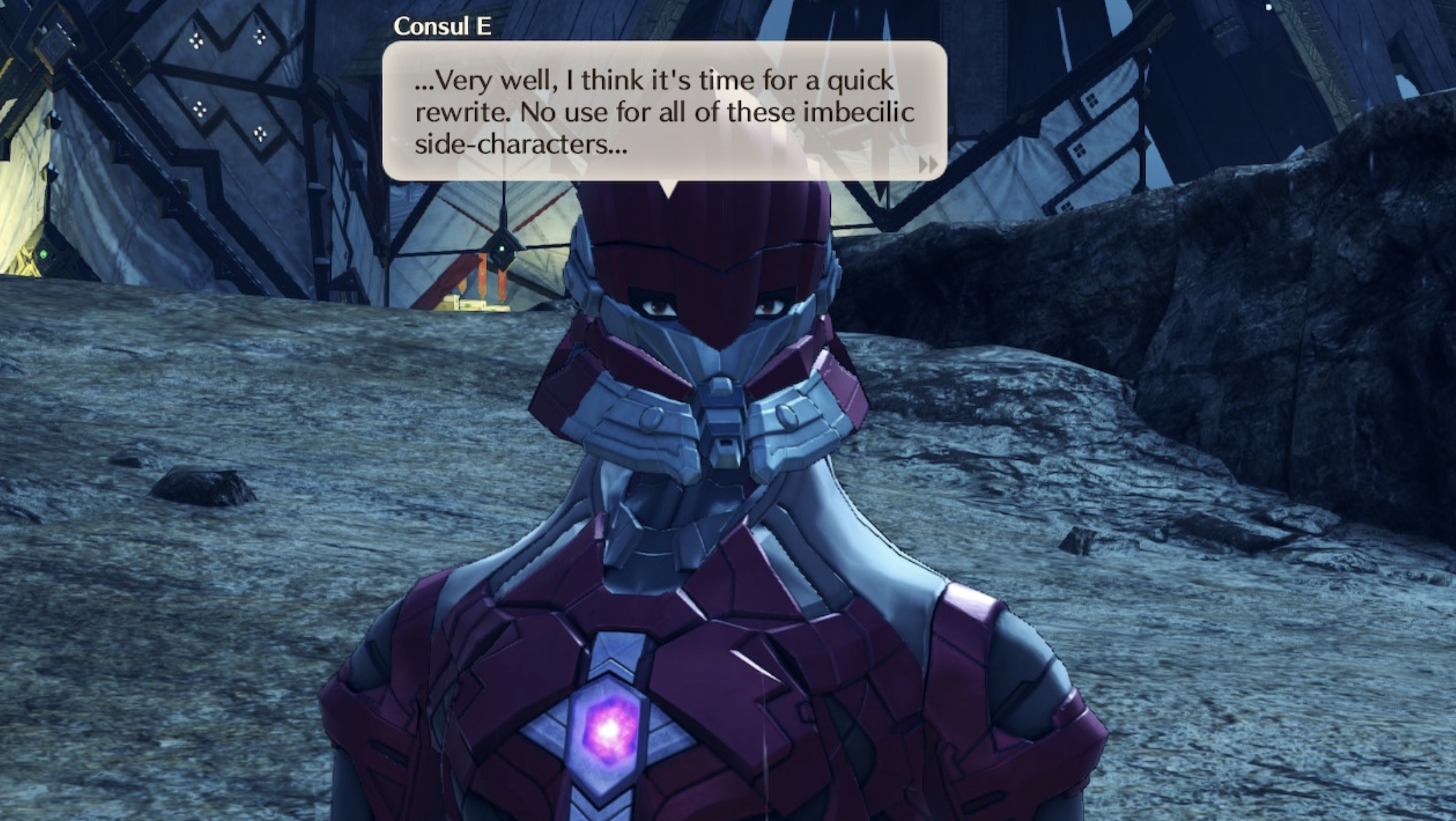
Consul E interceding to challenge Ouroboros after they defeat Alexandria in Colony Iota.
Small wonder, then, that Consuls such as E and K seem to recognize and relish this exact sort of theatricality, the only vulgar pleasure available to them. E has taken this sense of performance so deeply into his identity that it colors his language: he calls for a “rewrite” after Ouroboros takes his “cherished game piece,” Commander Alexandria, off the board of his “drama,” inviting them to join him in “act two: carnage.”[120] In Ouroboros’ early confrontation with K, the player sees a video-game boss that proclaims to the party, by way of introduction to the boss fight, “It’s the big bad boss. Boo!”[121]
Our study of Moebius shows us why it’s mistaken to see such Consul behavior as “meta” in the sense of characters recognizing, winking, and nodding to the player of the video game. Rather, they’re relishing their roles within Z’s game, which features its own players, pawns, and an audience which they unequivocally do recognize: Z and other members of Moebius. The only “fourth wall” they’re breaking here is the one between Aionios and the Amphitheatre—a wall with similarities to the wall between player and game, but one on a totally different level of understanding.
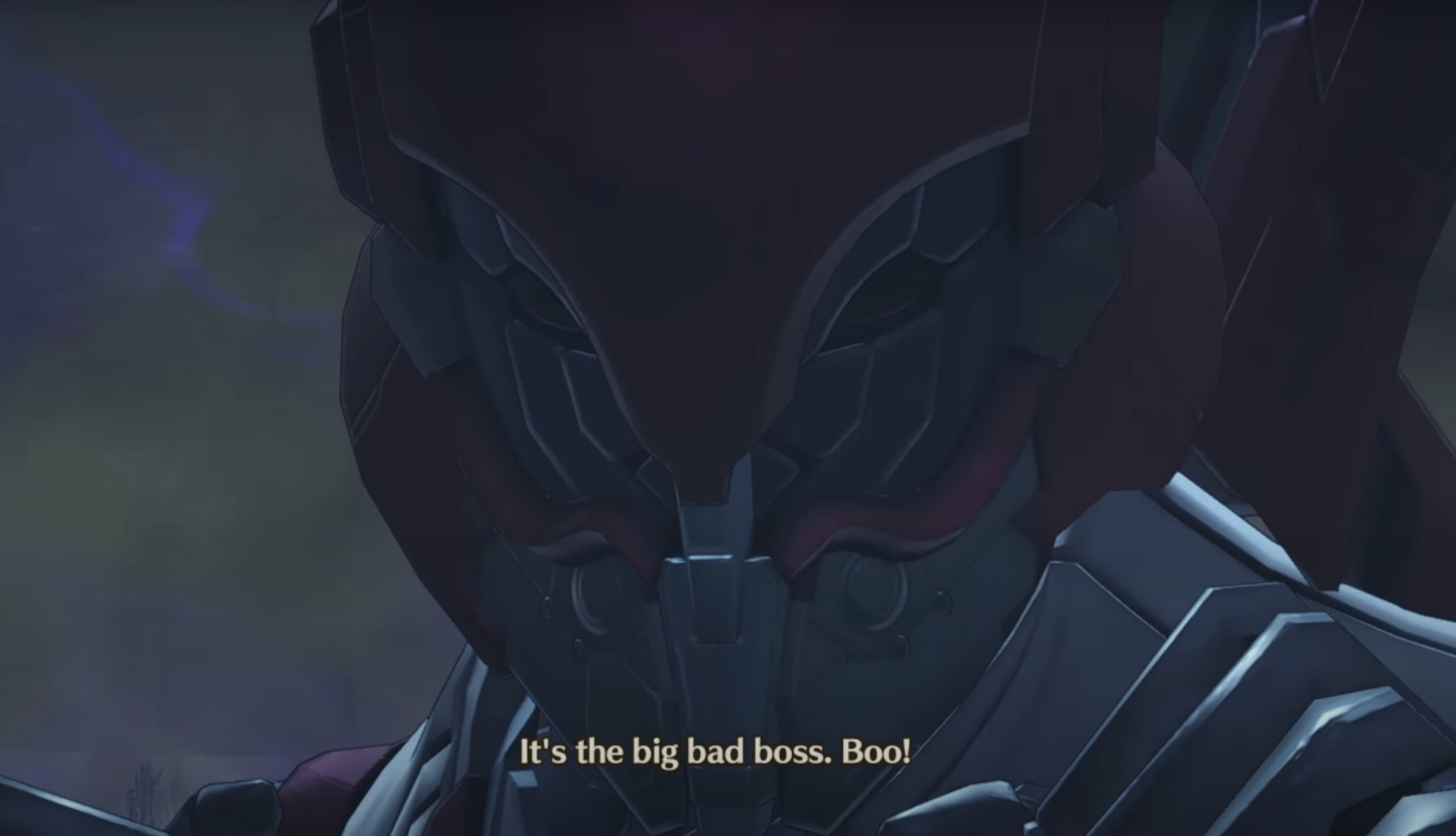
K, announcing himself before his boss fight outside of Colony 4.
Consuls like K, as far as Consuls go, are relatively innocuous: they echo the sentiments of J and N when they proclaim that they “just… [want] to play around,” enjoying and effecting amusement for Moebius.[122] Elsewhere, we see the horror of what it means to relish not just the theatricality of Moebius, but also the brutality and callousness that their Wittgenstein 1 worldview engenders. D’s story is haunting in this regard.
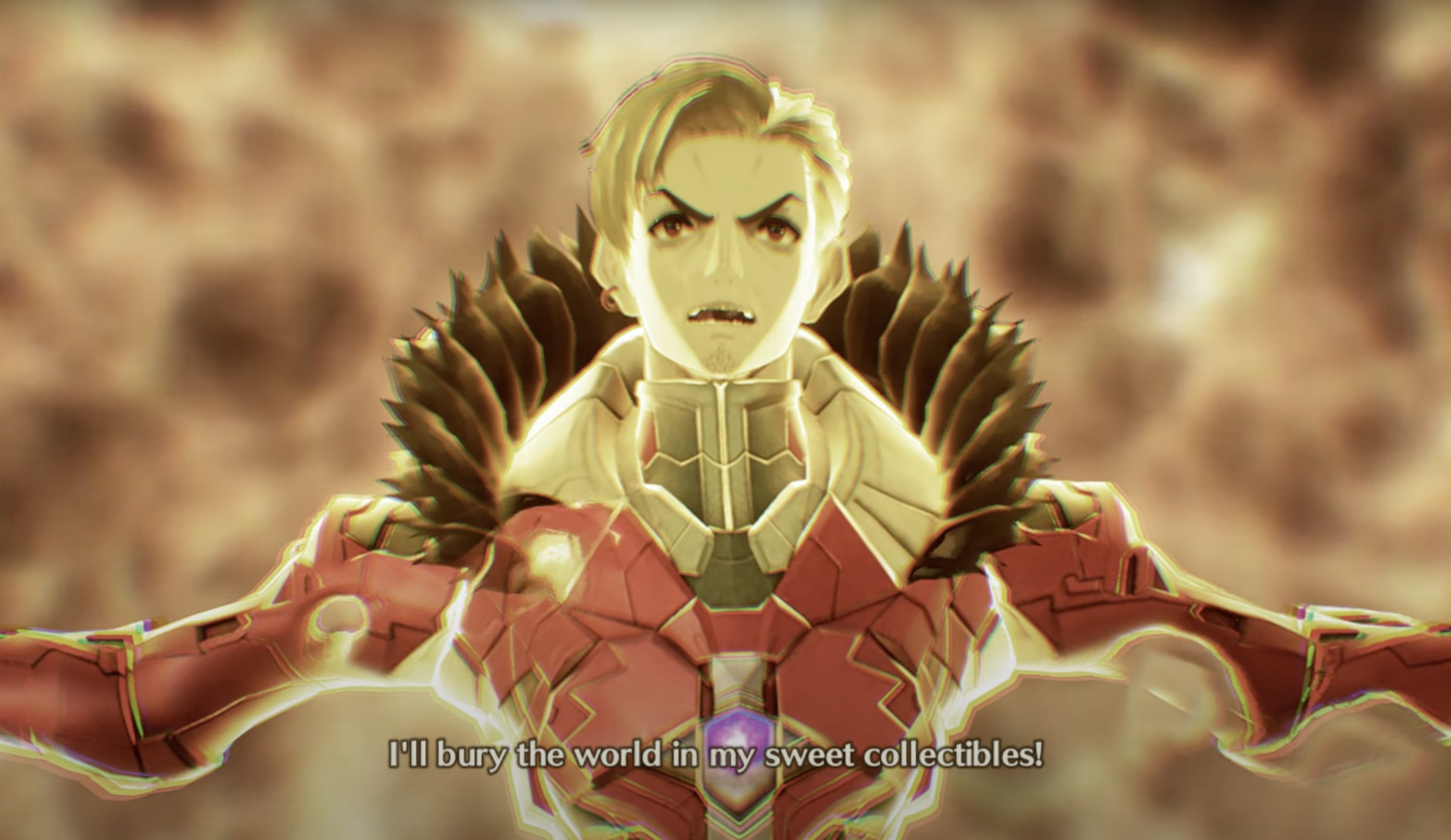
D declaring the sick value he’s claimed from the Moebius war game.
Consistent with the other Consuls we’ve considered, D had a talent that didn’t have a place within Moebius’ worldview. In life, he gained a reputation for decapitating his enemy with swords and collecting their heads, rather than killing them with his Blade.[123] War-apt though this penchant was, it diverged from Moebius both by not using their system of weaponry, meaning that the life from his victims was not transferred to the Flame Clock,[124] and, presumably, by preventing those he killed from being reborn back into Moebius’ cycle, since he retained custody of their heads. The chilling difference between D and our other portraits is that his talent doesn’t need much perversion in order to fit into the enforcement of Moebius’ worldview: he can ply his trade by simply brutally culling those who threaten divergence from Moebius, like Ouroboros, and his own “game” of racking up collectibles suddenly folds neatly into the One and Only Game of the Endless Now.
Across our study of Moebius and the Consuls, again and again we see the theme of existentially crippled individuals seeking some form of comfort and stability in their own lives, and settling for a facsimile of authority over others as an imperfect substitute. Consuls exert corruptions of their own natural talents on the world in order to turn their peers into puppets, whether through mud-sculpting, mind control, corrupted perception, or total paralysis; X and Y enforce a totalitarian regime upon Aionios despite themselves being under a regime of servitude to Z. Even Z, who acts very much like a player with the luxury of enjoying and controlling a world from outside of it, shows himself to be a facsimile of a player at the end of it all: he is a part of the world he observes, he can be met and physically confronted by those within it, and so he does undermine himself by the very motivation for his existence. Yet collectively, these facsimiles’ house of cards, distancing its crippled individuals from each other as it does, seems like an impregnable prison of semantics from which Aionios cannot escape.
The Tractatus has it that from the totality of elementary propositions—those that assert the existence of the atomic facts that make up the world—all other propositions, and thus the totality of sense in the language, can be derived.[125] Wittgenstein expresses this derivation through a symbol, ![]() ; as Russell says in his Introduction, the symbol represents “whatever can be obtained by taking any selection of atomic propositions, negating them all, then taking any selection of the set of propositions now obtained, together with any of the originals—and so on indefinitely”:
; as Russell says in his Introduction, the symbol represents “whatever can be obtained by taking any selection of atomic propositions, negating them all, then taking any selection of the set of propositions now obtained, together with any of the originals—and so on indefinitely”:
This is, [Wittgenstein] says, the general truth-function and also the general form of proposition. What is meant is somewhat less complicated than it sounds. The symbol is intended to describe a process by the help of which, given the atomic propositions, all others can be manufactured.[126]
On the other hand, no elementary proposition can be inferred from any other elementary proposition, because the world’s atomic facts are independent of each other.[127]
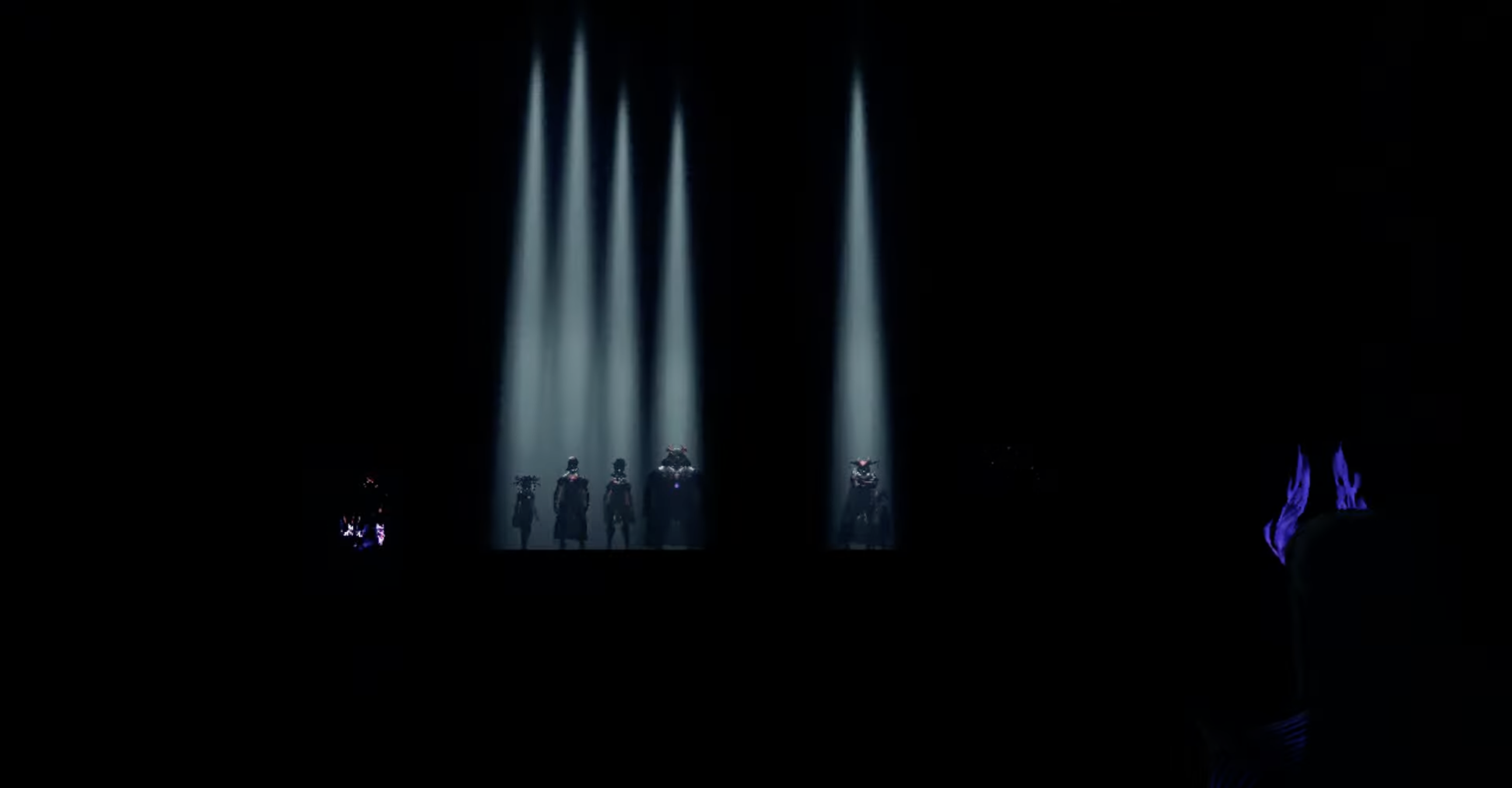
Consuls onstage at the Amphitheatre discussing strategy regarding how to confront Ouroboros. Notice that each is afforded their own spotlight, as Z looks on from the darkness of the audience.
The Consuls’ role in the house of cards is like that of the elementary propositions, which they may well represent as apparent variables: like the above image of Consuls bathed in distinct spotlights on the Amphitheatre’s stage suggests,[128] each Consul is treated as independent of the others, isolated in their own sentiments and interests even when this undermines their personal identities (as in the case of N and M). Yet collectively, they define the limits of all possible significance that can come from the events of Aionios: as the elementary propositions define all ways in which things could be and then give the natural sciences the job of finding out which of those ways actually are how the world is,[129] so the Consuls limit Aionios to their game in service of Z, leaving to Aionians the job of finding out who wins and loses various matches.
This focus on limiting the activity of significant utterances to verifying the truth or falsity of propositions shows itself in Moebius’ architects directly calling for the verification of certain propositions, as when Y introduces combat with Ouroboros as an opportunity to “verify the truth” of their claims that they will stop Moebius,[130] or when Z introduces his separation of the Kevesi and Agnian members of Ouroboros in the final battle by asking them to let him “assay” whether their bonds with each other are “true.”[131] It’s enough to make one feel, like Z, that even attempts by Ouroboros to overcome his world order are really just more assertions that can be verified or falsified within Z’s same semantics.
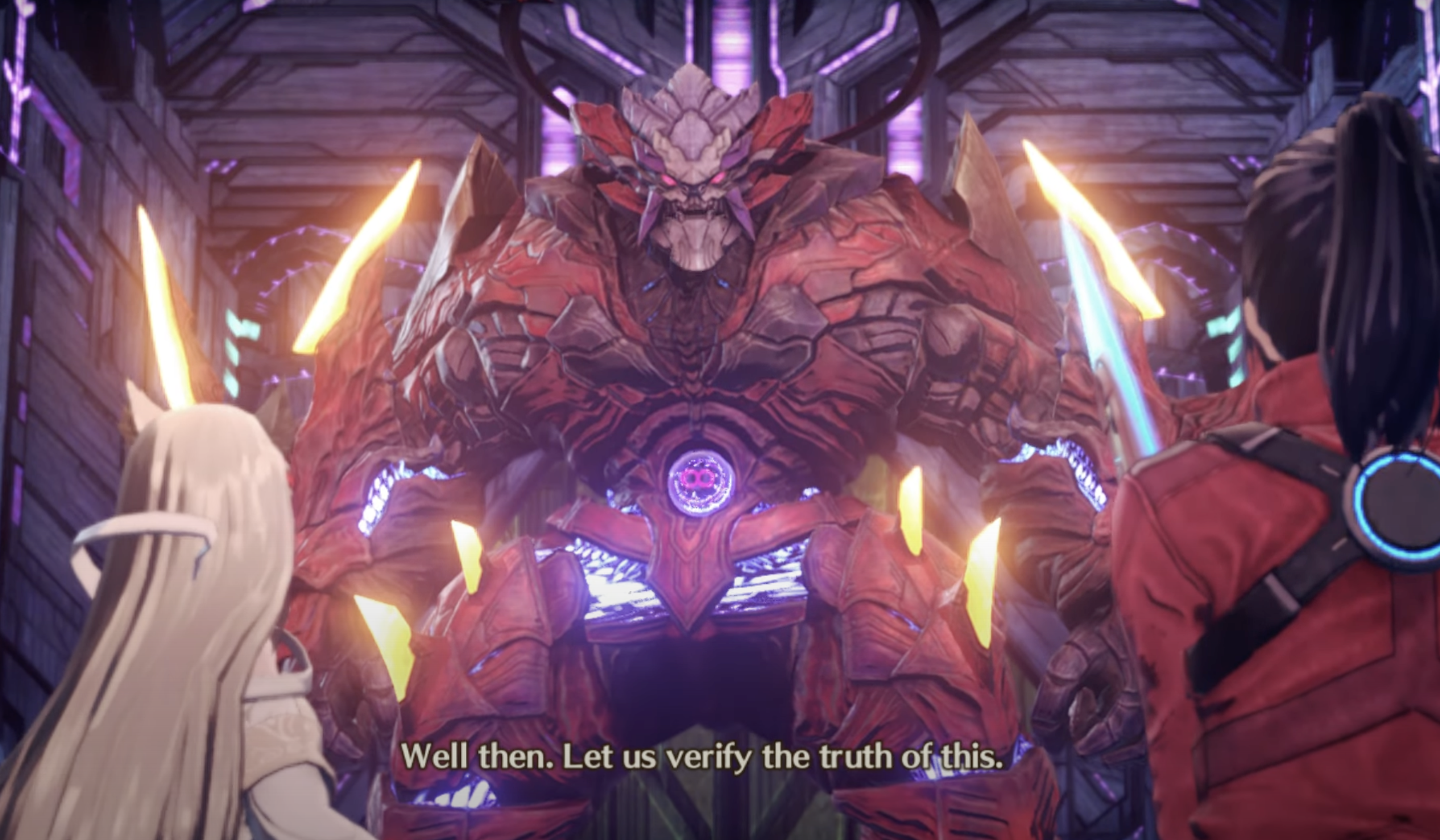
Moebius Y’s final call to battle before Ouroboros storms the Amphitheatre within Origin.
But, remember: Z’s Amphitheatre is a house of cards. Similar to N and M’s inability to be understood independently of each other despite the objectification and isolation of M from N, one of the challenges leveled against the Tractatus was the argument that its commitment to significant propositions asserting only possible, rather than necessary, states of affairs can’t account for phenomena that appear to stand in necessary relationships to each other, such as something’s being red necessitating its not being blue—or, indeed, such as N and M standing in a necessary relationship to one another.[132] Before the biographical Wittgenstein moved more radically beyond the Tractatus, he dealt with this objection in the 1929 “Some Remarks on Logical Form” by briefly abandoning the claim that atomic propositions are independent of each other—acknowledging an interdependence that Xenoblade Chronicles 3 personifies in the untenability of those people who are meant to enforce independent, atomic meaning in the world as Consuls, only to find themselves unable to fully isolate themselves from relationships (C2, C3, S7).[133]
§1.234: Quitting the Game: Triton and Crys
M and N aren’t the only Consuls who show this untenability: T and C add contour to these cracks in Moebius’ foundation by showing how its hegemonic structure can be simply forgotten or otherwise used in favor of those relationships it denies.
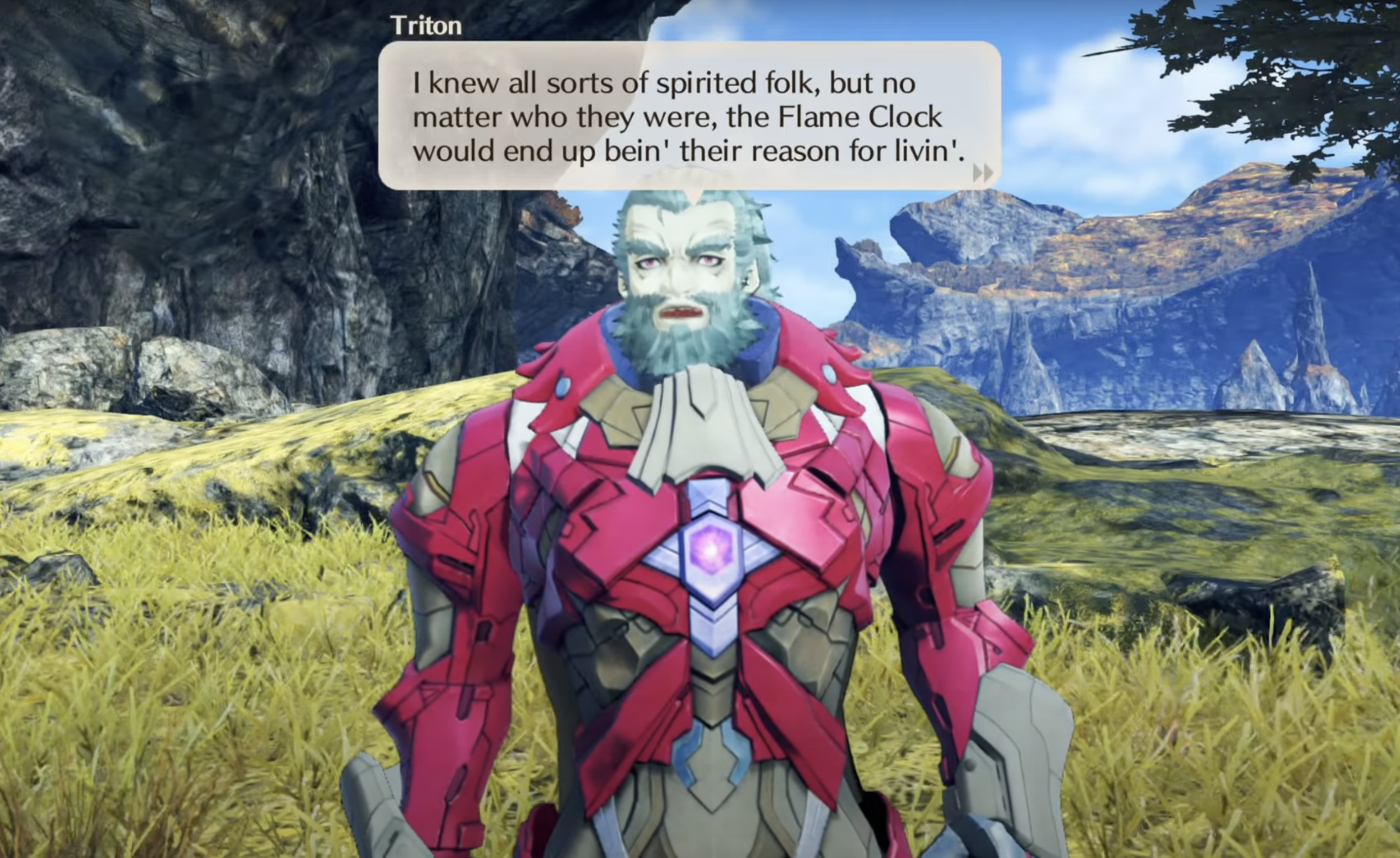
Triton reflecting on the value he found in Aionians during his time as Moebius, following Ouroboros destroying Colony 15’s Flame Clock on his behalf.
Unexpected Moebius defector Triton shows us what it looks like to simply outgrow the motives that push one to the Wittgenstein 1 worldview in the first place. He apparently joined Moebius out of a desire to fight “big beasties” forever, consistent with his ability to assimilate the powers of unique enemies.[134] Yet, over an immeasurable amount of time, he seems to have forgotten much of what drove him to Moebius in the first place: he forgot how to take on his Moebius form,[135] he can’t well recall distant memories of his past friends,[136] and he has clearly forgotten whatever led him to believe that the subjugation of Aionians under Moebius’ game was warranted.
For Triton, forgetting the basis for Moebius’ amusement comes hand-in-hand with recognizing the broader kinds of “fun” that the people of Aionios seek out, only to be thwarted by the Flame Clocks and Moebius’ system of meaning.[137] When his personal impulse to Wittgenstein 1 fades, the relationships it denies in favor of stratified control become vivid: he is able to recognize his Colony members as his equals, separated only by the system he once enforced for reasons that no longer matter. At that point, it’s obvious why he would join Ouroboros to satisfy his talent for monster hunting, rather than using that talent to subdue and constrain.

Crys’ demand of Noah at the beginning of their confrontation in Keves Castle.
Crys takes this favoring of relationships a step further, pointing the way to Moebius’ self-undermining nature. His special talent seems to be not a specific relationship but rather the expression of oneself in relation to others. In life, he thrived not only as an off-seer but also as a teacher and mentor, taking Noah under his wing. He chose to be an off-seer to understand the connections between those who die and those who remember them; he plays melodies, and cherishes the melodies of others, as a means of sharing and understanding the human feelings that persist, through relationships, after death.[138] While off-seeing technically does exist within Moebius’ paradigm, it seems to function primarily as a peripheral method of controlling soldiers by managing their emotions:[139] Crys’ talent for genuine communication and cultivation of feelings doesn’t have a place in the solipsism of Wittgenstein 1’s semantics.
Crys’ resolution of this tension is unnervingly different than others’ ascension to Moebius. Rather than perverting a specific relationship in a way that captures and objectifies the other, as N did with M, he transmutes his mentorship with Noah by becoming Moebius without dragging Noah with him. In so doing, he gives their relationship a new form that renders it logical within Moebius’ system while still honoring that relationship and threatening to undermine that system.
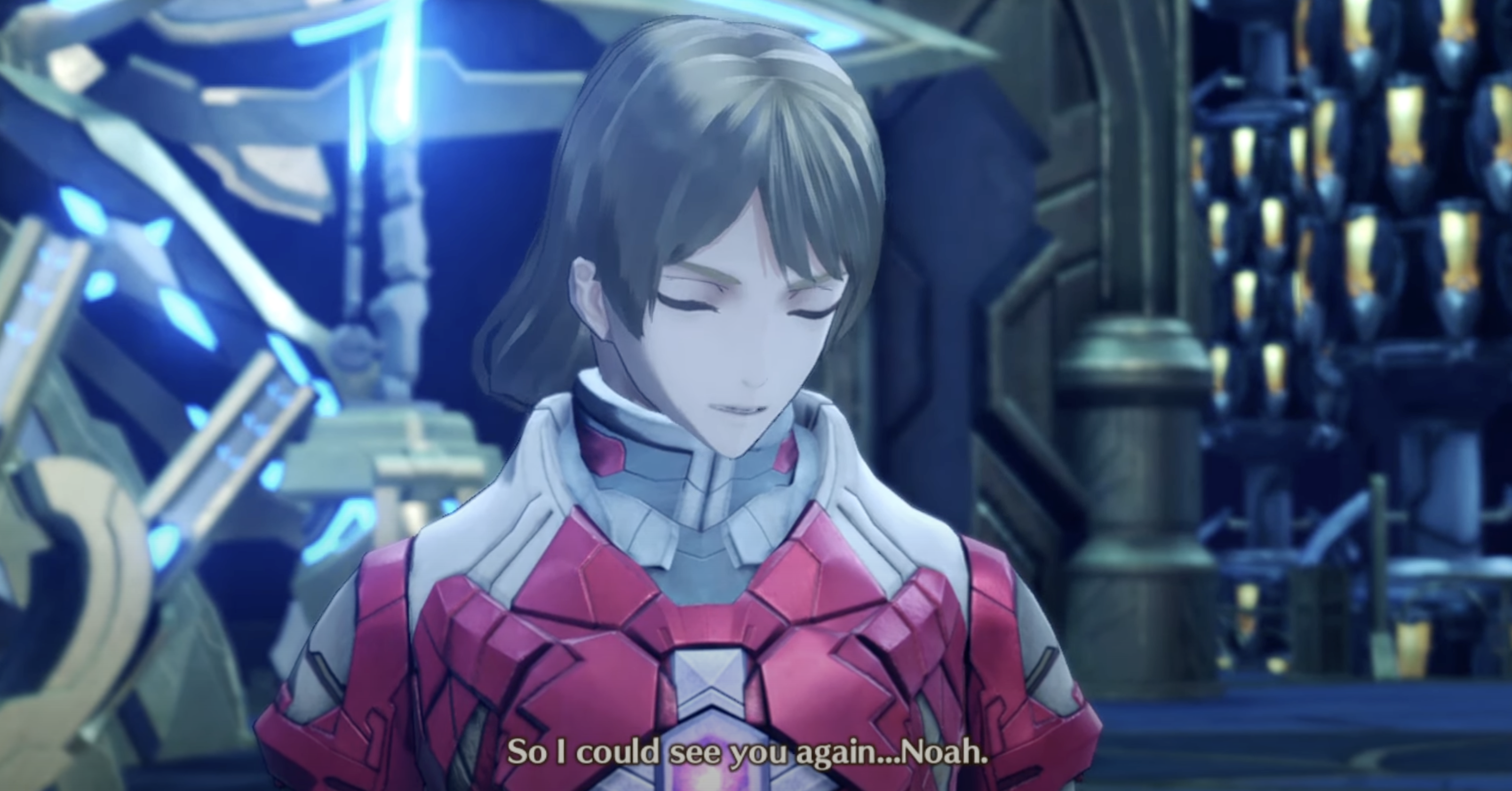
Crys explaining to Noah why he became a Consul.
Crys tells Noah that he became Moebius, Ouroboros’ enemy, to see Noah again and hear his melody.[140] His challenge to Noah is that the “melody” that Noah is expressing through Ouroboros, insofar as it is grounded in Noah’s feelings and brought about by conquering the existing world order, runs the risk of imposing upon the world a system just as oppressive as Wittgenstein 1: one that prioritizes a single way of understanding things that is enacted through the control made possible by strength.[141]
This kind of challenge is only possible because of what Crys is and what Moebius is: we’ve seen that Moebius’ order, like Crys’ conception of melodies, is born from particular feelings, namely those of controlling love, mitigating despair, and otherwise alleviating one’s inner strains (S7, S6, C2). In the same way that Noah and Crys shared their own melodies in life, therefore, becoming a Consul, given his talent, affords Crys unique standing to share the “melody of Moebius” with Noah and challenge Noah, as he did in life, to craft a melody that is distinct from it.[142] Crys’ transformation into the oppressor, Noah’s enemy, allows Noah to overcome the fundamental method behind Moebius’ worldview by overcoming, and seeing off, his mentor.
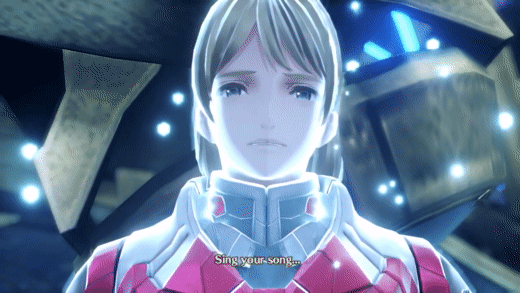
Crys expresses his last wish for Noah to him, as Noah sees Crys off.
Collectively, then, the Consuls represent an alphabet of Aionians trapped by the pain of a world with no space for them, driven to forms that beget that same system of suffering, in the futile hope of escaping that pain. As X’s Colony Rank system motivates the Colonies, this vicious cycle of self-directed pain motivates these Aionians to become and fulfill the duties of Consuls—a motivation that Moebius needs in order to ensure the stability of facts and semantics within the world which they are desperate to enjoy as external spectators (C2, C3).
At bottom, however, these victims who are bullied into embodying solipsism remain humans bound to one another in ways that Wittgenstein 1 cannot account for, which augurs an end to the Endless Now.
§1.24: A Visual Field Without Limit: The Endless Now
The despairing, sadistic, imprisoned legion of Moebius exists in service and pursuit of the Endless Now. Like the Möbius strip that serves as Moebius’ icon, this state imposed upon Aionios is a paradox; now that we have in view the self-undermining nature of the characters and philosophy that motivate this state, we’re in a position to see the thematic, human content of that paradox.[143]

Moebius’ representative icon, a rendition of the Möbius strip.
Nia refers to the Endless Now as the process of keeping everything in “stasis” and “creat[ing] an eternity to abide within”;[144] much to Lanz’s confusion, Z calls it a “march of time, stilled for eternity.”[145] It’s intimately related to what he calls “the flow,” the domain within which the Endless Now has total influence and outside of which objects, such as the Sword of the End, can interact with the Endless Now.[146] In Z’s disquisition to Ouroboros on the world and human nature, he conceptually links the notion of a flow with that of human desire, which connects the inner pain that motivated Wittgenstein 1 to the particular state imposed on the world:
Human desires can be… much likened to a river flowing. All humanity yearns for it… The endless now.[147]
We saw that Z is the personification of the desire to control the factors of the world and people to which one relates in order to feel a sense of safety and stability. If we infer that this desire is also the particular “flow” which he calls “the flow,” then the state which Z seeks to maintain within the world—the Endless Now—is not some separate world order that Moebius imposes as a means to its desired ends, but rather an organizational manifestation of Moebius itself. This gives sense to what Mio means when she speculates that “Everything here could be Moebius” upon entering Origin: as Z dictates Origin’s structure and Origin dictates Aionios’ structure, Moebius’ act of setting the Endless Now as that structure is purely an extension of Moebius’ essence to the world as a whole.[148]
This distinction between the Endless Now as a means to Moebius’ ends and the Endless Now as an extension of Moebius’ essence might seem like idle semantics, but in the context of Wittgenstein 1 and Xenoblade Chronicles 3, it’s crucial in providing the basis for extending the emotional solipsism suffered by the individual to the philosophical solipsism foisted upon society. In the final motions of the Tractatus, Wittgenstein offers the proposition that serves as this Part’s epigraph, Proposition 6.4311:
Death is not an event of life. Death is not lived through.
If by eternity is understood not endless temporal duration but timelessness, then he lives eternally who lives in the present.
Our life is endless in the way that our visual field is without limit.
As with the eye’s relationship to its visual field, the Tractatus says, we cannot experience the cessation of our world—our experiences, the sense in which “the world is my world”[149]—as something within that world; no more can we lean upon the future as a pillar of support within that world, for the only kind of necessity is logical necessity, and our picture of the present entails nothing about our picture of the future.[150] In this solipsistic sense, we live in the present, and only in the present.
In the symbolic context of Wittgenstein 1, Proposition 6.4311 could be read with either comfort or despair: how claustrophobic, how suffocating to see the world, my world, as limited to this singular moment, with no promises for the next except the promise of how we will logically picture it; yet, how safe I would feel if only I could press my face up against this world from the outside, enjoying the certainty of the world in the present moment rather than revealing myself in the world, at the mercy of that moment.[151] This is the difference between seeing the world as “timeless” with crippling uncertainty about one’s future and seeing the world as “timeless” with quiet contentment at an eternal moment. In the Tractatus, the latter is the feeling of the mystical[152]—but if only we could say and think something meaningful about it, rather than falling into the realm of nonsense whenever we try to conceptualize it (which Wittgenstein recognized in his own efforts to describe the world as a whole[153]).
The reason that the Endless Now seems like a paradox is that, as Wittgenstein said of God and punishment in the concept of election by grace, “[t]he two halves belong to different kinds of perspective.”[154] When Z refers to the “march of time,” he is referring to the Endless Now from the perspective of those within Aionios: those who are forced by Moebius’ world order to march through endless instances of the present, ceaseless iterations of which they’re not conscious—the in-world perspective that begets despair. When he refers to time as “stilled for eternity,” he is referring to the Endless Now from his own perspective in the Amphitheatre: those who have created a distance and stratification of understanding that allow them to gaze upon the world, suspended within its timeless present, sub specie aeternitatis in a syntactically meaningful way—the out-of-world perspective that begets comfort.
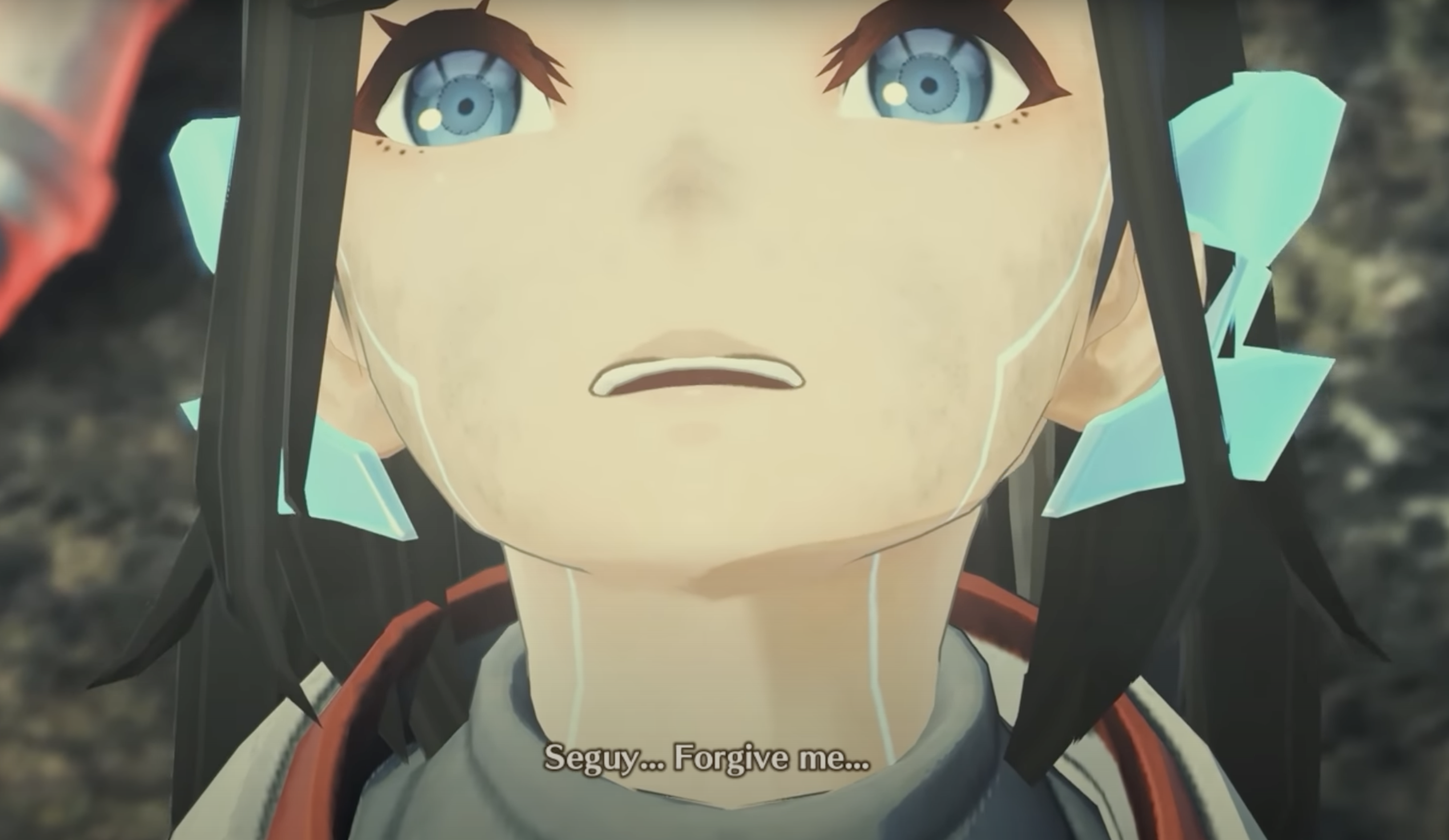
An Aionian soldier, victimized as a pawn in R and V’s skirmish.
Lanz’s response to Z, then, is precise: he’s “not making any sense”[155] because the value of the Endless Now, by its very same basis in Wittgenstein 1, can’t have sense to those within Aionios, trapped, as in the case of the dying Agnian soldier above, in a helpless procession of present moments.[156] It can only even seem comforting to those who take themselves to have moved beyond it, though as we’ve seen in the case of the Consuls—exemplified in their movement between the Amphitheatre game and the Aionian battlefields—one can’t coherently step away from the world sufficiently to feel the contentment Moebius seeks.[157]
The tension, as we’ll understand further in Part 2, is already obvious from the basic activity of Moebius: over and over, they wage war, playing different matches of their chosen game—yet because it is a single game, they take it as one match, one moment, and one system of meaning that exhausts the world’s potential for any meaning.
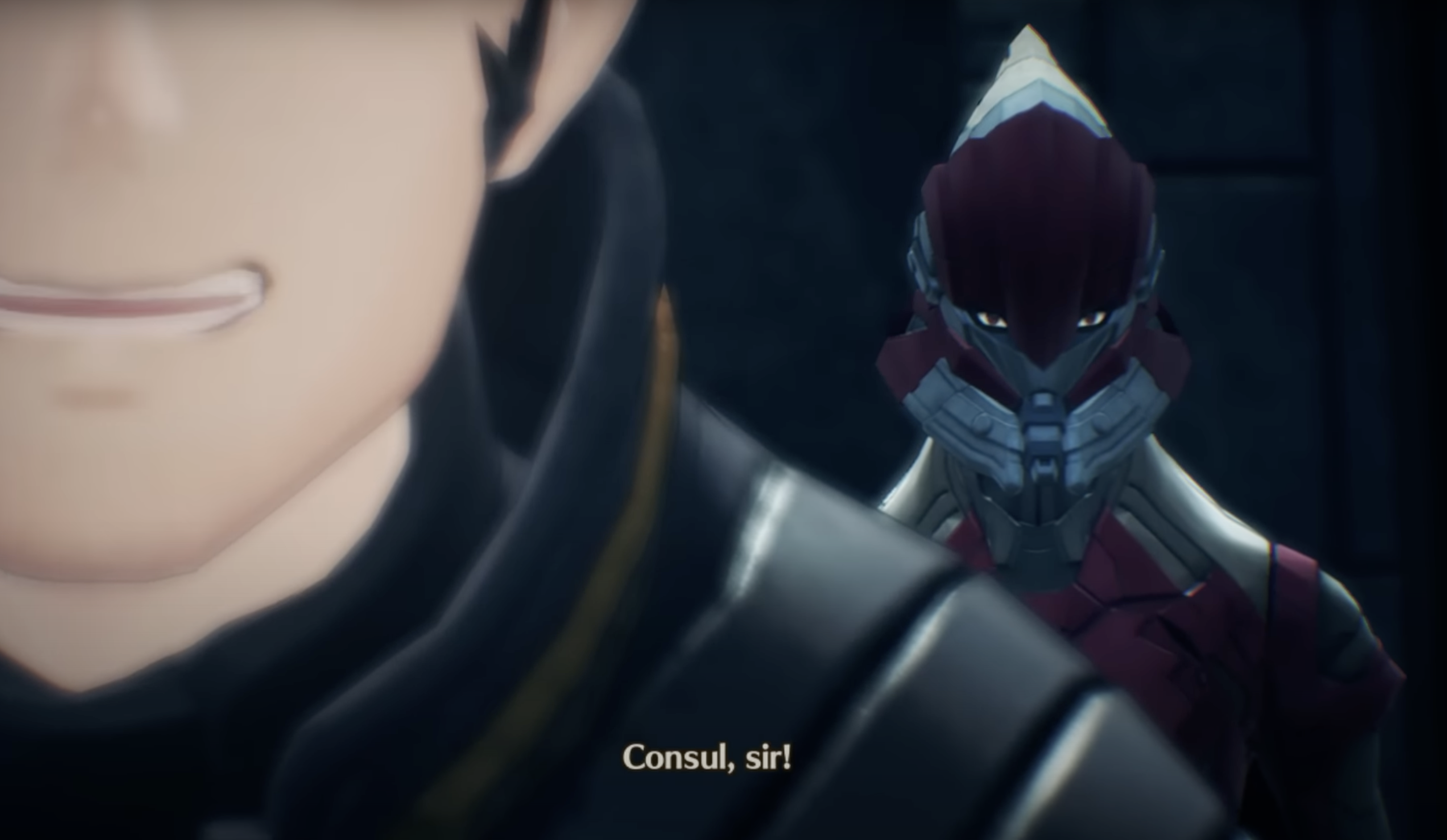
Consul E, joining aboard the Ferronis to watch a Colony get massacred by Cammuravi.
Moebius, then, extends its emotional solipsism—that despair and desperation for controlled, distanced stability—across the world through the Endless Now, an apparatus that is senseless and paradoxical to those within the world, even if they can relate to the underlying emotional impulse motivating it. In Z’s final Moebius form—a form in which, during battle, he makes it the case that Ouroboros literally cannot position themselves behind him, trapping them within his visual field—he frantically asserts that we cannot depend on our capacity to determine our future, nor on the presence of others to soothe us, concluding: “The self is all that exists!”[158] Our foregoing study of the Endless Now is the explanation for this sudden, urgent declaration of solipsism, the very utterance that the Tractatus claims captures a deep truth yet cannot be uttered.[159]
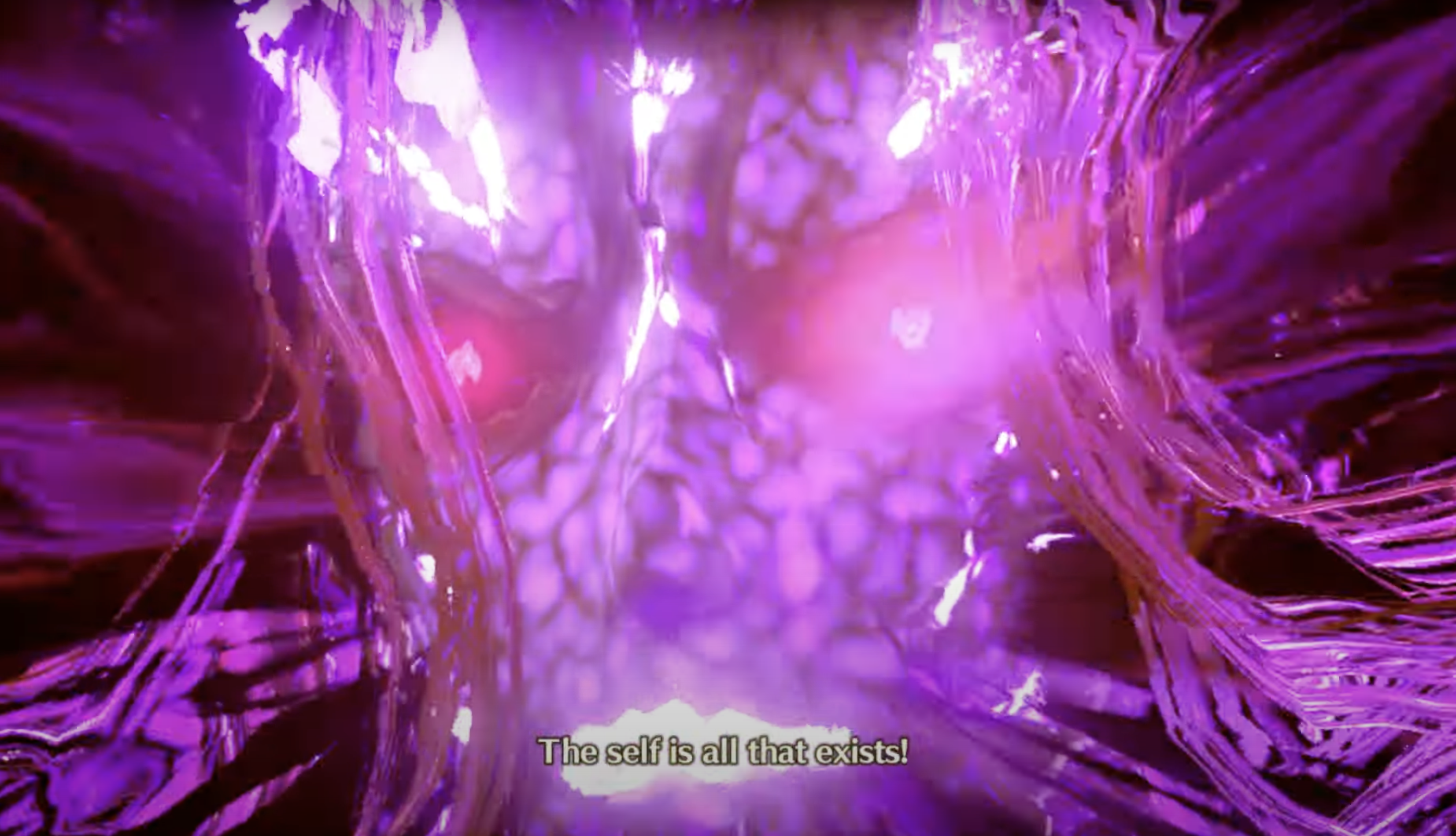
Z’s bald-faced declaration of solipsism following his final defeat.
You might imagine that Aionians would routinely recognize and challenge such senseless solipsism, but the in-world implementation of the Endless Now is delicately engineered from the ground up to ensure that they cannot come to Lanz’s conclusion of senselessness without the help of Ouroboros. When I say “from the ground up,” I mean that the Endless Now manifests within Aionios through mechanical and organizational influences that work from the individual level out to the societal and global levels, influencing, progressively: perception, interpretation, personal narrative, societal role, societal leadership, environment, culture, and fundamental physics.
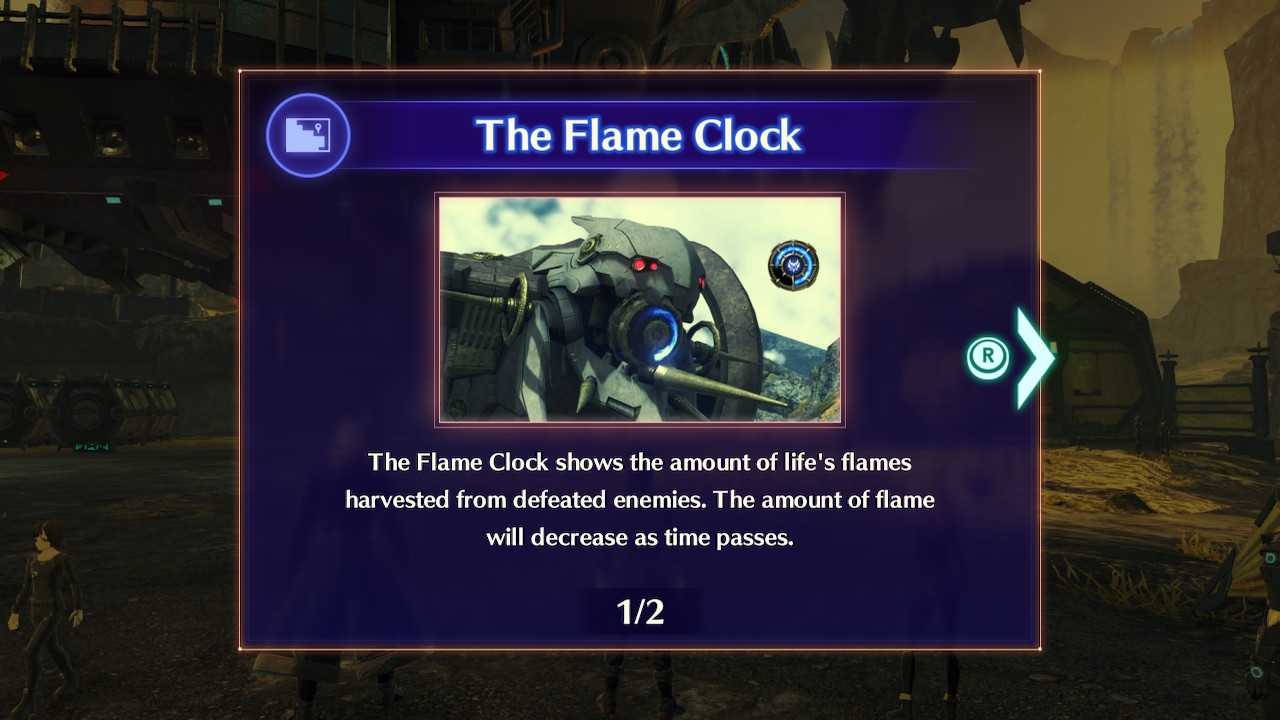
The introduction of the Flame Clock as a seeming central game mechanic at the start of the game.
The sensation of Colony members is colored (pun intended) by their Irises. The Flame Clocks of their respective Colonies present themselves within their visual fields, constantly reminding them of the singular metric according to which they can accomplish anything meaningful in the war game, and thus in the Endless Now.[160] When factors that step beyond the flow, like Ouroboros, threaten Moebius, Consuls can use the Iris to altogether alter how Colony members perceive others, as when Consul K leads Ethel to see faceless shadow enemies rather than Ouroboros.[161] If the world is my world and the picture is my visual field (S1, S2, C3), then there are few better ways to shape my sense of what meaning I can make within the world than altering the basic attributes of my visual field. If you want to capture that prison of motivation within a video game, I can imagine few better ways than introducing the player to the Flame Clock as a key mechanic in the first moments of the game (shown above), only to discard the entire system a short time later when the party becomes Ouroboros (not the first time, nor the last, that the Xenoblade Chronicles series has used a tutorial system to explore rich, new storytelling possibilities[162]).[163]
So total and suffocating is Moebius’ hold on Colony members’ sensations that the approach of Homecoming and the end of those members’ enforced lifespans appears to come with a loss of at least some sensation, as we see in Mio’s case as she nears the end of her allotted time.[164] Death is not an event of life for those in the colonies, but it is a key aspect of maintaining the present for those in Moebius, and the timed, gradual termination of those experiences that are events of life is a cruelly poetic way of demonstrating that.
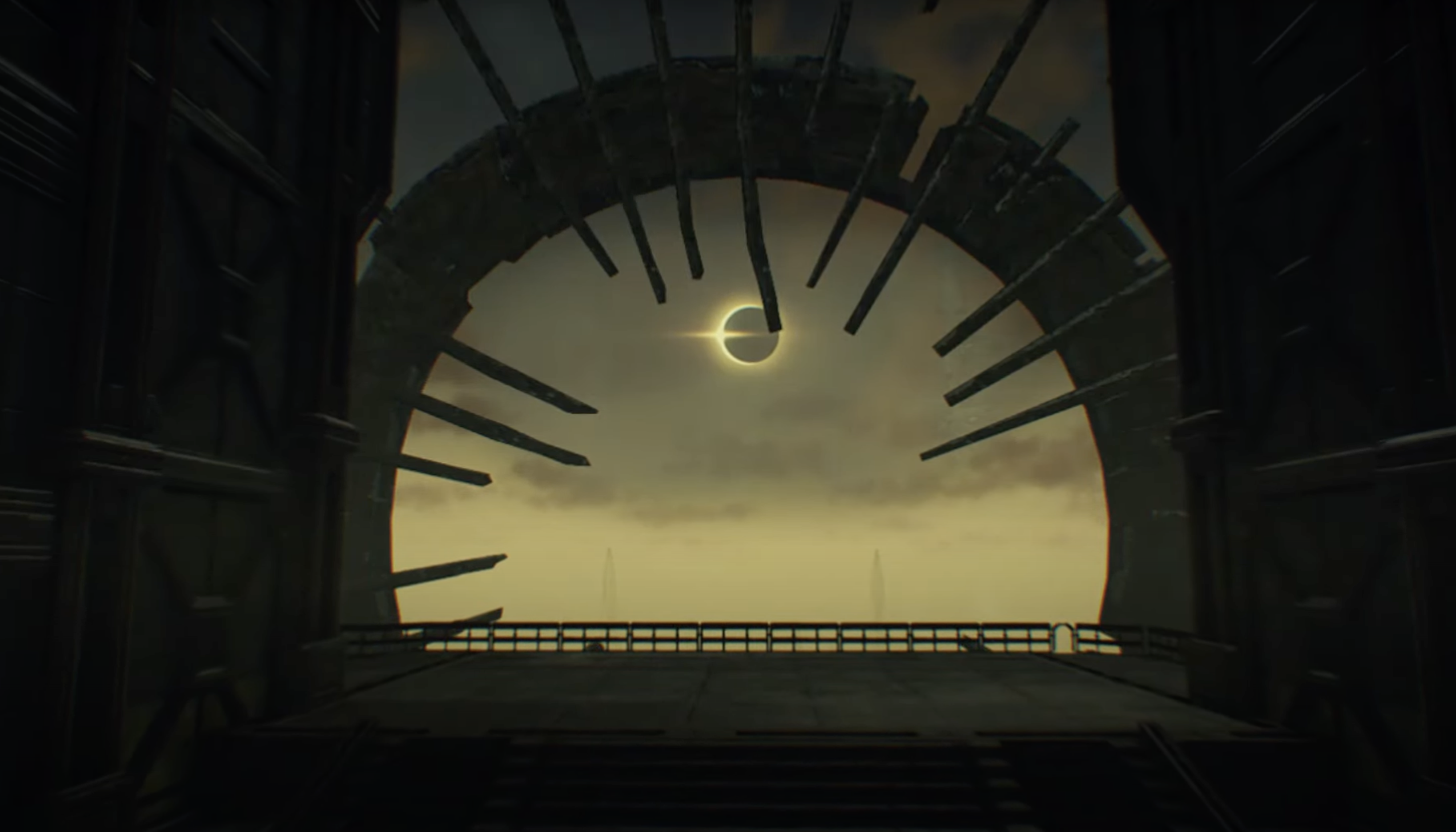
The view of the eclipse as seen from the City.
Beyond the input of our sensory experiences is our interpretation of those experiences, and Moebius routinely seizes the means of interpretation for objects that could potentially lead those in the Colonies to think otherwise.
Even outside of Xenoblade Chronicles 3, the moon is a compelling symbol for the concept of interpretation: we only see it because it reflects something beyond itself (the sun), and it’s this reflection to which we relate. This reflection becomes a fixture of our lives, something according to which we measure and understand the progression of cycles across time—an element of the moon’s symbology that’s especially pertinent in a world where most lives are governed by a special kind of clock. Noah explicitly recognizes the interpretive value of the moon after he’s been empowered to think outside of Moebius, as Ouroboros does;[165] it’s perfectly totalitarian, then, that Moebius co-opts the symbology of the moon by performing a ritualized execution of prisoners from the City—a place of new lives, born beyond Origin and outside of Moebius’ domain—on the day of a solar eclipse, when the moon blots out the sun, the very object whose light renders the moon apt for interpretation in the first place.
Ouroboros itself, the greatest threat to the Endless Now, is a similarly apt target for Moebius’ interpretive manipulation: perhaps the most grotesque moment of the game, in my mind, is when Consuls O and P Interlink following their de facto execution of Ethel and Cammuravi, declaring to Ouroboros that their hideous union is “the true form of Interlinking […] The form in which two worlds become one. A far more refined form than this… half-assed one you’ve stumbled upon.”[166] At this point in the story, when Ouroboros has already bonded and begun to understand forms of meaning beyond Moebius’ semantics, the declaration has no teeth—powerfully driven home by Mio’s prompt physical and verbal thrashing of O and P—yet this interpretation of Interlinking perfectly articulates Moebius’ hegemonic view of their singular, reductive mode of meaning in the world as the one true logical form of language and thought. Their Interlink is an act of insistence on the one and only side, like a Möbius strip, in a world that is two sides, with a diversity of meanings far greater than two.
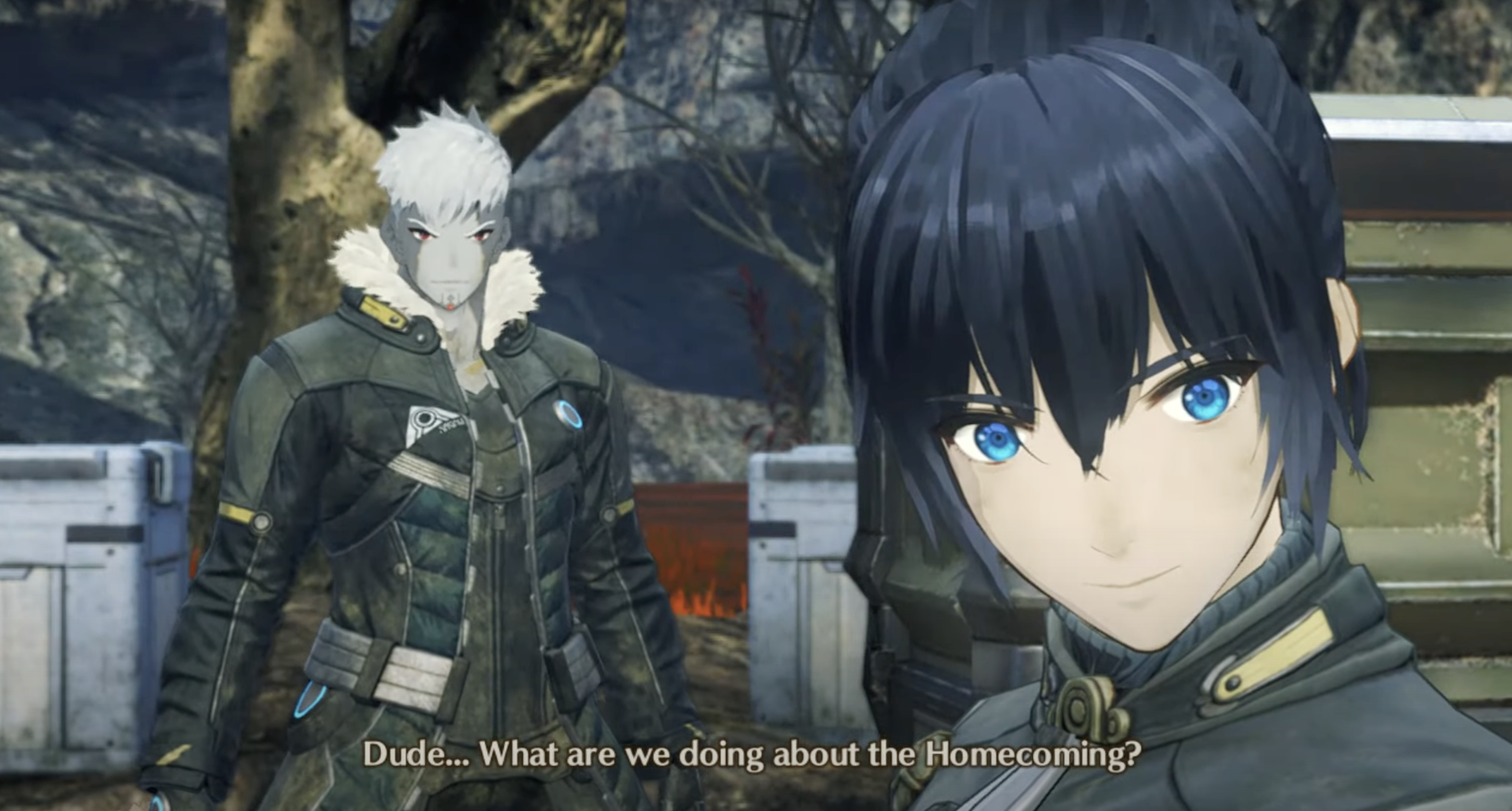
Lanz’s difficulty catching up to the consequences of the party becoming Ouroboros.
From Moebius’ machinery for managing their pawns’ war games and the influence with which they color sensation and interpretation, it’s no great leap for the Endless Now to dictate the shape of individuals’ personal narratives: their interpretations of their lives as a whole. As those from the City routinely lament, those in the Colonies are limited to ten-year lifespans, bounded on one end by Cradles that spawn and allocate them based on Colony (read: Consul) needs, and on the other end by a Homecoming ceremony that identifies the goal of their lives with surviving and killing sufficiently to earn a return to the “leader” who dictates the war (the Queen simulacra). With these game-based limits on an existence which Aionians see and feel only in relation to that game, Homecoming becomes so exalted as life’s “proper” ending that Lanz comically asks whether he, Noah, and Eunie should still attend Homecoming after they are transformed into Ouroboros and freed from the Flame Clocks (above).[167] Mio, too, later evinces how totally the meaning of an individual’s life depends on the tattoo-like brand that marks the time remaining for those bound by the Endless Now: even after she’s become Ouroboros, her agony in the time before the eclipse centers on her prescribed time running out, together with her sense that she’s living on time borrowed from Miyabi’s remaining time—both of which derive from the immutable parameters Moebius has put upon its pawns.[168]
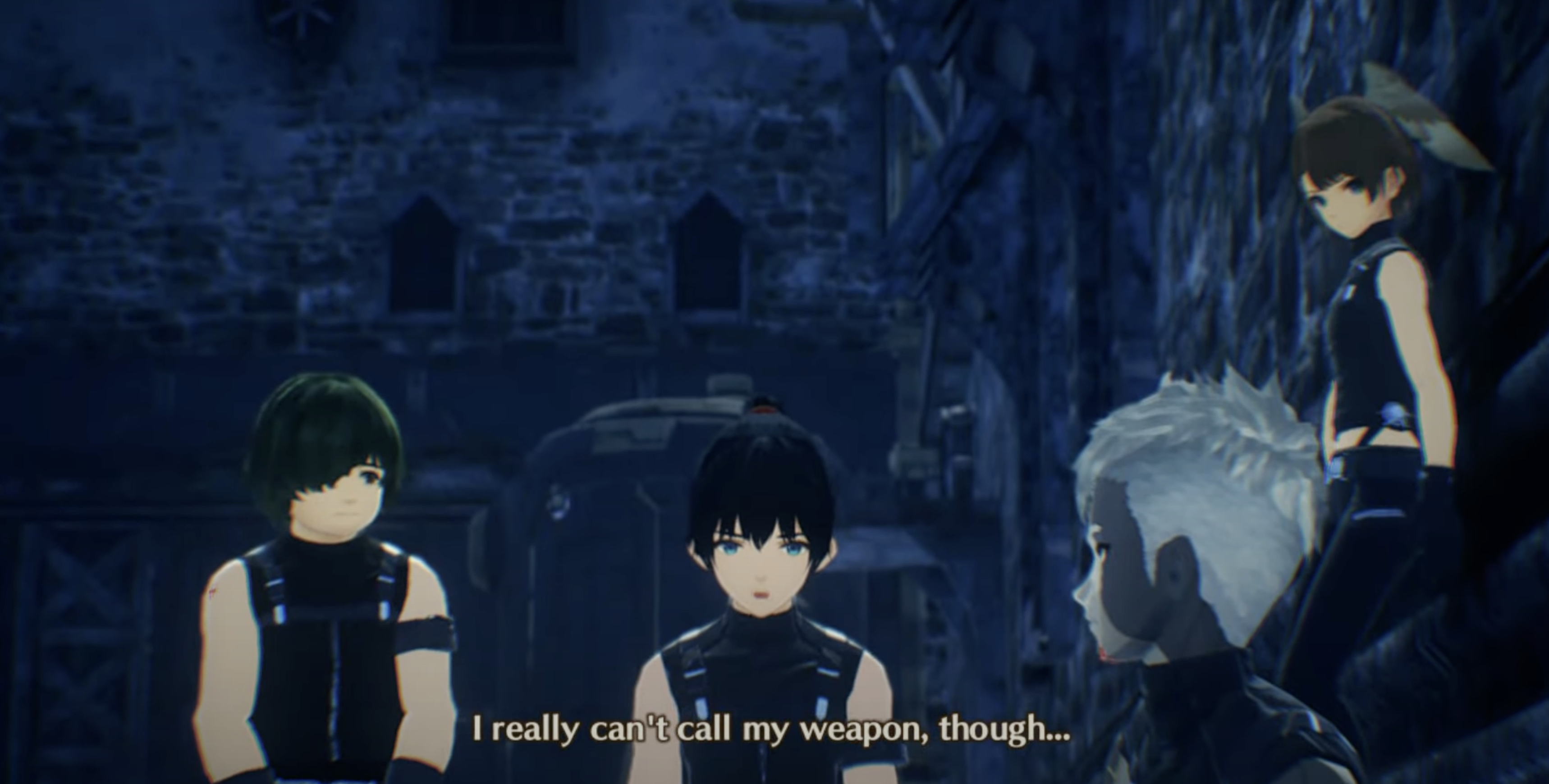
Young Noah reflects on his difficulties in using a Blade.
The roles individuals have in their society, a basic avenue for determining how to relate to others, are instead determined by Blades, the Moebius-approved weapons that convert deaths into Flame-Clock fuel. A Colony member’s Blade—one weapon, bound to that person for life—fixes their Class, settling the matter of how they will contribute to their troop; since war is the one game permissible in Aionios, this settles the matter of how they will relate to others (think of Joran as the Healer, conceiving of himself as useless because his job is to support his team and he isn’t sufficiently adept at combat to reliably do so[169]). We see the extent to which this one tool becomes each person’s entire toolkit, as evidenced by how crippling it is to be without it: Noah’s perceived inability to use his Blade in his youth was a subject of social ridicule and shame regardless of his evident skill with a training sword,[170] and, even after becoming Ouroboros, the party finds itself utterly neutered when X channels Z’s power to seal their Blades, during the events outside Li Garte Prison Camp.[171]
Even the role of off-seeing—in which Noah, Mio, and so many others in the game ultimately discover such rich meaning—seems in the first place to be a chilling case of Moebius fixing a role and interpretation. Off-seeing is a role that provides a sense of comfort and closure to the constant death that goes hand-in-hand with interpersonal relationships defined solely by war—in Y’s words, a way of “propping up” combat units by giving them a sense of “peace” according to which they can better endure and focus on their constant task of killing.[172] As Taion speculates, it’s interpretive roles such as this that help in the world’s “upkeep” by conveying “a sense of security”—quietly discouraging Aionians from arriving at the discontentment that could lead them to question the Endless Now.[173] It’s enough to put one in mind of Wittgenstein clutching the talisman of Gospels in Brief throughout the hell of World War 1.
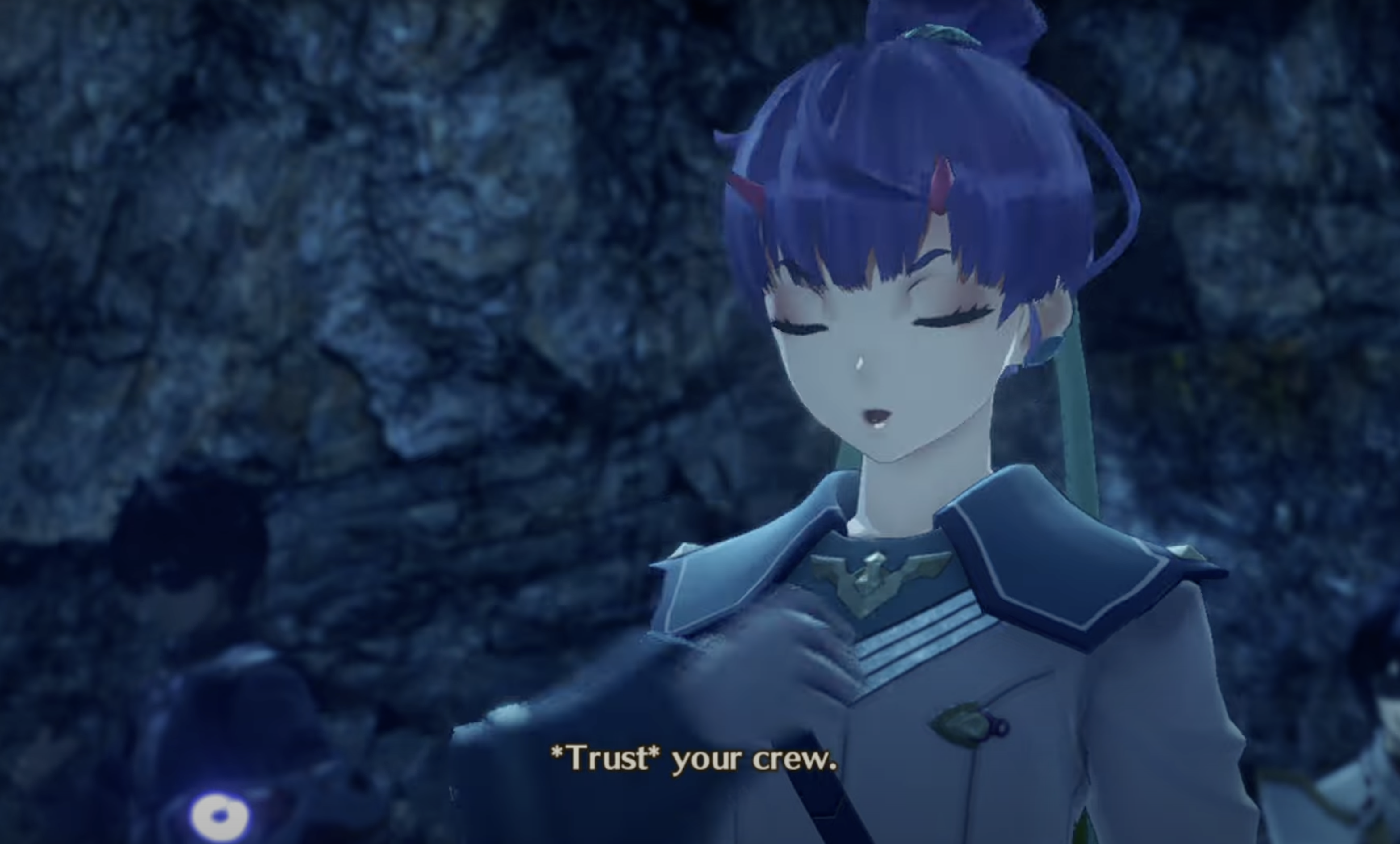
Fiona invoking the Colony Mu motto.
Interpretive constraints placed upon the individual go a long way toward indoctrinating Colony members as pawns rather than people, but if you’re really intent on playing human chess ad infinitum, you’d better ensure that the leadership of your sets of pieces is properly motivated to maintain cohesion among those pieces. Moebius effects this through Colony Commanders: those Aionians promoted and motivated from within Colonies to manage the humanity of their charges, so that Consuls may instead focus on merely relishing the game and manipulating those Commanders as necessary for the game.
The methods of manipulation vary based on Consul, Commander, and Colony identity, but the case of Consul I (Irma), Fiona, and Colony Mu illustrates how even the most seemingly positive of Colonies are totalitarian behind the scenes: where Mu’s identity centers on mutual trust and the unity of hearts, the impetus of that identity was its Consuls’ belief that “When someone close to you gets hurt, you want to become stronger for them. That desire and sadness, they make for a quality flame.”[174] Like I’s disguise as Irma within the ranks of Colony Mu, both the literal Flame Clock and the genesis of Mu’s culture are hidden behind an illusion of trust that’s useful for Moebius. (However, just as we saw in C, M, N, and T’s relationships, I’s bonds with the Colony can’t be fully erased, instead neatly tucked away in a locked box, evidence of the illusion Irma put upon herself by becoming Moebius.[175])
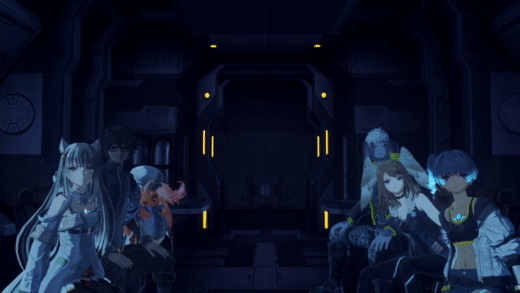
Ouroboros encountering Origin, the source of Ferronises.
This insidious social engineering plays out in an environment no less thoughtfully architected for fostering dependence on the Endless Now. Ferronises, the mobile homes of Colonies, house the Colony Flame Clocks, literally fueling a society according to the lives claimed by the inhabitants in war games. With these Flame Clocks comes connectivity to the Keves and Agnian Castles—and, crucially, their supply lines, with ration quality carefully engineered to modulate with Colony Rank, yet another motivational carrot to dangle.[176]
Once Ouroboros frees Colonies from their Flame Clock, we see how helpless Aionians are to live on their own, and thus how their environments ensure that they are not so “free” yet after all. Colony 9’s food shortage following the destruction of their Flame Clock is only solved through tedious trial-and-error from a scrap of farming information in Moebius’ own textbooks, together with help from Colony Tau, a formerly enemy Colony with which it was be impossible to collaborate before the intervention of Ouroboros.[177] It’s easy to relate to Kite’s dismay that the Colony’s “liberation” only foists upon them an immediate need to master their environment, when all their existing survival skills were developed only in service of Moebius’ war game.[178]
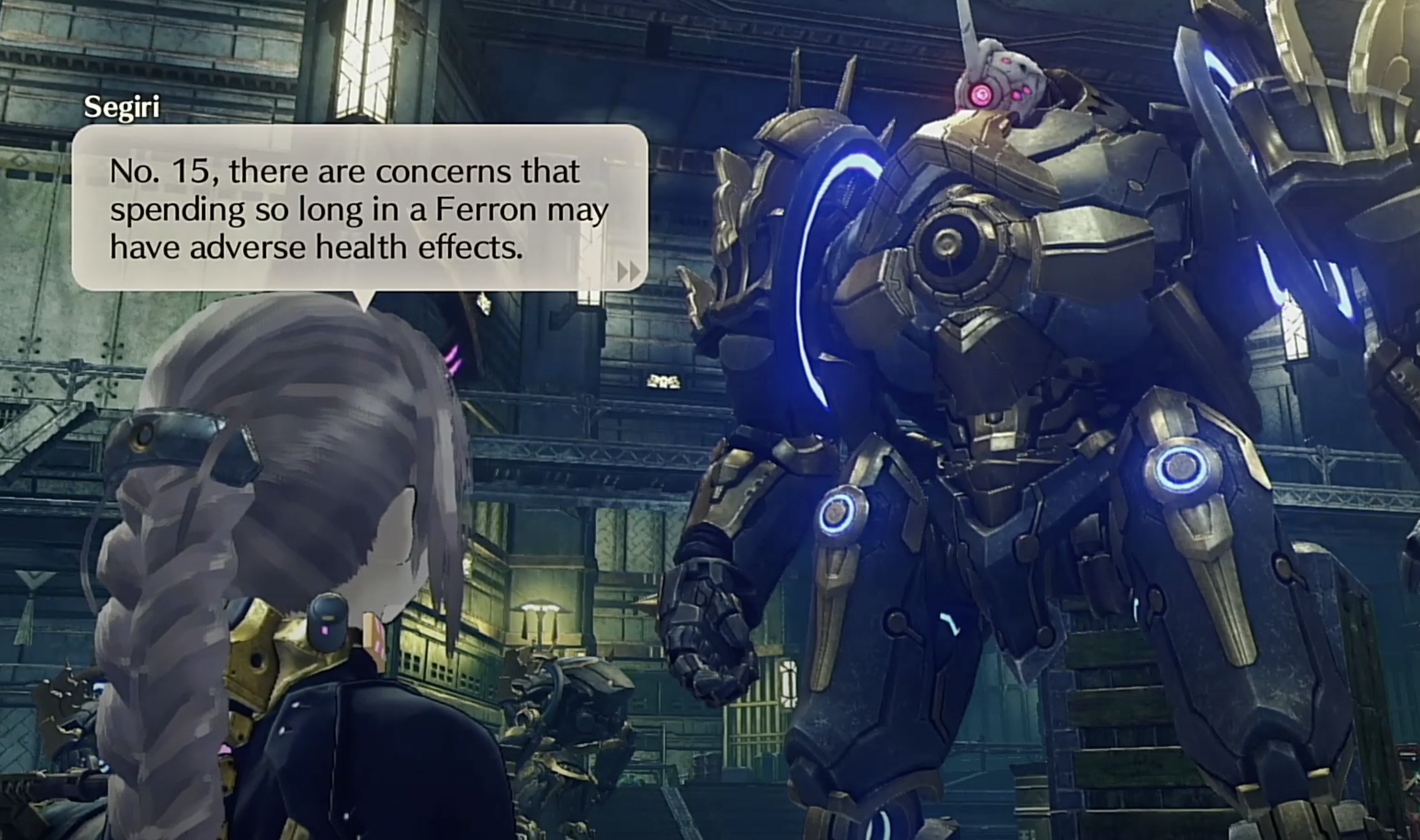
Colony 0’s Segiri trying to get No. 15 / Buffteen to emerge from his Ferron.
Colony 0’s No. 15 (later named “Buffteen”[179]) shows how fine the line is between this post-Moebius helplessness and Stockholm Syndrome: after Ouroboros liberates his Colony and finds them a new, non-Moebius home, he insists on staying within his Ferron unit until Ouroboros and Segiri, his Commander, coax him out of it by helping with his work.[180] While it’s true that he’s holed up working on stabilizing the power supply he designed in replacement of the Ferrons’ Flame Clocks, one gets the sense that he’s partly obsessed with perfecting it because he’s more comfortable inside the Ferron—a Moebius-designed combat unit that enfolds the user’s body, literally isolating them from the world of others—than he is among his peers. How easy it must be to draw comfort from such artifice when it’s the only sense of place one’s ever known: a place that, like all Ferronises and Ferrons, derives directly from Origin and thus feeds directly to and from Moebius’ vampirism.[181]
“I am my world,” but as Wittgenstein’s own attention to the relationship between his environment and capacity to work suggests, my world is also me.[182] Moebius’ tailoring of Aionians’ unflinchingly uniform physical reality echoes the hut Wittgenstein had built in Norway to facilitate his own peace by creating distance between himself and the world (C2). He also helped to design the architecture of a similarly exacting and unadorned house for one of his sisters in Vienna, a task that, he later told a friend, left him “so completely exhausted at the end of the day that all I could do was go to a ‘flick’ every night”—quite like one might imagine Z resting on the metaphorical seventh day of his godhood sham by sitting in the very front row of the Amphitheatre.[183]
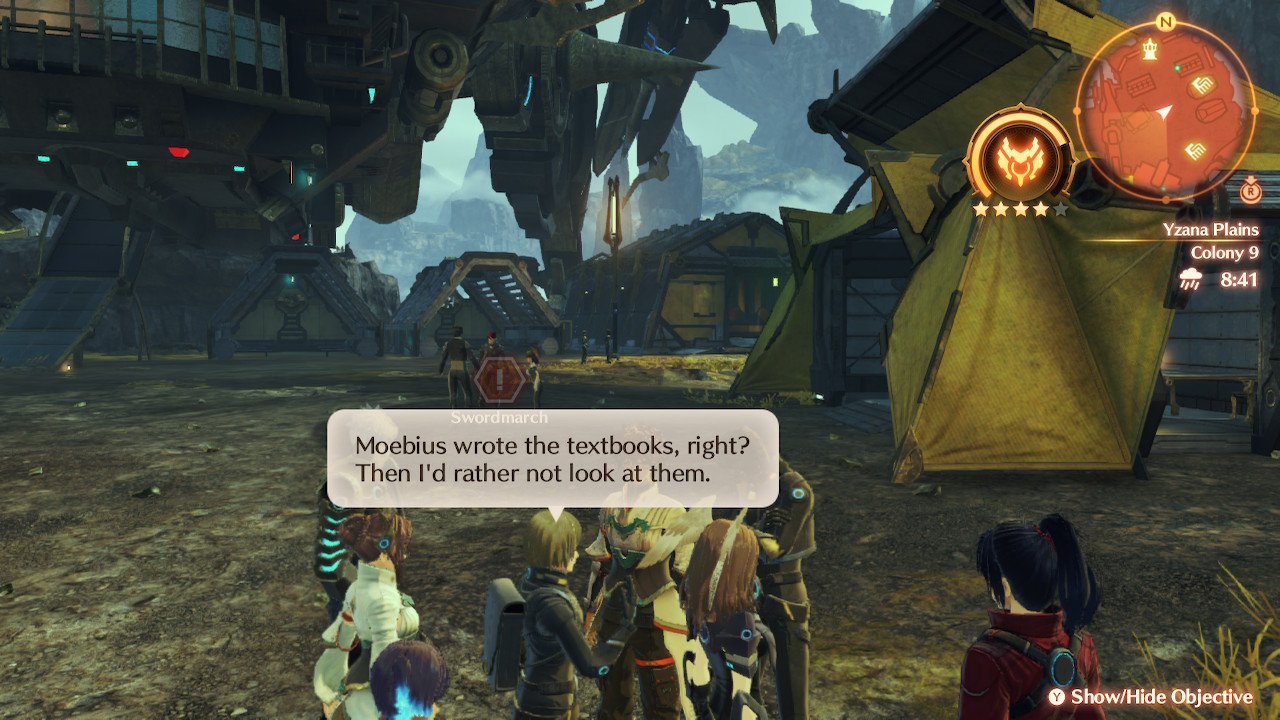
Colony reflections on their “cultural artifacts” after beginning to learn the extent of Moebius’ influence.
Outward from individual Colonies, the domain of the Endless Now further buttresses itself in the macrocosm of national culture and the trajectory of humanity at large. That which individuals experience personally is validated externally by the Colonies’ textbooks, authored by Moebius.[184] The true progenitors of Origin, the Queens, are replaced with figurehead simulacra: mouthpieces for the war game underpinning the Endless Now, reinforcing Colonies’ singular aspiration to victory in service of returning to them at Homecoming.[185] As the real Queens look on from a kind of sleep paralysis[186]—a jarring reversal of the agency afforded them as party members in Xenoblade Chronicles and Xenoblade Chronicles 2—their fake counterparts enact on the national stage the paradox of the Möbius strip, replacing two people bearing different origins and worldviews with a single doctrine, projected as if it were two separate nations.
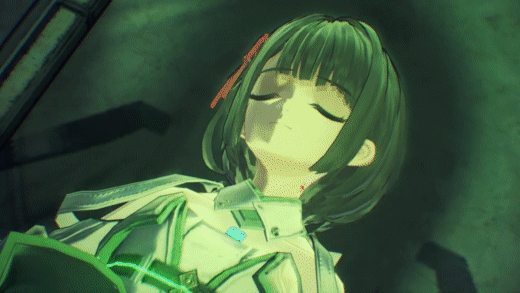
The story of Colony Omega
Cultures can evolve with time, and the Endless Now features measures to guide this evolution. Of the Colonies under Moebius’ control, two—one an Agnian and Kevesi mixed unit, and the other outside the Agnus/Keves distinction altogether—serve other functions than the typical war game. The former, Colony Omega, is an experimental facility in which Y engineers new Flame Clocks, altering Aionians to make their lives and deaths more “nourishing” to Moebius;[187] the latter, Colony 0, is a “mobile combat unit directly under Moebius command,” working “behind the scenes” to ensure that the war theater of Aionios runs smoothly.[188]
In the notation of the Tractatus, ‘Ω’ (uppercase ‘omega’) is the symbol for the “most general form of transition from one proposition to another,” through which the elementary propositions can be used to derive all other propositions.[189] These other propositions can be derived through functions that depend only on the truth or falsity of those elementary propositions, in such a way that they are already contained within the elementary propositions—meaning that the derivations are tautologies, saying nothing significant but showing the relationship of meaning between the language’s most basic statements and its more complex ones.[190] Where the tautology between two propositions is not immediately obvious, it can be shown through what Wittgenstein calls ‘a zero-method,’ illustrating through the two propositions’ truth conditions that the relationship between the two propositions is true in all cases, as it is for the propositions of logic.[191]
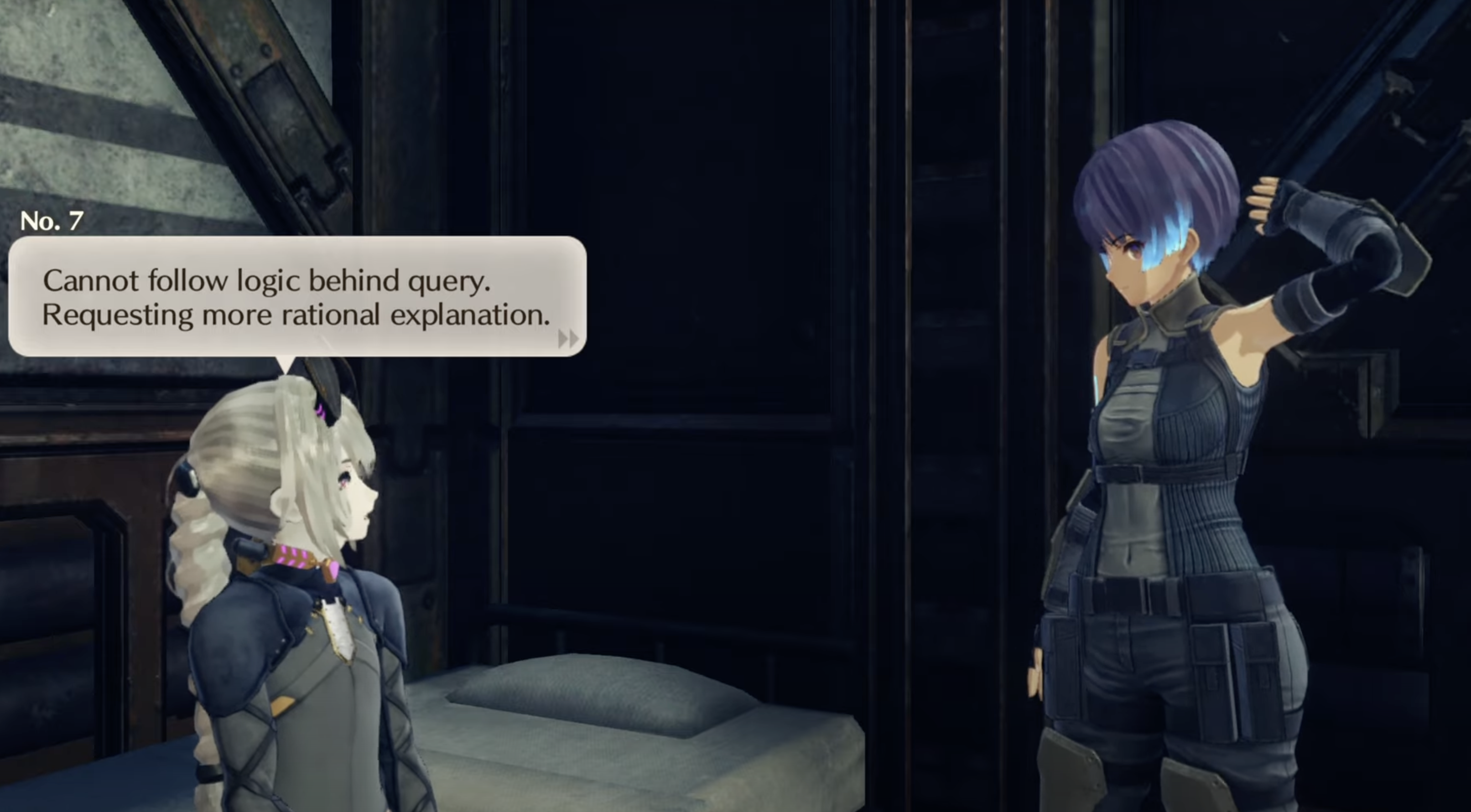
Segiri, as yet without a name, finds difficulty in interpreting language beyond its logical content when Sena and the rest of Ouroboros first meet her.
Put more metaphorically, Ω operates on our representations of the world’s constituents, and the zero-method shows that the truth of such operations is trivial in the case of the world’s logical structure. In parallel, Colony Omega operates on Aionios’ constituents (its people) through experiments to change their representation in the world (how much nourishment they provide), and Colony 0—more a method of Moebius than people, stripped as they are of identities and even names—quells all possible forms of resistance to Moebius’ picture of the world, “showing” through force that such operations as Omega’s are trivially justified in the case of Moebius’ representation of the world (since that is the only representation permitted). Thus Moebius’ two outposts experimenting on and curtailing human evolution are also yet further outposts for reinforcing the semantic vise of Wittgenstein 1.
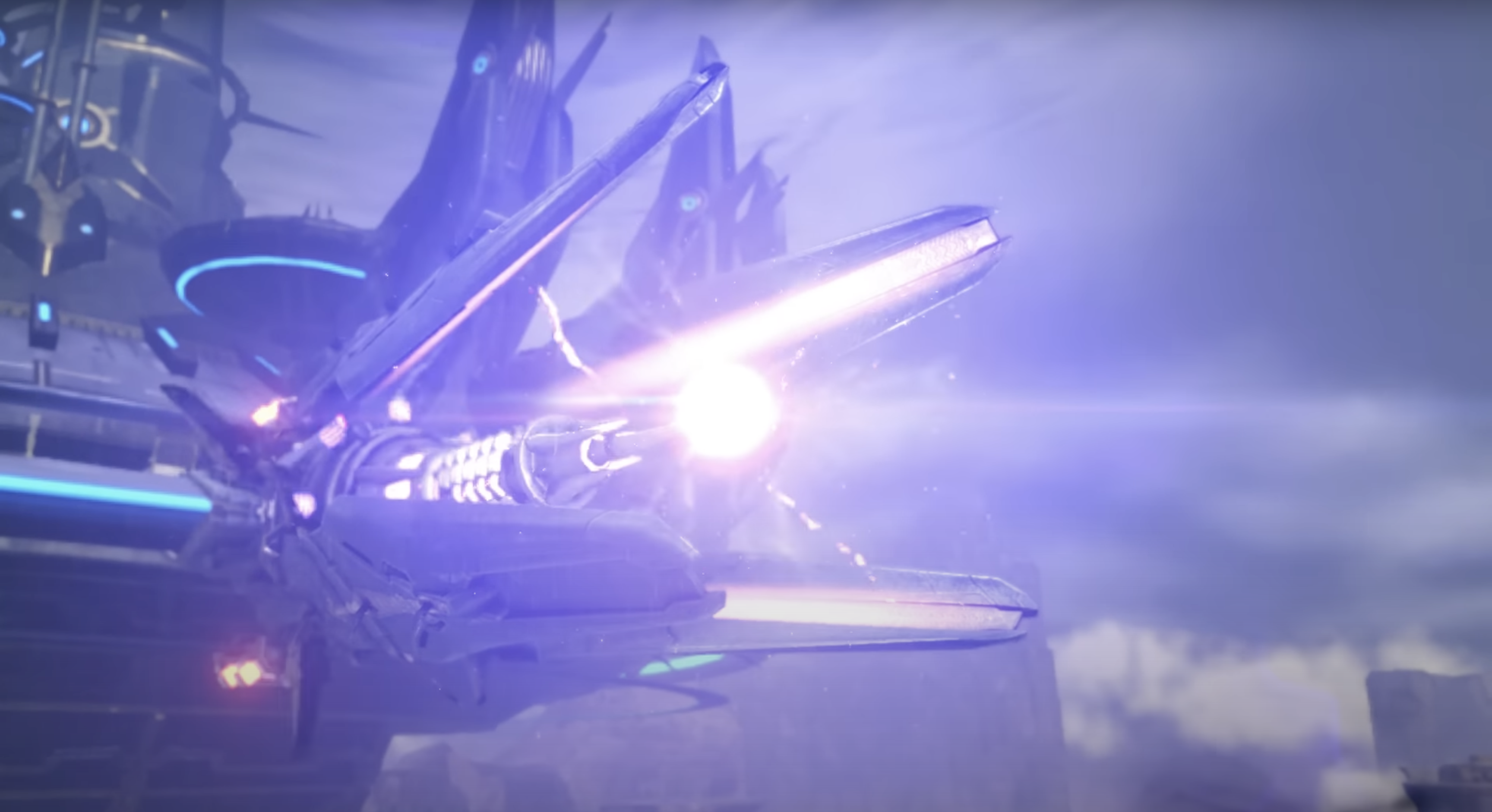
The Kevesi Annihilator, about to annihilate a section of the Urayan Mountains.
Most basically and universally, Moebius even seizes Aionios’ fundamental physics to enforce the Endless Now. They study the phenomenon that most theatrically threatens their world’s unity—annihilation events, the condensation of Kevesi and Agnian particles, in black-fog form, to the point of explosive destruction of all matter in the area—and harness it to create a pair of focused lasers that can annihilate virtually anything, anywhere on Aionios.[192] The violence that comes about as a natural reminder of the imposed world order’s instability is harnessed for the sake of defending that very world order, targeting the places that most threaten to reveal that “instability” as “diversity of meaning” (the City chief among them). It’s difficult to watch these sequences and not draw connections with the atomic bomb, a “mechanical means of killing people” that, Monk claims, only served to reinforce the biographical Wittgenstein’s pessimism that the human spirit was being systematically exterminated in the name of scientific and societal advancement.[193]
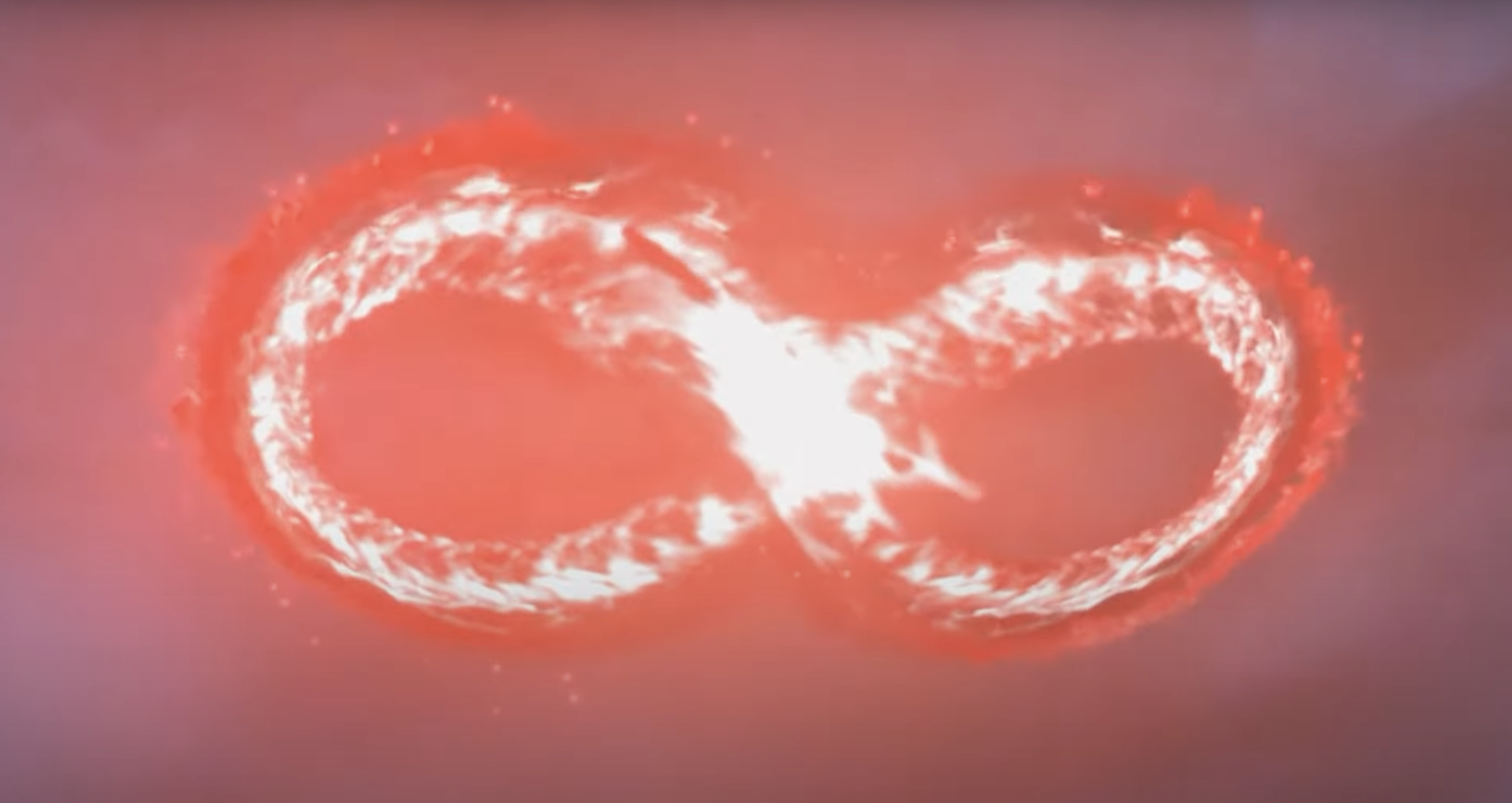
The Moebius symbol, projected in the sky by D and J to brand the newly minted Ouroboros as “enemies of the world.”
Moebius’ symbol, the Möbius strip, is identical with the Endless Now: its mark of infinity (‘∞’) promises the comfort of an eternity that is entirely held within your field of vision; its folding of two sides into one belies the nuance you must steamroll in pursuit of that comfort, discarding the natural in favor of the controllable. Wittgenstein 1 promises that even if the world is infinitely complicated, with infinite atomic facts, its meaning can be totally captured by the logic of the single picture and its limits on existence[194]—if only we could see that meaning, that worldly place of ours that brings us such despair, from the safety of a theater beyond it.
As the party begins to reckon with becoming Ouroboros, they also reckon with the idea that the world itself is a “supervillainpon”: innately evil because its order forces its inhabitants to kill others with no consideration of their lives, nor any choice to do otherwise.[195] The Endless Now shows us how accurate this thought is: the world is evil because it is an extension of Moebius, not merely limiting those within the world but fully redefining them as tools in an intrinsically broken game.
Taion warns against thinking about one’s place within a supervillainous world too vigorously because it leads to the suicidal conclusion:
If you don’t want to hurt others, you’ll end up denying your own right to survive. Eventually, you come to the conclusion that the world may well be better off without your presence. The only resolution then, is to erase the self. To die.[196]
The impulse of erasing oneself because of the nature put upon one by the world, we’ve seen, was tragically native to Wittgenstein’s biographical life—and it’s essential to the perspective of Wittgenstein 1, whose solipsism invites the inference that an evil world entails an evil self (“The world of the happy is quite another than that of the unhappy”[197]). In Moebius, the impulse manifests as the “void” on the brink of which N stands after losing M, and as the voices of “formless dead” that haunt and almost seem to bully Z in Chapter 7 after Nia awakens and his hold on Origin becomes less total.[198] These perceived voids of M and the lives not currently in circulation on Aionios are just Wittgenstein 1’s anxiety that death is not a part of life, that those outside of my solipsistic world cannot truly relate to me.
As the Amphitheatre battle with Z shows through Z literally channeling the voices into a shield, this anxiety reinforces and safeguards the rigid, paradoxical world of Wittgenstein 1, resisting change by imposing a distance that cannot be maintained coherently—much as Ouroboros, time, and time, and time again, shatters Z’s shield, closing the distance. N, too, can shield himself by drawing power from the “void” M left, but he can’t refute the fact that M stands directly in front of him, unified with Mio, even as he names that void.[199]
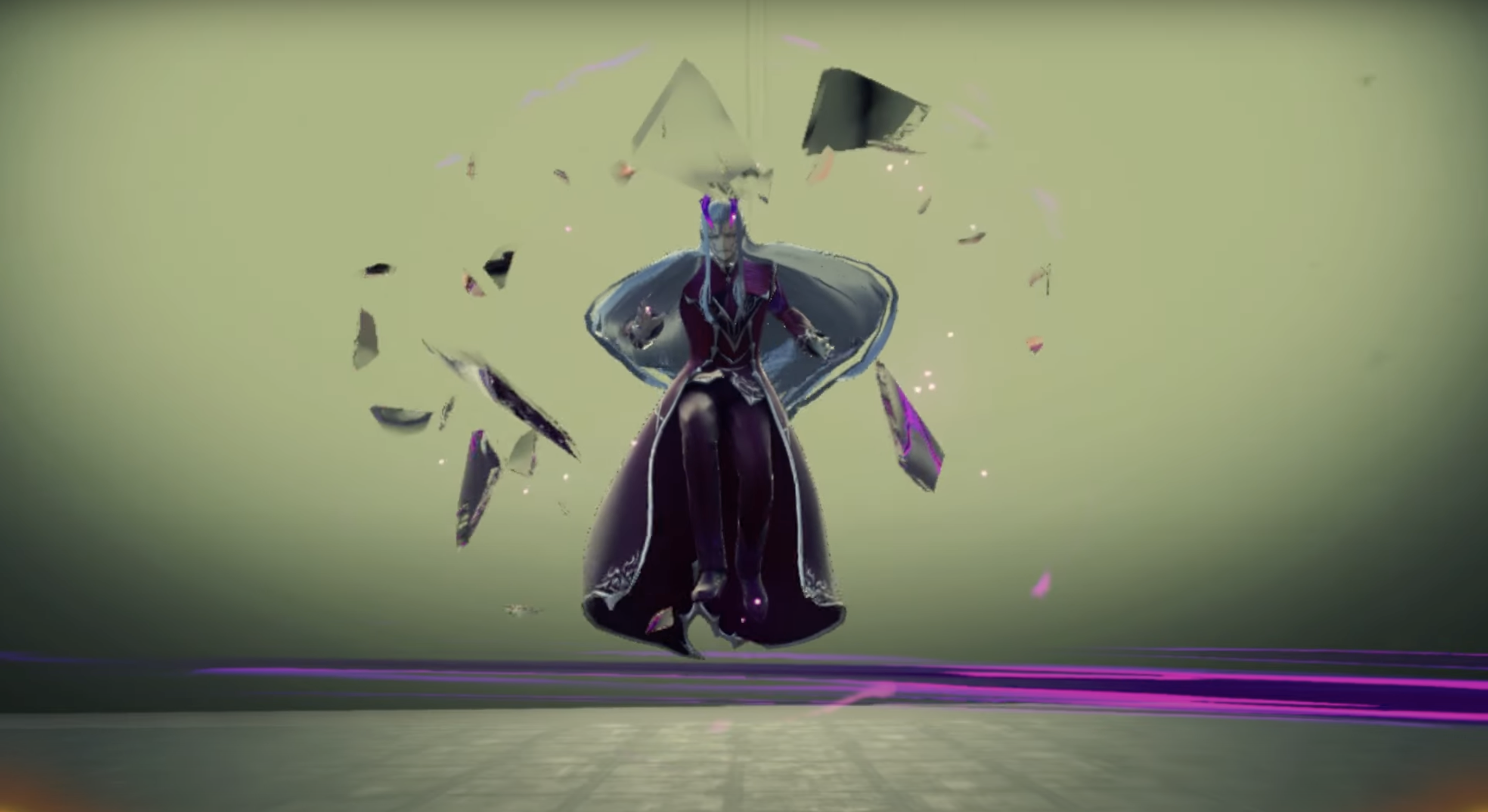
Ouroboros shattering Z’s shield in their confrontation upon the Amphitheatre stage.
The question, then, is how Ouroboros is able to close the distance—and how they’re able to help the player, who so vividly sees herself in Z’s involvement-from-a-safe-remove, to chart a different path than Z, Moebius, and Wittgenstein 1. The answer, the key to understanding the game’s foundation of enlightened empowerment, lies in Wittgenstein 2.
§2: Part 2: Freedom of Thought
Tractatus Logico-Philosophicus (4.5): “The general form of propositions is: This is how things are.” — That is the kind of proposition one repeats to oneself countless times. One thinks that one is tracing nature over and over again, and one is merely tracing round the frame through which we look at it.
A picture held us captive. And we couldn’t get outside it, for it lay in our language, and language seemed only to repeat it to us inexorably.
—Ludwig Wittgenstein, Philosophical Investigations, 114-115
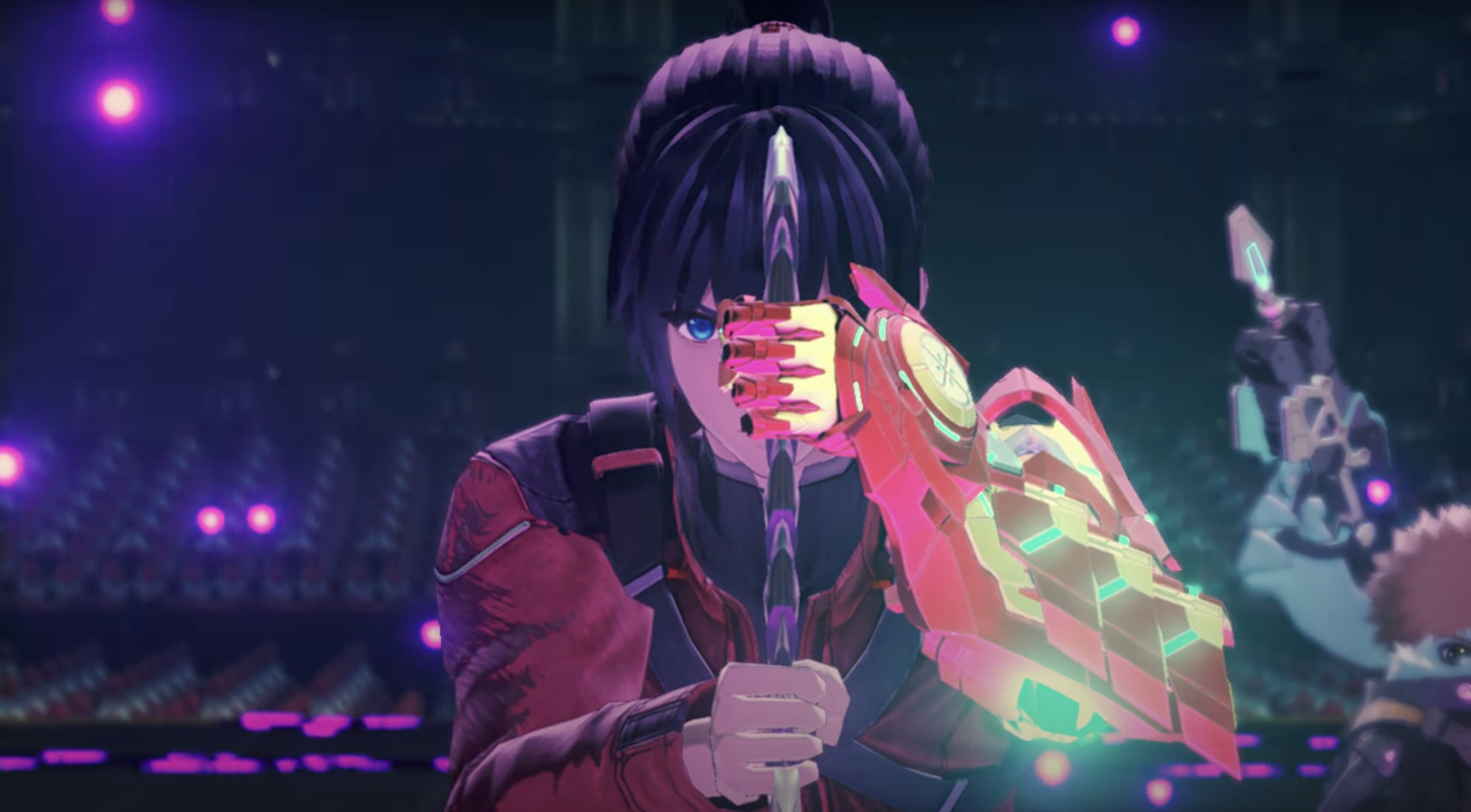
Noah, exposing the Amphitheatre as an illusion.
Shulk was an engineer. Rex was a salvager. Noah and Mio are musicians.
The distinction strikes at the heart of Wittgenstein 2, opening the door for the player and heroes of Xenoblade Chronicles 3 to understand Wittgenstein 1 yet choose a path of hope. To be a musician is to participate in a fundamentally different mode of expression, or form of life, than the activity of understanding the machinery of a past or present world.
Wittgenstein had intimate, biographical experience with both of these forms of life, and the points of analogy he drew between them and his work point the way to situating the divergent qualities of Xenoblade Chronicles 3’s avatars within a holistic understanding of its story:
- Where Shulk and Rex are singular heroes supported by friends and teammates, Noah and Mio are not only partners on a par with each other, but also one of three such partnerships on equal footing.[200]
- Where Shulk and Rex confront independent characters (Zanza and Malos, respectively) that threaten their worlds and those who live within them, Noah and Mio undergo forms of therapy, confronting and integrating fragmented aspects of their identities and relationship (N and M, respectively) and using that integration to overcome the inner despair that motivates, and is motivated by, the Wittgenstein 1 worldview.
- Where Shulk and Rex create new world orders, Noah and Mio destroy the world order of Aionios with no promise of a new one in its place.
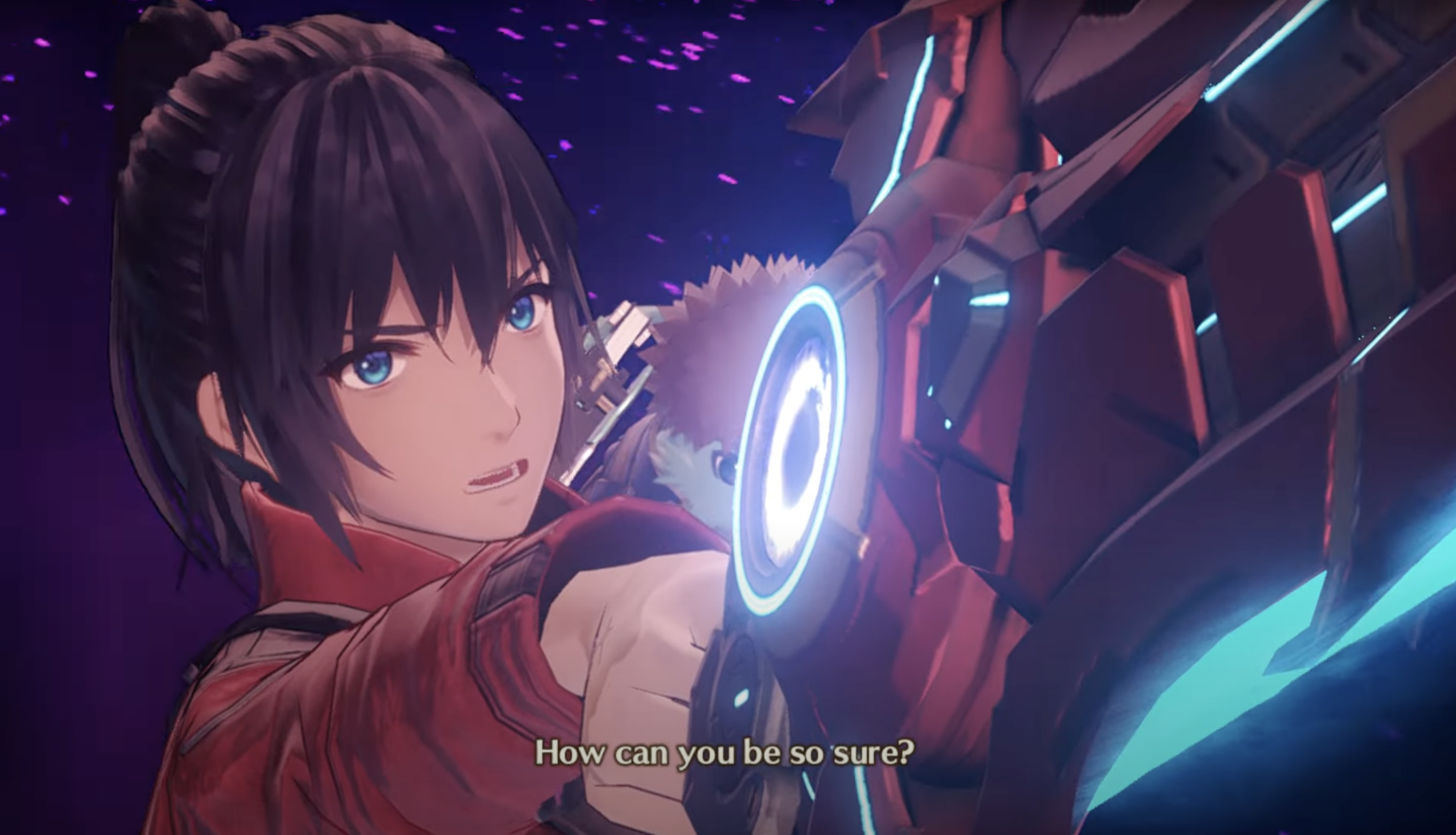
Noah, challenging Z’s certainty that the two worlds constituting Aionios will annihilate each other if time is permitted to move again.
As Wittgenstein 1 integrated Z and Moebius’ characteristics into a singular interpretation of the antagonistic forces of Xenoblade Chronicles 3, so too, I want to convince you, a second Wittgenstein-derived perspective shows us how the game’s protagonists exist in conversation with, and ultimately achieve victory against, those forces. At one time, Wittgenstein planned to publish his later philosophical work, the posthumously published Philosophical Investigations, alongside the text of the Tractatus, believing that his new work “could be seen in the right light only by contrast with and against the background of my older way of thinking”;[201] just so, Wittgenstein 2 shows us not just a different, more optimistic perspective of Wittgenstein-derived thinking, but also one that clarifies how and why the hope of Ouroboros and the player can be seen in the right light only by contrast with and against the background of Moebius’s despair. As in the case of Wittgenstein 1 in Part 1, we’ll draw on threads from Wittgenstein’s philosophical work, broader intellectual thinking, and biography in weaving together the perspective of Wittgenstein 2:
- From Wittgenstein’s later philosophical work, we’ll draw on views of philosophy as therapy, looking at his model of language-games as a means of drawing ourselves away from the impulse to build general theories, instead focusing on the particular cases of how we use language to interact with the world and each other. We’ll also avail ourselves of Wittgenstein’s later views on skepticism and perception to sketch a picture that emphasizes, over and over, the importance of context, using philosophy as a practice for directing our attention toward “really seeing” what’s right in front of us.
- From Wittgenstein’s broader intellectual reflections, we’ll explore how Wittgenstein’s views on language-games inform his views on interpretation as a language-game—and how only an artistic perspective can interpret our place in the world sub species aeternitatis, contra Wittgenstein 1’s paradoxical pursuit. We’ll return to religion to consider not an aspect of doctrine which he struggled to understand (like predestination), but rather the positive feeling that he interpreted as the religious feeling, which he sought from his youth onward: a feeling of absolute safety.
- From Wittgenstein’s biography, we’ll consider the diversity of jobs and roles he adopted at various times throughout his life, as well as the counsel he regularly gave his friends and students to put themselves to practical use rather than joining the ranks of academia. We’ll also further probe the topic with which we began Part 2: a reflection on the musical, and how large music loomed in Wittgenstein’s life—a common analogy deployed in his work, as well as especially useful connective tissue in bridging Wittgenstein 2 to the off-seers of Xenoblade Chronicles 3.
The structure of Part 2 mirrors that of Part 1. I first outline the above strands of Wittgenstein, deriving slogans from them and linking those slogans together to define the perspective of Wittgenstein 2 for our purposes of literary interpretation. I then illustrate how Wittgenstein 2 manifests in the game’s heroes, from the cosmic to the mundane: we’ll progress through (1) the player of the game, (2) Queens Nia and Melia, (3) Ouroboros, both as a concept and as represented in the particular group of Noah, Mio, Eunie, Taion, Lanz, and Sena, and (4) the Heroes whom the party meets, and who join Ouroboros in its cause, bringing the cultures of their Colonies and other homes with them.
This interpretative activity has a very different flavor than our study of Moebius’ constituents in Part 1: whereas Wittgenstein 1 slotted its constituents into a singular, totalitarian, self-undermining worldview, our application of Wittgenstein 2 to the heroes of Xenoblade Chronicles 3 requires at every turn that we resist our impulse to fold Aionios’ diverse cast of characters into one general, theoretical worldview. What makes Wittgenstein 2 useful for us, therefore, is that it highlights the thematic content of this diversity, providing us with a cipher for how hundreds of hours of chapters, sidequests, and choices sum to the defeat of Moebius without really being commensurable with one another.
Where we studied the activity of Wittgenstein 1 in the Endless Now imposed upon the world to keep it in a precarious stasis, here we’ll study the activity of Wittgenstein 2 through the lens of plot as therapy: chapter by chapter, we’ll see how the story’s protagonists are able to perform a range of therapies to treat Wittgenstein 1, performing the act of destroying the world. Yet as we examine that act, consistent with the promise of Wittgenstein 2, we’ll find that “what we are destroying are only houses of cards, and we are clearing up the ground of language on which they stood.”[202] For the player, what remains when the dust settles is enlightened empowerment, a perspective that might carry her in new directions well beyond the conclusion of Xenoblade Chronicles 3.
§2.1: Wittgenstein’s Therapies
In Part 1, we sketched a perspective on Wittgenstein that centered on imposing a rigid picture of meaning upon the world, and situating oneself both inside and outside that picture in a solipsistic, paradoxical attempt to allay the despair that that very picture brings about. Our perspective in Part 2, rather than a picture, is concerned with methods: carefully attending to what we do in the world and the context in which we do it, shunning the desire to find comfort in abstract concepts that would unify these diverse activities into something theoretical and illusory. It’s this attention to action that makes possible the exact form of hope which Noah councils in the final words, of all the game’s many words, before the credits of Xenoblade Chronicles 3: “look up, face forward, toward your chosen horizon… And just… walk on.”[203]
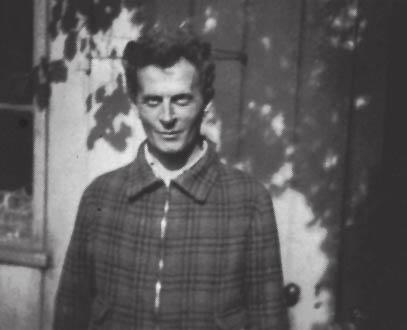
Photograph of Wittgenstein in the Fellows’ Garden at Trinity 1939. Taken by Norman Malcolm. (Source.)
§2.11: What Games Do: Meaning as Use
Moebius and the Tractatus alike present a machinery: they capture all that can be done in the world, all that can be done with language, with a general and abstract picture. There is an Amphitheatre and a general form of proposition that capture the logic and limits of everything significant that we can do with language; though this perspective wants to kick down the ladder of its machinery, the stipulated essence of language and meaning hangs there, ghost-like, in the air, a self-undermining argument in favor of its own existence.
Wittgenstein’s later philosophical perspective replaces the view of the machine as a symbol, already containing all its possible modes of operation by virtue of its components’ organization, with the view of the machine as a practical tool with parts that might break, bend, warp, or behave in any manner of other ways—if only we look and see how the machine is used, rather than stipulating ghostly entities like “possibilities of movement” to understand what isn’t there.[204] The rich diversity of meaning in language, then—how we say things in the world, think things in the world, do things in the world—comes into focus not through symbolism, but rather by using a broad range of examples and analogies to “[disperse] the fog” that the philosopher’s picture of meaning casts over our language, looking first at language’s many uses rather than seeking essential concepts that words in language name.
In sketching Wittgenstein 2, we’ll explore this emphasis on the use of language through 3 dimensions: (1) the tool he often used to “disperse the fog” in his own work (the language-game), (2) the fog he dispersed in various domains of philosophy (our perspectives on the world inside of us and the world outside of us), and (3) the broader role he saw for these methods in our lives and collective understanding (a therapy of criss-crossing worlds of examples and different forms of life).
§2.111: Language-Games: A “Reverse Instruction Booklet”
If you grew up playing video games in the 2000s or earlier—or, if you’re a modern gamer with a penchant for collecting and playing “older” games—then you’re probably familiar with the now-antiquated artifact of the instruction booklet: a stylized, paper insert found within a game’s physical case, with details on how to play the particular video game you just purchased.
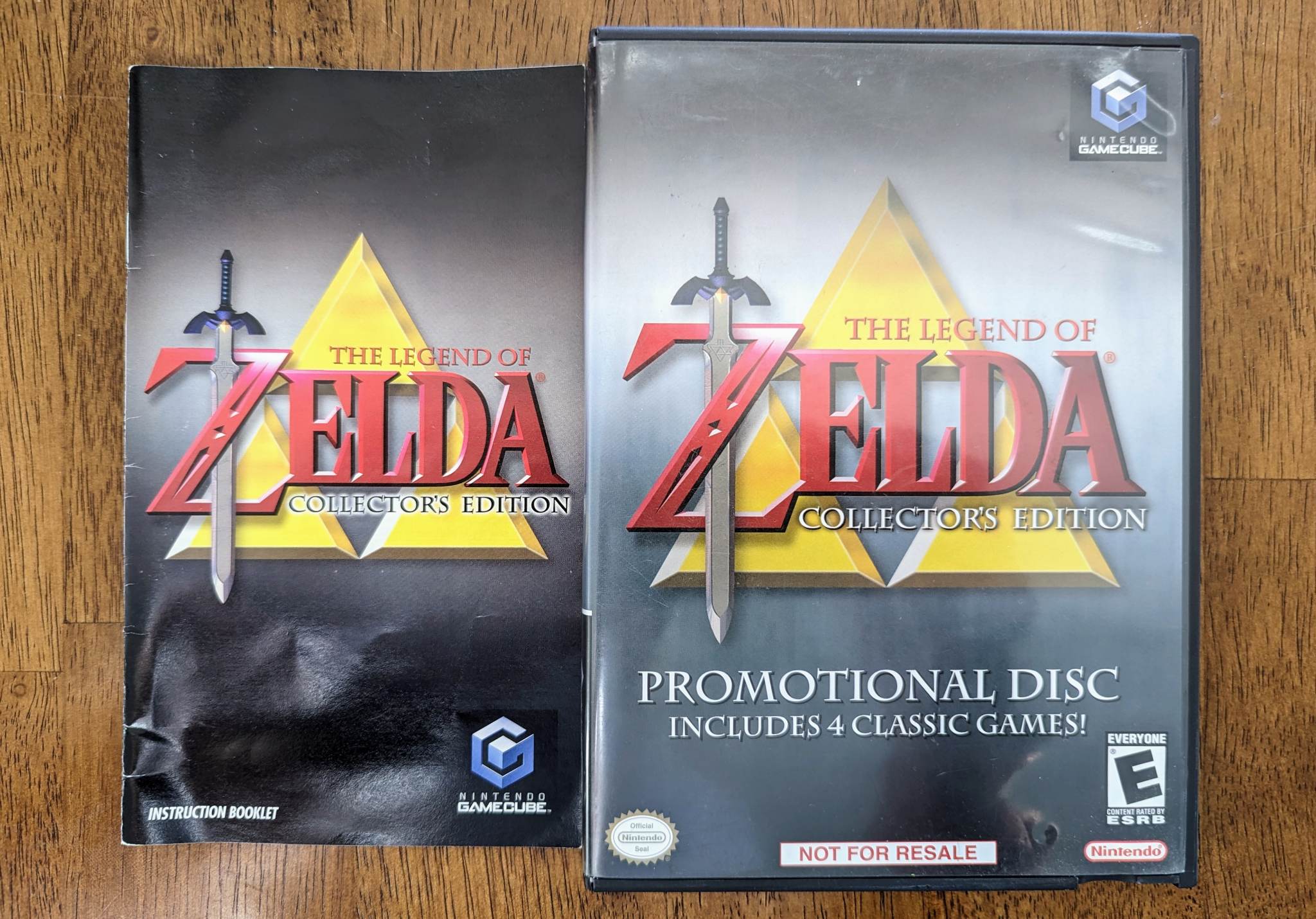
One of my own first and formative instruction booklets, for Nintendo’s The Legend of Zelda: Collector’s Edition. Photo by author.
Nowadays, these booklets are outdated not only because of video games’ gravitation toward digital publication over physical, but also because modern games are typically designed with the expectation that players will learn by doing: they’ll pick up a controller, start using its inputs to try out moves, and gradually come to grasp the game’s rules, with the help of some contextualized tutorials within the game itself along the way. It’s almost as if, with a little help, gamers could now write a sort of “reverse instruction booklet” for the games they play, articulating the rules and goals of the game simply by attending to what they do within them; if you’ve ever had occasion to help a newcomer to gaming find their way around a new game (perhaps your parent, your partner, or your child?), then you’ve already put this idea into practice.
Wittgenstein’s language-games are ways of helping us to write these reverse instruction booklets: they are not theories of language as some kind of singular, rule-based matrix of interaction, but rather deliberately simple heuristics providing sample languages with small vocabularies and specific uses for that language, so as to draw our attention to the range of ways in which language permeates our everyday life—not unlike the simplified games through which children learn language in the first place.[205] If we find ourselves transfixed by the picture of language’s essence consisting in the naming of objects and placing them in relations with one another, for instance, we can free ourselves from the trance by considering a language-game in which the entire language is intended for communication between a builder and an assistant, with the only words being “block,” “pillar,” “slab,” and “beam.”[206] By considering how people would actually use and understand the elements of such a language, perhaps adding other vocabulary such as numbers and demonstratives as we move through those considerations, we can help ourselves to see that a naming-first picture of language might describe one use of language, but it certainly doesn’t exhaust the matter of what language is—no more than an understanding of board games applies to everything that we would call a game.[207]
Once we disabuse ourselves of the notion of language consisting in a fixed system of meaning through signification, we can look around our world and see all kinds of language-games in the wild, beyond toy examples. Where other philosophies of language reduce kinds of sentence to the statement of a proposition, asking of a question, or the issuing of a command, Wittgenstein counters with a therapeutic deluge of distinct language-games demonstrating the rich and evolving diversity of language—plainly manifest, if only we look beyond the picture that held us captive:
The word “language-game” is used here to emphasize the fact that the speaking of language is part of an activity, or of a form of life.
Consider the variety of language-games in the following examples, and in others:
Giving orders, and acting on them —
Describing an object by its appearance, or by its measurements —
Constructing an object from a description (a drawing) —
Reporting an event —
Speculating about the event —
Forming and testing a hypothesis —
Presenting the results of an experiment in tables and diagrams
Making up a story; and reading one —
Acting in a play —
Singing rounds —
Guessing riddles —
Cracking a joke; telling one —
Solving a problem in applied arithmetic —
Translating from one language into another —
Requesting, thanking, cursing, greeting, praying.
— It is interesting to compare the diversity of the tools of language and of the ways they are used, the diversity of kinds of word and sentence, with what logicians have said about the structure of language. (This includes the author of the Tractatus Logico-Philosophicus.)[208]
The notion of a form of life articulated here is notoriously hard to pin down with a definition in Wittgenstein’s work—perhaps unsurprising in work that focuses, as we’ll see, on analogy and relationship rather than necessary and sufficient conditions for concepts—but it drives to the heart of the thought that games, more so than on specific and rigid rules, depend on a shared context for the players participating in the game. This context might involve elements of culture, behavioral overlap, or—as we considered in Part 1, in the case of religious language-games—a shared way of living one’s life according to certain principles or beliefs (in that case, a life of devoutness). As we consider the different language-games and cultural views of Wittgenstein 2—and, indeed, of Xenoblade Chronicles 3—again and again we’ll see that different games are made possible or impenetrable based on the similarities and differences between the player’s lives. That might seem like an obvious intuition—“shared present and background context matters for successful communication”—but remember the monolithic, context-independent attitude of Wittgenstein 1 and the author of the Tractatus toward language. Remember, too, that this was a monolithic attitude drawn from a pursuit of comfort with which we and Ouroboros could empathize.
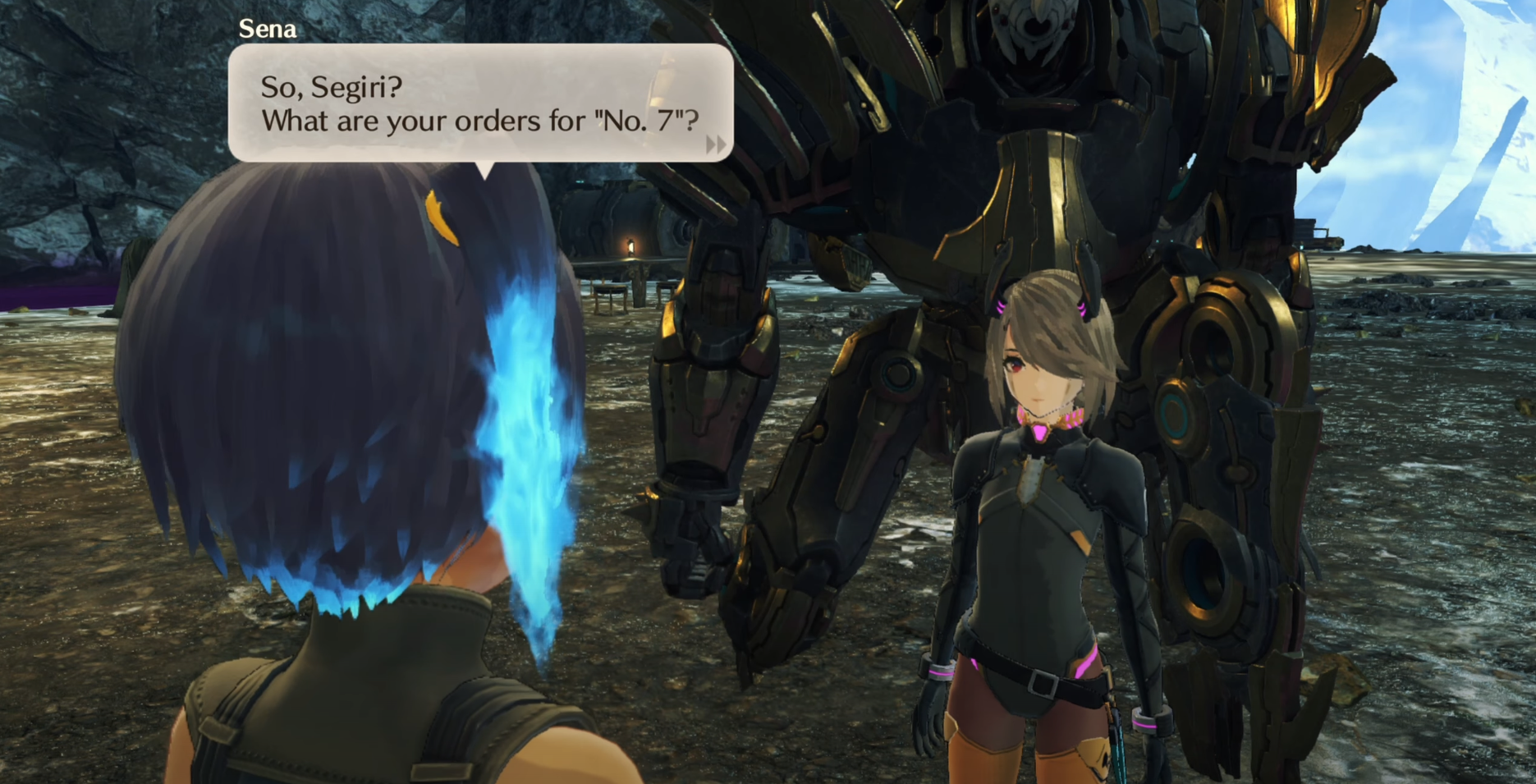
Sena plays a language-game with Segiri, bridging their distinct contexts by combining Colony 0’s conventions of order-issuance with Aionian conventions of naming to give Segiri a means of making choices for her own benefit.
Language-games, then, scaffold our world in the way that a good pair of glasses does: they provide clarity into what’s right in front of us. Put as Slogan 1: To understand how language relates people to the world, look and see how they use it.
The more we look and see, Wittgenstein has it, the more rigid, seemingly crucial concepts of philosophy dissipate along with the blur. Three among these loom large in the Investigations and in our conception of Wittgenstein 2: words, rule-following, and private experience.
§2.1111: Family Resemblance: Identity through Comparison
If you found yourself in the grip of a singular, general theory of how language gives us access to our world (as Wittgenstein seemed to be in the Tractatus), then you might try to fight your way back from this diversity of games to a single view that identifies the meaning of language with whatever’s common to all the language-games: seeking, in other words, to find in the essence of ‘language-game’ a general form of proposition, of the sort offered in Tractatus 6 ( ![]() ).[209]
).[209]
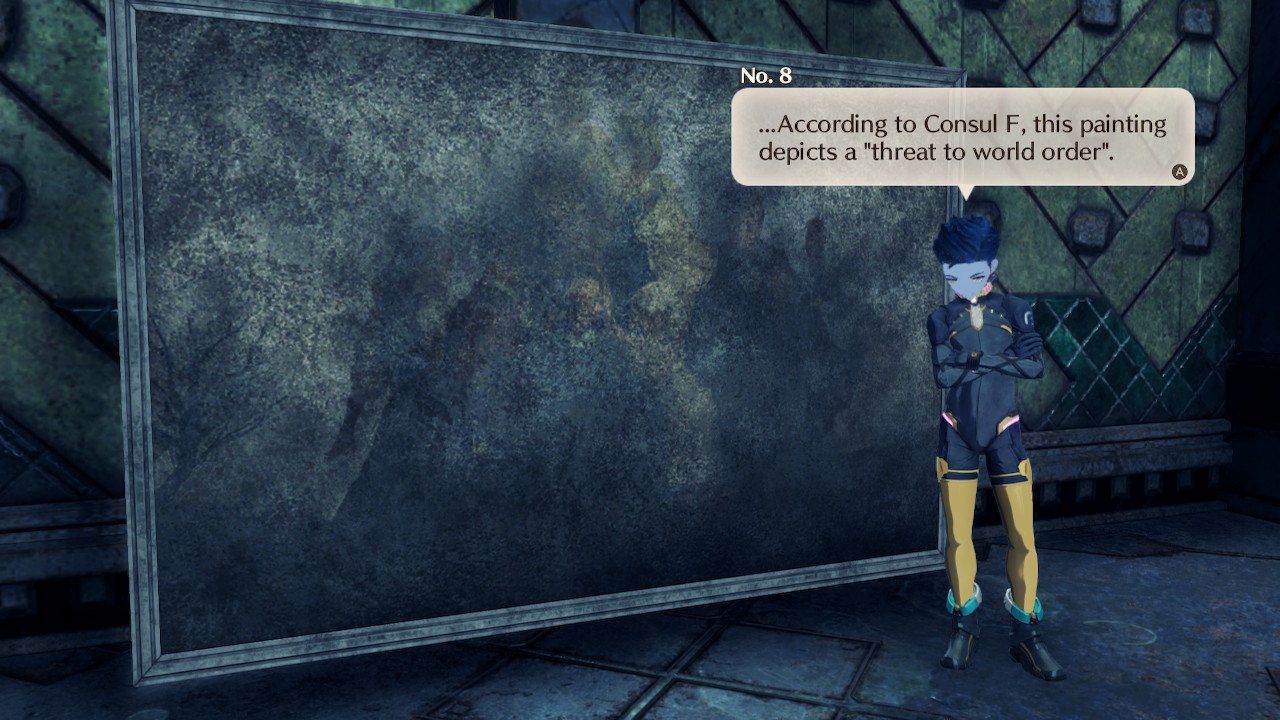
“Siblings,” an older painting (pre-restoration) representing a family resemblance that Consul F considered a “threat to world order.”
Wittgenstein was adamant that there was no such essence to the language-game: there is no special, changeless “element of reality” which a particular piece in one language-game or another , such as a name, picks out through signification.[210] Rather, we identify many language-games, along with the pieces used within them, by recognizing what he called “different kinds of affinity,” or family resemblances, between the games: not defining them by sets of necessary and sufficient conditions as the Tractatus would have it, but rather by considering them in comparison with others and situating them within “a complicated network of similarities overlapping and criss-crossing,” much like members of a human family share various traits with various relatives yet don’t share all traits with any one relative.[211]
Crucial to our ability to notice family resemblances without prejudice is clarity about which language-games or parts of language-games are being compared in order to notice some particular features or similarity within one or another of the objects being compared. Without this clarity, we risk inferring the reality of, or otherwise appealing to, an idealized “prototype” whose features its “family” of cases must possess—pushing us right back to the essentialism and priority of reference from which we sought escape.[212] This kind of prejudice leads idealists, solipsists, and realists to take a particular language-game—say, “turning all assertoric sentences into sentences beginning with the prefix ‘I think’ or ‘I believe,’”[213] or speaking of what one sees or imagines as a “visual room”[214]—and infer from its grammar something that does not follow about the nature of the world.
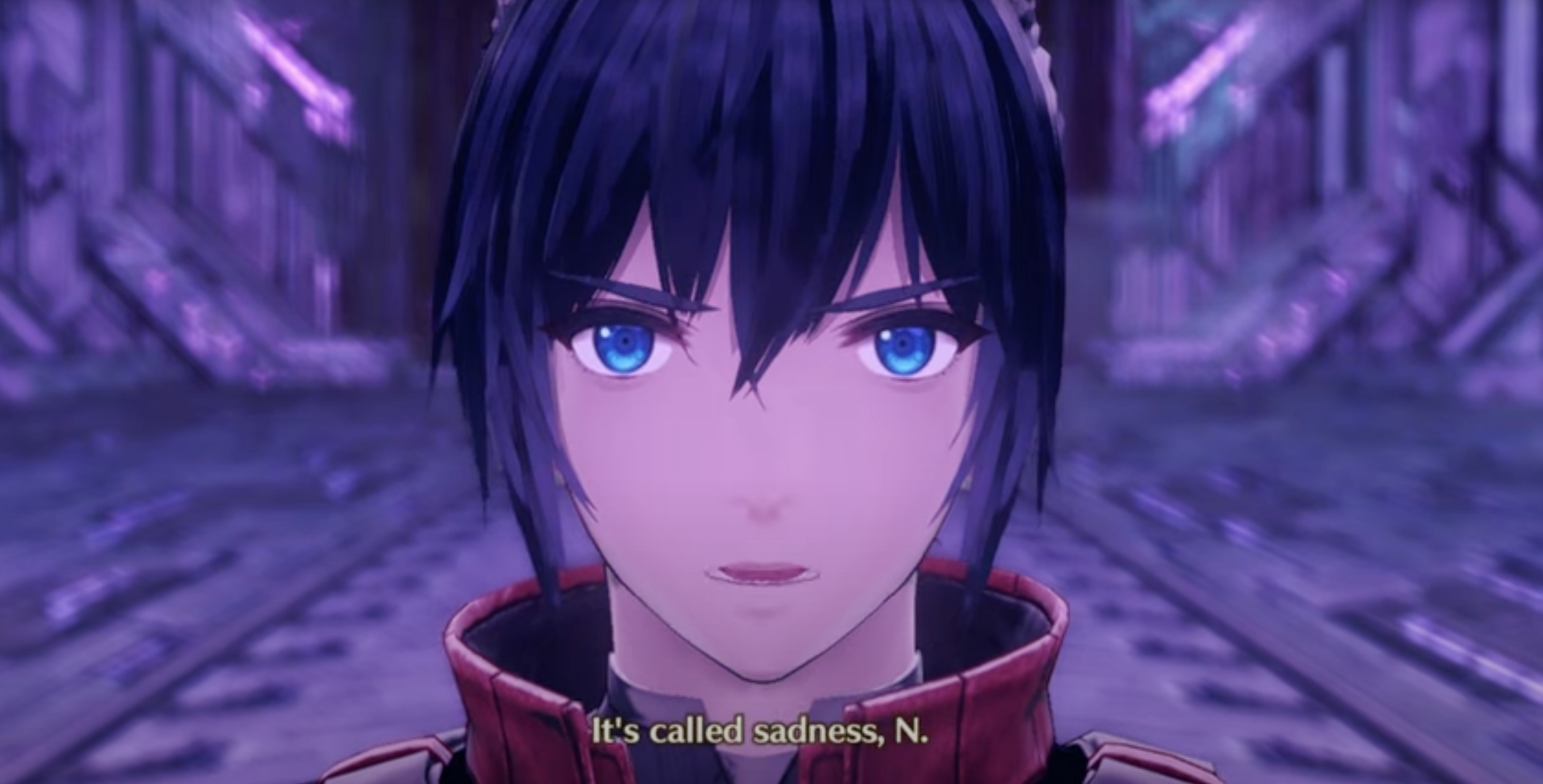
Noah, playing a language-game with N’s concept of the “void.”
The Tractatus’ unsayable truth of solipsism, then, is not a final truth about the relationship in which our perspective stands to the world, but rather a point of comparison between the grammar of two language-games: the Tractatus’ language-game of naming objects and relationships, and the language game of describing a stipulated “visual room” alongside our visual field. Its mistake is confusing a new linguistic comparison with the discovery of an objective truth about the world; the remedy is drawing our mind back to the act of comparison that is happening right in front of us.[215]
We’ll put 2 slogans to Wittgenstein 2’s views of family resemblance and solipsism:
Slogan 2: We understand the tools of our language-games within the context of networks that map similar games.
Slogan 3: One game has no claim to ontological priority over another.
This dependence of words’ meanings upon networks of diverse use-cases helps us to see why Wittgenstein’s Philosophical Investigations and other later works “travel criss-cross in every direction over a wide field of thought,” holding up a wealth of unusual language-game examples as “sketches of landscapes which were made in the course of these long and meandering journeys.”[216] As Wittgenstein saw it, the fog confusing philosophers’ understanding of many concepts came about from “a one-sided diet: one nourishes one’s thinking with only one kind of example.”[217] The solution, as he put it in his last series of lectures on the philosophy of psychology at Cambridge, is the illumination of family resemblances through a more balanced diet of examples, “[making] you see that it was absurd to expect the concept to conform to those narrow possibilities. Thus your mental cramp is relieved, and you are free to look around the field of use of the expression and to describe the different kinds of uses of it.”[218]
§2.1112: The Accessibility of a “Private” Language
Attending to the grammar of our language-games disperses not only the fog that clouds our vision of the world around us, but also the fog that clouds our understanding of our inner lives.
The dark theater of solipsistic worldviews such as Wittgenstein 1 might tempt us to think that our experiences of that world are private to ourselves: not merely that it’s daunting to share ourselves with others, but rather that feelings, sensations, and internal impressions most basic to our lives can’t be communicated to others with the same fidelity as, say, sharing a photograph with them. In the face of the visual room holding us captive within our own minds, the Wittgenstein of Philosophical Investigations challenges the notion that a language referring to our “immediate private sensations”—a private language that no one but the speaker can understand—is even a coherent idea. To reject such a language, for Wittgenstein 2, is to show that we are not trapped in solitude, especially in those moments when our feelings may seem most unspeakable.
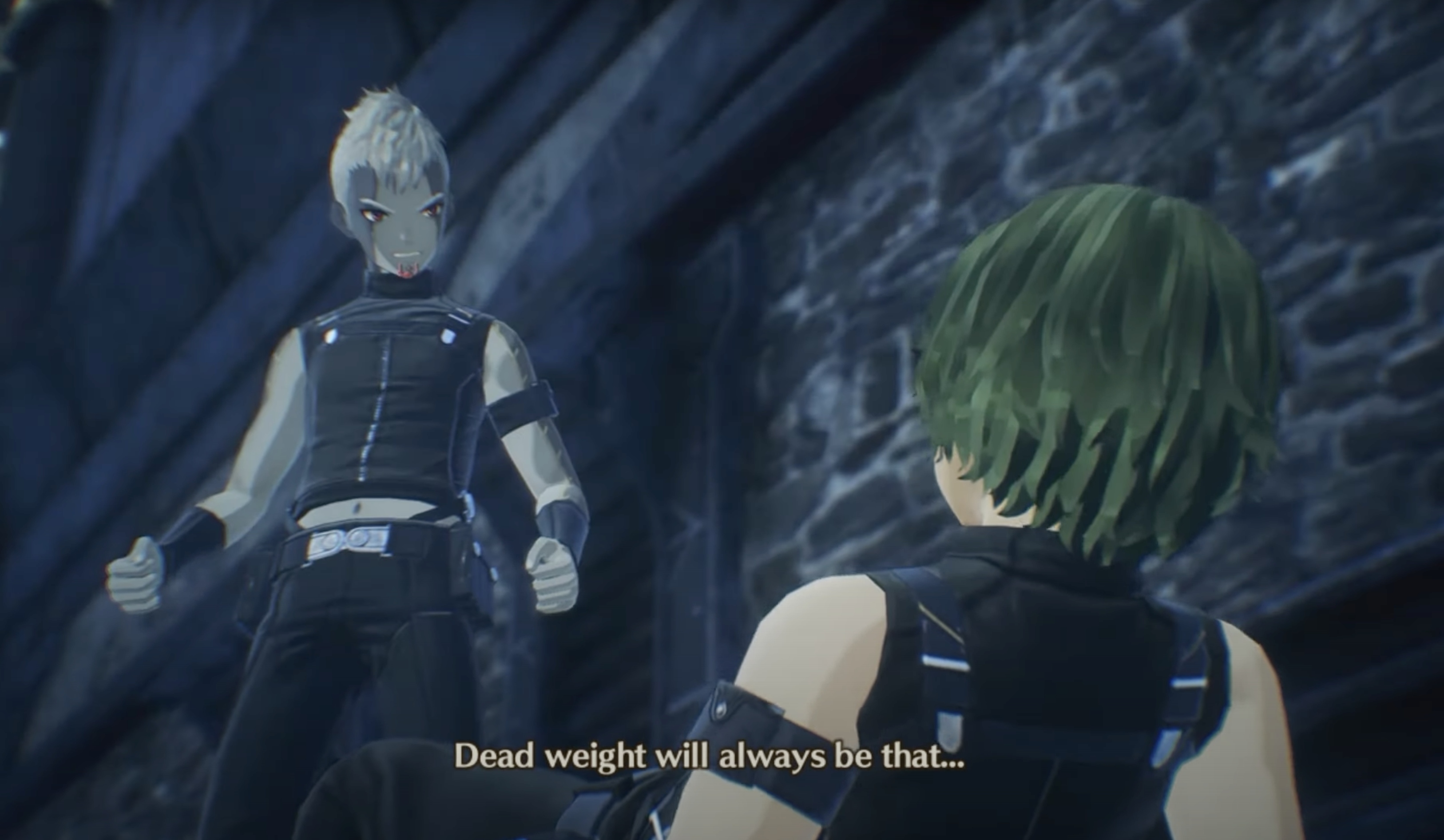
J’s rumination on what he perceives as the constant uselessness of Joran across memories of all his past lives.
Wittgenstein first notices the limited resources a speaker would have available to construct a private language in the first place: if she wanted to use a word for a particular sensation—say, pain—she wouldn’t be able to use our ordinary expressions of pain to signify the sensation with a word, for such expressions can be understood by anyone; nor could she define the name she gave to the pain verbally, for such a definition would also be publicly accessible.[219] The challenge, then, is to prepare “the grammar of the word ‘pain’” in a language-game without thereby making it something that others can play, for the naming of a private sensation wouldn’t make sense otherwise.[220]
With this in mind, Wittgenstein considers the case of someone logging the recurrence of a particular sensation, like pain, in a diary, marking a calendar with a chosen sign, “S,” every time they have that sensation.[221] Would such a case be possible, lacking most of the resources we typically have at our disposal for naming things and using those names? Perhaps it could be, Wittgenstein considers, if the speaker is able to perform a kind of ostensive definition for “S” by “concentrating my attention” on the sensation every time she experiences it: “for in this way I commit to memory the connection between the sign and the sensation.”[222]
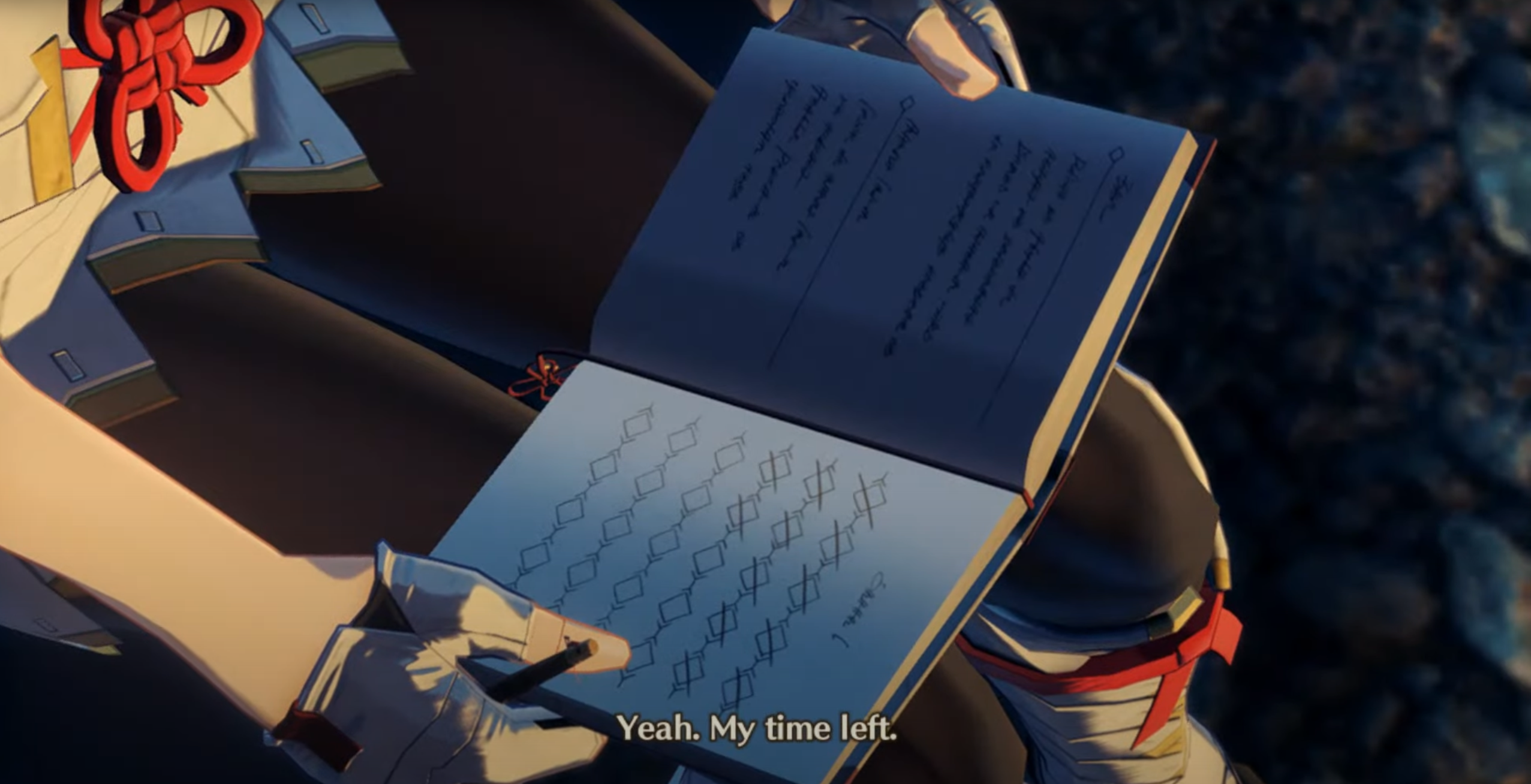
Mio, marking her time left before Homecoming in her diary.
Yet Wittgenstein doubts that even this method of giving S meaning could succeed, for it requires an independent criterion of correctness that doesn’t seem available to the speaker of a private language.[223] She couldn’t avail herself of anything outside of her own private experiences to confirm that she was, in fact, referring to the same sensation each time she wrote ’S’ in her diary, and so there would be no way of justifying her memory as a reliable method of defining that sensation. To look only to one’s memories of a sensation to justify the sign would be like buying several copies of one newspaper to confirm the accuracy of its timetable for train departures:
[J]ustification consists in appealing to an independent authority — “But surely I can appeal from one memory to another. For example, I don’t know if I have remembered the time of departure of a train correctly, and to check it I call to mind how a page of the timetable looked. Isn’t this the same sort of case?” No; for this procedure must now actually call forth the correct memory. If the mental image of the timetable could not itself be tested for correctness, how could it confirm the correctness of the first memory? (As if someone were to buy several copies of today’s morning paper to assure himself that what it said was true.)
Looking up a table in the imagination is no more looking up a table than the image of the result of an imagined experiment is the result of an experiment.[224]
Wittgenstein’s treatment of private language seems to suggest not only that such a private understanding of our experiences is an illusion, but also that we don’t lose anything by letting go of that illusion: everything we’d want out of sensation can be understood in the context of the language-games that we can play with others. As soon as we consider a situation in which a speaker regularly makes mistakes in identifying the same sensation with S yet consistently uses it in conjunction with something publicly accessible and useful—for instance, with the rising of the speaker’s blood pressure, or with “the usual symptoms and presuppositions” of the sensation—it becomes clear that a publicly accessible use just is what it means to put language and meaning to our experiences.[225] There is no conceptual space where we can “even attempt to interpose language between the expression of pain and the pain”;[226] when we tried to do so by stipulating an error in identifying the sensation in the blood-pressure and sensation-behavior cases, we “turned a knob which looked as if it could be used to adjust something in the machine; but it was a mere ornament not connected with the mechanism at all.”[227]
Put as Slogan 4: We can only make sense of our experiences in language that could be used in conversation with others.
In the service of constructing Wittgenstein 2, we’ll also pull out a slogan highlighting a particular step Wittgenstein took to reach the conclusions against the possibility of a private language. Slogan 5: our memories of a sensation aren’t sufficient to justify our naming of that sensation.
§2.1113: No Walks to Infinity without Walking: Series and Rule-Following
Imagine yourself in a math class, where a teacher is describing a mathematical series. The first term in the series is 1.5, and the second term is 2. The teacher asks: What is the 4th term in this series?
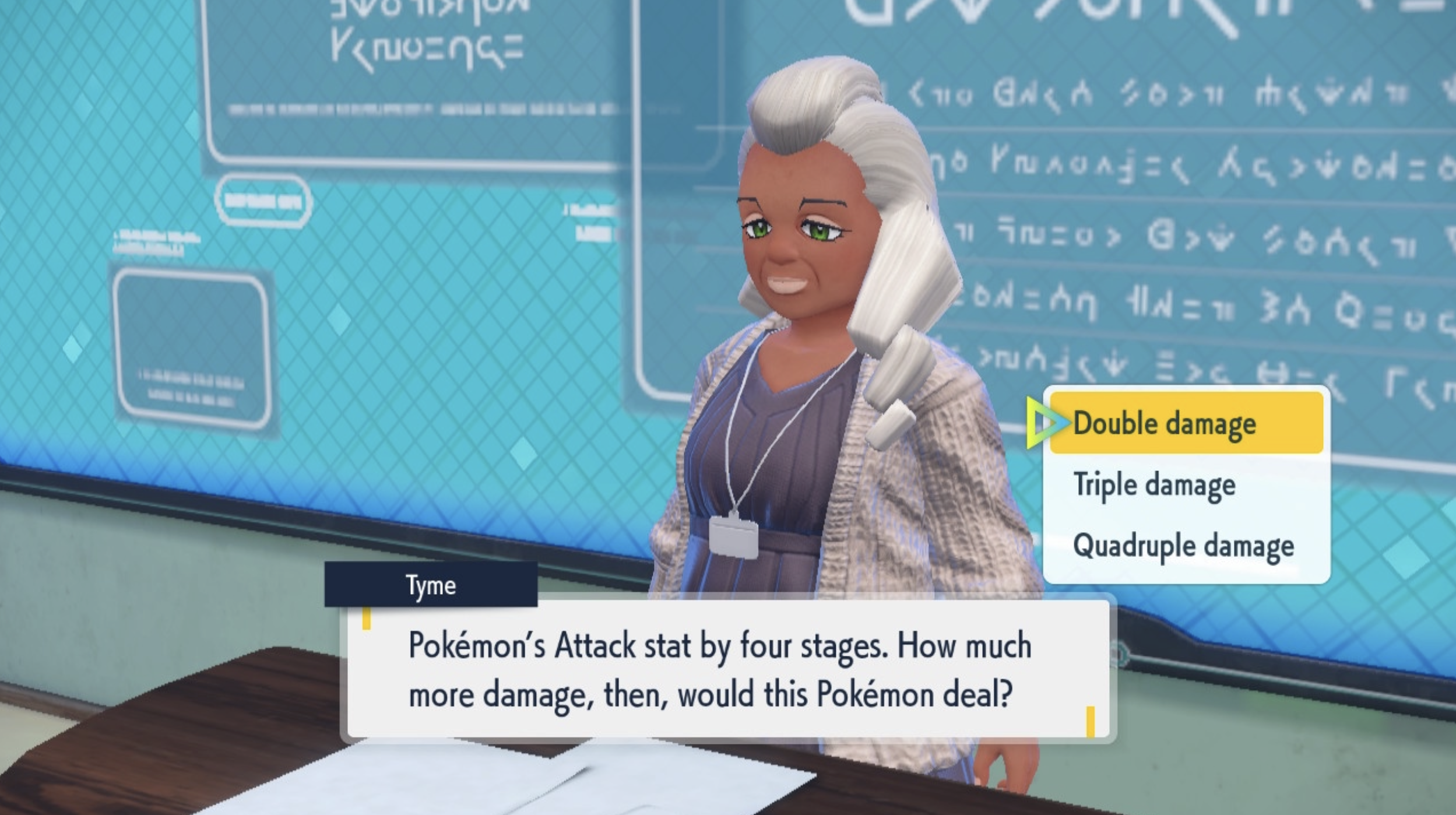
Pokémon Violet’s Professor Tyme, teaching her students about the attack growth stages of Pokémon in battle.
This isn’t an idle question: it’s an abstraction based on a question in the Pokémon math class of Pokémon Violet![228] In her explanation of stages to increases in Pokémon attack value, Professor Tyme explains that increasing a Pokémon’s attack value by 1 stage multiplies the base power of its attacks by 1.5, while increasing it by 2 stages multiplies the base power by 2. She then asks the avatar what multiple a 4-stage increase would grant a Pokémon’s base attack power.
If Wittgenstein were your avatar, he might stubbornly remark that all 3 of Professor Tyme’s different answer options are possible continuations of the series:
- You might think stages of attack increase each added 0.5 to the total attack multiple, in which case a 1-stage increase would be a multiple of 1.5, 2-stage would be 2, and a 4-stage increase would be a multiple of 1.5+0.5*3=3—the second answer option, which is actually how much a 4-stage increase multiplies a Pokémon’s base attack power.
- You might suppose that attack stage increases begin with a multiple of 1.5 and then increase by multiples of (4/3+(2/3)*n), with n=0 for the first such increase, in which case a 1-stage increase would still be a multiple of 1.5, a 2-stage increase would be a multiple of 1.5*(4/3+0)=2, but a 4-stage increase would be 1.5(4/3+4/3)=4, the third answer option.
- You might even suppose that the multiple on a Pokémon’s attack power increases by 0.5 up to the point of doubling that power, at which point the increase caps, in which case a 1-stage increase would be a multiple of 1.5, a 2-stage increase would be a multiple of 2, but a 4-stage increase would be a multiple of 2+0+0=2, the first answer option.
No matter how adamantly Professor Tyme might feel as though she’s made the series’ rule clear, “no course of action could be determined by a rule, because every course of action can be brought into accord with the rule—“ and“if every course of action can be brought into accord with the rule, then it can also be brought into conflict with it.”[229]
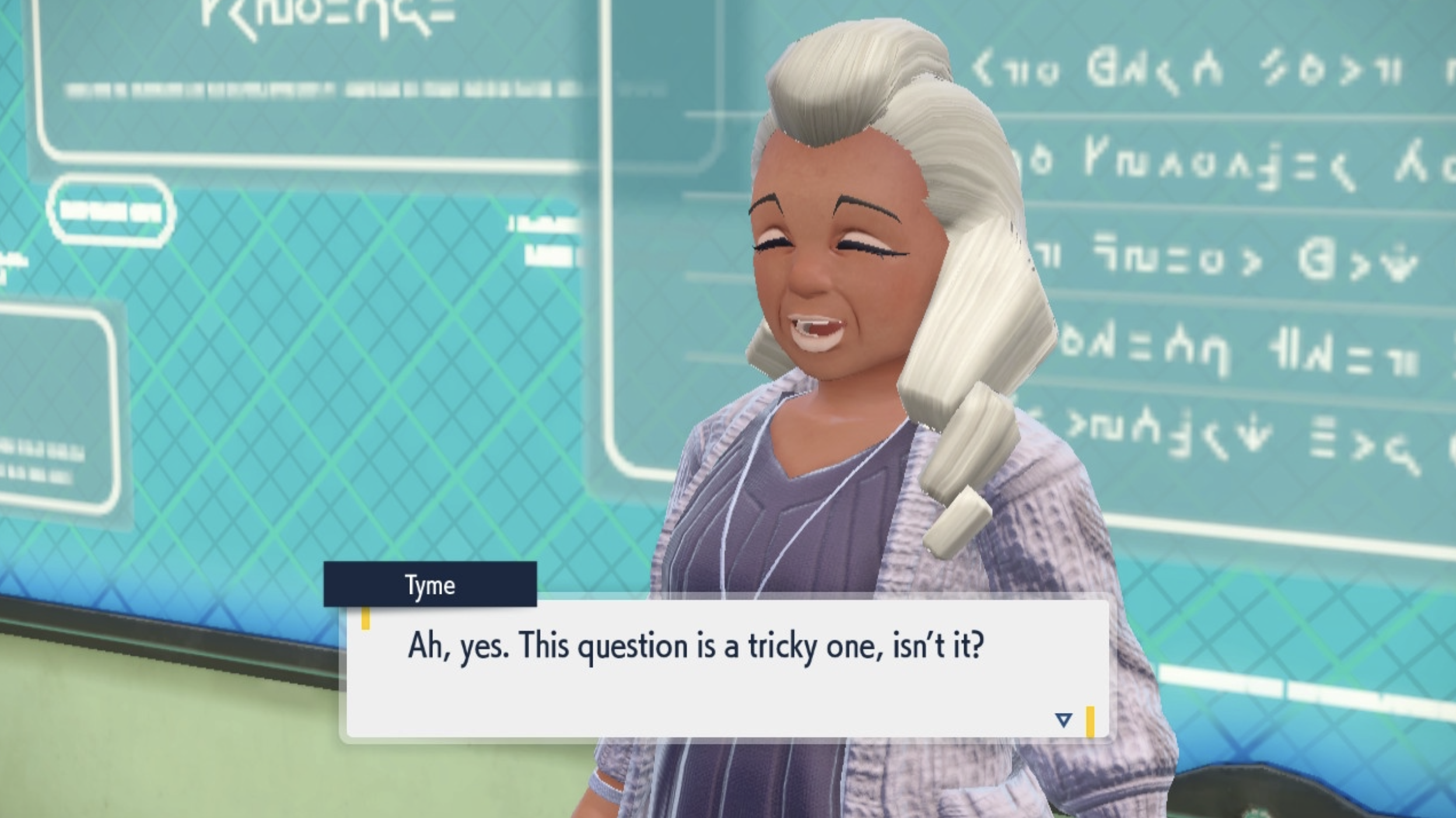
Pokémon Violet’s Professor Tyme, inadvertently echoing Wittgensteinian difficulties with understanding series.
As I read it, Wittgenstein’s point in considering seemingly “deviant” continuations of series like the two “wrong” continuations above[230] isn’t that there’s no way to really learn how to extend a series since anything can be made to look like a continuation of the series.[231] Rather, his point is that seeing ‘following a rule’ like the pursuit of some objective, accessible truth “is a misunderstanding.”[232] Like the impossibility of a private language, it’s not possible for a representation of a series to independently determine and contain all its terms: we think of the way in which we follow a rule, like extending a series, as an interpretation of some essential version of the rule that’s really out there in the world,[233] but “every interpretation hangs in the air together with what it interprets, and cannot give it support. Interpretations themselves do not determine meaning.”[234] Professor Tyme is not transmitting some objective mathematical truth to her students: she is playing a language-game with them in which a right answer only consists in Tyme and the student agreeing that the student followed Tyme’s rule.[235]
Especially in the realm of mathematics, it’s tempting to think of a series as “present[ing] us with one face […] the algebraic one, with a segment of the expansion,” and feel as though the whole series were “already contained” within this face.[236] This face strikes us as the series’ essence in the same way the Tractatus purported to capture the essence of language through a general form of proposition, as though the segment of the expansion were “a visible section of rails laid out to infinity.”[237] The Wittgenstein of the Investigations challenges the notion that this symbolism contains the entire series, in the way that the Wittgenstein of the Tractatus meant ![]() to contain all that could be significantly said or thought: rather, the “symbolical expression was really a mythological description of the use of a rule,” and to act in accordance with the expression is merely to say, with each step taken, that the expression “is my final court of appeal for the way I’m to go.”[238]
to contain all that could be significantly said or thought: rather, the “symbolical expression was really a mythological description of the use of a rule,” and to act in accordance with the expression is merely to say, with each step taken, that the expression “is my final court of appeal for the way I’m to go.”[238]
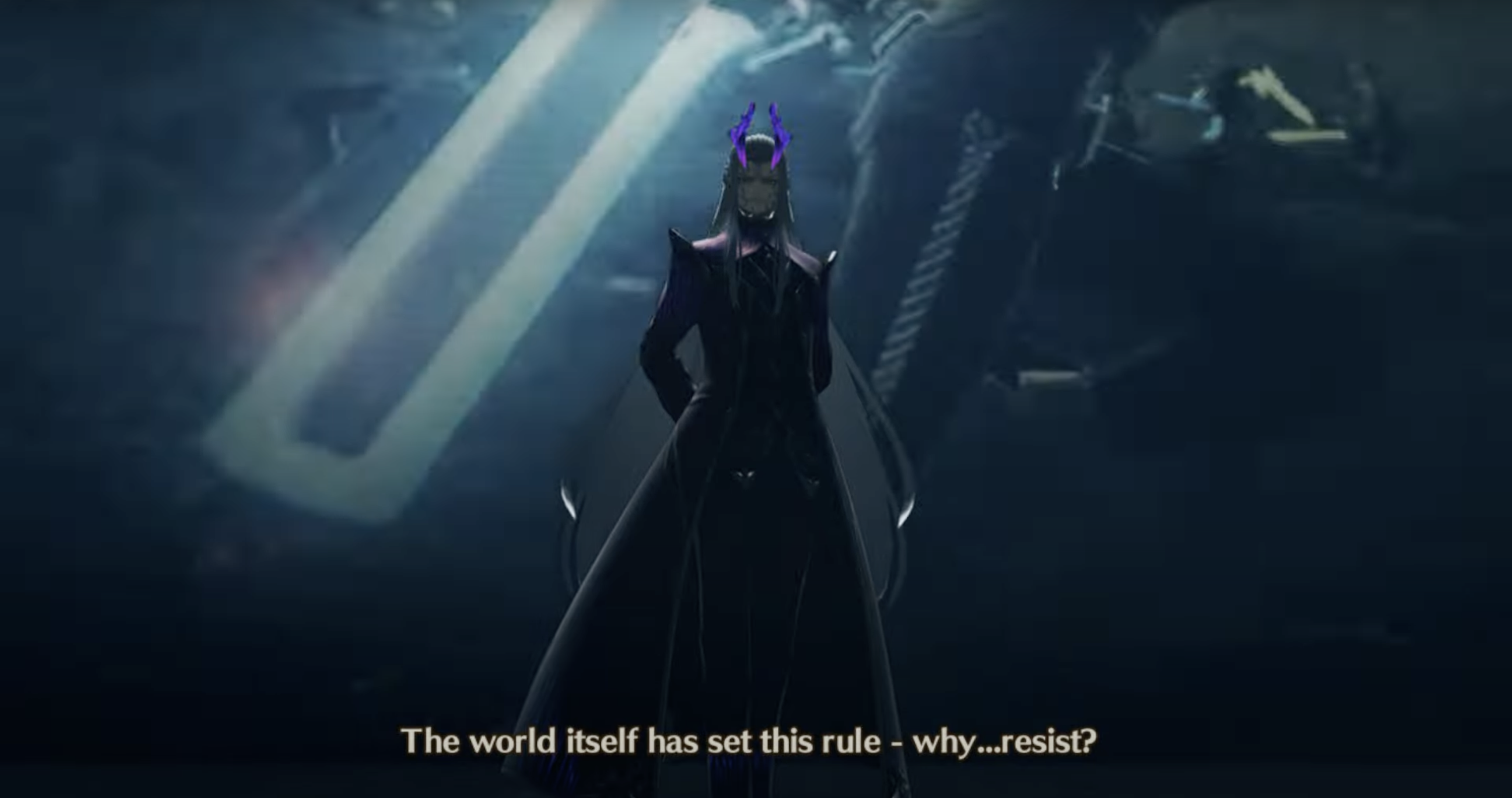
Z asserts the reality of the rule that humans must take lives, after Sena protests that he can’t simply invent a rule to limit everyone’s choice in this way.
The symbolism of a rule is a sort of instruction booklet for those who are already using it in a certain language-game: if you want to make a significant move in the Tractatus’ language-game, then you’ve decided that ![]() is your final court of appeal. This only becomes a problem when we hypostatize such an instruction booklet, taking it to reflect something about reality rather than about a game we can choose to play. Then, an arbitrary picture of the world can hold us captive, tying us in mental knots when it reaches beyond its relevant games to pose illusory problems, like determining whether a given sequence of digits occurs somewhere in π:
is your final court of appeal. This only becomes a problem when we hypostatize such an instruction booklet, taking it to reflect something about reality rather than about a game we can choose to play. Then, an arbitrary picture of the world can hold us captive, tying us in mental knots when it reaches beyond its relevant games to pose illusory problems, like determining whether a given sequence of digits occurs somewhere in π:
“In the infinite expansion of π either the group ‘7777’ occurs, or it does not — there is no third possibility.” That is to say: God sees — but we don’t know. But what does that mean? — We use a picture: the picture of a visible series, the whole of which one person can survey and another can’t. Here the law of excluded middle says: it must look either like this or like that. So really — and this is surely obvious — it says nothing at all, but gives us a picture. And the problem is now supposed to be: does reality accord with the picture or not? And this picture seems to determine what we have to do, what to look for, and how — but it does not, precisely because we do not know how it is to be applied. Here, saying “There is no third possibility” or “There really isn’t a third possibility!” expresses our inability to turn our eyes away from this picture — a picture which looks as if it must already contain both the problem and its solution, while all the time we feel that it is not so.[239]
Enshrining the infinite within our idea of reality misdirects our attention to puzzles that only arise because of a picture’s limitations. We see a certain picture of a rule, a symbolism, and feel as though the symbol shows that all the steps in a series are already taken—but “‘All the steps are really already taken’ means: I no longer have any choice. The rule, once stamped with a particular meaning, traces the lines along which it is to be followed through the whole of space.”[240] Suddenly, a game we might choose to play becomes a game we feel describes our entire world.
When we approach series through the pursuit of something essential, we inadvertently divorce rules from the games and context in which we decide that they will guide our actions—much as the appeal to a private language tries to isolate our sensations from the conversations upon which they depend for meaning. We are able to understand and abide by the rules of series and other language-games not by exercising some ability to grasp what the series is, nor what the teacher really means when she gives example applications of a series, but rather by “agreement in judgements” between those playing the game as to what counts as following the game’s rules.[241]
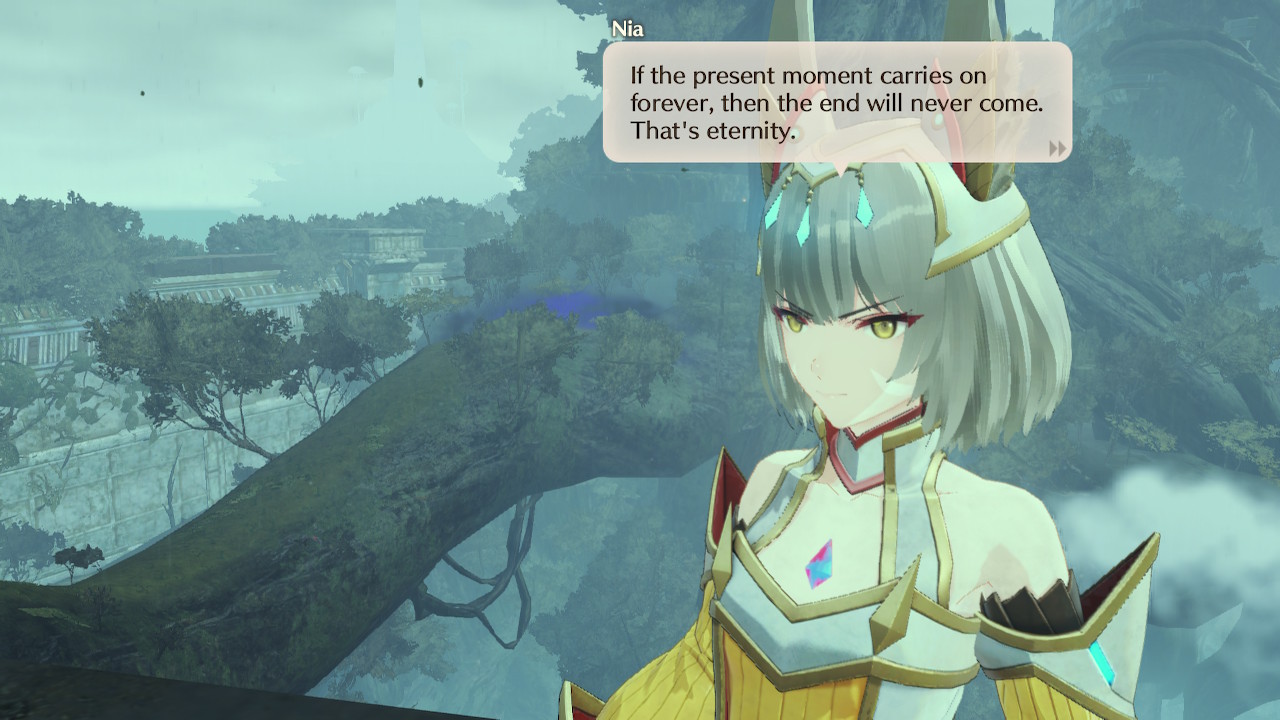
Nia, articulating to Ouroboros the characteristic of eternity as an activity—something that depends on acting in accordance with a given rule again and again—rather than as a state of reality independent of human activity.
Put as Slogan 6: Series and formulae are not representations of reality, but rather descriptions of a rule only to those people who are already following that rule.
And, Slogan 7: The possibility of language-games depends on its players’ agreement about what counts as following its rules.
§2.112: The River-Bed of Thoughts
It’s one thing to say that following a rule depends on agreement in judgments between the players of a language-game, and another thing to show what that agreement consists in. This was the topic that Wittgenstein took up in some of the final written remarks before his death, compiled and published posthumously as On Certainty: a response to Moore’s “Proof of the External World” and “Defence of Common Sense.”[242] Against those who claimed we cannot know anything about the external world, Moore argued that he knows propositions such as “Here is one hand, and here is another,” “The earth existed for a long time before my birth,” and “I have never been far from the earth’s surface”; against Moore, Wittgenstein argued that this was a non-grammatical use of ‘to know’ that would not satisfy external-world skeptics, and he set out to provide his own account of the beliefs within our worldview which we cannot possibly doubt. In so doing, he described the idea of a river-bed of thoughts: those foundational beliefs which must be certain in order to support the possibility of language-games at all, upon which the potential for communication, agreement, and persuasion depend.
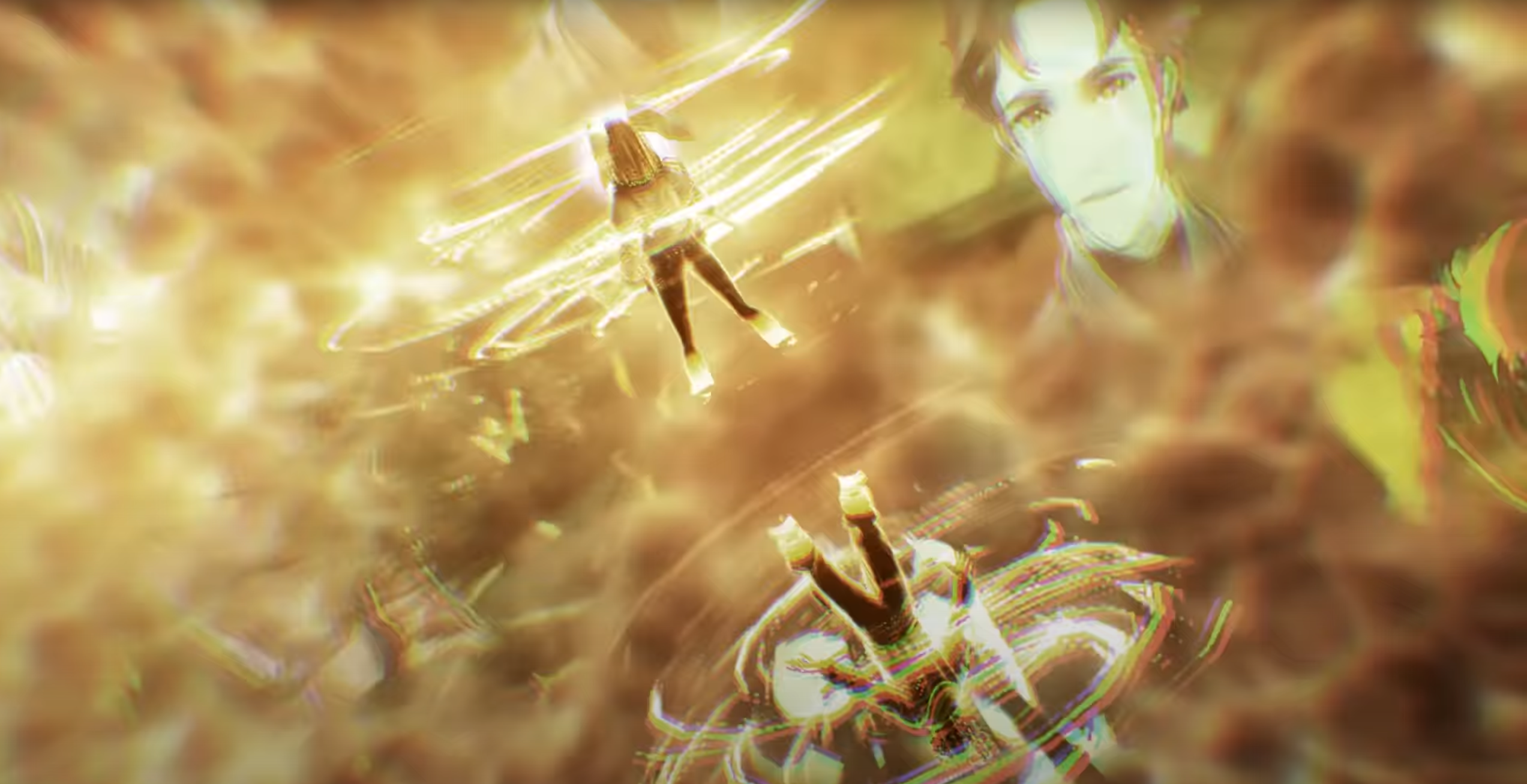
Eunie and Taion, glimpsing pictures of each other’s histories upon Interlinking for the first time.
Wittgenstein describes this river-bed as “a kind of mythology,” a set of propositions that constitute “the inherited background against which I distinguish between true and false.”[243] The game of verifying and doubting propositions doesn’t arise with this background because such a background is the framework that acts as a “whole system of verification,” making truth and falsity meaningful games in the first place.[244] Those empirical propositions which we do verify within such a framework are like the water flowing through our river-bed—not just in the sense that the river-bed shapes how we use those empirical propositions by virtue of embedding them within a context, a “form of life,”[245] but also in the sense that, like water and a river-bed, the relation between one’s framework and propositions open to verification “alter[s] with time, in that fluid propositions hard[en], and hard ones be[come] fluid.”[246]
We acquire this river-bed from our own histories, cultures, and education. As children, we learned many words, and we also learned a wide range of language-games—uses for those words. Just so, we “learnt to judge like this. This is judging. This is how I learned to judge; this I got to know as judgment”—as a game, not as a justification for judging in a particular way.[247] The overall game of judging, “a totality of judgments,” is the framework within which justification, verification, and mistake-making are meaningful games,[248] and this totality can vary based on how we’re raised. A king might be raised to believe that the world was created when he was, and Moore’s certainty that it had been around for much longer might not be the sort of thing that could convince the king otherwise—yet neither the king nor Moore could be said to be making a mistake in these beliefs, for in each case the man’s belief is an element of his riverbed.[249] In a point of biographical similarity, Wittgenstein believed that part of his inability to resolve his disagreement with Alan Turing about the possibility of experimentation in mathematics was “a difference of education” between the two men.[250] In this regard, despite the similarity Wittgenstein notes between the riverbed/water distinction and the Tractatus’ distinction between logical and empirical propositions,[251] On Certainty points back to the idea that the Tractatus is one of many language-games, one of many river-beds, masquerading as the one and only game.
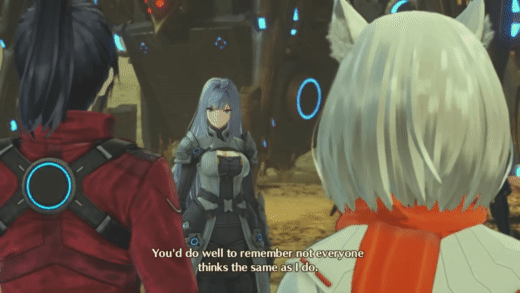
Ethel warning Ouroboros that different Colonies and individuals possess a wide range of worldviews.
As people’s ability to continue a series depends on agreement in judgment, so their ability to overcome disagreements depends on whether and how their river-beds of thoughts differ from each other:
- If my framework disagrees with someone else’s in a way that is apt to be corrected within the same framework—that is, if the disagreement is in some of the looser sediment of the river-bed, and not in its most solidified content—then it is possible to resolve the disagreement by offering evidence that leads me or the other party to abandon the disagreeable sediment, as when we explain to a child in 1950 that someone who’d told her that he had been on the moon had only said so as a joke:[252] in such cases, we can still avail ourselves of “the accustomed context” around the relevant beliefs as support for their meaning.[253]
- In cases of more foundational disagreements in frameworks, we might instead reach a point at which “evidence is facing evidence, and it must be decided which is to give way”[254]—if, for instance, Wittgenstein were transported into the future to NASA in 1969, met Neil Armstrong, and were presented with ample, diverse evidence that someone really had been on the moon. In such a case, Wittgenstein would probably find himself “put into a position in which I could not go on with the old language-game any further. In which I was torn away from the sureness of the game.”[255]
- Yet in other such cases of evidence facing evidence, the fundamental difference in frameworks might finally make it the case that each person involved would look at the other and “not know what such a person would still allow to be counted as evidence and what not,”[256] such as when Wittgenstein observes, “I believe that every human being has two parents; but Catholics believe that Jesus only had a human mother. And other people might believe that there are human beings with no parents, and give no credence to all the contrary evidence.”[257] In such cases of divergent forms of life, one must either “put up with” the fundamental contradiction,[258] or else insist upon “trying to give him our picture of the world […] through a kind of persuasion,”[259] a kind that holds up our framework beyond the point at which reasons and evidence give out.
Formulated as Slogan 8: Our language-games are only possible within the context of frameworks of beliefs about which we are certain, and playing our language games with others is only possible to the extent that we can reconcile our relevant framework with theirs.
§2.113: Ducks, Rabbits, and Other Aspects
What do you see when you look at the drawing below?
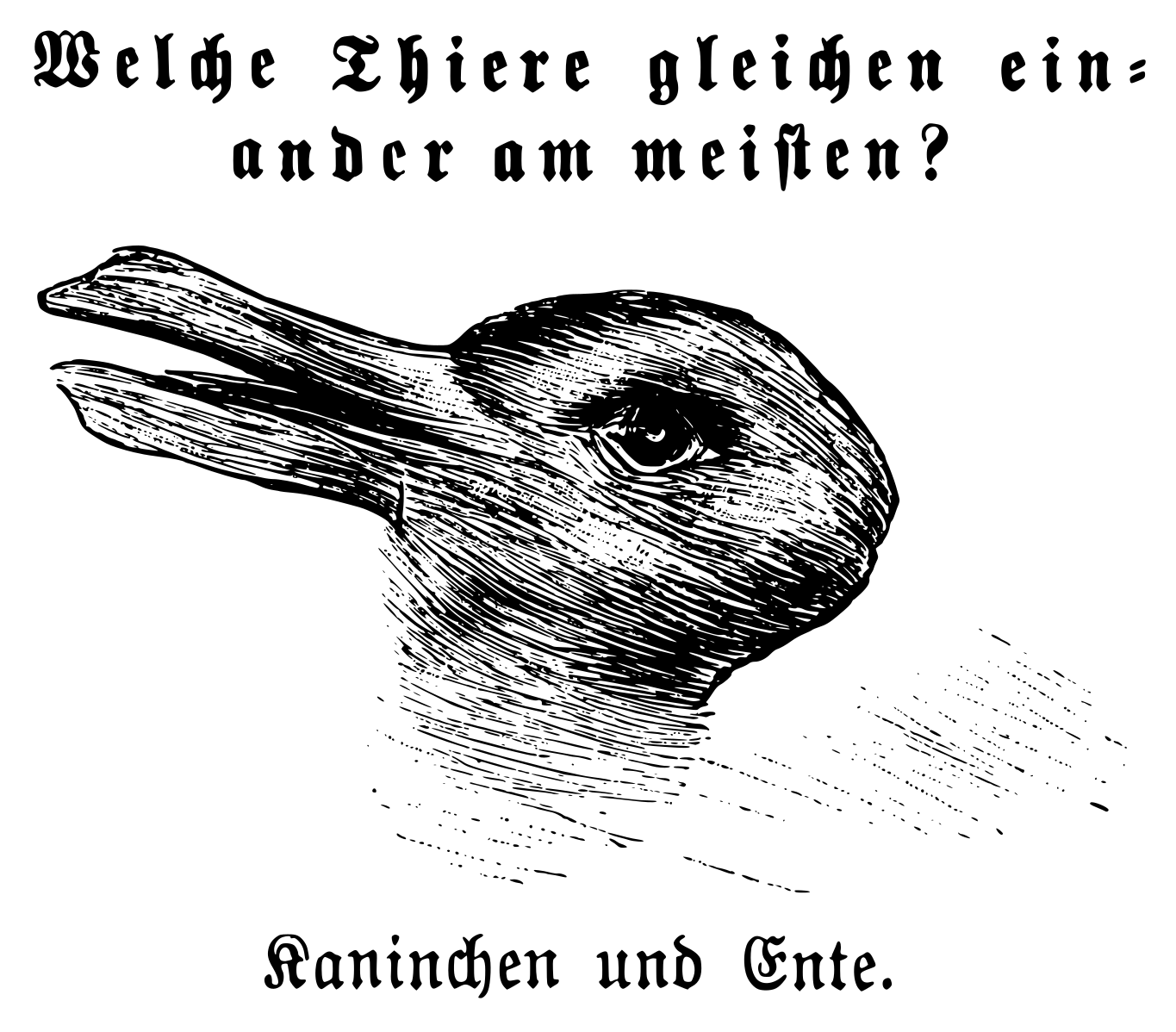
The first known public representation of the duck-rabbit, a drawing from the 10/23/1892 edition of Fliegende Blätter, artist unknown. In old German, the caption reads: “[Top] Which animals are most like each other? {Bottom] Rabbit and duck.” (Source.)
In approaching the duck-rabbit, Wittgenstein distinguished between “two uses of the word ‘see’”: one of simply seeing this, some object, and another one of “noticing an aspect,” a “likeness” between two objects.[261] This latter use of ‘see’, what we can call aspect-seeing, is what Wittgenstein took to be happening in cases like seeing the duck-rabbit as a rabbit. Sometimes we see an aspect of something continuously, yet at other times something’s aspect lights up for us, a kind of recognition that might force us to exclaim “Ah, now it’s a rabbit!” like we might cry when in pain.[262] Still other times, an aspect we’ve been continuously noticing, or one that once lit up for us, might fade away, so that it no longer strikes us in the same way when we see the object.[263]
The puzzlement Wittgenstein seems to tease out in his study of aspect-seeing cases is that the concept of seeing “makes a tangled impression”[264] and needs to be more closely examined before we can clearly understand how aspect-seeing modifies that concept:[265] thus “We find certain things about seeing puzzling, because we do not find the whole business of seeing puzzling enough,”[266] and when we look at aspect-seeing we find that “Many of our concepts [such as looking and thinking] cross here.”[267] “‘Seeing as…’ is not part of perception” because reproducing the shapes and colors of the duck-rabbit is insufficient to show what you “saw-as” (you must also point to a relationship, like “a great variety of pictures of rabbits”), and so the concept “is like seeing, and again not like seeing.”[268] You don’t need to think of an object when you look at it, “but whoever has the visual experience expressed by the exclamation [of an aspect lighting up] is also thinking of what he sees,” which is why the concept “seems half visual experience, half thought.”[269]
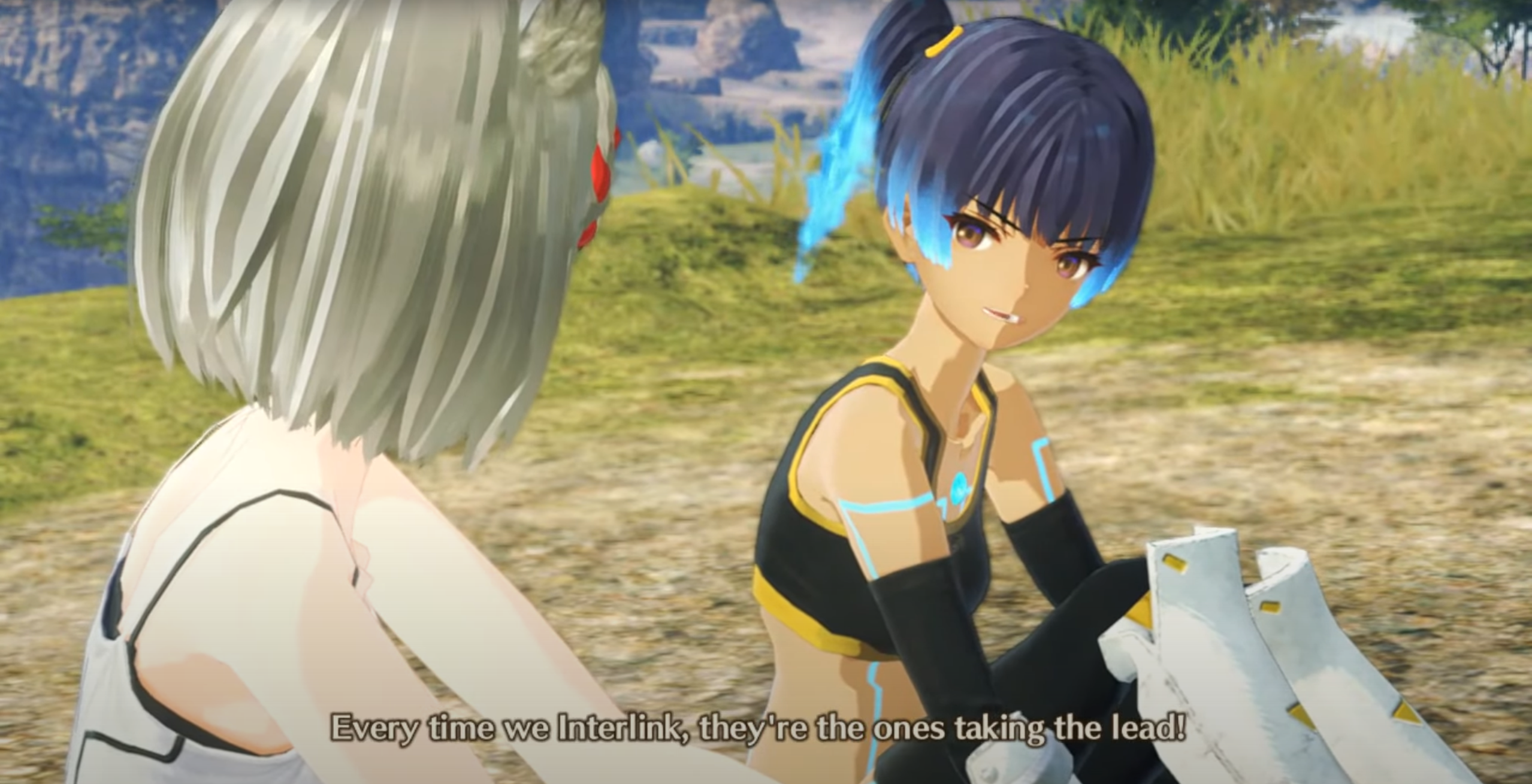
Sena, bemoaning a distinction of aspect in Interlink forms that isn’t yet clear to the player—nor, really, yet clear to Ouroboros.
Wittgenstein apparently puzzled over these issues for years,[270] and their treatment in his posthumously published Philosophy of Psychology—A Fragment (PPF)[271] reads to me more as an exploration of the puzzle than a diffusion of it. It was a pressing puzzle for him because of its challenge to his views against private language: it’s tempting to say that the seeing of the duck-rabbit as a duck (for instance) is an “inner picture,” a “private object” “which I can’t show to anyone.”[272] In diffusing this temptation, he relates aspect-seeing to familiar ground: our river-beds of thought, and what we channel through them.
In describing the tangled impression made by the concept of seeing, Wittgenstein warns us of a danger that is, by now, familiar territory in Wittgenstein 2: “wanting to make fine distinctions […] to explain the concept of a physical object in terms of ‘what is really seen’.”[273] This urge pushes us to hypostatize an internal picture of what we see the duck-rabbit as, where we should instead be looking to the actual language-games in which aspect-seeing is put to use: “The primitive language-game which children are instructed in needs no justification; attempts at justification need to be rejected.”[274] While the PPF is composed of remarks written before those comprising On Certainty, they are almost contemporaneous and share many examples (including Moore’s); this commentary on aspect-seeing as a primitive language-game, then, points to the same river-bed of thoughts, which cannot be assessed for justification because it frames the context within which justification is a meaningful game to play with our experiences of the world. That we aspect-see through a noticing of connections beyond color and extension doesn’t make it private—these can be shared with others just as one’s other thoughts can be shared with others, through organic or contrived language-games[275]—but it does mean that aspect-seeing is susceptible to cultivation and restriction through the traditions in which we were raised, as we saw with the rest of our river-bed. “[C]ustom and upbringing” can lead some to immediately see a style of artwork under a certain interpretation, while that same style conveys no immediate aspect-seeing to a different person;[276] while we may come to learn about the interpretations under which others see certain things, there may be cases in which their traditions are so “entirely strange” to us that “We can’t find our feet with them,” can’t see the aspects under which they see things.[277]
Where On Certainty showed us how traditions can shape our river-beds in matters such as interpreting what constitutes evidence for empirical propositions about the world, aspect-seeing shows us how to extend that concept of epistemic bedrock to other domains where we might naturally think of interpretation as a key measure of one’s experience. Wittgenstein notices how conversations around art and music feature sentences such as, “‘You have to see it like this, this is how it is meant’; ‘When you see it like this, you see where it goes wrong’; ‘You have to hear these bars as an introduction’; ‘You must listen out for this key’; ‘You must phrase it like this’ (which can refer to hearing as well as to playing).”[278] He identifies hearing the correct tempo of a musical piece, after several different tempos have been offered, with the lighting up of an aspect: “‘Now at last it’s a dance’. — In this tone of voice the lighting up of an aspect is also expressed.”[279]
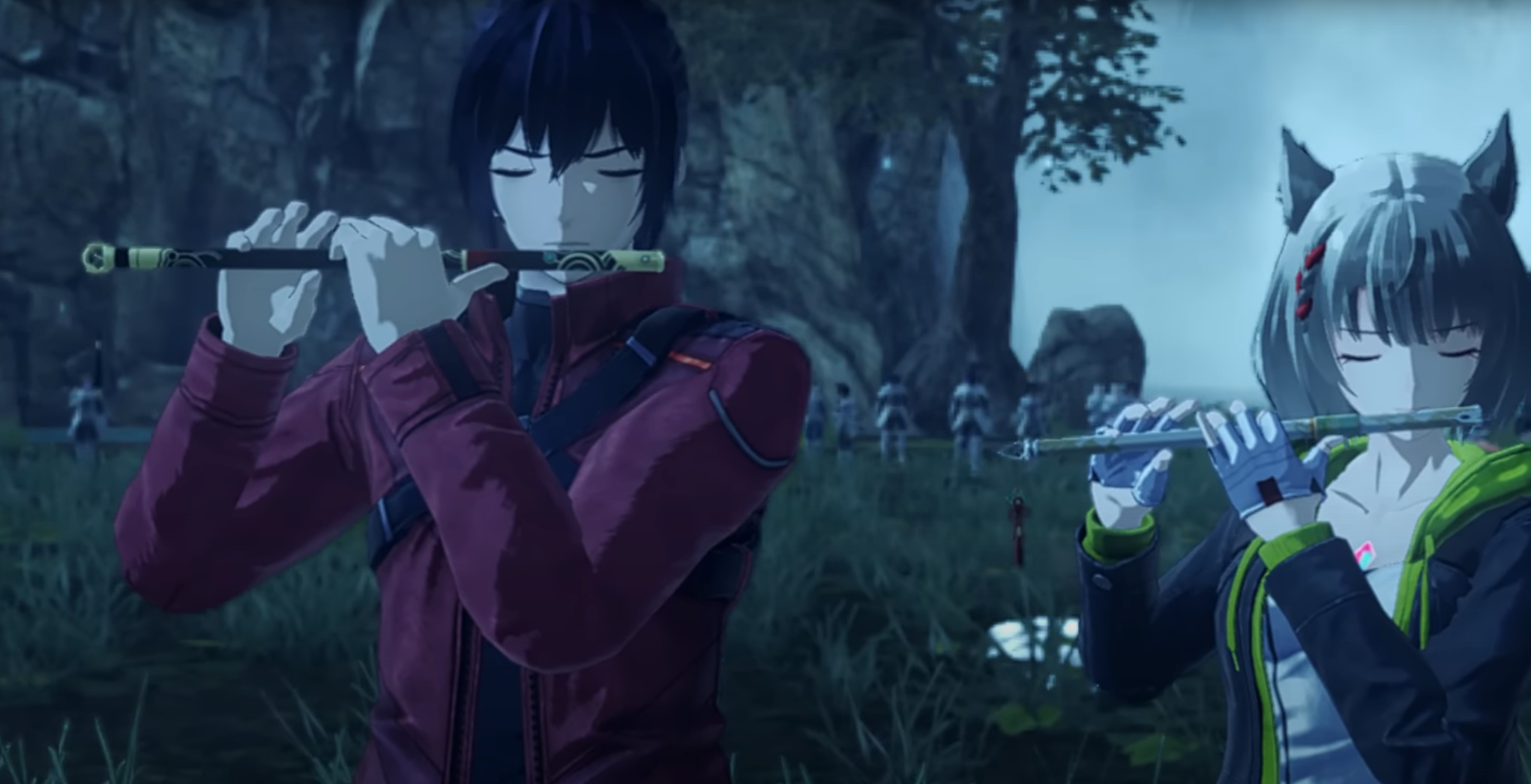
Noah and Mio, seeing off Joran’s mudpuppets after the events outside Colony Lambda.
Wittgenstein also imagines what would be lost by someone who was aspect-blind, lacking the ability to see something as something:[280] it would be “akin to the lack of a ‘musical ear’,” deaf to the interpretations which seeing-through-connections affords us. As with the primacy of use in language-games, the final measure of seeing something’s aspect is what can do with it, “‘knowing one’s way about’” the thing in a way that’s only possible by treating it with that aspect;[281] it is under this aspect that aspect-seeing can be taken as a form of empowerment, affording people new choices in the world as they see that world through the lenses of new “forms of life.”[282] A sadder corollary is how enervating and paralyzing it would be to find oneself without that freedom.
Put as Slogan 9: Our frameworks of beliefs empower us to see and act upon the world in new ways, and to share that agency with others.
§2.114: Philosophy as Therapy: The Choose-Your-Own-Adventure Tour Guide for Your Hometown
Imagine that you’ve lived in a single city for your entire life. You’ve had a family there, had jobs there, undertaken projects there, but you’ve done it all on a kind of “autopilot” going through the motions without ever really taking the place in. (A relationship, perhaps, like those in Colony 9 had with their home before Ouroboros freed them from their Flame Clock.) You’re approached by a wiry, haggard Austrian who eagerly offers to show you around your own hometown: “You’ve never really seen it through the fog of your daily routine,” he insists, “though it was right in front of you all along. When we’re done, you will feel so much more peace in carrying about your life here.”
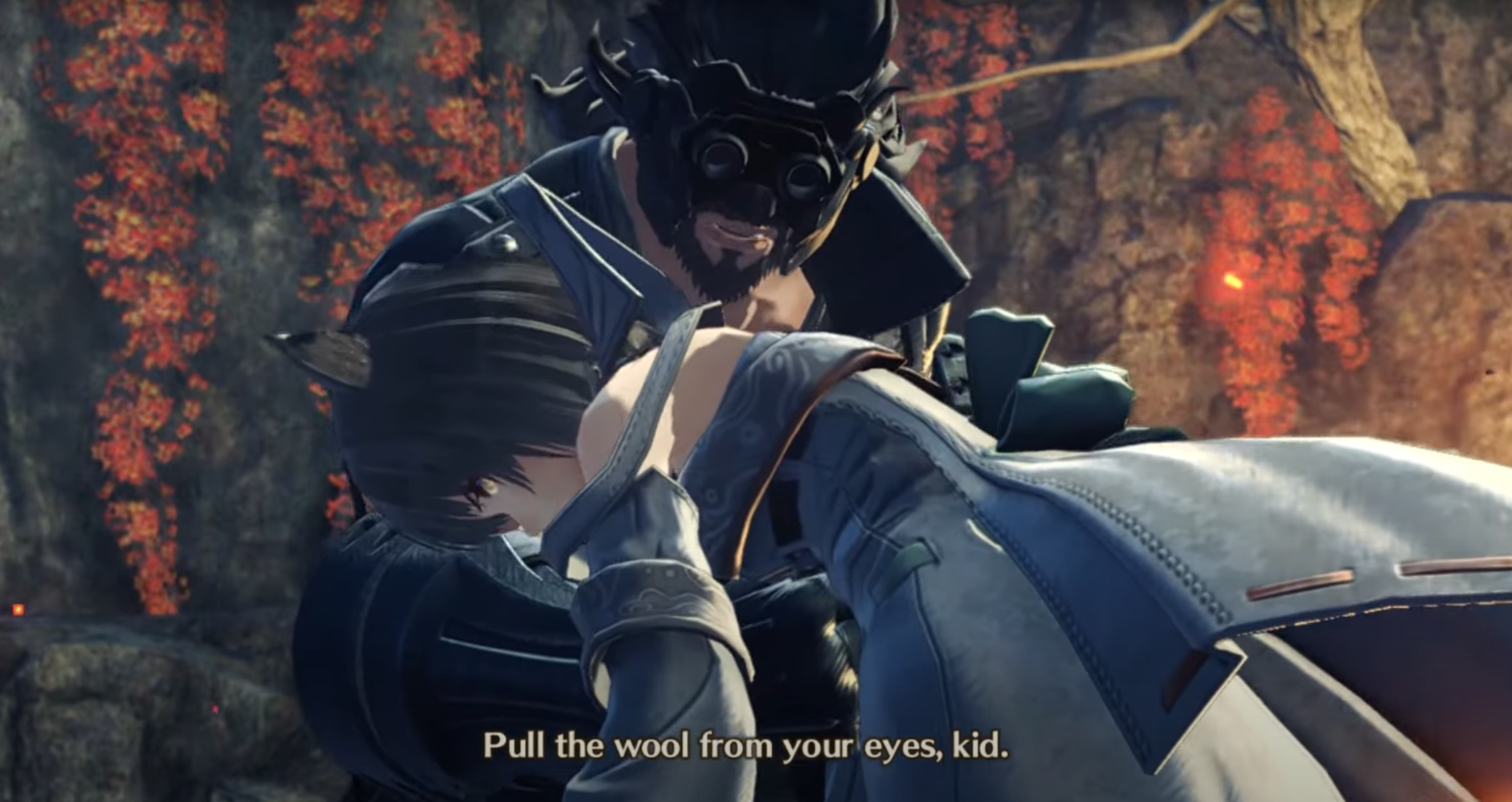
He’s not exactly wiry or Austrian, but Guernica Vandham is otherwise a strong model for showing someone what’s right in front of them.
The Wittgenstein of language-games and aspect-seeing is like this: he shows you how to get around in a city you don’t really know even if you ought to, bringing you on “many journeys through the city, in all sorts of directions,” until you reach a point at which “we shall have passed through any given street a number of times — each time traversing the street as part of a different journey.”[283] It’s in this spirit that the Philosophical Investigations “travel criss-cross in every direction over a wide field of thought,”[284] and it’s for this reason that the treatment of philosophical views relevant to Wittgenstein 2 carries us over a wider field than those relevant to Wittgenstein 1: for over a decade,[285] Wittgenstein labored over the structure, wording, and arrangement of the Philosophical Investigations in pursuit of showing himself and his readers diversity where the Tractatus saw uniformity.
This later Wittgenstein saw the views of the Tractatus and others as presenting “the order [in our knowledge of the use of language],”[286] and in the process wrenching concepts away from their actual uses in favor of grasping an inert and useless “essence” of those things.[287] Wittgenstein’s tours bring those words “back from their metaphysical to everyday use,”[288] presenting “an overview of the use of our words”[289] that “leaves everything as it is,”[290] showing that the philosophical problems that captivate us are really an “entanglement from our rules” of different games we play with language.[291]

Noah, throwing away the sword.
The release from these problems is therapeutic, giving philosophy “peace” by replacing a self-undermining method with methods, or “different therapies,” of drawing connections with series of examples—series which I can break off “when I want to.”[292] In this way, the methodology of Wittgenstein 2 is similar to, yet deeply different from, the Tractatus’ service as a ladder which one must kick down after climbing: both aim to relieve philosophers’ tensions in a way that allows them to move beyond the method itself, but the Tractatus does so by advocating the one way to “[see] the world rightly,” a way that abstracts language away from virtually any particularities of use;[293] Wittgenstein 2, rather, gives us therapeutic tools with which to attend to the uses of language that are “always before one’s eyes,”[294] to the range of forms of life in the context of which language-games have meaning. It provides us with a paradigm for choosing our own adventures, so to speak, within our hometown, bringing us closer to the uses of language with a method that, far from being self-undermining, encourages us to put it down, go out, and actually use language when we want to.
Wittgenstein himself, I think, captured this very distinction in an early draft of a foreword for his Philosophical Remarks:
I might say: if the place I want to reach could only be climbed up to by a ladder, I would give up trying to get there. For the place to which I really have to go is one that I must actually be at already.
Anything that can be reached with a ladder does not interest me.[295]
Putting another way for our language-game of studying Xenoblade Chronicles 3’s heroes, we can formulate Slogan 10: Attending to the diversity of use in language diffuses the puzzles that hinder our ability to enjoy those many uses.
Where Wittgenstein 1 is a hammer that sees a world of nails, Wittgenstein 2 points out that Wittgenstein 1 is a hammer, and that the world offers a fully-loaded toolkit, each member of that kit useful.
§2.12: A Fully-Loaded Toolkit of Interpretations
Once our grip on the hammer relaxes, we can set it aside and explore the range of tools available to us. The more diversity we encounter, the easier it is to move from a worldview purely focused on explaining natural phenomena, to one that celebrates interpretive schemata as language-games: approaches to domains as far-flung as psychology, aesthetics, and religion that prioritize what the domains can accomplish for those embedded within them.
§2.121: Interpretations as Tools for Understanding Our Lives
Wittgenstein saw a resonance between his therapeutic approach to philosophy and Sigmund Freud’s psychoanalytic approach to dreams.[296] Both, in Wittgenstein’s view, are “reproductive” in the sense of inventing “new comparisons” rather than original lines of thought.[297] Through psychoanalysis’ approach of reading dreams through analogy, the dream finds its content reconfigured:
You might think of it as performed on the stage, with a plot that is sometimes fairly incomprehensible but also in part quite comprehensible, or at least apparently so, & as though this plot were then torn into little pieces & each part given a completely different meaning. […]
Now I could imagine that someone […] might exclaim “Yes, that is the solution, that is what I dreamed, but without gaps & distortions.” It would then be this acknowledgement that made this solution the solution. Just as, if you are searching for a word while writing & then say: “That’s it, that says what I wanted to say!” — Your acknowledgement stamps the word as having been found, i.e. the one you were looking for. […]
What is intriguing about a dream, is not its causal connection with events in my life, etc., but rather this, that it affects us like part of a story, & indeed a very vivid part, the rest lying in darkness.[298]
Wittgenstein seemed to believe that Freud’s work on dream-interpretation, both in its successes and shortcomings, captured something important about the relationship between interpretations and language. We can see that there is “a certain resemblance to the signs of a language” in dreams, in the sense that dreams, and even artworks organized like a dream, “call for an interpretation,” that they mean something like our words do, if only the dream were “fitted into a context in which it ceases to be puzzling.”[299] As with following rules and seeing aspects in accordance with our river-beds of thoughts, in the interpretation of dream content, our agreement with the interpretation may be the final court of appeal for the interpretation’s fitness: once you see some of the content in a light that dissolves your sense of a puzzling symbolism, “there may be no ground for saying that there must be an interpretation of the whole thing or of every detail with it on similar lines.”[300] Freud’s mistake, in Wittgenstein’s eyes, was the mistake of the Tractatus and other philosophers in the scientific tradition: “He wanted to find the essence of dreaming,” and therefore took his theory of dream-interpretation to be a scientific explanation of the causes behind dream content rather than one game that can be played, one play that can be enacted through agreement between analyst and patient.[301] Freud was not so much pointing to new physical phenomena as he was proposing a new language-game.
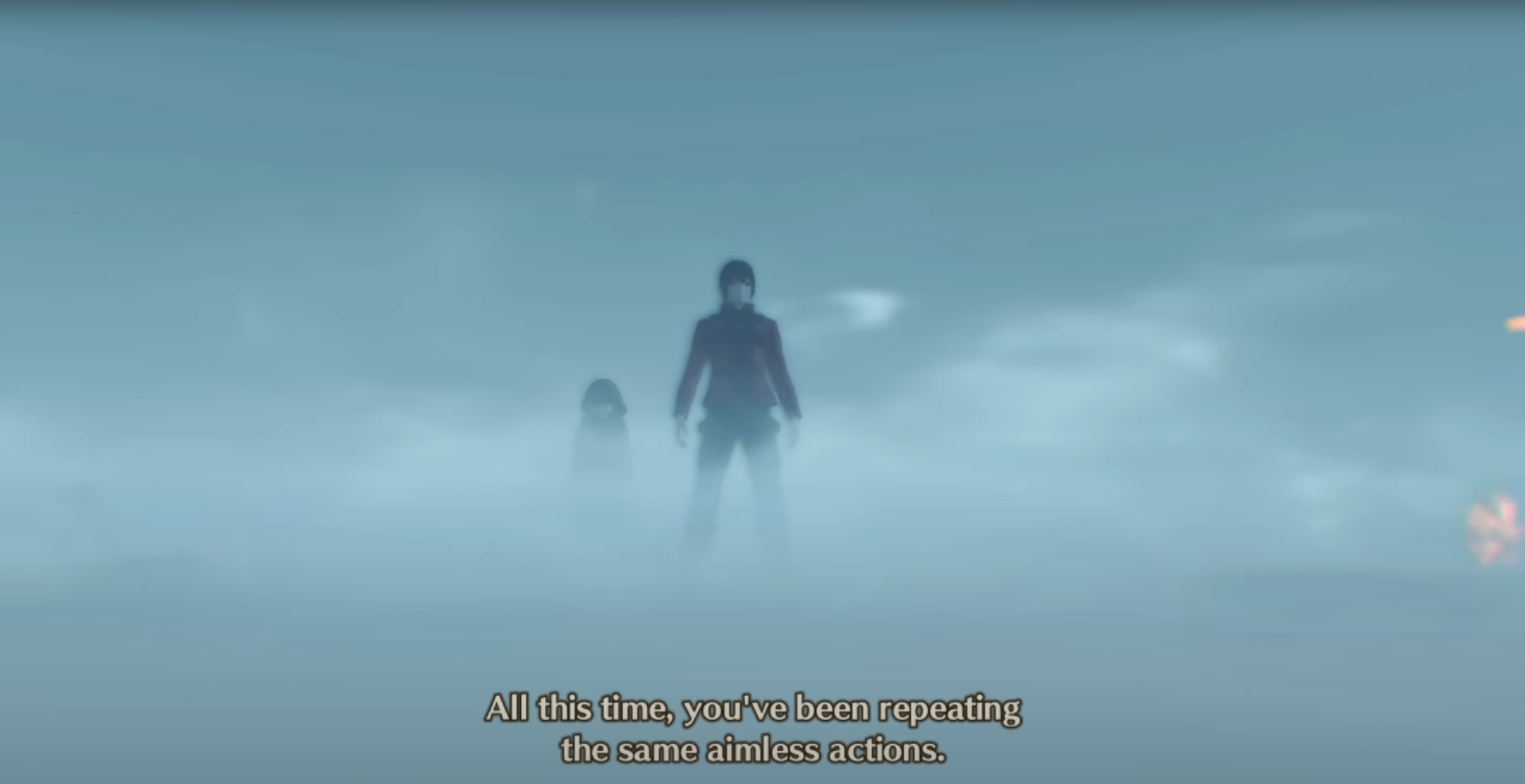
Noah, working through his experiences in a sort of dreamscape following N’s attempted execution of him: what Wittgenstein called one of Freud’s “mythological explanations,” “that this is all a repetition of something that has happened before.[302]
Shakespeare & the dream. A dream is all wrong, absurd, composite, & yet completely right: in this strange concoction it makes an impression. Why? I don’t know. And if Shakespeare is great, as he is said to be, then we must be able to say of him: Everything is wrong, things aren’t like that — & is all the same completely right according to a law of its own.
It could be put like this too: If Shakespeare is great, then he can be so only in the whole corpus of his plays, which create their own language & world. So he is completely unrealistic. (Like the dream.)[303]
In Shakespeare, Wittgenstein saw someone who created a world as context, “laws,” to justify his language-games, with their own similes and internal structure distinct from those found in other forms of life.[304] Yet these were language-games Wittgenstein found himself unable to use, only left to “stare in wonder” at the playwright.[305] Juxtaposed with Freud’s dream-logic, the dream-logic of Shakespeare shows how personally Wittgenstein experienced aspect-blindness: as Monk notes,[306] Wittgenstein had a general dislike of English culture, which may go some way toward explaining his observation, amidst his thoughts about Shakespeare, that “in order to enjoy a poet, you have to like the culture to which he belongs as well. If you are indifferent to this or repelled by it, your admiration cools off.”[307] Freud, by contrast, was born into the same, disillusioned, pre-war Austria as Wittgenstein was.
As much as one may want to play the interpretive game offered by a particular thinker or artist to unravel the puzzles of one’s own life, then, we butt up again a limit in the surmountable difference between our own upbringing and that of the creator. “If a lion could talk”—or, indeed, if it could design a language-game—“we wouldn’t be able to understand it.”[308]
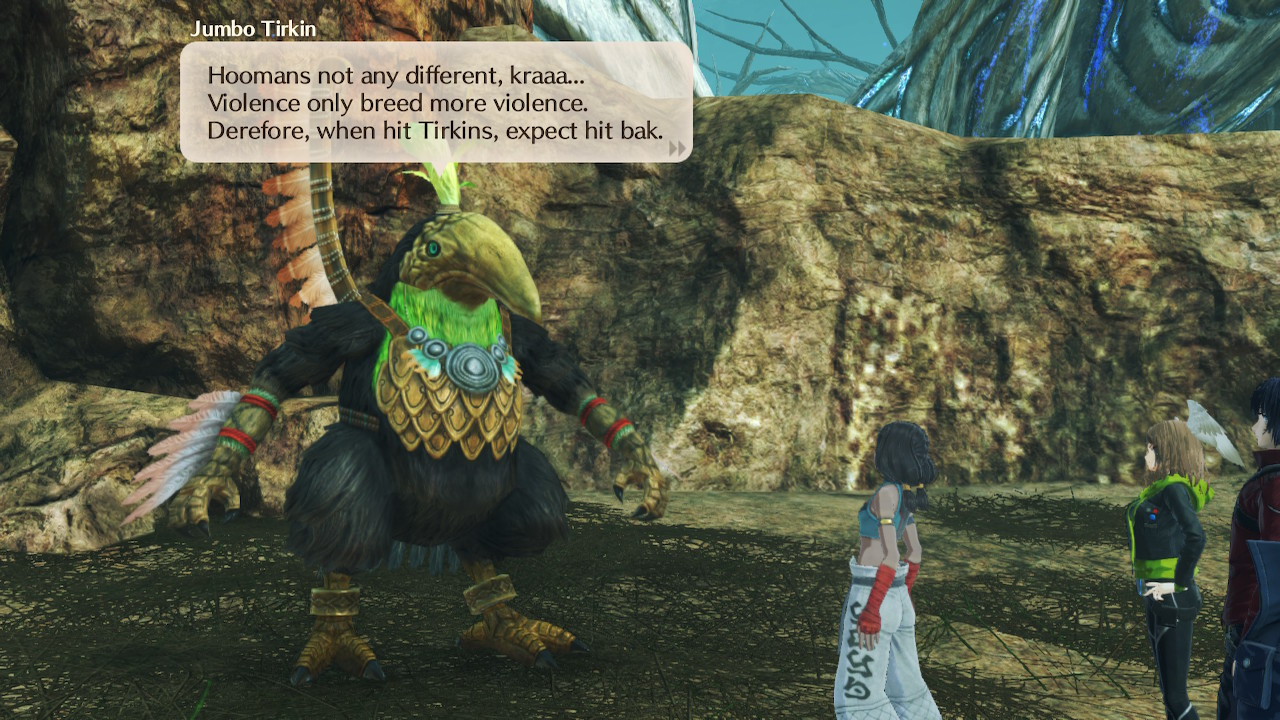
“Well…”
And one may very much want to access those worlds, for artists can do something deeply attractive that we can’t easily find otherwise: they can create sub specie aeternitatis representations of the world and our place in it.
Nothing could be more remarkable than seeing someone who thinks himself unobserved engaged in some quite simple everyday activity. Let’s imagine a theatre, the curtain goes up & and we see someone alone in his room walking up and down, lighting a cigarette, seating himself etc. so that suddenly we are observing a human being from outside in a way that ordinarily we can never observe ourselves; as if we were watching a chapter from a biography with our own eyes, — surely this would be at once uncanny and wonderful. More wonderful than anything that a playwright could cause to be acted or spoken on the stage. We should be seeing life itself. — But then we do see this every day & it makes not the slightest impression on us! True enough, but we do not see it from that point of view. — Similarly when [Engelmann] looks at his writings and finds them splendid […] he is seeing his life as God’s work of art, & and as such it is certainly worth contemplating, as is every life & everything whatever. But only the artist can represent the individual thing so that it appears to us as a work of art; those manuscripts rightly lose their value if we contemplate them singly & in any case without prejudice, i.e. without being enthusiastic about them in advance. The work of art compels us — as one might say — to see it in the right perspective, but without art the object is a piece of nature like any other & the fact that we may exalt it through our enthusiasm does not give anyone the right to display it to us.[309]
The theater Wittgenstein imagines puts one in mind of the “visual room” he explicated in his treatment against private language, and of Wittgenstein 1’s self-defeating desire to seize the world in toto within a single picture that forbids uttering anything about it under that description.
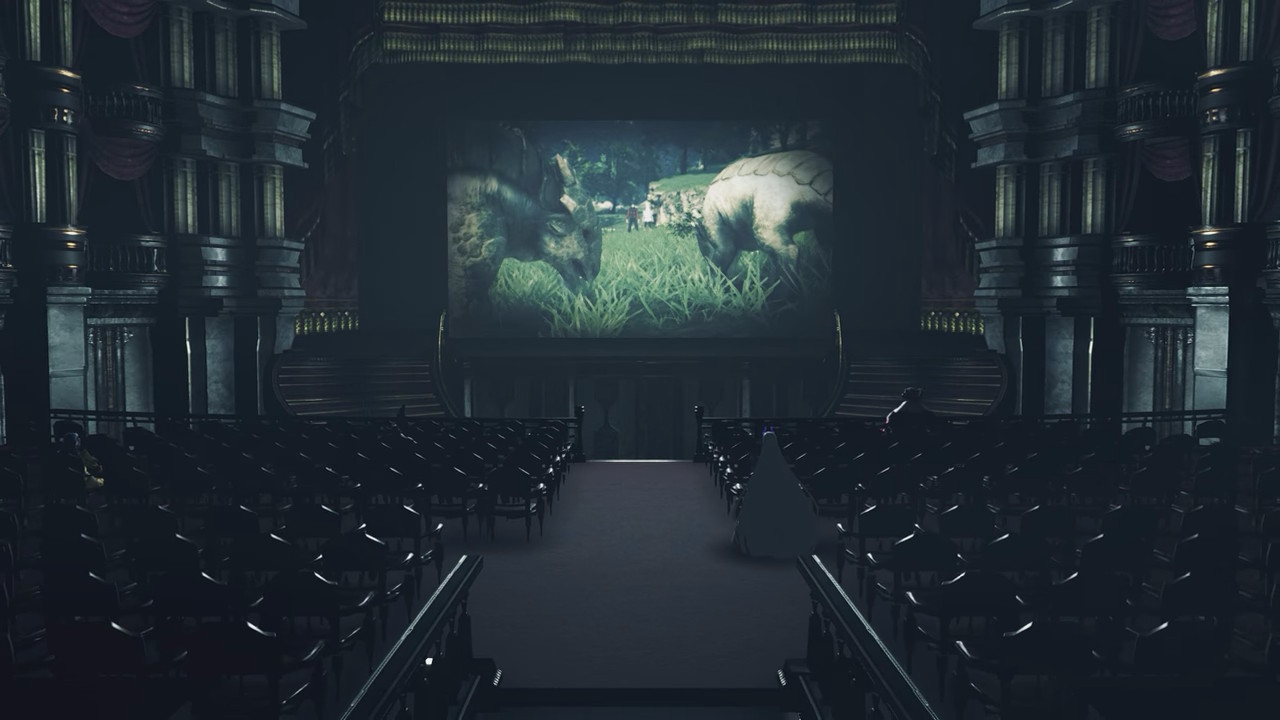
“As if we were watching a chapter from a biography with our own eyes.”
Wittgenstein’s reflections here recognize the limitations of such a perspective: yes, it may produce a wonderful experience in it to consider our place in the world as part of a story, but only through a certain perspective can that consideration yield that experience: it must be a way of interpreting our own experiences. If not—if we try to treat such an interpretation as an aspect of our lives to share with others—then we fall into the trap of trying to show others an aspect of our experiences which they don’t share the right background with us to access, like Wittgenstein with Shakespeare, or the king with Moore. This is why the elevation of one’s ordinary experience, interpreted as a work of art for the public, becomes charmless; this is why “we contemplate the dream picture with inspiration,” but “if we tell the dream to someone else, the picture usually does not inspire him.”[310]
As the connection with dream language suggests, the Wittgenstein of these meditations doesn’t see artistic representation as the only way to access this mode of interpreting one’s place in the world, even if there is something intrinsically artistic about one who interprets it as such:
But now it seems to me too that besides the work of the artist there is another through which the world may be captured sub specie aeterni. It is — as I believe — the way of thought which as it were flies above the world and leaves it the way it is, contemplating it from above in its flight.[311]
One almost wants to add to the end of this the simple declaration of the Tractatus: “it is the mystical.”[312] Yet the Wittgenstein of 1930 who contemplates the man “seeing his life as God’s work of art” strikes me as importantly different than the mystic of the Tractatus: where the Tractatus saw only one game through which you could make meaning out of language and therefore pointed to the mystical in a way that could not touch what it most wanted to, this Wittgenstein contemplates the mystical by leaving the world as it is, echoing the Investigations’ ethos of surveying the connections throughout the actual use of language, leaving everything as it is[313]—seeking the mystical in forms of life, rather than as something superordinate to the one and only form of proposition. In so doing, the new line of thought frees itself from Wittgenstein 1’s impulse to be both playwright and actor in his imagined theater, expressing the mystical while simultaneously acting in an empirically oriented worldview that demands quietism toward the mystical. Rather than embodying a paradox, the person acting in this use-oriented reading of the mystical can seek out the forms of life conducive to interpretations, like artistic representation or psychoanalysis, that use language to show her her own life experiences sub specie aeternitatis.
Framed as Slogan 11: An interpretative language-game highlighting aspects of our experiences, used within a particular form of life, can bring about new understanding of our place in the world sub specie aeternitatis.
§2.122: Absolute Safety: Interpreting the Believer’s Relationship with God
At this point, we find ourselves with a pressing challenge. We saw that Wittgenstein 1 sought to capture the world within its paradoxical house of cards in order to secure a sense of comfort in the face of emotional solipsism. If we’re now saying that the mystical comes from acts that maintain separation between actor and playwright, the person living life and the person offering interpretations of that life, how are we supposed to find any escape from the despair and emotional isolation that defines Wittgenstein 1? Especially in the case of the religious salvation Wittgenstein sought—where God, the “playwright,” can’t speak back in the way a psychoanalyst can—how is this new perspective a panacea for any of the pain that the mystical purports to soothe?
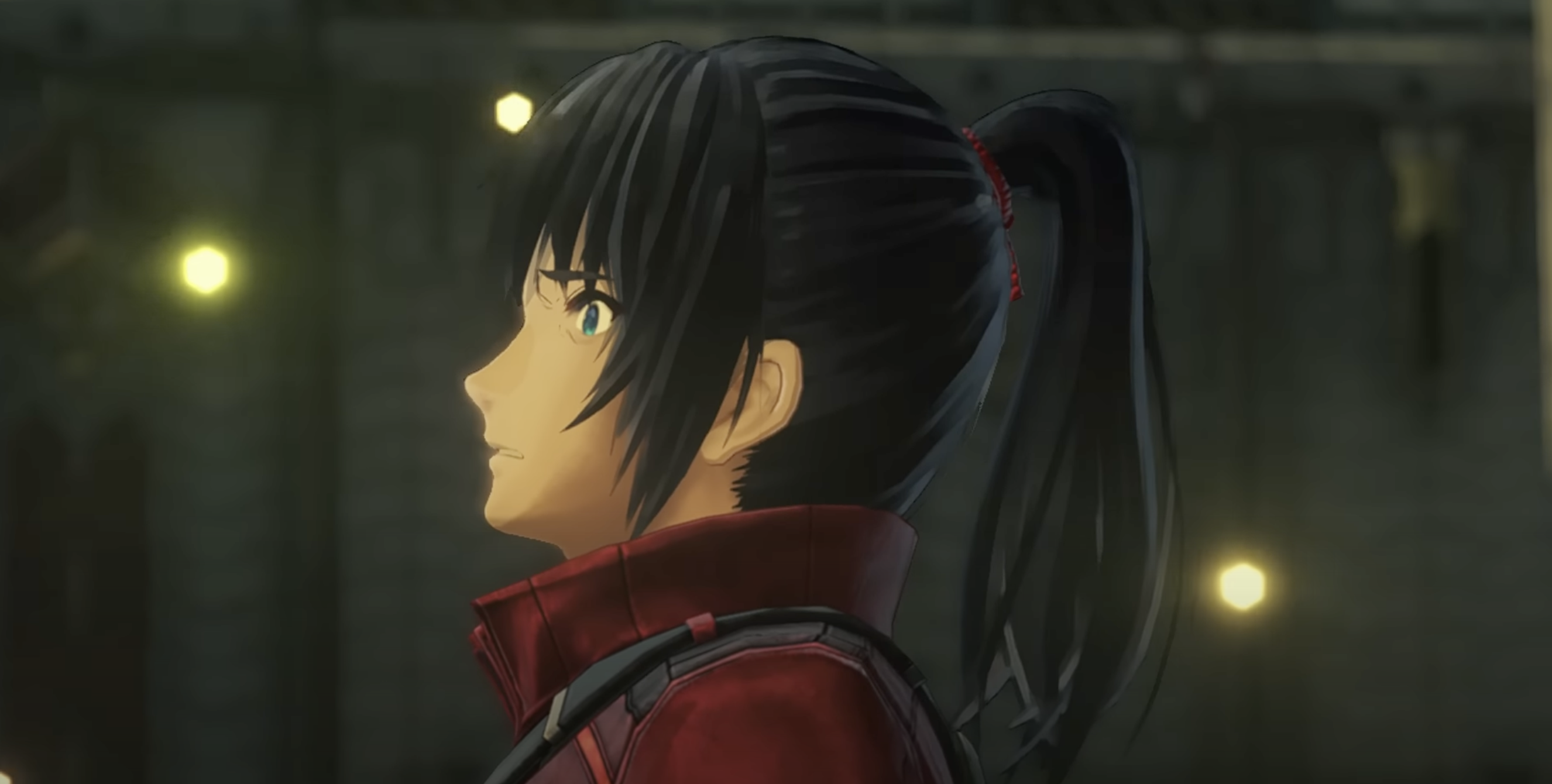
Noah’s acute despair upon watching what he believes to be the execution of Mio.
We can find the answer in another face of Wittgenstein’s religious thinking: the idea of the religious feeling as one of absolute safety. Biographically, as Norman Malcolm tells it in his Memoir, a version of the idea first resonated with Wittgenstein in a Viennese play he saw when he was 21 years old or so:
[O]ne of the characters expressed the thought that no matter what happened in the world, nothing bad could happen to him—he was independent of fate and circumstances. Wittgenstein was struck by this stoic thought; for the first time he saw the possibility of religion.[314]
Wittgenstein described the idea in a 1929 Cambridge lecture as “the state of mind in which one is inclined to say ‘I am safe, nothing can injure me whatever happens’.”[315] This is a kind of safety that misuses the word ‘safety’ as we’d find it in ordinary contexts because it describes a kind of protection that isn’t sensitive to the physical world or things that might happen to you at all: instead, it expresses a safety that’s somehow indifferent to the events of the world altogether.[316] But Wittgenstein recognizes that there are other games, about allegory rather than the physical world, that people will sometimes play through religious and ethical language: for instance, “the experience of absolute safety has been described by saying that we feel safe in the hands of God.”[317]
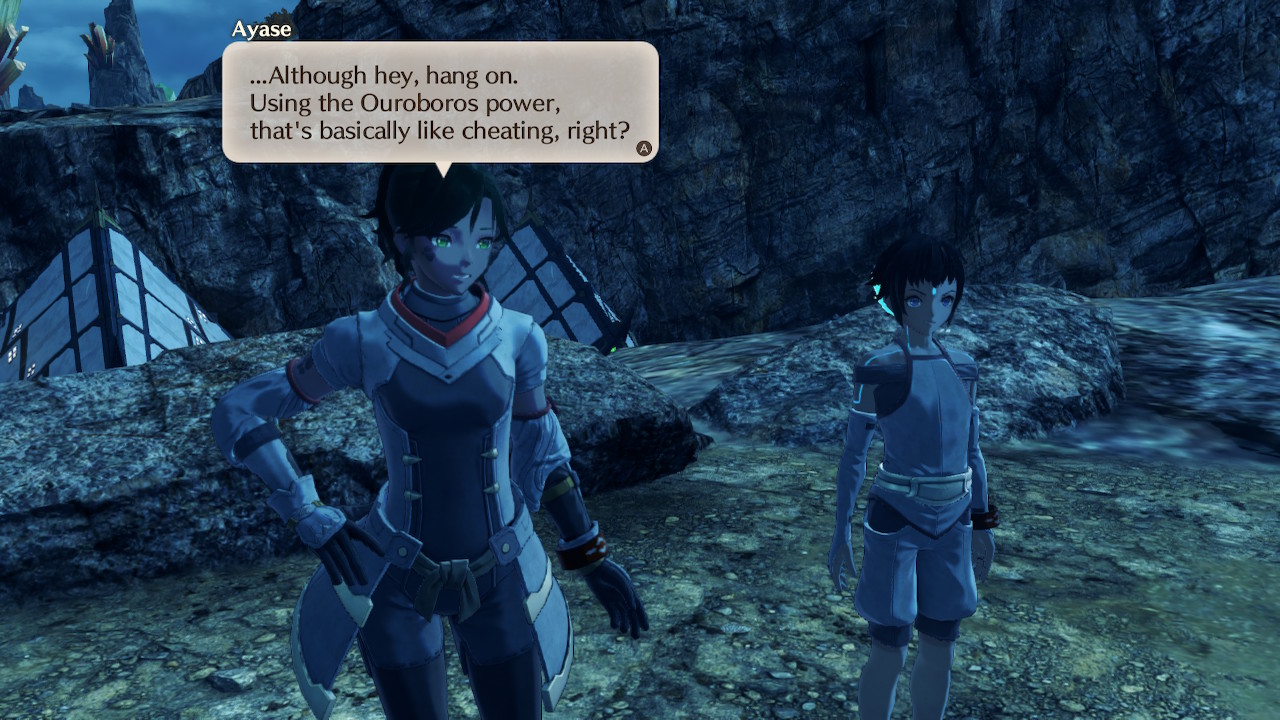
Ayase, recognizing the advantage of Ouroboros’ powers.
The Wittgenstein of 1929 felt that “the right expression in language for the miracle of the existence of the world,” as in the expression of absolute safety, “though it is not any proposition in language, is the existence of language itself,” going “beyond the world” in the way his thoughts the following year described a way of thought that could fly above the world.[318] With the rest of Wittgenstein’s life and work in view, I think we could call it a case, as Malcolm does, of “look[ing] on religion as a ‘form of life’ (to use an expression from the Investigations), in which he did not participate, but with which he was sympathetic and which greatly interested him.”[319] It is within this form of life that interpretations of the world sub species aeternitatis have use, and it is for this reason that various levels of religious understanding (predestination, for instance) require living a certain kind of life, rather than just living within an empirically verifiable world, to access.
Living a certain kind of life in order to play religious language-games seems to be the spirit behind Wittgenstein’s remark that “a confession has to be part of one’s new life,” existing within the stream of life and establishing new motion between river and river-bed.[320] It may have been that spirit, too, in which Wittgenstein joined his friend and student Yorick Smythies in translating part of The King of the Dark Chamber, a play by Indian poet Rabindranath Tagore.[321] The play illustrates allegorically the absolute safety a King—a stand-in for God, whose subjects never see him—shows to his Queen after she falls from grace, accidentally betrays him, and humbles herself, doing away with her pride through a kind of confession.
Monk argues that Wittgenstein’s act of translating the play exemplifies his attitude toward interpretation as a way of understanding art: Wittgenstein initially read the play in German translation and found it devoid of feeling; yet he reread it just months later and found the feeling in it, so much so that he shared it frequently with his friends and undertook his own interpretation through the act of translation.[322] Monk notes that the play’s conclusion, Scene XX, reflects many of the religious topics Wittgenstein toiled over across his life:[323] after the “fever of longing” for the world beyond the King has left the Queen and she humbles herself, she proclaims in celebration of him that he “stand[s] beyond all comparisons.”[324] He replies, “that which can be comparable with me lies within yourself,” to which she answers, “If this be so, then that too is beyond comparison.”[325] In my mind, this exemplifies the poetic content of Wittgenstein’s views on ‘absolute safety’ as ‘safety in the hands of God’: to experience absolute safety is to resonate with God in a relationship in which the relevant aspect of neither party is comparable to that of the other, and which, collectively, is incomparable to relationships and forms of life in which the person can stand to other participants in the empirical world.
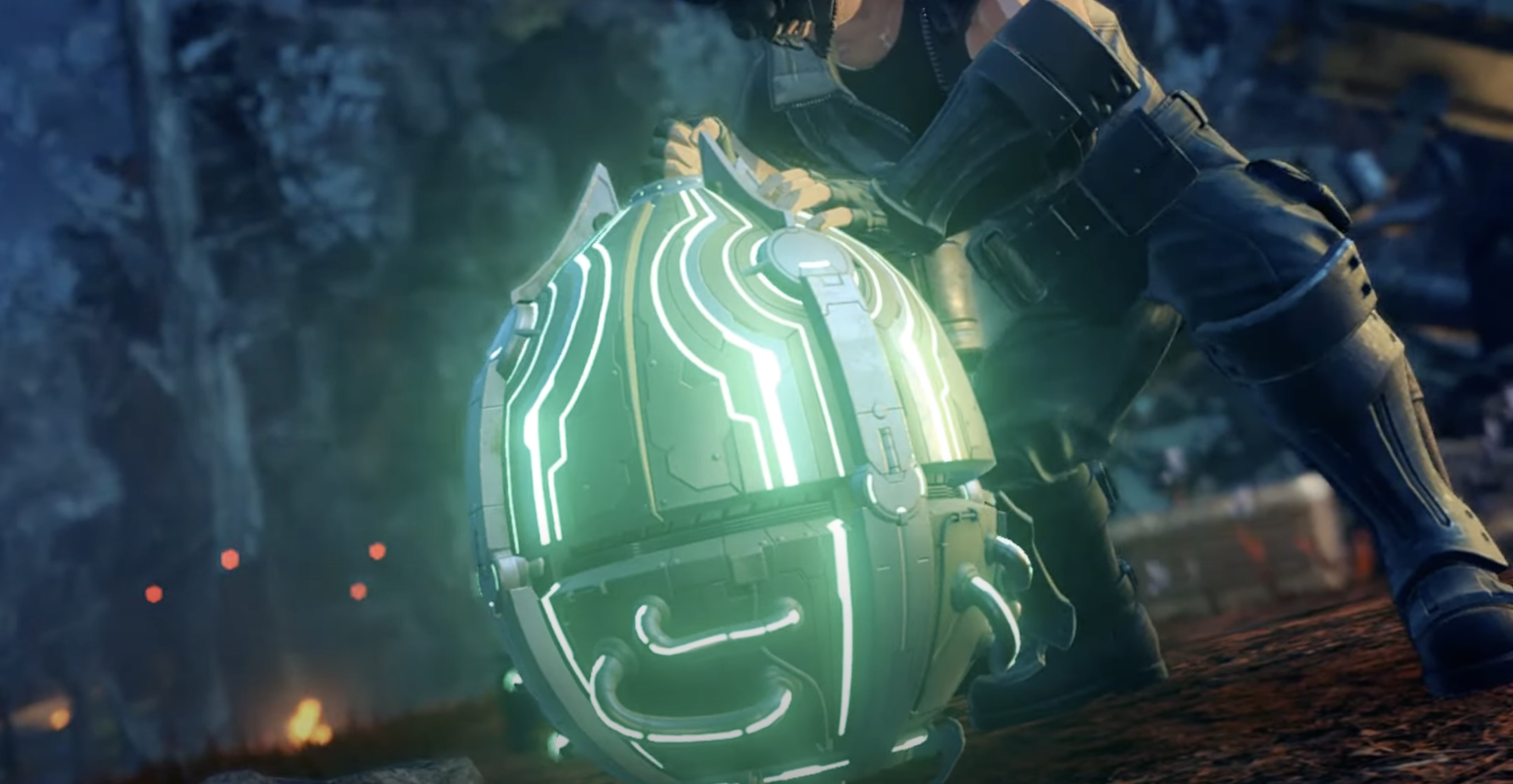
Guernica’s Ouroboros Stone prepares to offer 6 Aionians a new form of life.
What, then, of the comfort that seemed to be lost in the movement from capturing the world between sayable and unsayable to embodying it through forms of life that allow a diversity of interpretations? Returning to the model of the playwright and the actor, we can characterize this as a movement from finding comfort in simultaneously being the actor and the playwright—as the Wittgenstein 1 perspective sought to live in the world while still capturing it sub specie aeternitatis, from the unsayable outside—to finding comfort in being the actor and trusting the playwright—deriving absolute safety from a relationship that transcends the stage you’re on, even if you yourself remain fixed upon that stage.
Put as Slogan 12: To live a religious form of life is to interpret yourself as absolutely safe within the world by virtue of your relationship with God, beyond that world.
§2.13: Performing Life’s Score
If Wittgenstein’s life was a tapestry, then he seems to have been keenly aware of the activity of weaving together its various threads, recognizing the value of interpretation in himself and others. In developing Wittgenstein 2, I want us to weave together 3 particular patterns from that tapestry: Wittgenstein’s lifelong appreciation of music, his attitude toward vocations for himself and others, and his tendency to interpret the broader course of his own life.
§2.131: The Language of Music
While endeavoring to complete his Philosophical Investigations, Wittgenstein once told his friend, Maurice Drury, “It is impossible for me to say one word in my book about all that music has meant in my life. How then can I hope to be understood?”[326] True to those words, music colored Wittgenstein’s life in a way that both permeated and transcended his work. He recognized the mere act of imagining a piece of music as “something I do every day & often”;[327] his friends recognized his capacity to elevate whistling to a fine art, “whistling through a whole concerto, interrupting himself only to draw the listener’s attention to some detail of the musical texture.”[328] Given the thematic prominence of music in both Wittgenstein’s life and the storytelling of Xenoblade Chronicles 3, it will be useful to include a music-specific aspect in our perspective of Wittgenstein 2.
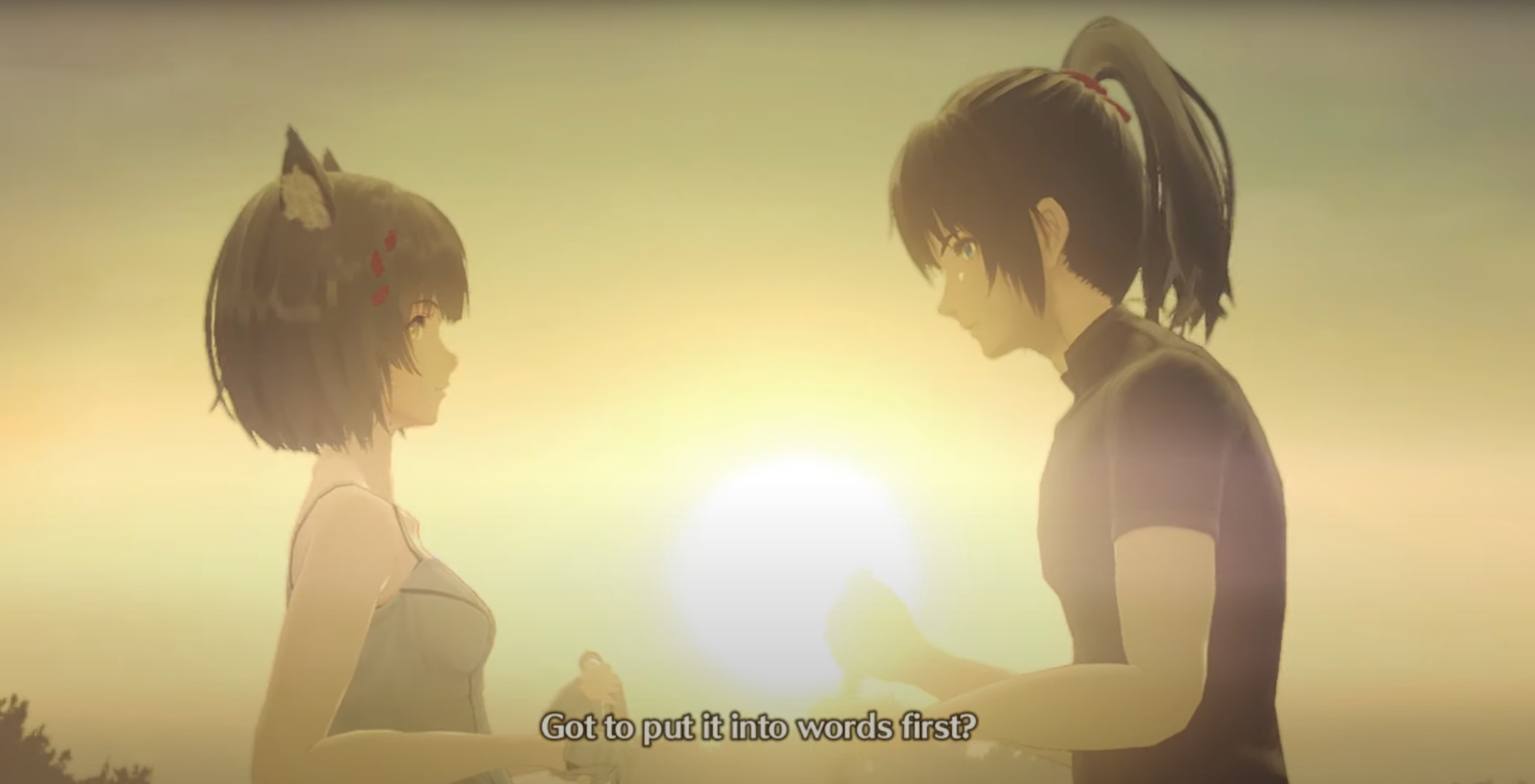
Two musicians discuss the difficulty of sharing thoughts with one another after exchanging their instruments with one another.
In large part, Wittgenstein’s family and friendships were oriented around shared musical interests:
- His grandparents adopted violinist Joseph Joachim and were responsible for his tutelage under Felix Mendelssohn; Joachim led to Johannes Brahms becoming a close family friend, giving the first performance of his Clarinet Quintet in the Wittgenstein residence.[329]
- His mother facilitated musical events at their home visited by musicians such as Brahms and Mahler.[330]
- One of his brothers was composing from the age of four, and another saw a career as a concert pianist, which he managed to continue even after losing one arm to World War 1.[331]
- One of Wittgenstein’s closest friends early in his life, David Pinsent, met him as a subject in psychology experiments he conducted at Cambridge about how rhythm influences the appreciation of music;[332] on holiday together in Norway while Wittgenstein struggled to produce work on logic in the time before World War 1 and the Tractatus, Pinsent grounded him by joining him in a range of about 40 Schubert compositions, which they played regularly.[333]
- In a time following World War 1 when Wittgenstein was teaching primary school in a rural Austrian mountain-town to whose people he could not easily relate, he found his footing in a friendship playing regular duets with Rudolf Koder, the school’s music teacher.[334]
Even outside of his philosophical work, the aesthetic universe of musical composition and appreciation was a regular theme in Wittgenstein’s personal reflections. He studied individual composers as the creators of families of melodies each with a unique “field of force in which they stand,” insistent that we shouldn’t be misled into thinking all music is the same simply because all composers create melodies: like different species of tree, the melodies of each artist are “steps along a path that leads from something you would not call a melody to something else you would again not call one.”[335] Thus in Beethoven’s melodies “the expression of irony is to be found for the first time,” while Wagner’s saw that irony “turned into something bourgeois”; in Mozart and Haydn’s, “fate plays no sort of role. That is not the concern of this music.”[336] Even Mahler, whose music Wittgenstein found worthless, was the source of keen reflection on what one ought to do with one’s talents—“[f]or quite obviously it took a string of very rare talents to produce this bad music.”[337]
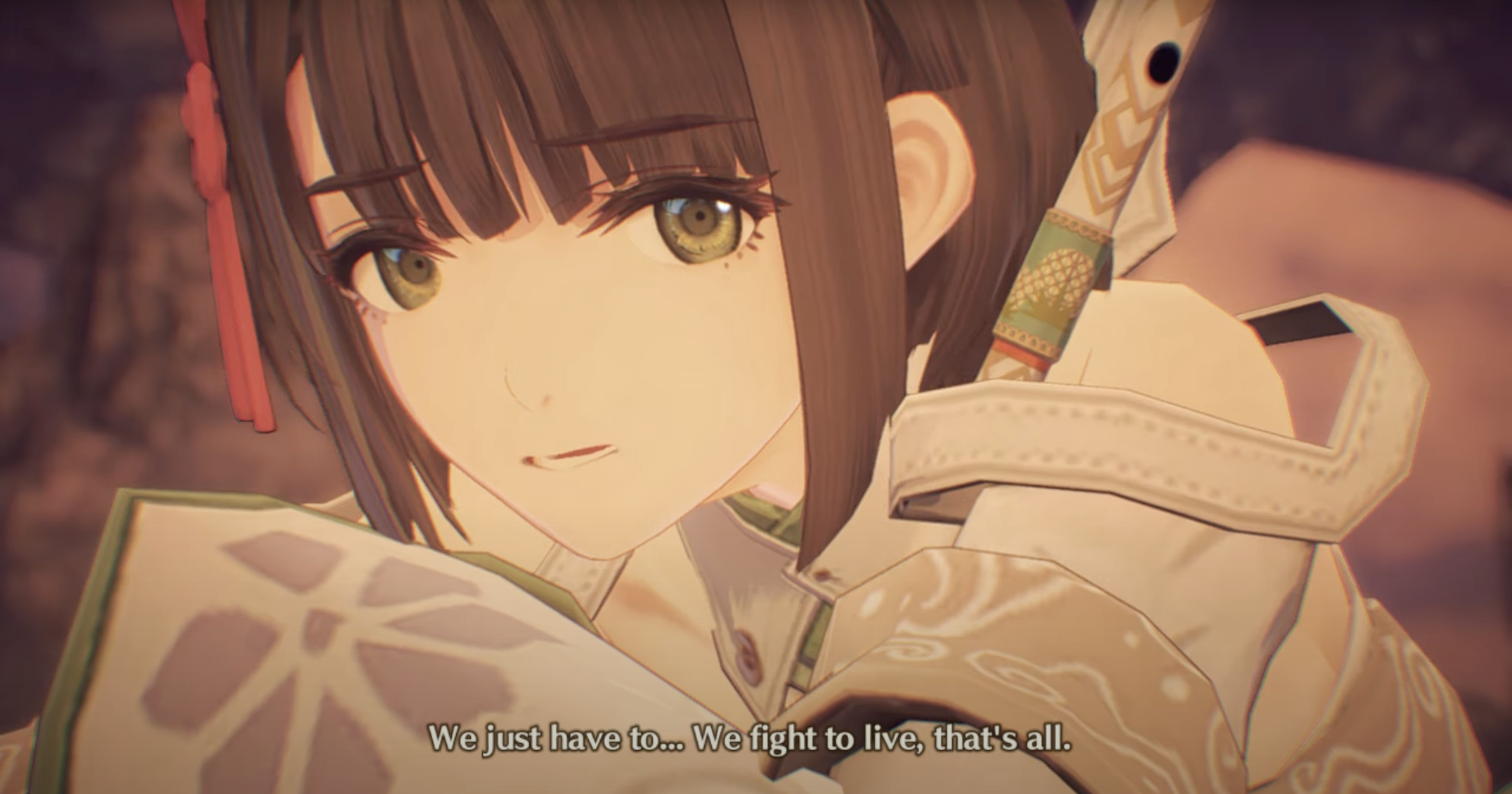
Miyabi shares her family of melodies with Mio.
His sensitivity to musical forms of life was another face of that emphasis on the relationship between precision and artistic expression, which his friends saw so routinely in his unbelievably precise and sophisticated whistling. Something seemingly simple, like a few notes blown or hummed on the wind, contains multitudes:
Music, with its few notes & rhythms, seems to some people a primitive art. But only its surface is simple, while the body which makes possible the interpretation of this manifest content has all the infinite complexity that is suggested in the external forms of other arts & which music conceals. In a certain sense it is the most sophisticated art of all.[338]
We see in this reflection not only echoes of his deep appreciation for composers, but also the characteristics of music that make it such an apt lens through which to see Wittgenstein’s later work. Language hides the infinite complexity of its uses and language-games beneath a surface of a few homogeneous letters and marks of punctuation; interpretation of manifest content—whether the manifest content of a dream, a play, a life, or a duck-rabbit—is made possible by those uses and language-games, hidden right before our eyes just like the countless complex processes that happen between our hearing a song with our ear and hearing it with our mind. The Wittgenstein of the Tractatus deployed music as an analogy to show how something symbolic, like a musical score, constitutes a picture of what it represents, fixing that representation as the Tractatus would have pictorial representation fix significant expression;[339] the Wittgenstein of aspect-seeing and language-games uses music almost as a means of discipline, repeatedly admonishing us against imposing some kind of more essential picture or feeling beyond the uses of music and the uses of language:
“He is experiencing the [musical] theme intensely. Something is happening in him when he hears it.” Well, what?
Does the theme point to nothing beyond itself? Oh, yes! But that means: the impression it makes on me is connecting with things in its surroundings —e.g. with the existence of the German language & of its intonation, but that means with the whole field of our language games.[…]
A theme, no less than a face, wears an expression. […]
[…] And yet there just is no paradigm other than the theme. And yet again there is a paradigm other than the theme: namely the rhythm of our language, of our thinking & feeling. And furthermore the theme is a new part of our language, it becomes incorporated in it; we learn a new gesture.”[340]
For Wittgenstein, music becomes the ideal aspect of personal experience on which to draw as a symbol for how inspiring yet misunderstood language is. So much can be expressed in both, but to explain these expressions through appeal to internal experiences or other theoretical models is to do a disservice to the miracle before our eyes: namely, the fact that everything we’re getting out of a sentence or musical expression comes from the infinitely complex feedback loop of expressions, accepting rules to the game, and interpretations that become new gestures, new games to play in their own light. If you want to experience an artist’s musical expression, simply listen and react. If you want to show it to her in a certain aspect, play it for her yourself, or tell her what you thought of it. If you want to know what she was trying to express in the music, then ask her. And, understand that four of these options are themselves distinct games you can play, games that criss-cross with all the intricacies of our language, concepts, and art.
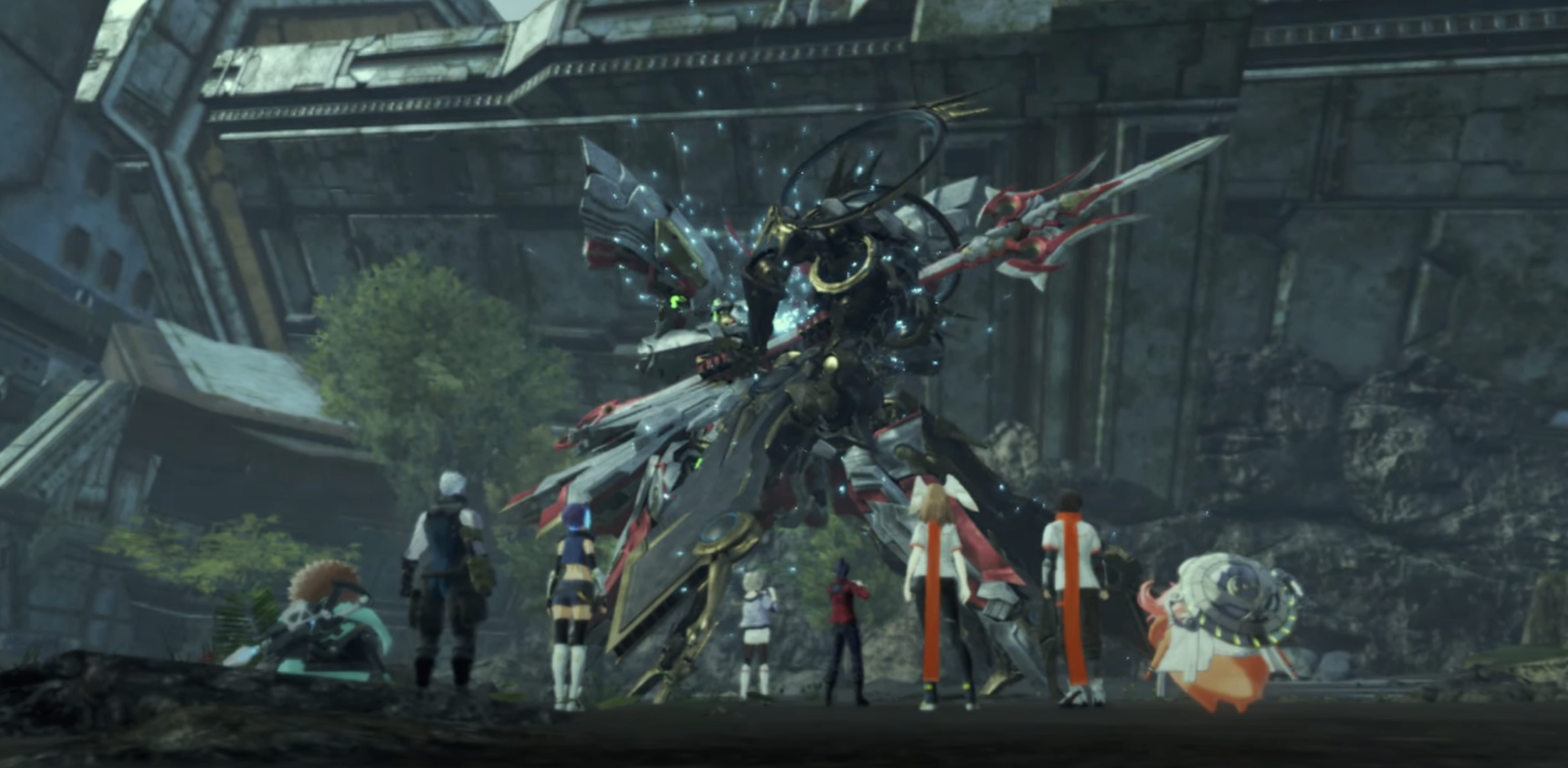
Noah and Mio contribute a new gesture to Ouroboros’ language by seeing off Ethel and Cammuravi after their honorable duel to the death.
This gives us Slogan 13: Musical performance can serve as a microcosm to illustrate and enact the roles of use, games, rules, and interpretation in language.
§2.132: Pursuing Useful Forms of Life
With the musicians who occupied his mind as well as with himself and those he mentored, Wittgenstein’s thoughts often dwelled not only on the matters of a person’s talents, but also on the uses to which they put those talents. He seemed to think that the achievement of something great required a particular intersection of an individual’s nature and their abilities within the world: “Genius is not ‘talent and character’, but character manifesting itself in the form of a special talent. Where one man will show courage by jumping into the water, another will show courage by writing a symphony.”[341]
I think Wittgenstein’s contrast between something mundane and something artistic highlights a key aspect of his approach to choosing a profession. As in his later views on method in philosophy, it is no good to commit one’s life to something without meaningful output, like a philosophical theory that jettisons use in favor of inert, essential concepts: rather, one needs to illuminate one’s self-understanding through the “light” of honest self-assessment, unadorned with pride, and find the right “particular kind of lens” by which to channel that light into “a burning point” to uniquely impact the world, much like focusing on the particularities of single uses of language can relieve us of our confusions and help us to better understand our relationships with others, our world, and ourselves.[342]
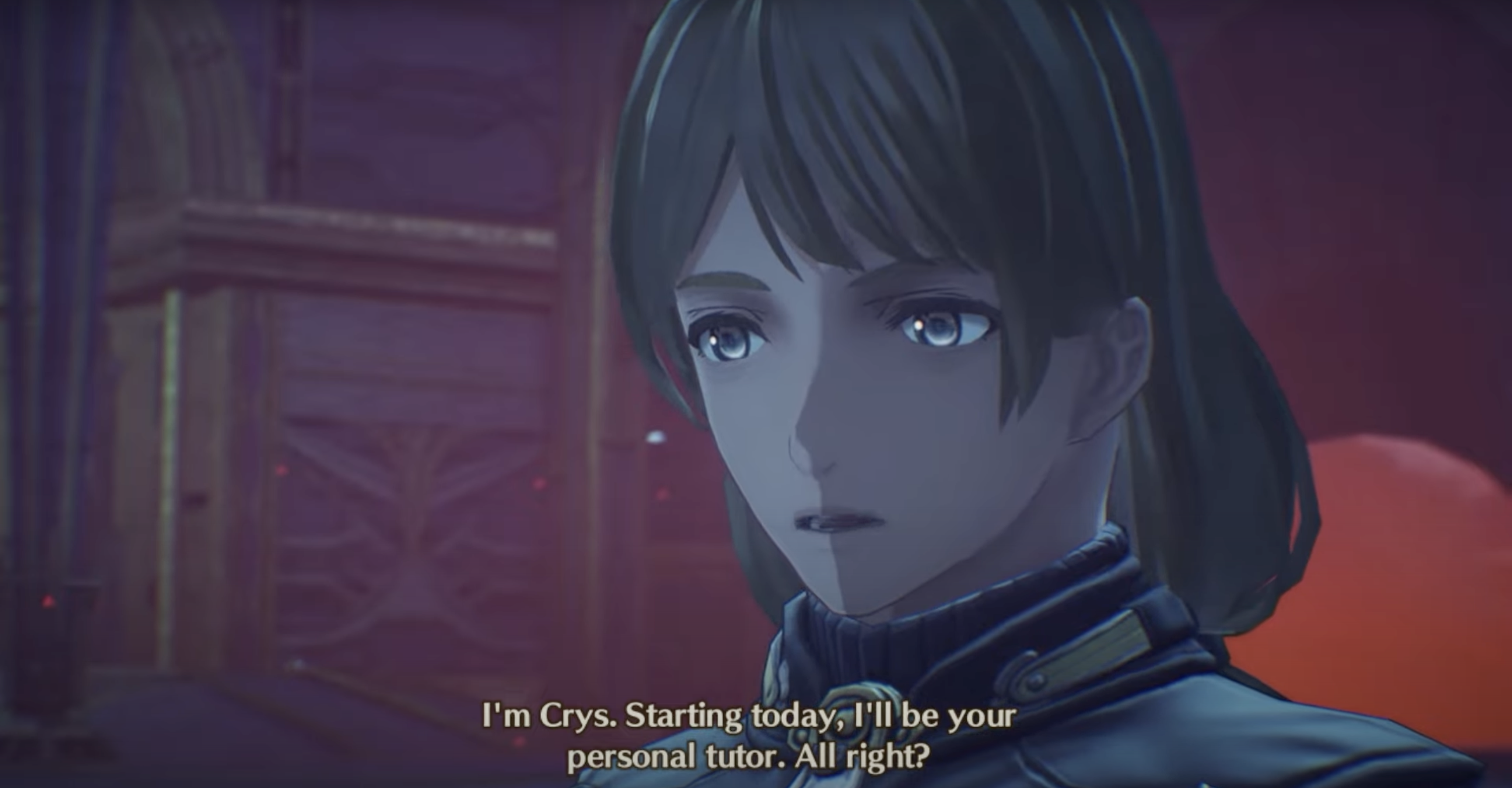
Crys takes on the role of mentor, helping Noah to cultivate his own relationship with music and off-seeing.
In his own life, Wittgenstein took the duty to channel character through talent seriously—so seriously that he may not have undertaken to focus on philosophy if not for Bertrand Russell, one of his first points of contact in the discipline, assuring him that he had real talent in it. Wittgenstein initially started down the path of an engineer, studying aeronautics at Manchester from the age of 19, engineering kites, and ultimately even patenting a design for a propeller.[343] During his time there, he discovered the works of Frege and Russell through studies in pure mathematics, but he was discouraged from pursuing his philosophical interests further when his initial outreach proposing new solutions to the problems Russell raised in his Principia Mathematica didn’t meet with immediate success.[344] While he refocused his efforts on aeronautics for a time, they came with “a constant, indescribable, almost pathological state of agitation.”[345]
This agitation was only resolved after he was able to travel to Cambridge on Frege’s recommendation, meet Russell, and, after studying with him for a term, ask him outright “whether [Russell] thought he was utterly hopeless at philosophy, feeling that “he ought not to give his life to it unless he is some good.”[346] Wittgenstein later confided in David Pinsent that Russell had saved him from suicidal despair by this simple act of recognizing that he had talent in philosophy, this field for which he had so much taste:
[He] told me lots about himself: that for nine years, till last Xmas, he suffered from terrific loneliness: that he continually thought of suicide then, and felt ashamed of never daring to kill himself […] He had been brought up to engineering, for which he had neither taste nor talent. And only recently he had tried philosophy and come up here to study under Russell which had proved his salvation: for Russell had given him encouragement.[347]
In the context of Wittgenstein 2, it’s important to note that this encouragement gave Wittgenstein not only the validation to feel justified in pursuing philosophy, but also (for a time), in Russell, confidence in a qualified person who could help to draw Wittgenstein’s potential out of him: in the years that followed, as Wittgenstein worked through the underlying ideas of the Tractatus, Russell sometimes felt as though he had to use that relationship to “drag [Wittgenstein]’s thoughts out of him with pincers, however he may scream with pain.”[348]
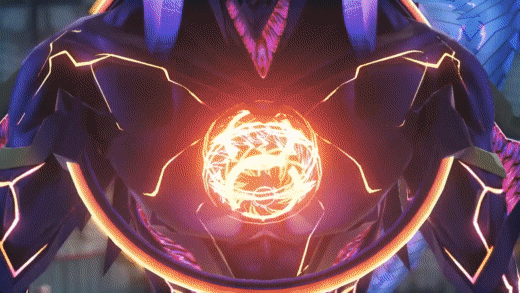
Interlinked Noah and Mio, dragging the Sword of the End out of themselves, as if with pincers.
So important was this conception of one’s work to Wittgenstein that he also strove to impart it to his students with whom he was closest. In steering Drury away from academia when Drury was his student, he said, “there is no oxygen in Cambridge for you.”[349] In lieu of a suffocating career in a discipline that, by Wittgenstein’s later assessment, primarily manufactured useless models of the world, he advocated jobs which he viewed as suited to aligning their character with something productive: Drury he led to study medicine and become a psychiatrist,[350] Skinner to apprentice as a mechanic;[351] Malcolm he tried (unsuccessfully) to persuade to work “a ranch or farm” rather than pursue professional philosophy.[352] In suggesting these paths, he wasn’t especially sensitive to their apparent talents: Skinner, for instance, was taken by many to have a real aptitude for mathematics,[353] whereas Wittgenstein believed that he “wasn’t a thinker”[354]—perhaps at least partly because Wittgenstein’s later views on mathematics (that they are developing new language-games rather than, as they believed, discovering a reality of the world) discounted many mathematicians as “thinkers” in his eyes.[355] This illuminates that the sort of cultivation of others’ vocations we have in mind here isn’t one in which the mentor figure neutrally hones his charge’s innate abilities: in many regards, it’s just as much an interpretive act as trying to convince someone (perhaps the duck-rabbit itself?) that the duck-rabbit is a duck.
As Slogan 14: The roles we take on ought to focus our natural abilities in a way that is uniquely useful to the world, and mentors are instrumental in molding our relationships with those roles.
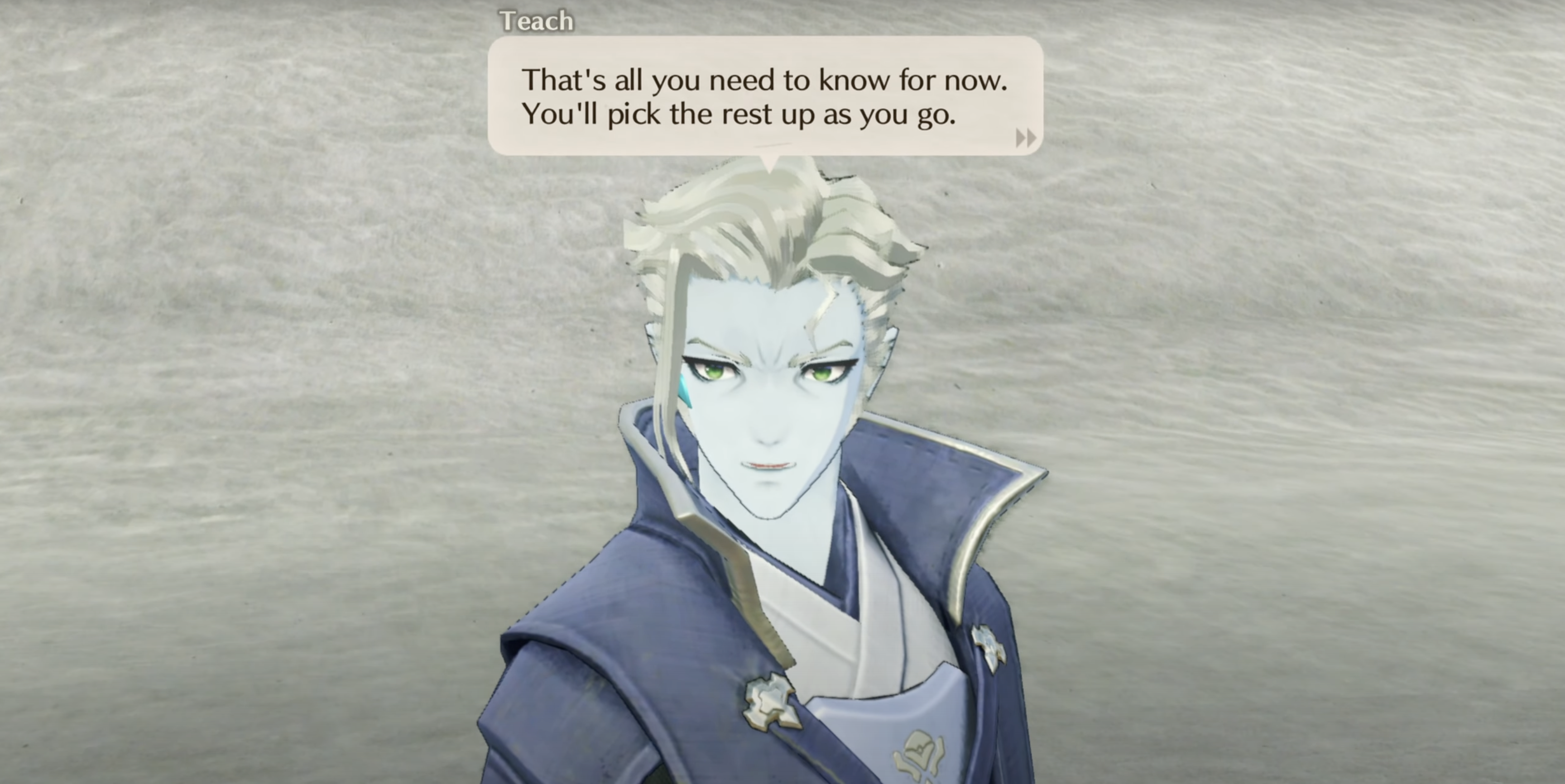
Teach serving as a mentor for Ouroboros as he teaches them the transversal skill, “Scree Walking,” during his Hero Quest.
Wittgenstein saw himself as different than his students in the suffocating environment of Cambridge: when he told Drury that there Drury would find no oxygen in Cambridge, he added that “I manufacture my own oxygen,” and thus it “didn’t matter” for him.[356] The difference between Wittgenstein and his friend illustrates the other side of the vocational approach I want us to hold in our minds for Wittgenstein 2: as the meaning of language depends on the specific context surrounding particular uses of it by players exercising certain judgments with particular background traditions informing them, so, too, ought our choice of jobs and projects to update over the course of our life as we find ourselves situated in new contexts, fit for new uses, in evolving traditions.
Expressed in Slogan 15: As the forms of our life change, so should the roles we take on change.
We already saw in Part 1 how Wittgenstein elected to join the war efforts when the outbreak of World War 1 changed his context and the opportunity to manifest different aspects of his character through different talents, in service of himself as much as his country; we also saw his counsel to Hutt to join the frontlines in World War 2 as Hutt’s own context turned to a more depressed sentiment about his current role in in the army.[357] Wittgenstein, then, was willing to extend this flexibility not only to himself, but also to others.
His own case, though, seemed to be one described not by a handful of career changes, but rather by a continuous adoption of new roles, all related through a sort of family resemblance to his philosophical interests.
- He returned from World War 1 as someone for whom “a storm was raging”[358] and sought refuge in teaching at rural elementary schools, using his skills in knowing “how to pick the most important aspects of anything and make them clear to others”[359] to keenly cultivate students’ attention and abilities—while also traumatizing those whose abilities he found lacking, through verbal and physical punishment.[360]
- Between his training to become a teacher and beginning his work in schools, he spent a summer gardening for a monastery, leaving himself too physically tired to be unhappy, and impressing the Abbot with his execution of the job.[361]
- After leaving teaching and pursuing another cleansing gardening job outside of Vienna, he worked with his friend, Paul Engelmann, to design a house for his sister, Gretl, imposing unflinchingly rigid standards on the measurements of door, radiator, and window design to create the ideal house for someone who had always insisted on “original and grand”[362] surroundings, ever since she was little.[363] He identified for a significant amount of time as an architect on his stationary and in Vienna’s directory, despite only ever undertaking this one project.[364]
- During World War 2, Wittgenstein felt compelled to contribute to war efforts in England rather than lecturing at Cambridge, joining the ambulance brigade,[365] becoming a dispensary porter at Guy’s Hospital,[366] and a laboratory assistant in the Medical Research Council’s Clinical Research Unit.[367] The last of these focused on research into the medical condition of ‘shock’, understood to come on following trauma such as air-raids; it ultimately was “led to discard the word ‘shock’ in its various definitions” due to its diagnoses depending “on the personal views of the individual making it rather than on generally accepted criteria,” true to the later attention in Wittgenstein’s philosophy to discarding philosophers’ concepts that lack ties to generally accepted criteria for the uses of words.[368]
The last example of this non-exhaustive list may illuminate the professional overlap that led Wittgenstein more than once to seriously explore training to become a doctor and practice psychiatry with Drury.[369] All of them also highlight an interesting relationship between Wittgenstein’s roles as a worker in society and his role as a philosopher: as diverse as all of these jobs’ content and motivations were, they all found a way to inform, relate to, and reinforce his role as a philosopher.
We’ve already seen intersections between philosophy and his medical and wartime thinking; perhaps just as interesting for the master of analogy we see alive in Wittgenstein 2, all of these roles show up among the countless examples he uses in his work. Even in the Philosophical Investigations alone:
- We see that the processes of children learning language and of teachers educating them are central to the presentation of language-games.[370]
- We see the order to fetch a flower of a certain color figuring in examples of how using a chart to identify particular colors might or might not factor into a language-game,[371] and of the potential disconnect between the issuing of an order and the order’s execution.[372]
- We see him channeling architecture in his discussion of the criteria for following a rule, pointing out that explanations aren’t always demanded as forms of justification and calling them “a sham corbel that supports nothing.”[373]
- We see him calling visits with a doctor to mind to focus us on the actual uses of reporting one’s pain[374] and consciousness;[375] he takes us to laboratories to consider uses of ‘exactness’[376] and of ‘willing’.[377]
Wittgenstein’s seemingly simple ability to make connections through analogy belies a wealth of different experiences lived: in that sense, his ability to so rigorously direct our attention to the relationship between words’ uses and meaning depended on his own form of life. This face of his philosophy was one of marshaling the diverse totality of his experience to interpret the content of that life.
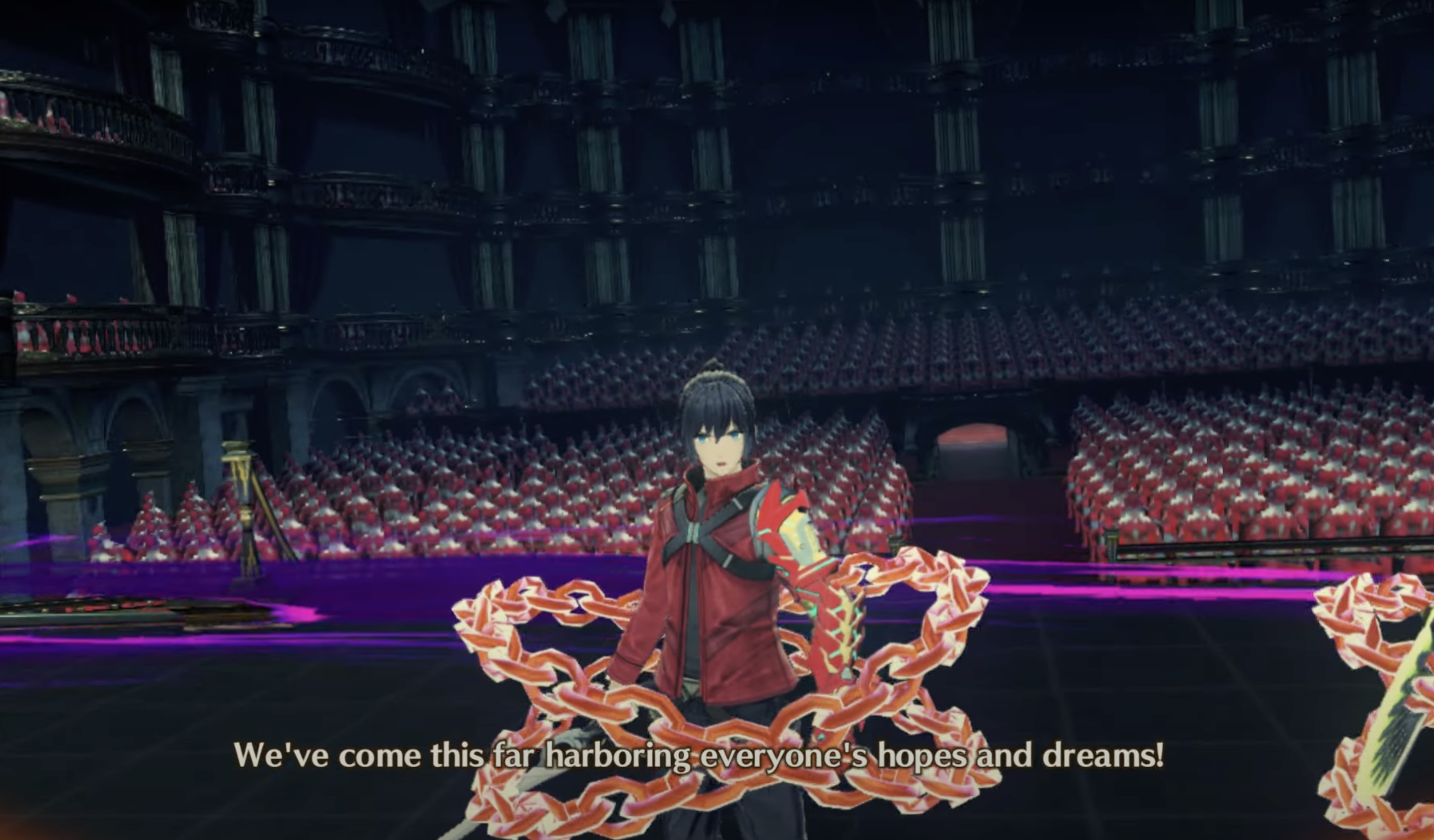
Noah declares the strength Ouroboros draws from the countless people whom they met and helped, in their Amphitheatre confrontation with Z.
As Slogan 16: We can use our experiences in a diversity of roles to augment our facility with a particular role.
This is a face, too, which we might choose to read into his last words, a thoughtful use of language to offer a game for his loved ones to play with him: before he lost consciousness on the final day of his life, on his deathbed in his doctor’s home, he told his doctor’s wife, “Tell them I’ve had a wonderful life.”[378]
§2.14: Defining Wittgenstein 2
In defining Wittgenstein 1, we had 8 slogans at our disposal. In defining Wittgenstein 2, we have 16.
- To understand how language relates people to the world, look and see how they use it.
- We understand the tools of our language-games within the context of networks that map similar games.
- One game has no claim to ontological priority over another.
- We can only make sense of our experiences in language that could be used in conversation with others.
- Our memories of a sensation aren’t sufficient to justify our naming of that sensation.
- Series and formulae are not representations of reality, but rather descriptions of a rule only to those people who are already following that rule.
- The possibility of language-games depends on its players’ agreement about what counts as following its rules.
- Our language-games are only possible within the context of frameworks of beliefs about which we are certain, and playing our language games with others is only possible to the extent that we can reconcile our relevant framework with theirs.
- Our frameworks of beliefs empower us to see and act upon the world in new ways, and to share that agency with others.
- Attending to the diversity of use in language diffuses the puzzles that hinder our ability to enjoy those many uses.
- An interpretative language-game highlighting aspects of our experiences, used within a particular form of life, can bring about new understanding of our place in the world sub specie aeternitatis.
- To live a religious form of life is to interpret yourself as absolutely safe within the world by virtue of your relationship with God, beyond that world.
- Musical performance can serve as a microcosm to illustrate and enact the roles of use, games, rules, and interpretation in language.
- The roles we take on ought to focus our natural abilities in a way that is uniquely useful to the world, and mentors are instrumental in molding our relationships with those roles.
- As the forms of our life change, so should the roles we take on change.
- We can use our experiences in a diversity of roles to augment our facility with a particular role.
Looking at the content of these slogans and reflecting on the nature of Wittgenstein 1, we shouldn’t be surprised that the Wittgenstein 2 perspective is drawn from a greater number of slogans than Wittgenstein 1 was. Wittgenstein 1 was a retreat from a singular fear into a single rigid, absolute framework for understanding the entire world; in contrast, Wittgenstein 2 celebrates the diversity and incommensurability of many different ways of doing things in the world. To even attempt to draw a picture of it, as Wittgenstein did in his later work, we have to survey a wide landscape, criss-crossing as we go to gradually compile a picture of the whole through the particulars, not in spite of them.
In that same spirit, the individual slogans here will play more work in our tracing the representation and activity of Wittgenstein 2 than the slogans did in Wittgenstein 1. All the same, it remains useful to propose thematic connections in order to see the forest for the trees—without losing sight of the trees!
Connection 1: We depend on interaction with others to make meaning out of the world. (S1, S2, S4, S5, S6, S7, S8, S9, S14, S16)
Connection 2: We can empower ourselves and each other by relating ourselves to others without putting ourselves before the other, or vice versa. (S2, S3, S4, S5, S8, S9, S10, S11, S12, S14)
Connection 3: Clearly seeing and doing things in the world gives us more freedom to interpret our place in the world in new ways. (S1, S2, S8, S9, S10, S11, S12, S13, S15, S16)
Now, with the Wittgenstein 2 perspective in place, we can understand how these themes and their philosophical underpinnings bloom throughout the numerous protagonists of Xenoblade Chronicles 3, as well as how the defeat of the Endless Now, seemingly impossible, is, after all, inevitable.
§2.2: Ouroboros’ Therapies
As with Wittgenstein 1, Moebius, and the Endless Now in Part 1, the remainder of Part 2 calls us to sketch our perspective of Wittgenstein 2 as an entity and an activity within Xenoblade Chronicles 3. I first show how the perspective of Wittgenstein 2 comes to life in the game’s heroes, working from the “outside” of the world to the progressively more “inside”: from the player, to the Queens, to Ouroboros, to the Heroes and Colonies, to those communities beyond Moebius’ reach, we’ll witness a network of language-games that manifestly contradict the suppressive unity insisted by Wittgenstein 1 and Moebius. With our cast of characters fully in view, I then show how their actions allow us to view each Chapter of the game as a call-and-response between Wittgenstein 1 and Wittgenstein 2. By the time we reach the end of Chapter 7, we’ll see that Noah’s injunction and decision to “Walk on” embody the fact that the game’s characters, along with its players, held the key to let themselves out of their prison cells all along.
Our next study is unlike the analogous study in Part 1 just as the methods of Wittgenstein 2 are unlike those of Wittgenstein 1: where Moebius’ entails that all of its constituents and activity compose a rigid hierarchy in the service of one worldview, Ouroboros, like Wittgenstein 2, insists on looking, seeing, participating in, and respecting many different forms of life on their own terms. Therefore, at every turn in our coming tour throughout and beyond Aionios, we must remind ourselves to look and see the relationships and activities within the game, taking them on their own terms rather than forcing their meaning through a theoretical lens—understanding that, all the while, we ourselves are playing one of many possible language-games with Xenoblade Chronicles 3.
§2.21: The Player and Absolute Safety
Xenoblade Chronicles 3 does not contain an avatar.
There’s an obvious sense in which this statement is not true: of course, our perspective in the game follows certain characters, our inputs on the Switch controller correspond with certain characters taking certain predictable actions, and so on. But there is an important sense in which Xenoblade Chronicles 3 does not contain a single avatar, nor one avatar that takes priority over others.
The storytelling of the game, too, seems to highlight this as a distinction between our experience of Aionios and our experiences of Alrest, Bionis, and Mechonis in times before. Ask yourself: in a world composed of these previous worlds, governed by characters from those previous stories, why are Shulk and Rex—the avatars of Xenoblade Chronicles and Xenoblade Chronicles 2—conspicuously absent, while their weapons—the Monado and Aegis Sword—are conspicuously present as artifacts, inert mementos where once they were instruments of radical change?

Left: Nia’s combat stance, in which she invokes the Aegis Swords behind her in a ghost- or ether-like form. Right: Shulk’s Monado, sealed away by Melia in her chambers until the conclusion of the conflict with Z and Moebius.
Now, don’t say: “We need a theory for the metaphysical relationship to explain the coordination of the Monado, the Aegis Sword, and Noah’s sword on Aionios.” Instead, ask yourself: “How were the Monado and Aegis Sword used in the hands of Shulk and Rex, and how does the absence of those games on Aionios color Aionios’ forms of life?”
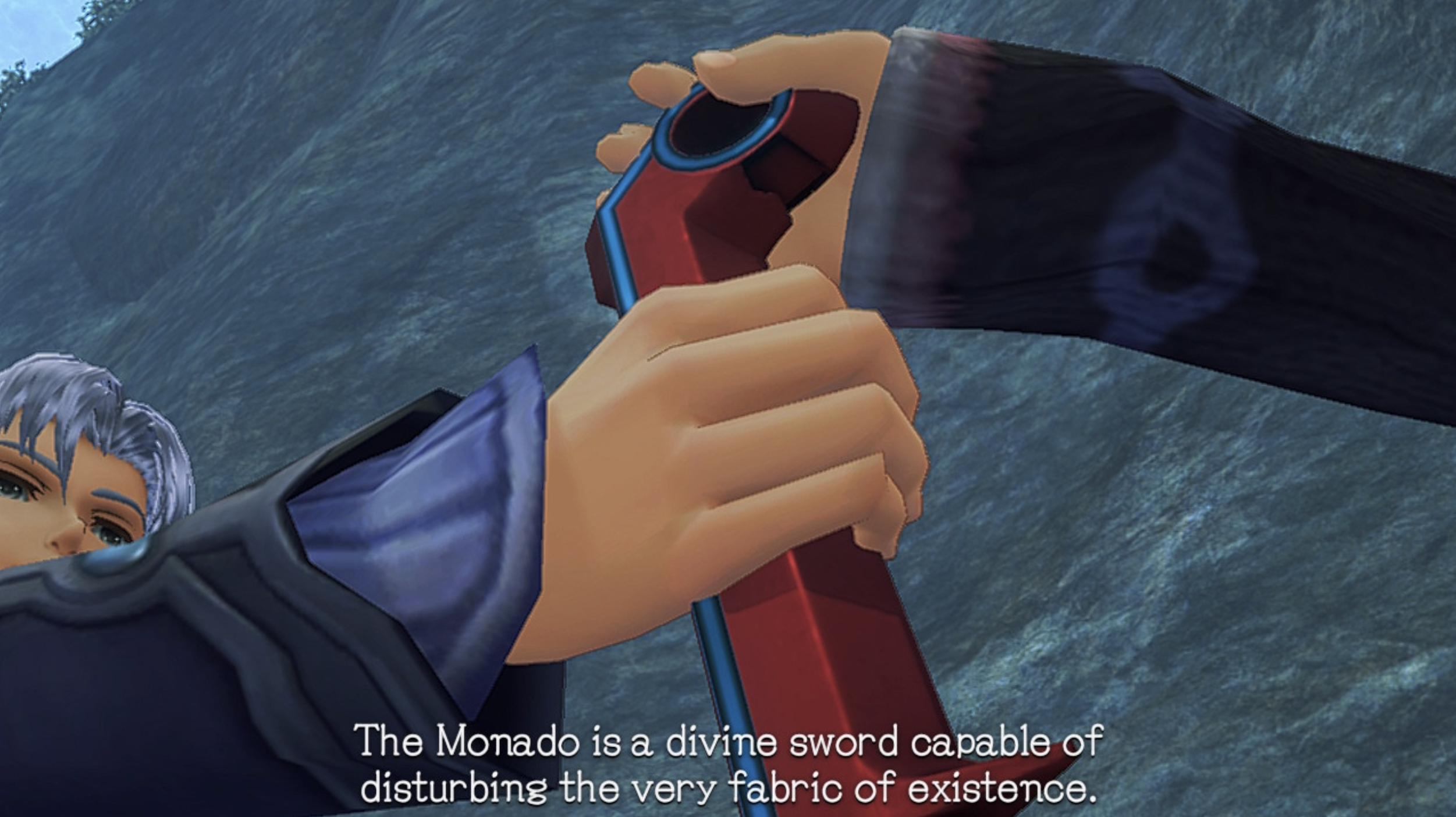
Alvis explaining the nature of the Monado to Shulk in Xenoblade Chronicles: Definitive Edition.
As we discussed at the beginning of Part 2, Shulk and Rex are different sorts of avatars than Noah and Mio. They are the center of their respective parties of heroes, and their swords—their tools for interacting with, and changing, the world—enact their wills metaphysically. The Monado can read the series of events intended for the world by its god (proceeding into the future) and enable Shulk to bring about events incompatible with that intended series;[379] the Aegis Sword channels the power of Pyra, Mythra, and (ultimately) Pneuma to make that which its user imagines a reality,[380] tapping into a power that literally, by the account of the world’s Architect, exists beyond the world’s metaphysical ken.[381]
It’s easy, as I’ve done, to read this kind of unique ability to change the world’s metaphysics as a way to make narrative meaning out of the player, an agent acting from outside of the game’s world, imparting to her avatar the ability to act in ways that don’t accord with the metaphysical laws of its own world.[382] Trapped in a world bound by an outdated set of universal laws, the hero is able to act as a conduit for the agency of the player, unbound by those laws, and thereby forge a path to a new world.
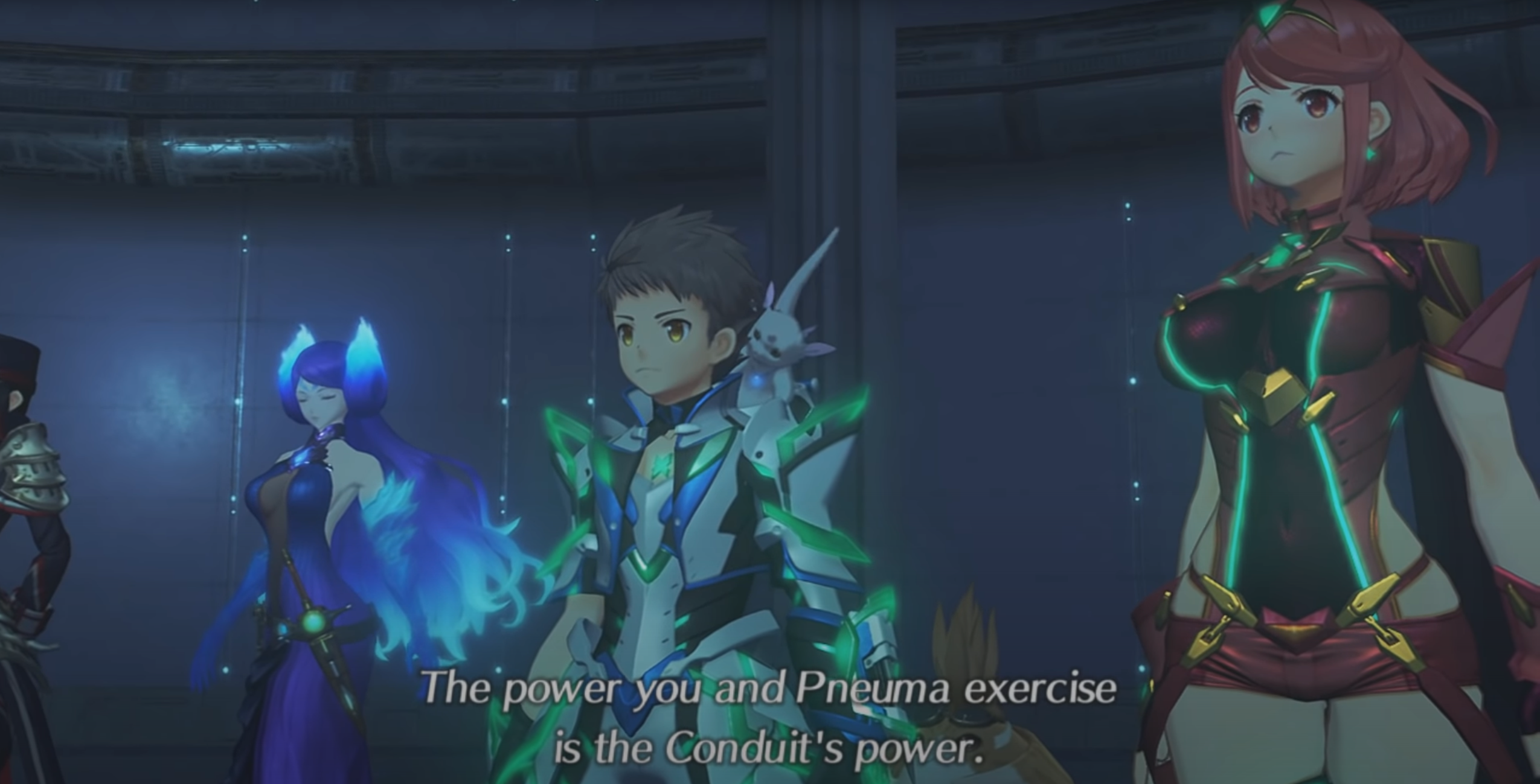
In Xenoblade Chronicles 2, the Architect explains to Rex that the Conduit allows Rex and Pneuma to channel its power: a power “[they] can know nothing about,” from “some far-flung dimension.”

Ouroboros, Queens, and Heroes reflect together on their pasts and futures at the end of their shared journey.
I want to suggest to you that, consistent with Wittgenstein 2 and with Xenoblade Chronicles 3 needing a different kind of player-avatar relationship, the player’s perspective and actions in the game can be read as those of the sort of god who, unlike Z, really doesn’t “reveal himself in the world”:[384] a god who follows a range of avatars on equal footing with each other, watching them play language-games of their own while he confers upon them the “absolute safety” sought in Wittgenstein 2’s conception of the religious life, free to play his own language-games without impeding or dictating theirs. We’ll see this in 3 steps: (1) how the avatars act and are empowered in the story outside of any relationship with the player, (2) what the player does give the avatars through their relationship, and (3) what this relationship gives the player.
First—to loosen our grip on the idea that we, as players, hold onto specific avatar relationships in order to navigate Aionios—recognize that our relationships in Xenoblade Chronicles 3 are too diverse to give any perspicuous definition of a player-avatar relationship.
- We can’t say that Noah gives us special access to the world: we may start the story focused on him and return to a focus on him at the end of the story, but all other points in the story demand we distribute our focus evenly among six different characters—not only in the form of discrete chapters that foreground different characters (Taion in Chapter 3;[385] Sena in Chapter 5[386]), but also in a system of interaction that features dedicated button combinations by which we can seamlessly switch our focus to different characters both in the field and battle (ZL+L/R).
- Nor can we say that the avatars in the game are a group of 6 individuals between whom the player can shift her focus: the player oftentimes finds herself instead focusing on an Interlink, a unity of 2 individual characters—where the player has no role in determining which characters Interlink with which others (i.e. she can’t make it the case, say, that Noah Interlinks with Sena or Taion rather than Mio).
- We can’t even identify the player’s relationship with her avatars with the concept of Ouroboros, as if the agency she conferred upon them was what allowed them to Interlink and challenge Moebius: we enter the game and take Noah, Eunie, and Lanz as avatars long before Guernica introduces them to the Ouroboros Stone, and we stay involved with the party even during times when their Ouroboros powers are sealed, as by Z in the Amphitheatre[387] or in certain more oppressive, miasmatic pockets of Aionios (e.g., Demihuman Gutter in Cadensia Region). There’s no way in which we even facilitate the party’s discovery of, or aptitude for, Ouroboros powers: the best preamble I can see to their becoming Ouroboros is Noah’s sense, when fighting Mio for the first time, that “Something strange is going on” and “[they] shouldn’t be fighting like this.”[388] And after that same voice says they should run and Noah asks, “Was it…me who just said that?”,[389] don’t say: “We need a theory in order to understand what goes on here with this inner voice, like the Ouroboros Stone—maybe even the player? Maybe even a past Noah?—projecting itself into Noah’s mind.” We are seeing someone talking silently to himself in a way we learned to express as children “— Only no one is going to say that the person who teaches [the meaning of this expression] to us tells us ‘what goes on here’.”[390] Noah’s use of language needs no theory, nor any player, attached to it: he’s only flustered by it because he grew up bound within the singular game of a world that denied forms of expression outside of that game—and his sense of bewilderment never returns after he Interlinks with Mio shortly thereafter, recognizing through inner dialogue, rather than inner monologue, the identity between what we can express to ourselves and what we can express to others (S4, C2, C3).
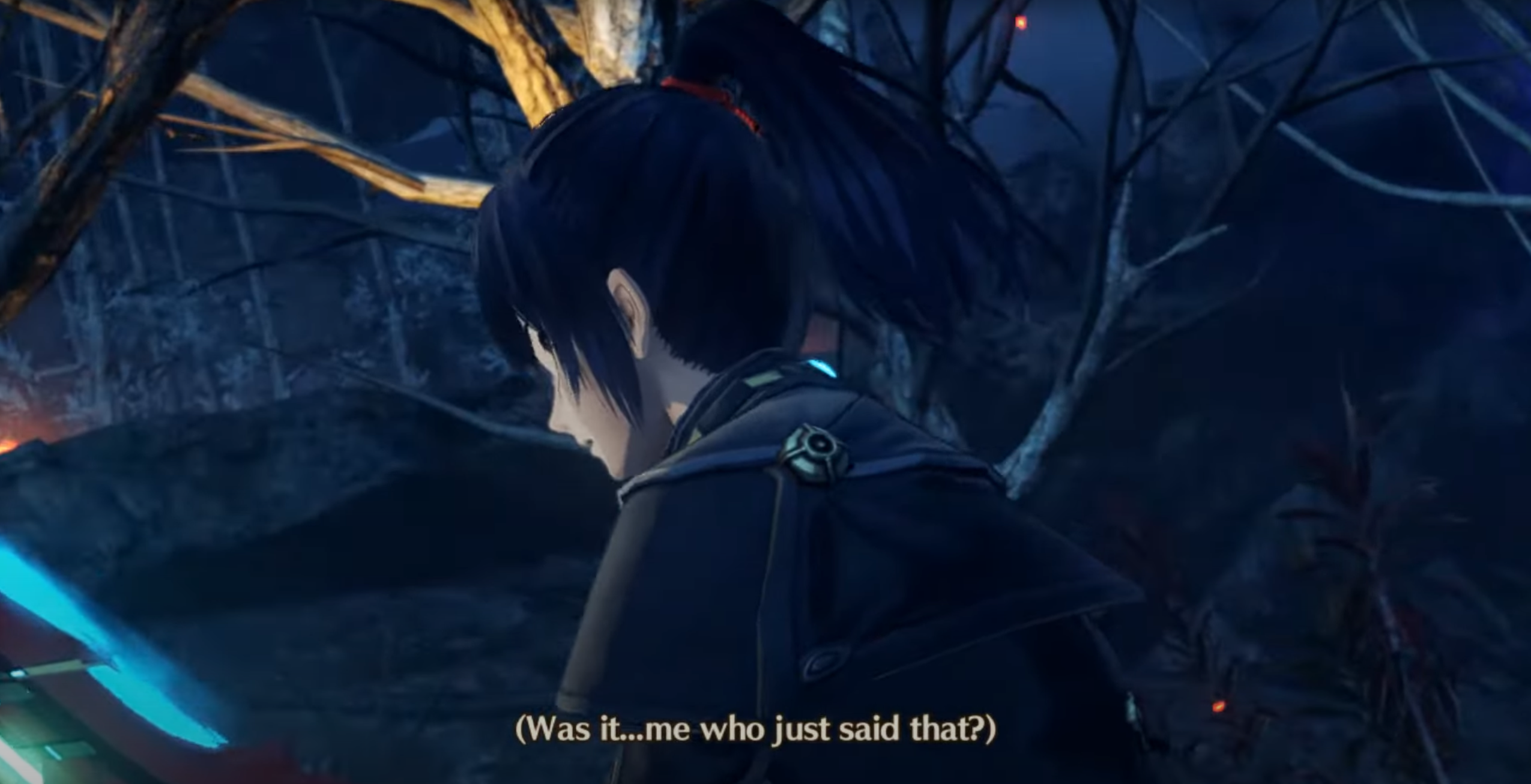
Noah, flustered by his inner speech.
Once we start to see the flexibility of our relationship to the world of Xenoblade Chronicles 3, elements of the game we might write off in other contexts only serve to broaden that flexibility. Other games might have conditioned us to separate in our mind the idea of a “game” as “the thing in a video game that we play” from the “story” as “content mostly presented through non-interactive, cinematic cutscenes”—particularly in the case of long, cutscene-rich JRPGs such as Xenoblade Chronicles 3. Yet, look at the content of those cutscenes: many of them focus on Ouroboros diving deep into the minutiae of strategy for the upcoming leg of their journey, free of any input from the player, such as:
- when they plan the infiltration of Keves Castle[391]
- when they deliberate on which route through Dannagh Desert to take[392]
- planning their tactical imprisonment within, and escape from, Li Garte Prison[393]
- Ethel’s guidance on reaching Swordmarch from Colony 4[394]
- coordinating the collection of Origin Gears to complete Samon’s ultimate vessel, the Bravery,[395] and planning the penetration of Origin itself, with Nia’s help[396]
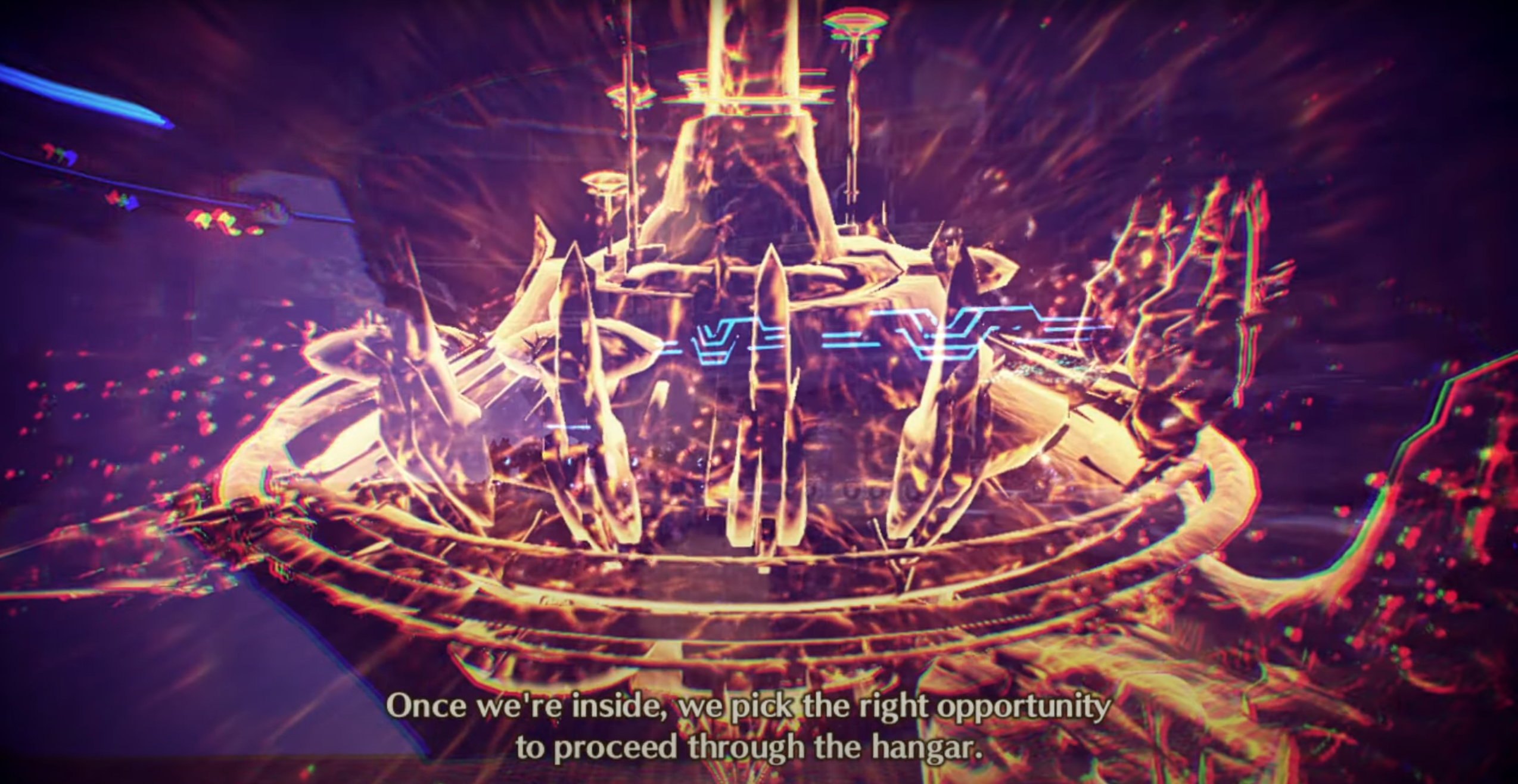
Noah walks through the Keves Castle infiltration plan with Ouroboros on the final approach to the Castle.
When they’re not discussing their next moves, they’re debating and interpreting previous moves:
- Mio interprets—and identifies with a certain interpretation of—M’s smile and last words (“It’s been fun… Noah”[397]) when discussing them with Noah after the fact,[398] and the expression of this interpretation to N is one of the linchpins in Ouroboros’ final confrontation with N, convincing him to join with Noah.[399]
- Commander Isurd uses Nimue’s past utterances about Taion to encourage Taion to adopt a different interpretation of the Colony 13 ambush that led to the defeat of Colony Lambda and Nimue’s death, challenging his view of himself as a coward.[400]
- Noah’s personal motivation for confronting Crys once Crys joins Moebius (besides acquiring the Origin Gear) is a need to understand what Crys meant to express by telling Noah “I’m good here” and choosing his moment of demise on the battlefield;[401] Noah’s subsequent understanding of his own reasons for fighting come from his realizing—after debating with Crys the nature of Moebius, Ouroboros, and contentment with one’s lot—what Crys had been expressing with those words and that action.[402]
- Noah’s choice to interpret Ouroboros’ killing of Joran’s mudpuppets as something that warrants atonement is itself interpreted in conversation between Riku, Lanz, and Sena as Noah and Mio see the mudpuppets off.[403]
- The final confrontation with J, along with the saving of Joran, is largely a debate over the meaning of Joran’s sacrifice back in Colony 9.[404]
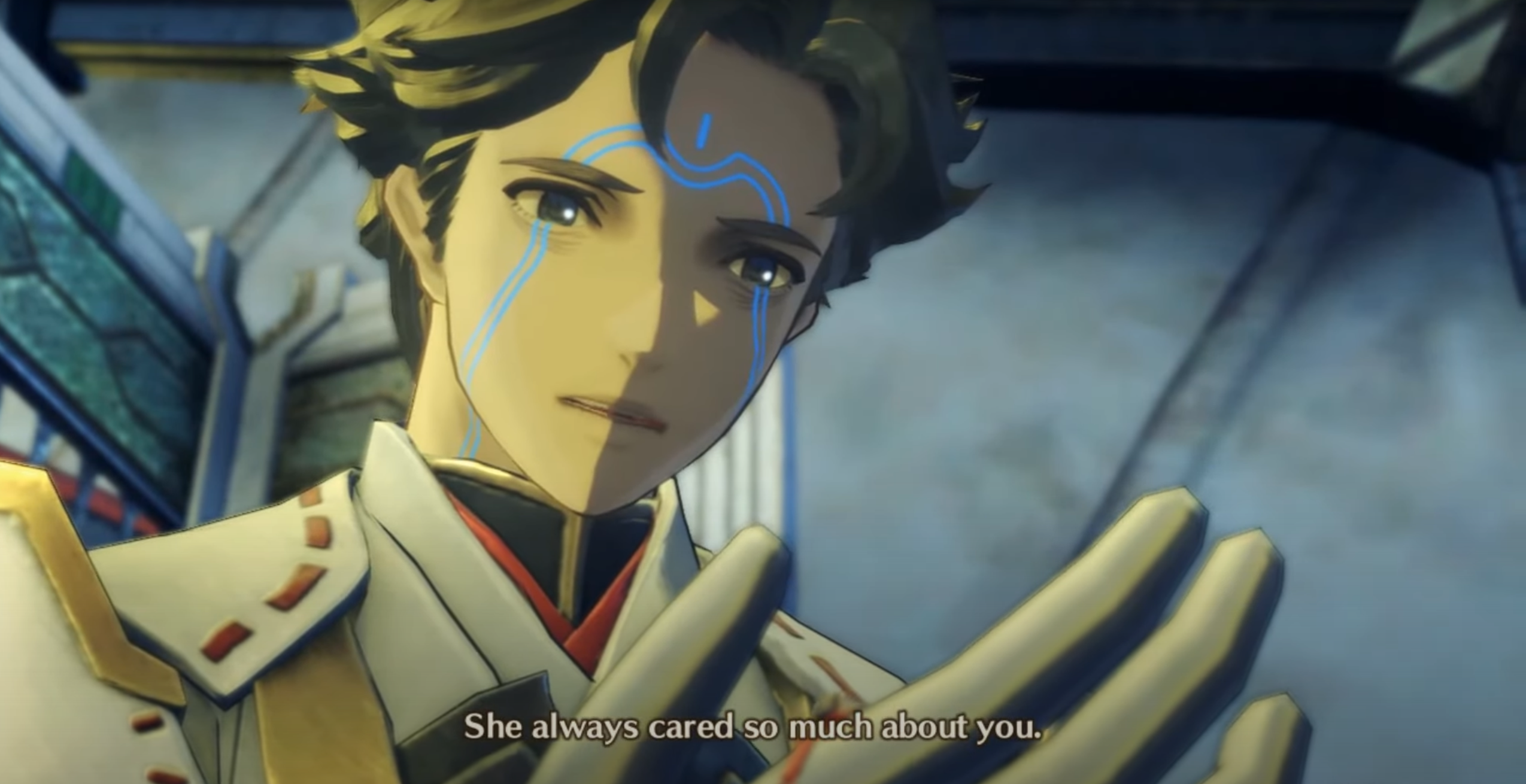
Commander Isurd reminisces about Nimue and quotes her words about Taion in a language-game to get Taion to accept a different interpretation of his past.
Where we might typically take the actions of avatars to constitute a video game’s plot, with the direction and interpretation of those actions largely left up to the player and consumer of the story, the characters of Xenoblade Chronicles 3 show us countless times that they are able to make those decisions and interpretations though conversations with each other (S1, C1). That’s not to say that the player has no place in Xenoblade Chronicles 3: only that, unlike Z (despite his efforts to the contrary), the player has no place in Aionios. Our act of watching characters deliberate in cutscenes is just as much a part of the game’s story and a thread within the tapestry of our forms of involvement in that story as our act of pushing buttons to bring about certain events in the world during a battle, an instance of the party exploring the world, etc. Neither has priority over the other in our understanding of the world and its people (S3, C2, C3).
What is constant about our involvement in the game is that we are engaging with it as a story that is being expressed to us—and it’s in the context of this game that we’re able to confer Wittgenstein 2’s absolute safety, the religious form of life, to the avatars (S12, C2).
Remember that the feeling of absolute safety is ungrammatical according to our ordinary uses of the term: the physical world just doesn’t matter as a factor to the safety of someone who is absolutely safe, whereas ‘safety’ is ordinarily used in relation to susceptibility to one physical danger or another. In Xenoblade Chronicles 3, as in many video games, we have an analogous case. When we think of a character in the context of its world, there are many measurable ways in which it can be hurt (typically measured in specific numbers of HP, status ailments, etc.) and ways in which a character can be safe in relation to those potential harms. Yet there is also a sense, perspective, and game in which some of these characters are safe without relation to any of those dangers—that is, the player’s perspective of playing the game and proceeding through its story, within which context (in many cases, including Xenoblade Chronicles 3) a character can be fatally injured any number of times and still persist, unimpeded, as the player continues progressing that story. K, for instance, can “play around”[405] with Ouroboros by wiping them out over and over again—yet these efforts go no distance toward impacting Ouroboros’ involvement in the story; the player’s capacity to mechanically overcome the fight is the only consideration in the story’s continued advancement in this sense, and that, too, has no bearing on Ourooros’ safety within the story.
None of this makes absolute safety an intrinsic feature of video-game avatars: there are many video-game stories in which avatars die in the story and never return (pick your favorite permanent character death, none of which I’ll risk spoiling, as an example); there are also many video games that represent player-avatar relationships which we might want to interpret (as I often do, as we saw above in the cases of Xenoblade Chronicles and Xenoblade Chronicles 2) as implying some kind of metaphysical dependency between avatar and player, in which case the nature of ‘safety’ between the player’s perspective and the perspective of the avatar in the world can become more complicated and blurred, with a different grammar that may not easily afford ‘absolute safety’ a seat at the conceptual table. But Xenoblade Chronicles 3 doesn’t contain either of these defeating conditions: none of the avatars permanently die (despite Sena and Lanz’s attempt at this kind of sacrifice[406]), and the player, we’ve seen, is held at a distance from any suspicious notions of metaphysical dependencies. Despite the inclusion of a mechanism according to which something like Ouroboros could be permanently erased—the annihilation that comes from maintaining an Interlink for too long[407]—it is literally impossible for this to happen to Ouroboros in the context of the player’s game, since the Interlinked heroes always automatically disengage the Interlink with safe timing if the player doesn’t instigate the disengagement earlier.
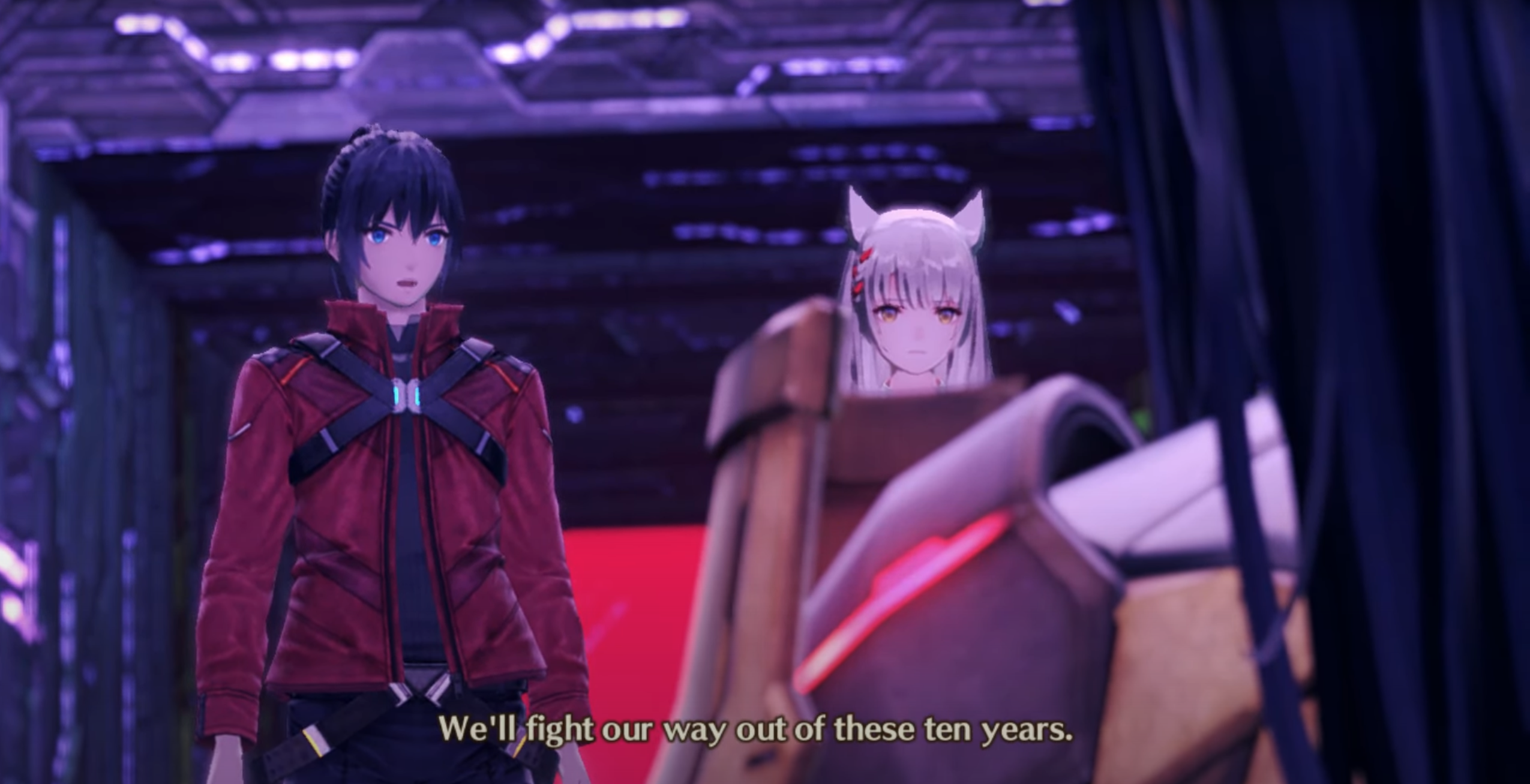
Noah matter-of-factly stating, to N, Ouroboros intent to persist, no matter what, until they defeat Moebius.
The player is therefore able to give her avatars, like the King of The King and the Dark Chamber, that incomparable thing which is also within herself:[408] in this case, the capacity to relate to Xenoblade Chronicles 3 as a video-game story. By virtue of sharing this context with the avatars, the avatars are able to participate in a form of life according to which they are absolutely safe—an element of their existence that might serve as a useful interpretation through which to unify our own dogged pursuit of completing an arduous, long journey in playing the game, and Ouroboros’ dogged pursuit of releasing the world from Moebius.
The upshot of this relationship for the player of Xenoblade Chronicles 3, I think, is that she’s able to free herself of any of the preconceived attachments to specific avatar relationships which she might have held and instead distribute her attention and focus without bias across the wide arrange of life on Aionios, seeing other characters as worthy of focus intrinsically, not just in their relation to the avatars (C2, C3). Mechanically, Hero Quests may yield access to new Classes for Ouroboros, but it’s easy, with our previous contortions of focus loosened and undone, to engage those quests first for the reason of learning more about the Hero in question and their society, perhaps even forgetting (as I sometimes did) about the question of which avatar would inherit the Hero’s Class until the Inheritor was explicitly named at the quest’s conclusion. We might take it upon ourselves to speak to everyone throughout a Colony, even those bearing no relation to a Quest for the avatars, simply because the culture and evolution of the Colony interest us. We might go out of our way to have Noah and Mio see off fallen soldiers, even after the Colonies have been fully developed and the action has no further mechanical bearing on the story. We might be interested even at glimpses into Tirkin society—not because of its trade relations with Colony Tau,[409] nor because of the Unique Monster to fight in their home,[410] nor because of their involvement in increasing Ghondor’s Class Rank,[411] but simply out of fascination in learning more about the individuals of a type of monster that evidently has a culture sufficiently sophisticated to support a courtship plot.
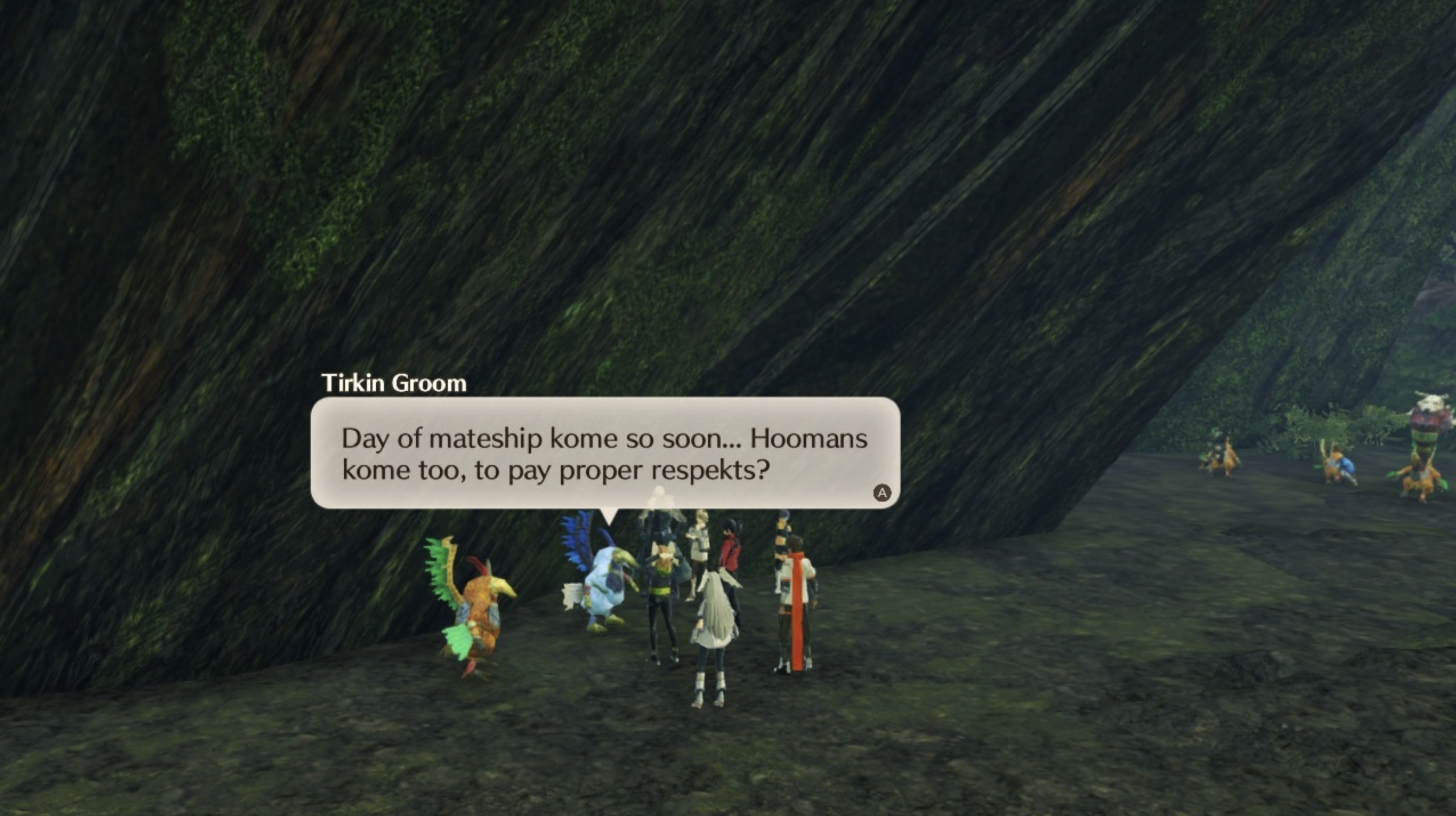
A Tirkin Groom attempts to mooch gifts off of Ouroboros.
The more we recognize all the potential entities deserving our attention, the more ways in which the game springs to life. It’s not a bizarre thing that certain chapters in the story are framed by particular avatars while others are framed by Heroes: we’ve acknowledged already how riveting Ethel and Cammuravi’s rivalry is; even if Moebius seeks to use that parasitically, we can still view it as a worthy expression and game on its own terms.[412] It’s not bizarre, either, after coming to invest in Heroes, NPCs, and even enemies on their own terms, that we might ask ourselves first what the characters want rather than what we, as players, prefer on the few occasions that we are called to make character-altering decisions in the story: regardless of whether we want another Flash Fencer Class in the party, does Ethel want to accelerate her maturation artificially after she’s been reborn and started a life in the City? Regardless of whether we prefer the aesthetics of long or short hair, what’s the right way to adjudicate the preferences of Mio and M after the two merge?
And, perhaps unsurprisingly, a funny thing happens: as it becomes easier for us to play our own games with these non-avatars, it seems as though it also becomes easier for them to participate in the religious form of life. Beyond members of Moebius, in whom the player can’t really logically invest,[413] there are very few instances of permanent death in the story. (Even the City, whose citizens are most apt to suffer from permanent death by virtue of not being reborn into Moebius’ cycle, is able to fully dodge a pointed attempt at annihilation during the story.[414]) That’s not to say that the player is somehow causally responsible for the safety of everyone within the plot! Rather, it’s an observation that the grammar of the language-game that the player plays in this context, the one within which it’s grammatical to say that characters are absolutely safe, is refreshingly open when it comes to the question of who is allowed to play it (S9, S8, C2, C3).

The Nintendo Switch Pro Controller. Photo by author.
It’s a perfect marriage of form and content to see Wittgenstein 2’s model of God cultivated in the player of Xenoblade Chronicles 3 on the Switch. The controller itself sports a dedicated button for capturing pictures and videos from the game you’re playing, quietly encouraging you to structure a picture—or collection of pictures—through which to hold your experience of the game captive, thinking first of an interpretation or particular sentiments you brought to the world and not about what you are actually doing within that world. The game also features its own “Amphitheatre” just for the player: that same Event Theater which I’ve been citing all along. Yet that button is just a single button on a controller sporting myriad buttons that let you execute all sorts of actions within the game, and the Event Theater is just one way of experiencing the content of a game that contains multitudes.
As with Wittgenstein 2’s view of Wittgenstein 1’s model of language, the picture itself isn’t somehow “incorrect”: it only fails when it’s taken to be the totality of meaning-making, rather than one more game we can play with language—one more button we can push to do something. Wittgenstein 2 guides the speakers of language back to their uses; he guides the player back to her actions, and she finds in them a refreshing plurality of ways to engage with characters that are safely enfolded within her story, her game. This prepares for the player the grammar of the words “enlightened empowerment,” which she will be fully equipped to use by the end of the game.
§2.22: Queens of Aionios, Architects of Trinkets
How could God express the history of his past—his life before creating the world—to those who live within his world?
It’s a puzzling question to understand, but it drives to the heart of how overlapping backgrounds and cultures are a prerequisite for sharing our worldviews and playing our language-games with each other (S8, S2). It also drives to the heart of a real challenge Queens Nia and Melia face upon awakening and interacting with Ouroboros—providing us with a foothold for interpreting the language-games they choose to play with them.
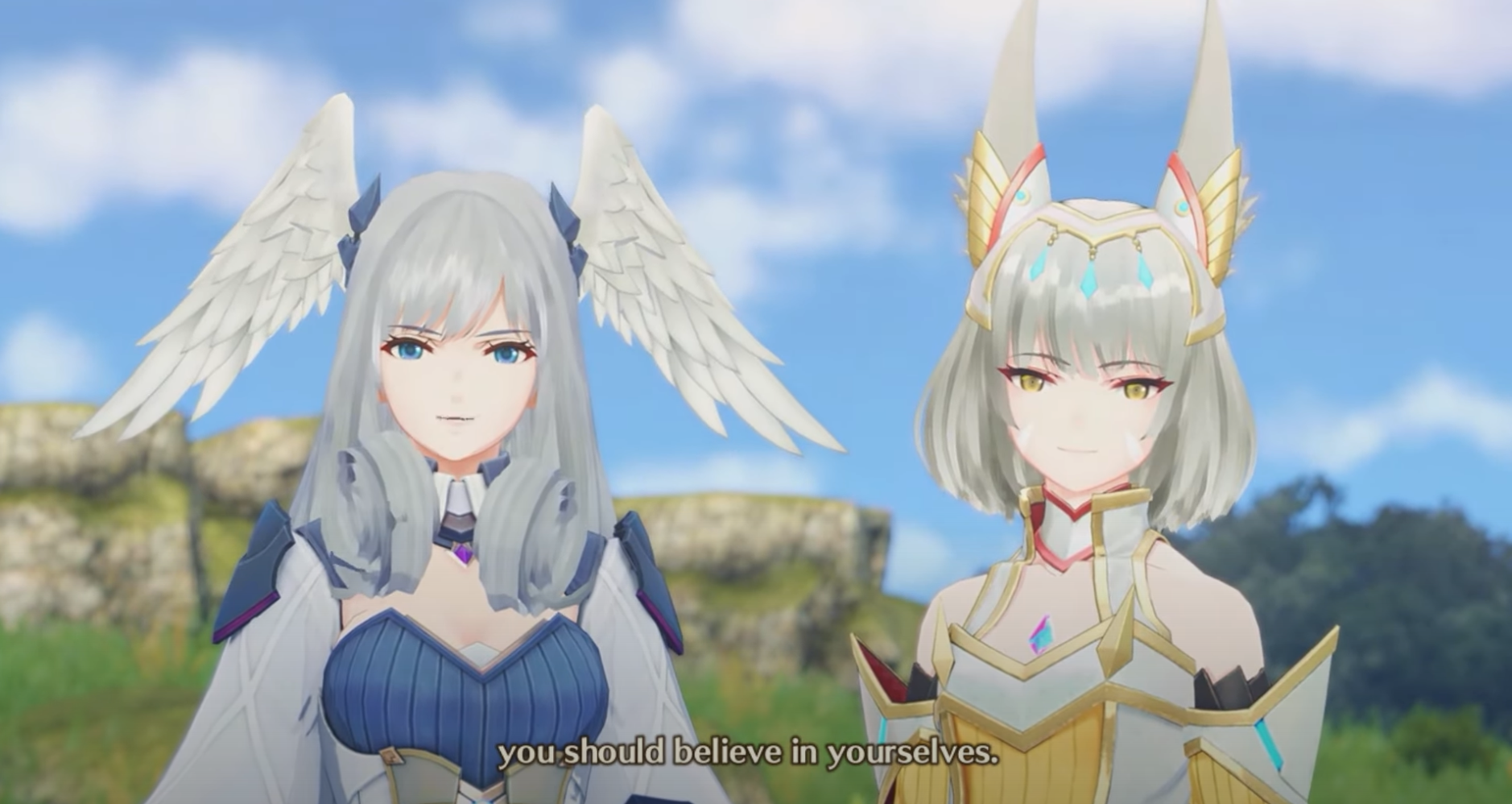
Melia’s final words of advice to Ouroboros, after the defeat of Z and Moebius.
To me, there’s an uncanny quality to the experience of a player who’s played Xenoblade Chronicles and Xenoblade Chronicles 2 and encounters Nia and Melia as they present themselves in Aionios. This player knows that these 2 characters jointly understand the vast majority of the world history that’s been intermingled in the landscape and lineages of Aionios:
- Melia knows Keves Castle to have been the Alcamoth Imperial Palace she was born, raised, and coronated in. She knows herself to have defended it from Telethia, treason, Fog Beasts, and everything in between; she knows the legend of Bionis and Mechonis etched in stone within its Great Hall, and the knows the part she played in ending that legend.
- Nia knows why the Urayan Mountains “happen” to be shaped like a sort of Titan that could swallow you whole, and she remembers the Saffronias that once adorned its capital of Fonsa Myma, a natural beauty belying the country’s preparations for war. She knows why Ghondor, Monica, and Guernica all remind her of a Urayan man who sacrificed himself to teach Rex, Nia, Tora, and their Blades the value of fighting their own wars, awakening Mythra in the process.[415] She recollects the ruins populating Maktha Wildwood as the ruins of Morytha in her own time: the birthplace of Klaus, the home of humans-turned-abominations who fell as casualties of his ambition—a testament to the hubris that the Architect later sought to correct.[416]
We might expect, even be eager, for the Queens to introduce this history to Aionios, perhaps even adding another chapter to the saga of Klaus and Galea that was woven over the course of the Bionis, the Mechonis, and Alrest’s creation myths.[417] Yet they don’t offer this background: instead, time after time, they focus on the Ouroboros, their quests, and their understanding of their own world, leaving the stories of their homelands unsaid.
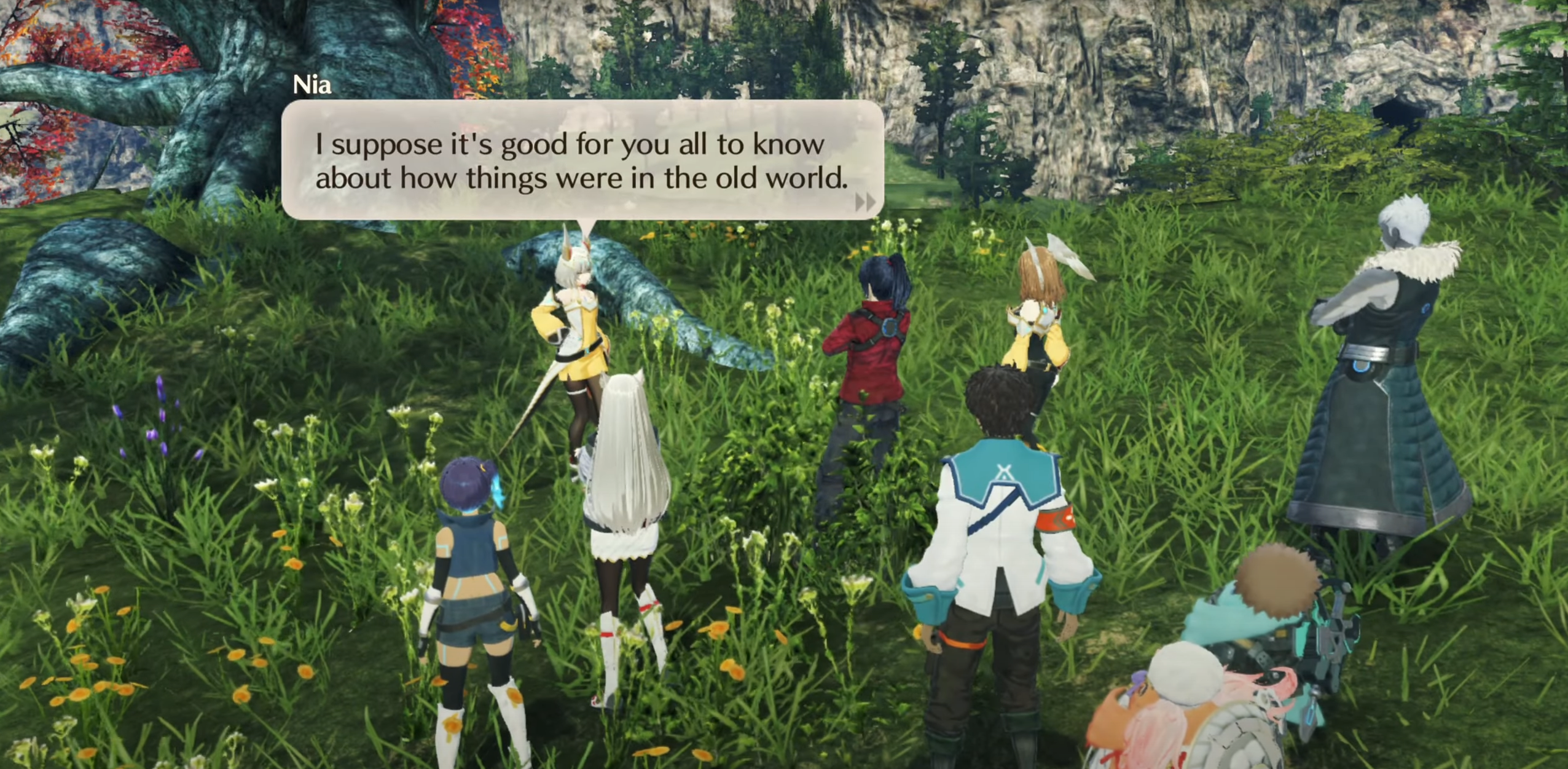
Nia, providing windows into Alrest and her journey, beneath a Saffronia tree.
Readers may note that Nia does explicitly discuss every single connection that I just mentioned with regard to her experience. Now, step away from your familiarity with Xenoblade Chronicles 2, and look at what she says, and doesn’t say, to Ouroboros:
- She tells them that Saffronias “used to grow in the world that I came from.”[418]
- She tells them that the Urayan Mountains came from her world, but were something less “picturesque” than mountains in that time.[419]
- To Ghondor and Ouroboros, she says that the name ‘Vandham’ and its bearers “have a deep meaning for me”: that “I…we…were saved by a man called Vandham. He taught us a lot about life, and what we were called to do. It’s no exaggeration to say that, without him, there would be no me.”[420]
- Of the ruins in Maktha Wildwood, she says that the story “goes back much further into the past” than the creation of Aionios—implying the world which Klaus split into Melia and Nia’s worlds—and tells a story of “people of that time who had access to absolute power,” who fought for control of it, doing so “because they were afraid […] of ‘ending’,” seeking to use their power to avoid the inevitable end of life, civilizations, and cultures: “going beyond the rules” in search of “‘eternity’.”[421] She says that the fighting caused the power to “[become] a calamity and [rip] the world in two,” saying that “the true meaning of all this ruin… is to stand as a monument to the history that created this world.”[422]
Nia doesn’t discuss Klaus, the nature of the Titans, Blades, and the Cloud Sea, the awakening of Mythra, Rex and his evolving relationships, or really anything that would embed the above connections within the context of Alrest and history before Aionios. None of this is to say that she is failing or deceiving Ouroboros and other Aionians. To the contrary: while the player (possibly) has the context to meaningfully discuss the above relationships with Nia with respect to the story of Xenoblade Chronicles 2, the people of Aionios don’t. To do so would be to try to have the kind of conversation Armstrong might have had with Moore about “stories of my adventures on the moon,” without first committing so much time to updating Moore’s river-bed of thoughts based on shared standards of evidence that whatever Armstrong had initially wanted to express would either have been lost or transformed once Moore was aptly positioned to understand him (S8).

Mio, drawing a connection after Nia describes the people of the ruins’ time as having destroyed themselves by seeking eternity.
Nia’s story of the ruins of Morytha is particularly illuminating here: the interpretation of the ruins in the language of ‘causing calamity by changing the rules in pursuit of an unnatural eternity’ invites Ouroboros to notice the family resemblance between these alien people, from a distant and inaccessible past, and Moebius, the common enemy whose Endless Now confronts everyone in the discussion equally (S2). This leads to Mio identifying the resolve “to keep moving forward, in spite of all that,” with “what it means to live,” which Nia affirms and encourages in them.[423] By offering elements from her own river-bed of thought—the history of Morytha that led to Alrest, and Aionios thereafter—under an interpretation that highlights an aspect of those elements that does not require a substantial revision of Ouroboros’ river-bed of thought, she is able to empower Ouroboros with a new perspective, a new language-game to play with the ruins in Maktha Wildwood (and the Saffronias, and the Urayan Mountains, and the Vandham name) (S9, C2, C3). Their agreement in the meaning of the ruins at the end of the conversation is evidence of, and the final court of appeal for, their having successfully played a new interpretive language-game together (S7).
Upon being freed, Melia tells Ouroboros, “This world is yours”:[424] by keeping the events of her memories “in the distant past”[425] and instead focusing on the “blue sky”—that which remains common between them, regardless of changes to the worlds[426]—Nia uses her past as a means of giving Ouroboros further tools for engaging with their world.
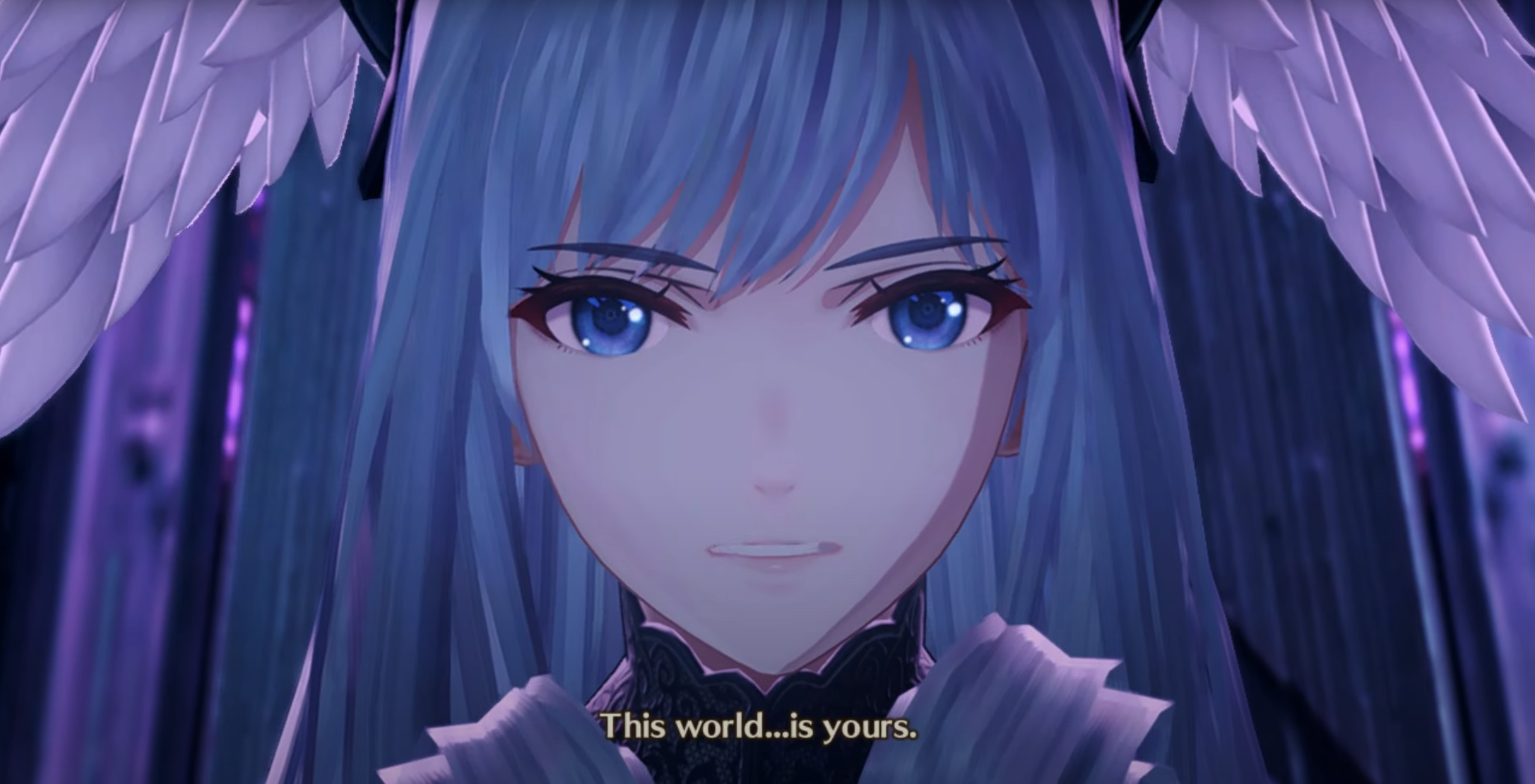
Melia, entrusting Aionios to the individual members of Ouroboros.
Rather than interpreting other elements of the world for Ouroboros, Melia provides a complementary approach to Nia’s: when the party sees her again after liberating her from Moebius, she joins them as a party member, in the sense of going out into the world and acting, interacting, and ruling in the same spirit that the player recalls her doing so in Xenoblade Chronicles and Xenoblade Chronicles: Future Connected. Where Nia reinterpreted the party’s past journey through the world, Melia helps to enact the world’s future:
- She relishes the opportunity to engage with the “real human activity of the City,” speaking with the citizenry as she might have spoken with the residents of a rebuilt Colony 6 on Bionis as they looked to their own future.[427]
- As a ruler, she bears the duty of accepting the hatred of the defected Colonists who broke after losing their purpose in life, and she challenges them to find their own, new truth,[428] in much the same way that she once bore the duty of killing Tyrea’s birth mother, Yumea, after Yumea became a Telethia.[429] By killing Yumea, she spared Tyrea the pain of having to kill her own mother, paving the way for Tyrea to overcome her resentment of Melia and ultimately support her—much as the defectors, thanks to Melia, have a fresh opportunity to build lives of their own.
- She rushes to the aid of an imperiled Colony 9 detachment, just as she rushes to the front line to defend Gran Dell’s breached ramparts against a Fog Beast in the post-Zanza world of Bionis—in both cases, never considering instead issuing orders from a distance as a ruler.[430]
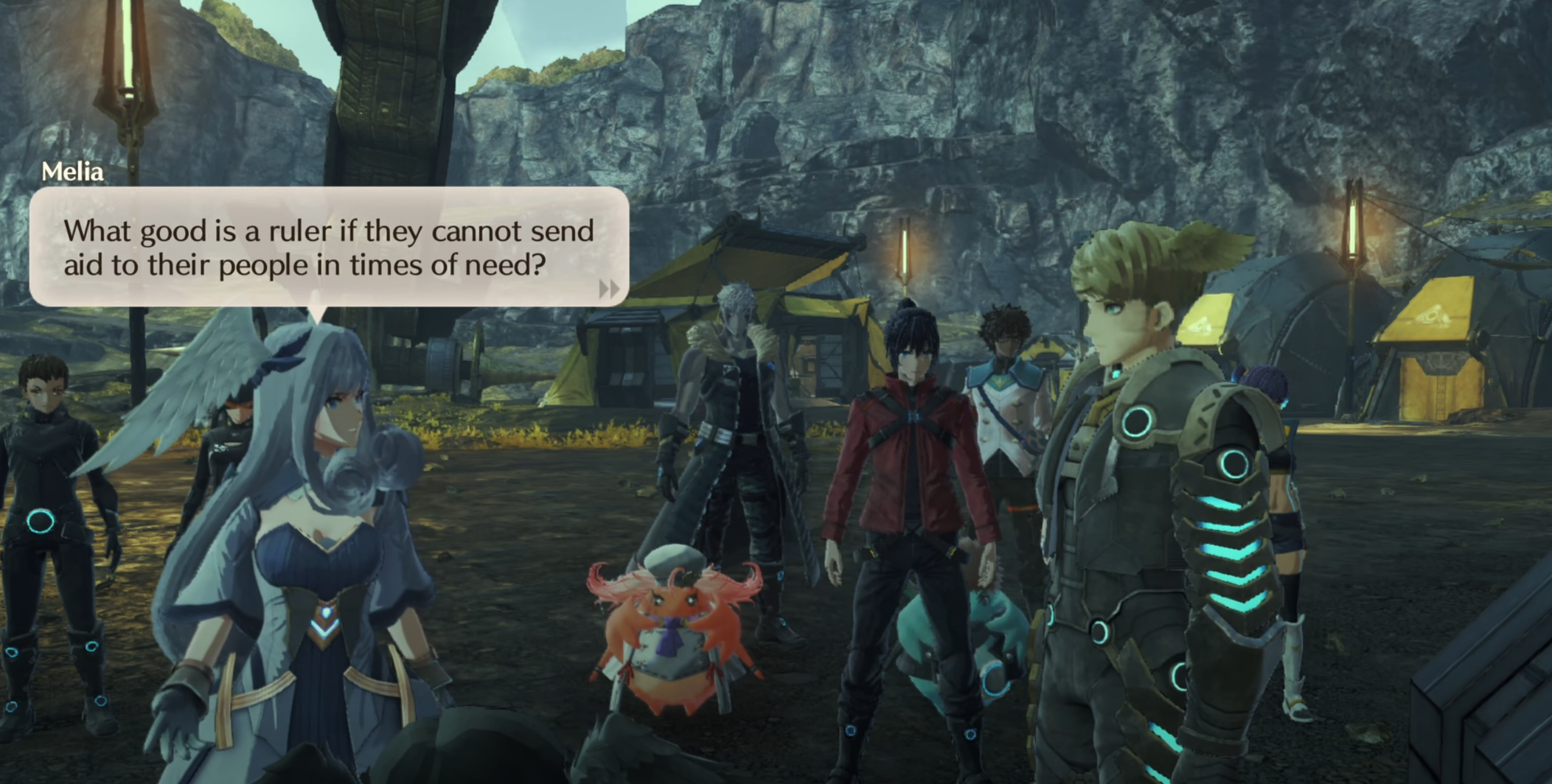
Melia, being characteristically “Melia” as she rushes to the aid of Colony 9.
Ouroboros seems responsive, too, to this different balance of actions and words: in contrast with their engagement with Nia, members talk to themselves rather than to each other or to the subject of their thoughts. As Noah and Mio reflect on Melia’s actions and the apparent depths of her past hardships, they do so silently; it’s only once Melia relates her apparent disregard for her own well-being to her actions, expressing her willingness to die for the world, that they vocalize these thoughts in a defense of her value to them and the world.[431]
“An ‘inner process’ stands in need of outward criteria,” and it’s only Melia’s outward expression of an intention that introduces that “inner process” of hers into the language-game.[432] It’s this process on display in the conclusion of her Ascension Quest—the expression of an intention, the discussion of it with the party, and the feedback loop into her updating her intentions to actively shape the future in a self-honoring way—that underscores exactly how Ouroboros and their comrade will march forward “[t]o create…the future,” one quest at a time. [433]All the steps are not already taken:[434] the future must be planned and taken at each step into the future by its shapers agreeing on the rules by which they are to proceed (S6, S7, C1, C2, C3).
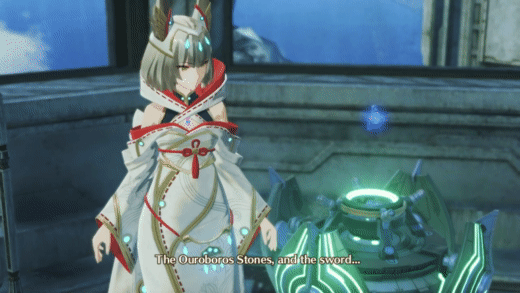
Nia describes the Ouroboros Stones and Sword of the End as “mere gimmicks.”
After Nia offers the closest we get in Xenoblade Chronicles 3 to an explanation of the world—her story of the merging of the worlds, the creation of Aionios, Z’s hold over Origin, and the origin of Ouroboros Stones and the Sword of the End—she gently redirects Taion after he takes the first step toward composing a theory out of these events and tools.[435] She tells them that Ouroboros Stones come from catalysis between Origin’s materials and her Core (as above, with no further discussion of Blade Cores, Flesh Eaters, etc.), her method of resisting the Endless Now’s hold on Aionios; she then tells them that the sword Noah holds “is a byproduct of resonance… between the Kevesi Queen’s heart, and Origin.”[436] As we ourselves might have been inclined to do, Taion immediately poses the question of whether the sword, in that case, is “like an Ouroboros Stone”:[437] given the similarity of the processes by which they were created, do they share some kind of essence—something, perhaps, that metaphysically transcends the laws of the Endless Now? Nia responds that the objects are mere “gimmicks,” tools—and that “the crux of them” lies with the members of Ouroboros, who have keys to the Origin’s memories within them, as the Queens do.[438]
To my mind, this dialogue captures the overlap between the games Melia and Nia play with Ouroboros, and the role they play as an embodiment of Wittgenstein 2. Our relationships with the thoughts, wills, and lives of others—whether in our current moment in the world, or in interpretive conversation with those who came before us, only have meaning in terms of what we do with them: as Melia tells Noah, “the wielder decides” whether his Sword “[p]rotect[s] the now, or carve[s] a path to the future” (C1).[439] Don’t ask what the nature of the keys is, nor how they metaphysically connect expressions of those from Bionis, Mechonis, and Alrest with those of Ouroboros: look and see what Noah, Mio, Eunie, Taion, Lanz, and Sena do with these mechanisms that the Queens created to facilitate conversations, whether between Interlinked parties or Ouroboros and people in Origin (S1, S10, C2). Don’t seek biological evidence for a mother-daughter relationship between Nia and Mio: look and see what sorts of language-games they play with each other, and ask whether their forms of expression have a family resemblance with other examples of “motherhood” Ouroboros discovers in the City—and, perhaps, ask yourself, “Whence the impulse to seek something more essential than that?” (S2, C3.)
The Queens give neither Ouroboros nor the player a metaphysics with which to overcome the Endless Now. For all their history with the world’s creation and worlds beyond it, all they offer are new language-games. But new language-games are all they need to offer in order to topple Moebius’ house of cards.
§2.23: Private Conversation: How Ouroboros Destroys the World
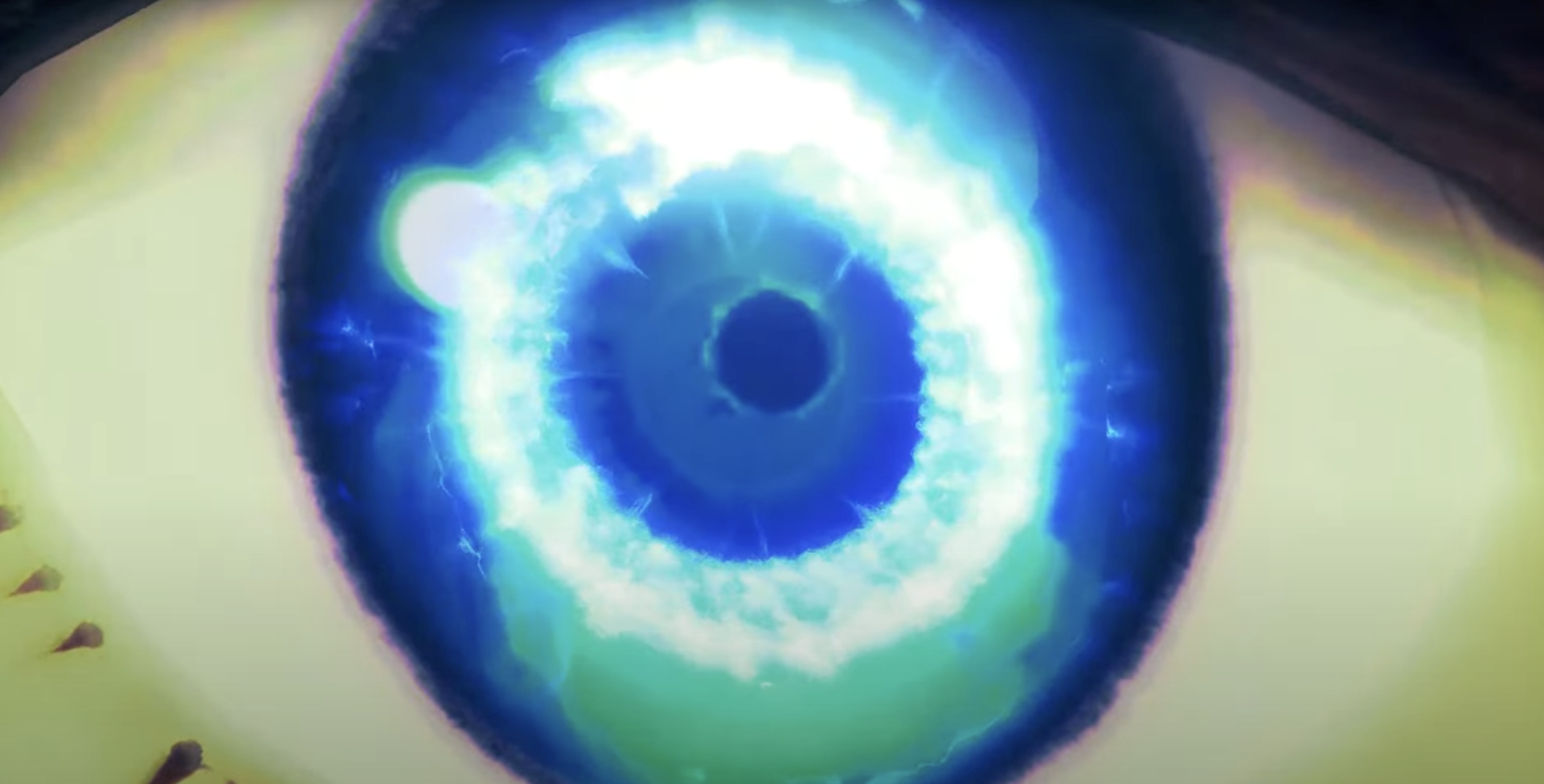
The Ouroboros Iris manifesting in Noah’s eye following the activation of Guernica’s Ouroboros Stone.
Where the symbology of Moebius, the Möbius strip, is intrinsically paradoxical, the symbology of Ouroboros, the snake eating its own tail, is intrinsically unstable. The snake is on the brink of consuming itself, of annihilating its entire being—yet, in so doing, it manifests the distinctly stable unity of the circle, a shape with a geometric symmetry otherwise unavailable to the snake.
Like the Queens’ trinkets, the symbology of Ouroboros is most useful to us when we view it in relation to the actions it makes possible for the party. In the context of Wittgenstein 2, these actions are coordinated through 3 of the threads we focused on above: (no) private language (S4, S5), river-beds of thought (S8), and aspect-seeing (S9).
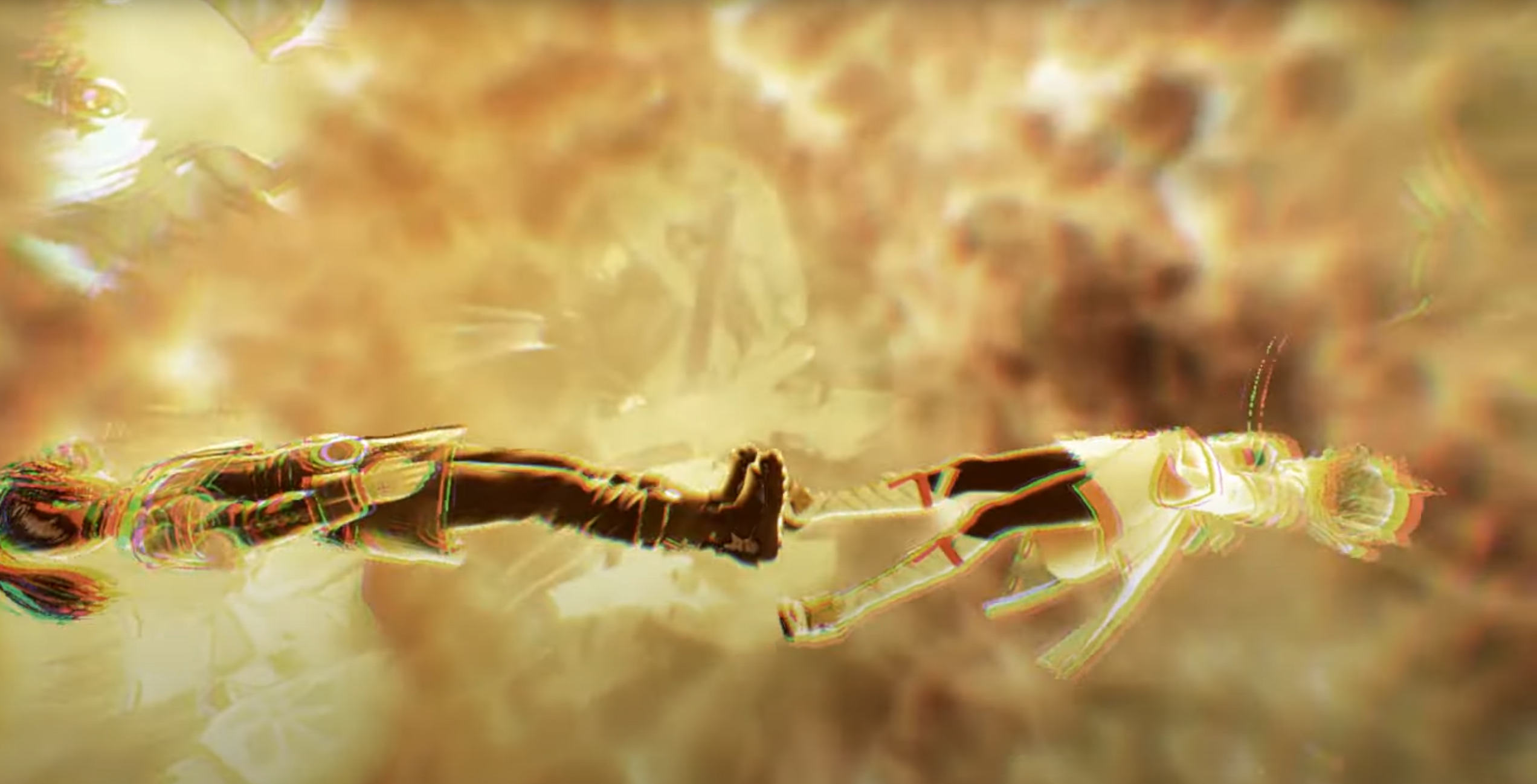
Noah and Mio see glimpses of each other’s past for the first time as they merge into an Interlink.
If Wittgenstein 2 were to devise a language-game within a video-game story to show the impossibility of a private language, it might resemble Ouroboros’ Interlinking process. In a world where Moebius makes it easy for its pawns to share many aspects of their experience instantly and at a distance with each other, such as voice communications and visual representations of maps and objects, it’s easy to feel as though there’s some deeper realm of one’s experience beyond the realm of public accessibility:
- To this realm belong the “essential memories” of Crys, Joran, D, Miyabi, Mio, Nimue, and Isurd which form the heart of Noah, Lanz, Eunie, Mio, Sena, and Taion’s personal traumas.
- To this realm belongs the inner voice that Noah can’t even recognize as his own, telling him he ought to run from battle.
- To this realm belongs the emotional solipsism of Wittgenstein 1, inferring from the proposition that ‘the world is my world’[440] that one’s experience of the world is fundamentally unutterable to others.
Yet this is the exact realm which the phenomenon of Ouroboros Interlinking shows to be shareable between people: those core traumas of Ouroboros’ members are the very subjects of the images shown to their Interlink partners upon joining together into a single form.[441] It calls to mind Wittgenstein’s discussion in the Philosophical Investigations of the ‘visual room,’ a representational picture of our experience of the world that “may obtrude itself upon us and be of no use at all.”[442] He imagines his interlocutor insisting on the sort of thing that Noah or anyone else within his cohort might insist on before becoming Ouroboros:
“But when I imagine something, or even actually see objects, surely I have got something which my neighbour has not.” — I understand you. You want to look about you and say: “At any rate only I have got this.” […]
I know how one stares ahead and looks about one in this case — and the rest. I think one can say: you are talking (if, for example, you are sitting in a room) of the ‘visual room’. That which has no owner is the ‘visual room’. I can as little own it as I can walk about it, or look at it, or point at it. […]
The visual room seemed like a discovery, as it were; but what its discoverer really found was a new way of speaking, a new comparison, and, one could even say, a new experience.
You interpret the new conception as the seeing of a new object. You interpret a grammatical movement that you have made as a quasi-physical phenomenon which you are observing.[443]
When Noah and Mio are embraced by the glow of their Interlink, it is as if Wittgenstein 2 were saying to them: “I know this ‘visual room’ that you insist upon in reference to your unspeakable experiences. But this room is only a way of speaking: something which obtrudes upon your life if you insist (like Wittgenstein 1) that it is reality, but something which you can use to discuss yourself with others in a particular way. Here, let me show you: I will put someone else ‘in’ the visual room with you.” Out of the fear that no one can share in their experiences, Ouroboros emerges into a fused form in which two people transparently have the same experiences in the world, peering out from the eyes of their Interlink.
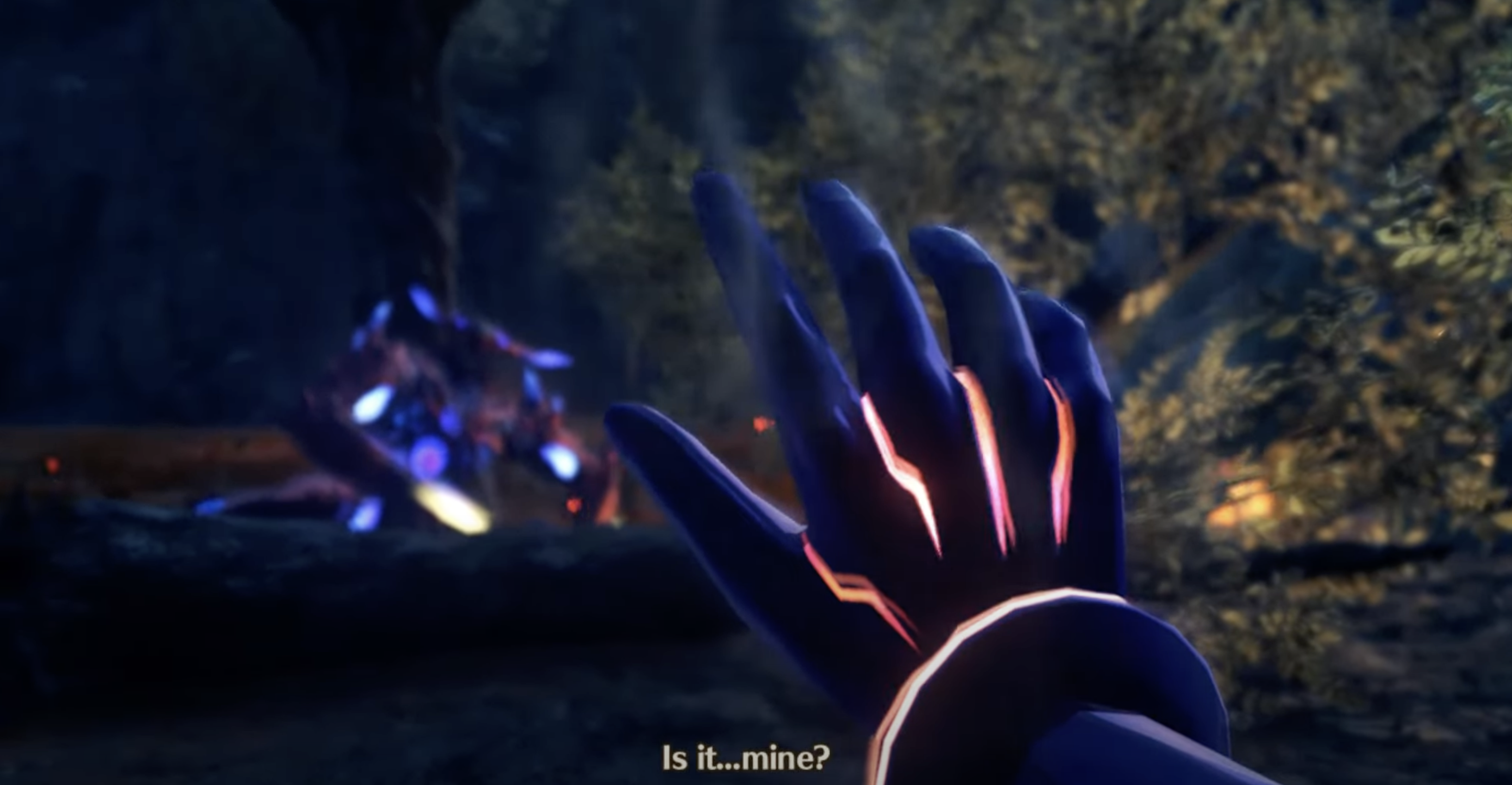
Noah and Mio identify “their” hand from the same visual field, sharing the most direct of experiences for the first time—probably not what Moore had in mind when he pointed to his certainty that he had hands.
That’s not to say that Ouroboros’ language-game facilitates an immediate, intimate understanding of another person’s life. Language can’t do that; all the same, certain ways of speaking can facilitate the development of relationships through more robust ways of getting to know each other. This is exactly what we see in Ouroboros: where once there were the fear and isolation of a private language, Interlinking presents a path to connection through conversation.
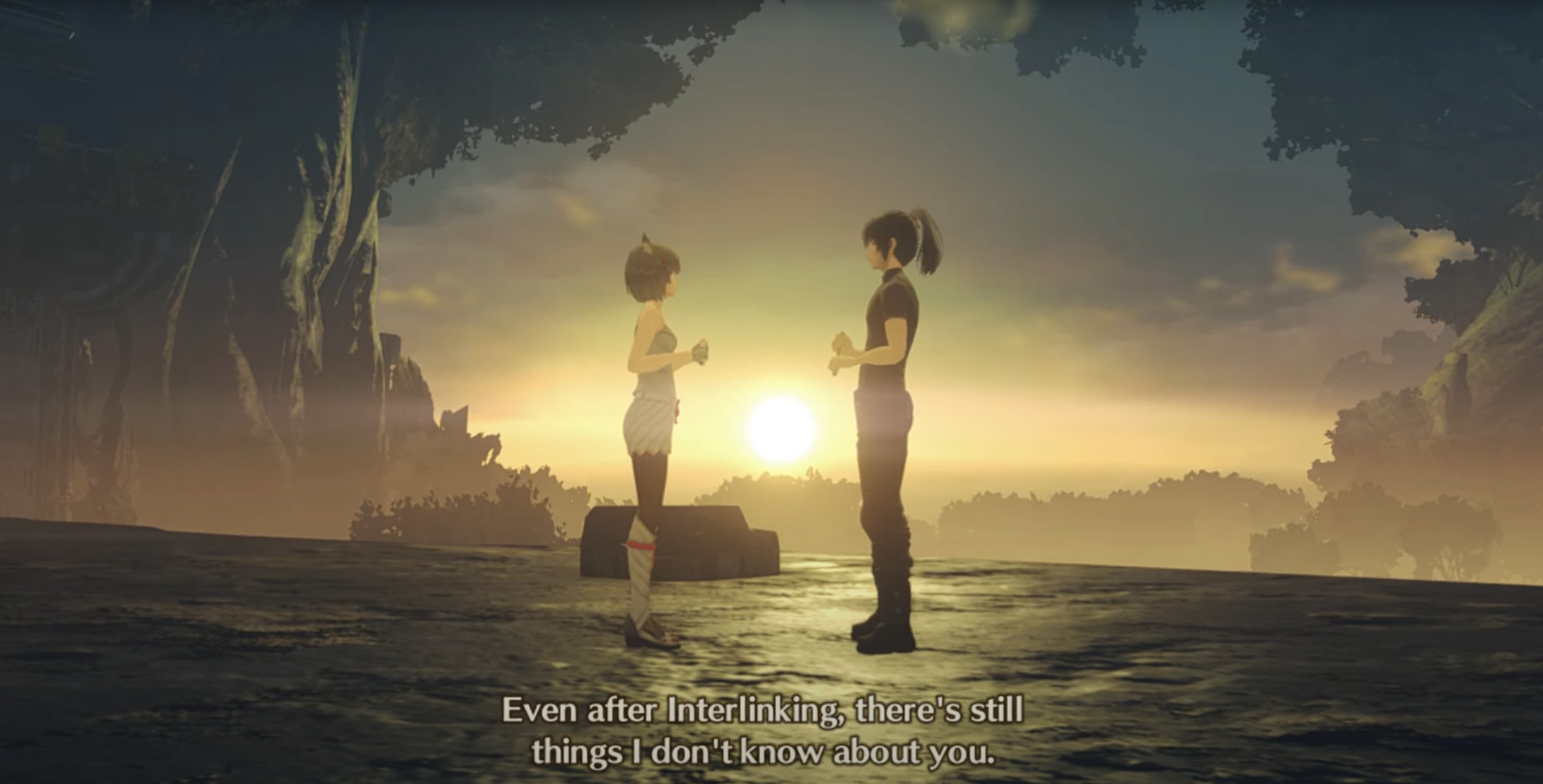
Noah, after exchanging flutes with Mio and hearing her speak about her experience with Miyabi, from whom she inherited her flute.
Noah’s progressive discovery of Mio’s experience with Miyabi exemplifies this. Glimpses of Miyabi are among the first things Noah “learns” about Mio in the images presented during their Interlink, though he has no context within which to situate them. Still, the demonstration of that capacity to interact with the interiority of another paves the way for further conversations and different kinds of conversations, through which Noah can come to know Miyabi in a new context, situated within his evolving relationship with Mio. After Mio lashes out at Noah in a fit of fear and anxiety about her looming Homecoming date, she comes to him and tells the story of how she inherited Miyabi’s flute—a story that gives Noah a further glimpse into those formative times in Mio’s life, but also a story which Mio uses as a way of expressing to Noah her feelings about the limitations of lifespan and the importance of a legacy, culminating in their exchange of flutes (an exchange that, in this context, strikes me as more intimate even than their kiss preceding the separation of worlds at the game’s conclusion[444]).[445] Mio’s history later takes on a more public and candid form of expression when she has the opportunity to return to Colony Omega, and—with the permission of Sena, another conversational participant who has an existing stake in what is being expressed—conveys a more detailed account of the story to the entire party in order to convey why Miyabi and returning to Colony Omega matter to her.[446]
This progression is a microcosm of what Ouroboros does: it (1) breaks down the extent to which its participants are bound by emotional solipsism, (2) facilitates new modes of conversation about previously unutterable content between those who are apt to Interlink with one another, and (3) cultivates its participants’ capacity to discuss that same content in more public language-games with less intimately related participants. Mutatis mutandis, for instance, with Sena progressing from sharing glimpses of her life with Lanz in Interlink,[447] to reconceiving her sense of “weakness” as the positive trait of having “recognizing your own purpose,”[448] to rejecting Shania’s suggestion that the two of them are similar,[449] to gaining Lanz’s support in trying to jointly sacrifice themselves in order to save the team—and demonstrate their strength of character—by annihilating N.[450]
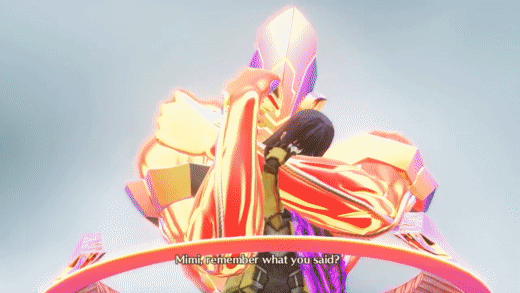
Sena, making a new interpretation of Mio’s old words of encouragement.
Step 3 of this process—the step by which Ouroboros becomes a cohort capable of influencing the world in the way they have developed amongst themselves—is the critical step in overcoming Moebius and the Endless Now, and it wouldn’t be possible without Steps 1 and 2 facilitating conversations between apt individuals. This doesn’t mean people who have somehow been coordinated across space-time between Keves and Agnus to satisfy the desiderata of Ouroboros candidates, nor anything else so metaphysical: rather, it refers to people having sufficient overlap in their river-beds of thoughts, and thereby being predisposed to acknowledge the self-directed sentiments of one another intuitively, not requiring further evidence or explanation of background context to achieve a preliminary understanding (S8, S9, C2, C3). Xenoblade Chronicles 3’s portrait of 3 Ouroboros pairs illustrates how this synergy of worldview is the principal factor in determining the capacity to Interlink as Ouroboros.
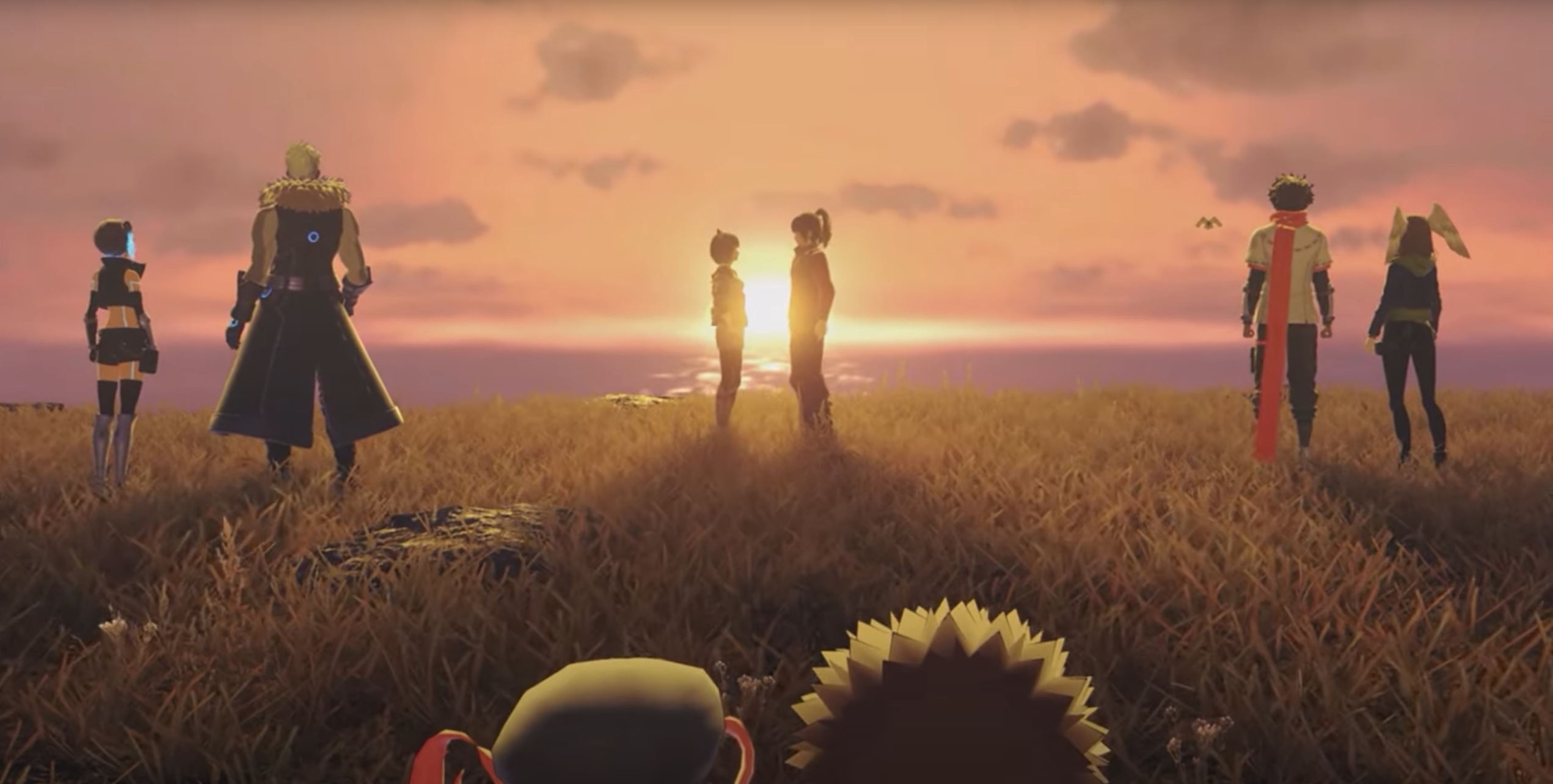
Ouroboros, paired off in their Interlinking partnerships, in anticipation of the separation of worlds following the defeat of Moebius.
To my mind, the game’s epilogue encapsulates both the distinction and unifying thread between our three Ouroboros pairs: love, where—as the City’s Storyspinner, Taleb, says—“love takes many forms. There are as many ways to show it as there are people.”[451] The pairs of Noah and Mio, Eunie and Taion, and Lanz and Sena all manifest love in different forms of life. Wittgenstein once wrote, “You can open yourself to others only out of a particular kind of love. […] It might also be said: hate between human beings comes from our cutting ourselves off from each other.”[452] This particular kind of love lives differently in different relationships, and cultivating it helps its participants to resist the hatred of “cutting ourselves off from each other”: Noah and Mio’s is an inevitable, romantic relationship; Eunie and Taion’s is a relationship that sustains itself ambiguously between romance and platonic friendship; Lanz and Sena’s is a platonic relationship.
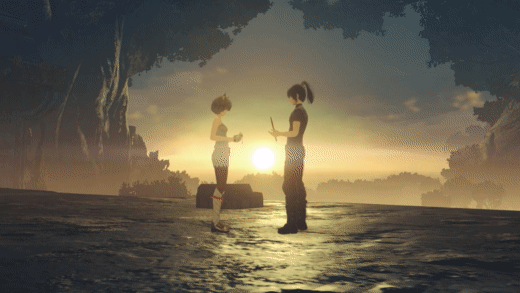
Noah and Mio exchanging flutes on their approach to Keves Castle.
We’ve already probed the extent to which Noah and Mio’s romantic relationship persists beyond Homecoming—to the point of garnering Z’s personal interest[453]—but music, central to the life of Wittgenstein and the perspective of Wittgenstein 2, is equally central to their relationship (S13).
From their moment of meeting on the battlefield before Guernica, the off-seers embody their preferred mode of “conversation” as Mio codes her movements to the rhythm of the Agnian off-seeing tune,[454] which Noah is able to study in his mind until he recognizes, “‘Now at last it’s a dance’”[455]—joining in the dance, and the music, with her. As the story begins, Noah is a solo Kevesi off-seer with a dissonant voice in his head, and Mio is an Agnian off-seer who’s lost her partner to tragedy and inherited her instrument to play alone: in the absence of further context, it’s anything but likely that two such people would band together to compose the sort of duet that plays out across the rest of the game. As with the Beethoven and Wagner of Wittgenstein’s reflections, the two come to their melodies by way of inheriting different “field[s] of force”[456] from those with whom they previously had musical conversations: Noah learned to play under Crys, who sought to understand the connection between “[t]he sender, and the ones being sent,”[457] playing to express the difference between (for instance) a soldier who “probably felt content” and an off-seer who found the fixed termination of a life to be “quite a tragic thing”;[458] Mio cultivated her song under the older Miyabi, who sought to use her song to hear and send on the voices of the departed, seeking to honor not only those voices’ expression but also the unity of those who “fight to live” on Aionios, handed the same fate regardless of which side they’re on.[459]
These two perspectives are distinct yet complementary: between the two of them, they have the capacity to understand and honor the expression of a song’s subject, while simultaneously performing the song in an expression they know to be their own, interpretively separate from the subject’s (S14). While this synthesis of viewpoints sounds natural, it’s only possible in Aionios thanks to Ouroboros putting in conversation two people who participate differently in the same form of life: music.
Without enough shared sediment in two parties’ river-beds of thoughts, the experience of falling into a world of someone else’s thoughts would probably be as intelligible as Shakespeare was to Wittgenstein. With more overlap—say, both having grown up in the City, or both having many of the same friends—it might be possible to discern their thoughts enough to have productive conversations about them. With quite a lot of overlap, though—that is, if the two participate in the same form of life, interpreting their place in the world harmonically (S11)—then it would be as if their river-beds were those of two interconnecting streams in one braided river.
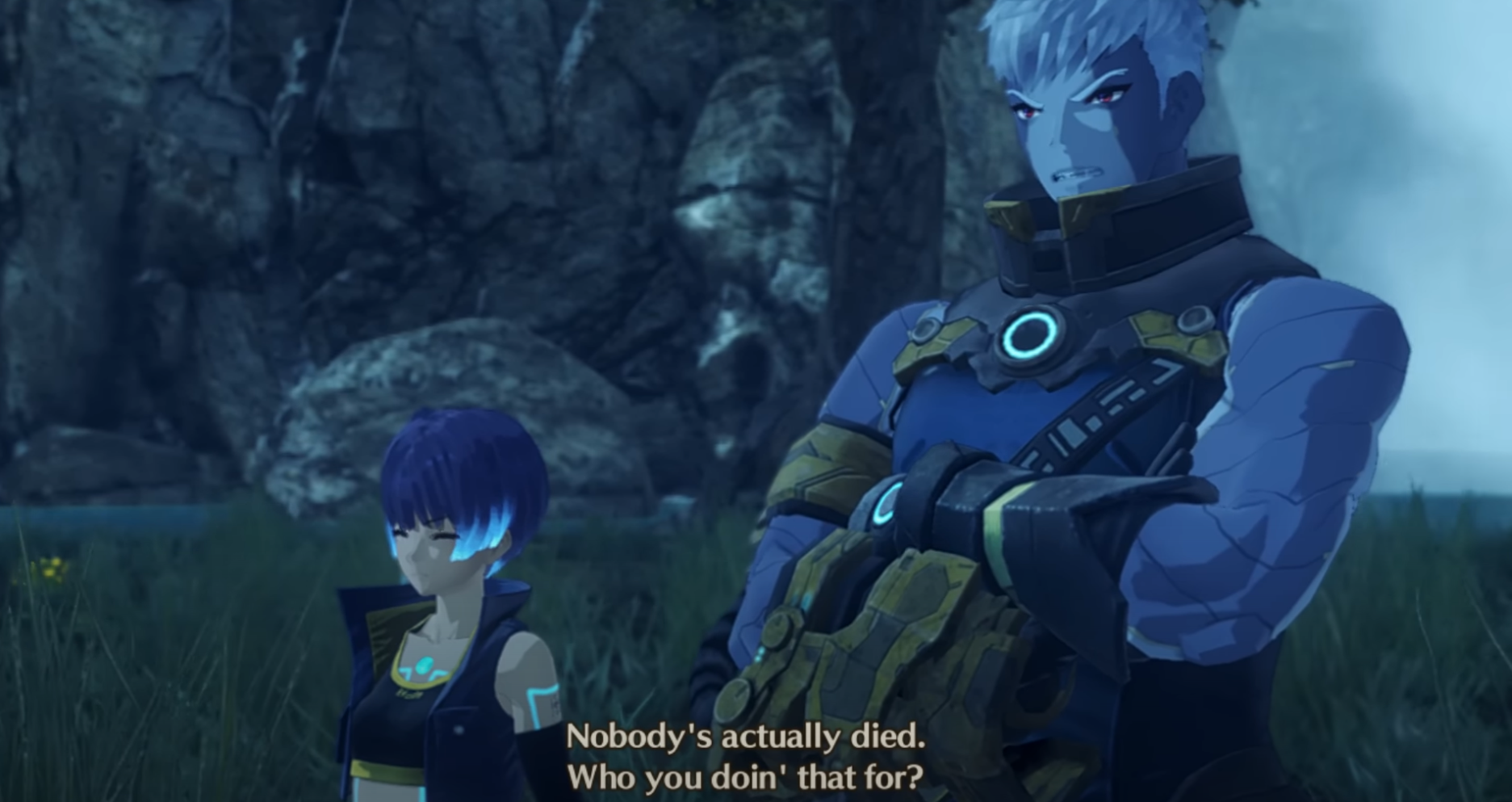
Lanz, struggling to grasp the meaning of Noah and Mio’s off-seeing of Joran’s mudpuppets.
In that third case, for fleeting moments of Interlinking and unadorned conversation, Noah and Mio show us that it is possible to dismiss the emotional solipsism that Z and N foist upon the world, M, and themselves. Rather than submit to despair at the thought of no one ever truly sharing the interiority of their experience, Noah and Mio recognize that the sharing of experience is all there is to experience (S4), even if that doesn’t ensure that one will always have at one’s side a partner with that kind of capacity for Interlink. It’s in this sense that their relationship is a duet, the crucial aspect which N forgot in his void of sadness.
It’s through this duet that they’re able to interpret the actions of others in ways that honor them. In so doing, they can teach others outside the Interlink what it means to participate in that mode of interpretation—whether that means showing Lanz how an expression of honor can be meaningful even when directed at dolls,[460] or else acknowledging with forgiveness and grace that N’s choice to join Moebius represents defensible “shapes a wish can take,” while still expressing to him that he erred by reducing himself and his partner from ‘Noah’ and ‘Mio’ to ’N’ and ‘M’.[461]
Their interpretations and those people whom they interpret are distinct, yet in conversation, which is why it’s so natural, too, for them not to share all activity with each other. In a moment like Noah seeing off Crys, there’s no question for Mio that this song is one which he must express on his own, not in the context of their duet.[462] Noah and Mio’s acts of seeing off the fallen soldiers strewn about the greater Aionios landscape light up in this same aspect. These melodies aren’t like, say, those of The Legend of Zelda: The Wind Waker, which Link can only play alongside active, note-by-note input from the player: our own interpretive games have no place in these musical expressions.

Taion and Eunie in the Lost Colony, discussing the tension between things changing or staying the same across rebirths and relationships.
Even intimate and positive relationships don’t always proceed in a lockstep interpretive duet, though, and Eunie and Taion illustrate the extent to which Ouroboros’ power comes from seeing distinct aspects of its relationships, thriving in the ambiguous space between them. For the two of them, it’s an ambiguity that manifests in their struggles to understand the possibility and nature of change across lifetimes, as in Eunie’s struggles with the trauma of her past life in which she was culled by D, and in Taion’s struggles with how best to relate to a reborn Nimue.[463] It’s one, too, that manifests in a relationship that never defines itself quite comfortably as either platonic or romantic, exemplified in their playful banter before the separation of the worlds when Eunie calls Taion her “[f]ourth best [bud],” smiling coyly at Taion that she’ll “think about it” after he implores her to reconsider her ranking.[464]
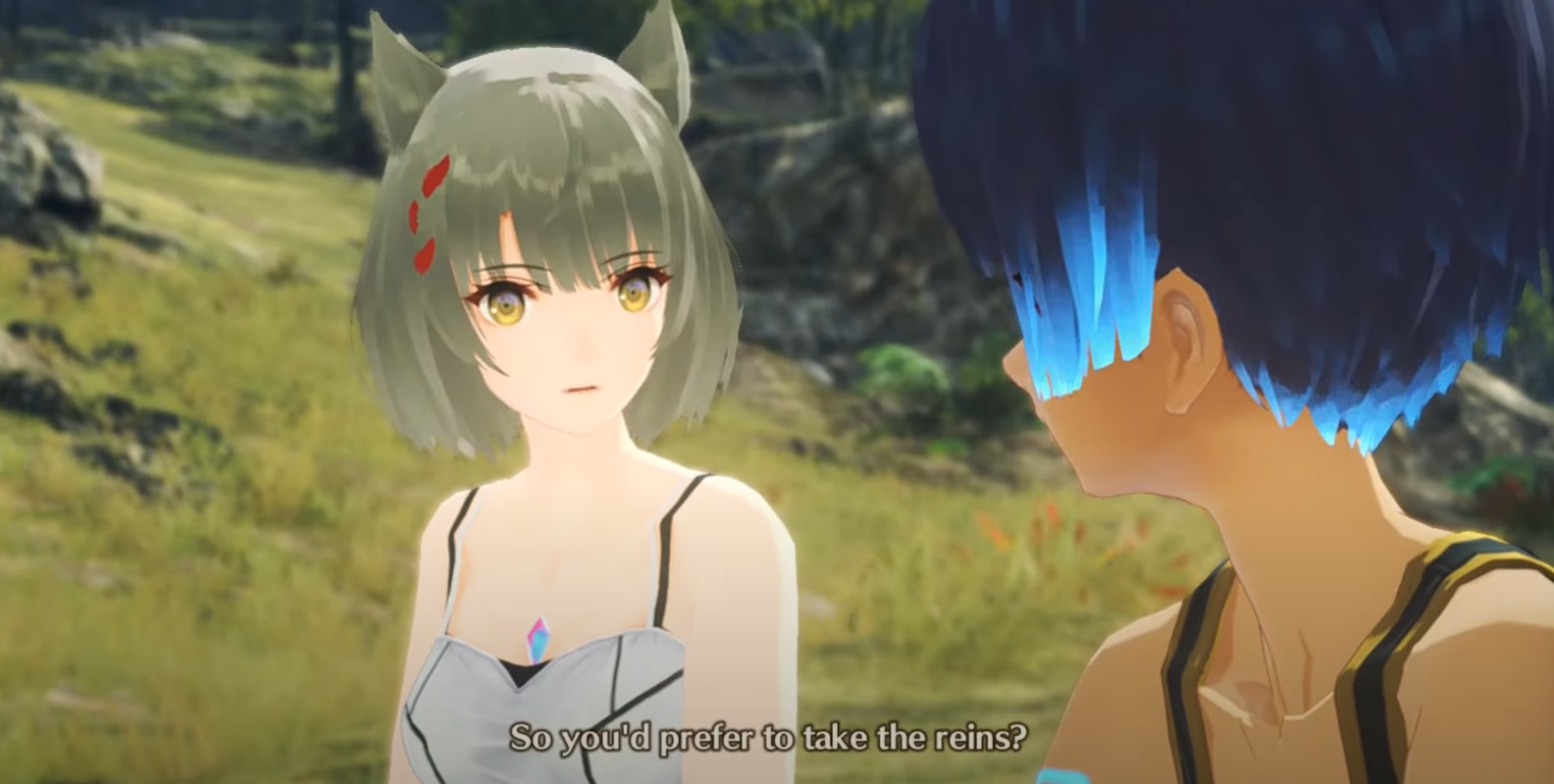
Mio probes Sena about her desire to be more involved in the Interlink, before the second set of Ouroboros’ Interlink forms manifests.
This ambiguity in Eunie and Taion’s relationship doesn’t count against the strength of their bond. To the contrary: in terms of the use to which they put the relationship, it allows them to lean into the multiple aspects of an Interlink to overcome obstacles that others cannot. Slowly after discovering their capacity to share their experiences with their partners, Ouroboros must uncover that this game—like a waltz, or like a dialogue—can have a leader and a follower, with different leaders bringing out different aspects of the union (as though the duck-rabbit illusion were a collaborative effort put on by a duck and rabbit standing in various relations to a viewer’s visual field). Sena’s early conversation with Mio in Ribbi Flats, ahead of the confrontation with Joran and his mudpuppets, shows how challenging this “feeling out of a new aspect” can be: before the Agnian members of Ouroboros discover what it is to drive the Interlink form, Sena is left only to complain to Mio that Noah and Lanz are always “the ones taking the lead” in Interlinks, with Mio feeling out how Sena’s using this language by suggesting that the boys typically behave by saying things like, “‘Hey, why didn’t you move that way?!’, and stuff like that”—a conversation that probably leaves unclear to them, and certainly left unclear to me, what it would look like when someone else “took the lead” in an Interlink.[465] Then—suddenly, as with the lighting up of an aspect—we and they “see” the organization of the Interlinks differently in the battle with Mudpuppet Isurd, though the participants in the Ouroboros language-game have not themselves changed.[466] In this way, Ouroboros Interlinks are like duck-rabbits, or melodies played at different tempos that beget first a waltz, now a salsa: objects for which two aspects can be seen, albeit (like some optical illusions) only with effort and for a limited time.[467]
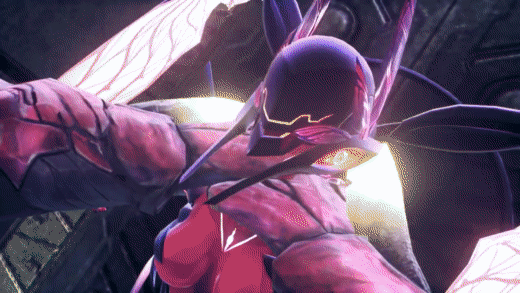
Eunie and Taion catching Moebius D & J off-guard by turning D’s lust for Eunie’s fear against him.
Among Ouroboros, Eunie and Taion uniquely juggle these separate aspects of their relationship and Interlink to great effect against the enemy that acknowledges no difference in aspects: the Interlinked D and J, defending Keves Castle’s Annihilator.[468] Eunie’s relationship with Taion—both Interlinked, and more broadly—allows her to temper the fear she experiences face-to-face with D, who killed her in a past life, and instead catch him off-guard with a Taion-facilitated illusion of her helpless Interlinked body, preying on his own reductive idea of her character.[469] In a melody blending Eunie’s determination with Taion’s cunning, we see Ouroboros demonstrate that aspect-seeing doesn’t just empower us to see the world and our place in it in new ways, but also provides us with a weapon to wield against those who would impose aspect-blindness upon the world—against those who reject diversity of interpretation in favor of a more totalitarian mode of representation (S9, S11, S16, C2, C3).
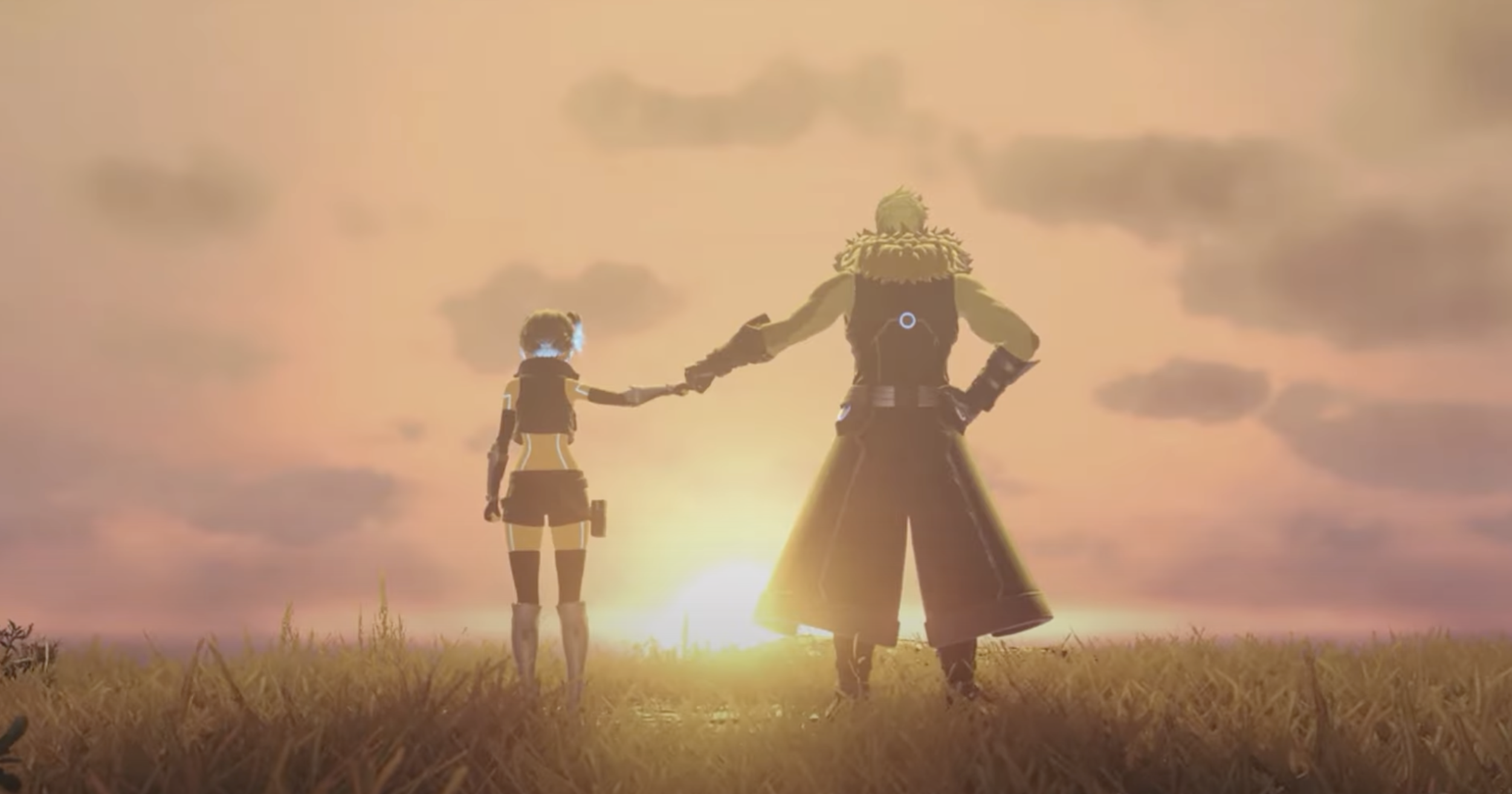
Sena and Lanz, honoring their friendship and mourning the end of their workout sessions as the separation of worlds approaches.
Sena and Lanz, meanwhile, are the perfectly platonic workout buddies,[470] and thereby highlight how radically the Ouroboros game can free its participants as people simply by demonstrating to them that those things they took to be essential to their identity are really just tools for them to use as they see fit. We saw above how this relationship allowed Sena to move from self-doubt to self-sacrifice in the battle against N, in a way that inspires Lanz as much as it does her: Lanz recognizes that Sena’s Interlinking with him began with her having “reached out… for the strength she needed,” and in this interpretation of their relationship, he’s able to look past his feelings of weakness and cowardice as essential elements of his character requiring a mask of strength, instead being inspired to push himself, alongside others, to surpass Joran—the object of so much despair for him—by finding his own purpose.[471] For so long, Lanz and Sena both took strength-training to be intrinsic to their characters as a need to compensate for weakness; once someone with that same penchant for strength-training joins their visual room, they can dispense with that pained flight to essentialism and, rather than abandoning strength-training as a meaningful activity, use it in service of a more holistic, positively motivated self-improvement.
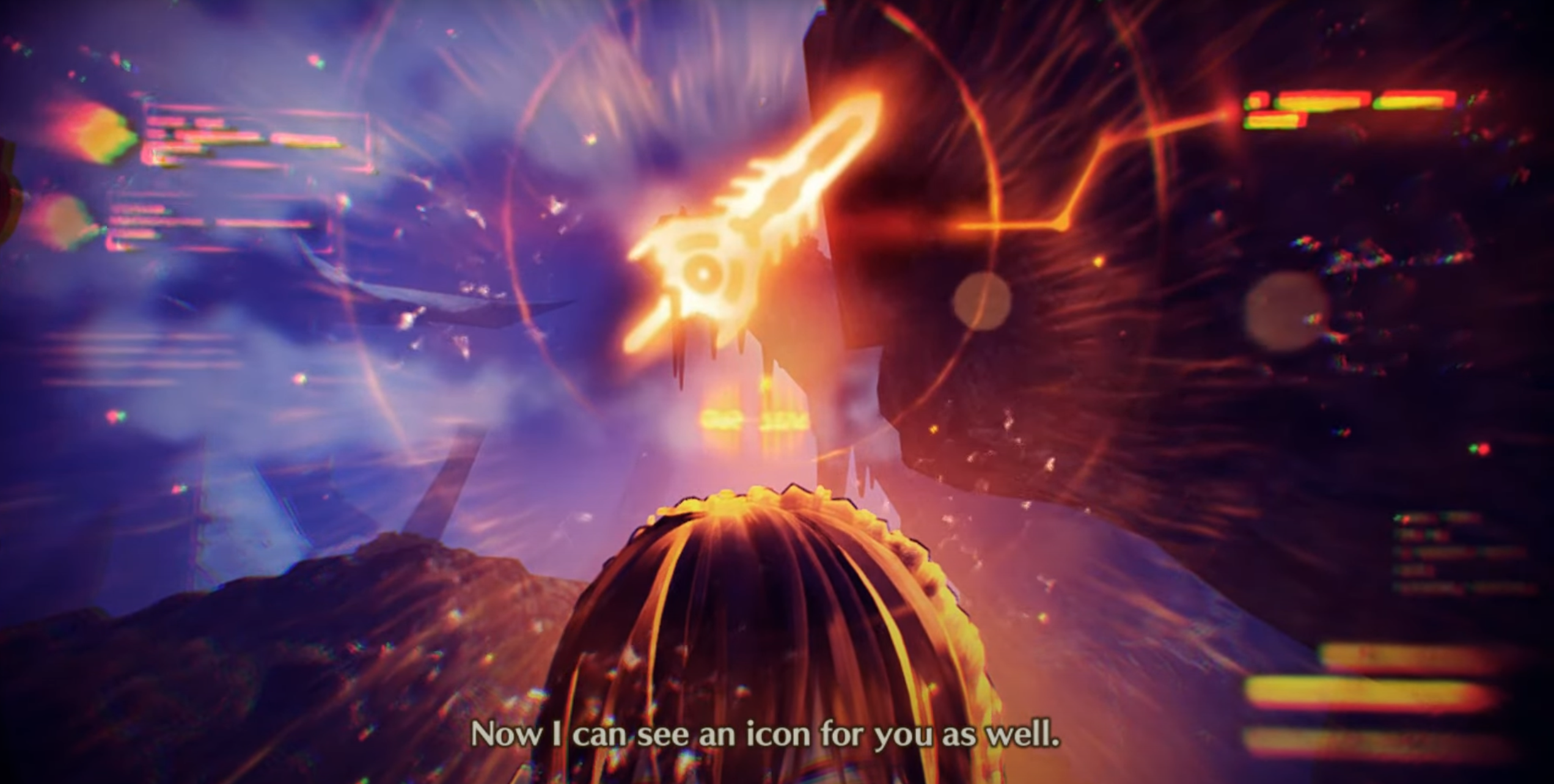
Mio perceiving an icon representing Noah’s Class in her Iris for the first time, ahead of Ouroboros’ first time adopting new Classes.
Lanz and Sena’s discovery of strength-training as a tool is like Ouroboros discovering Classes as a tool: after becoming Ouroboros, suddenly, that which they’d taken to be a core element of people’s combat identity is shown, in a new representation within their Irises, to be something that can be worn like clothes. Like imagination and the visual room in the Philosophical Investigations, what they discover is a new representation, which “point[s] the way to a further use”:[472] in this case, that further use is deploying “all the techniques” they can use with new Blades, applications that “[flash] before [their] eyes” when they adopt a new Class.[473] The first half to the cipher of Ouroboros’ utility was showing that our inner thoughts can be intimately shared; this second half is that the content of those thoughts, the actions and roles which we ascribe to ourselves, are tools without any similarly “deep” or “private” ties to us. Combined with the interpretive possibilities opened up by expanding one’s conversational circle from (1) oneself to (2) someone similar to (3) the public, this allows Ouroboros to share modes of action in the world with others whom they meet, transforming those once seen only as pawns in a war game into those who can mentor and ally in myriad ways: the Heroes (S14).[474]
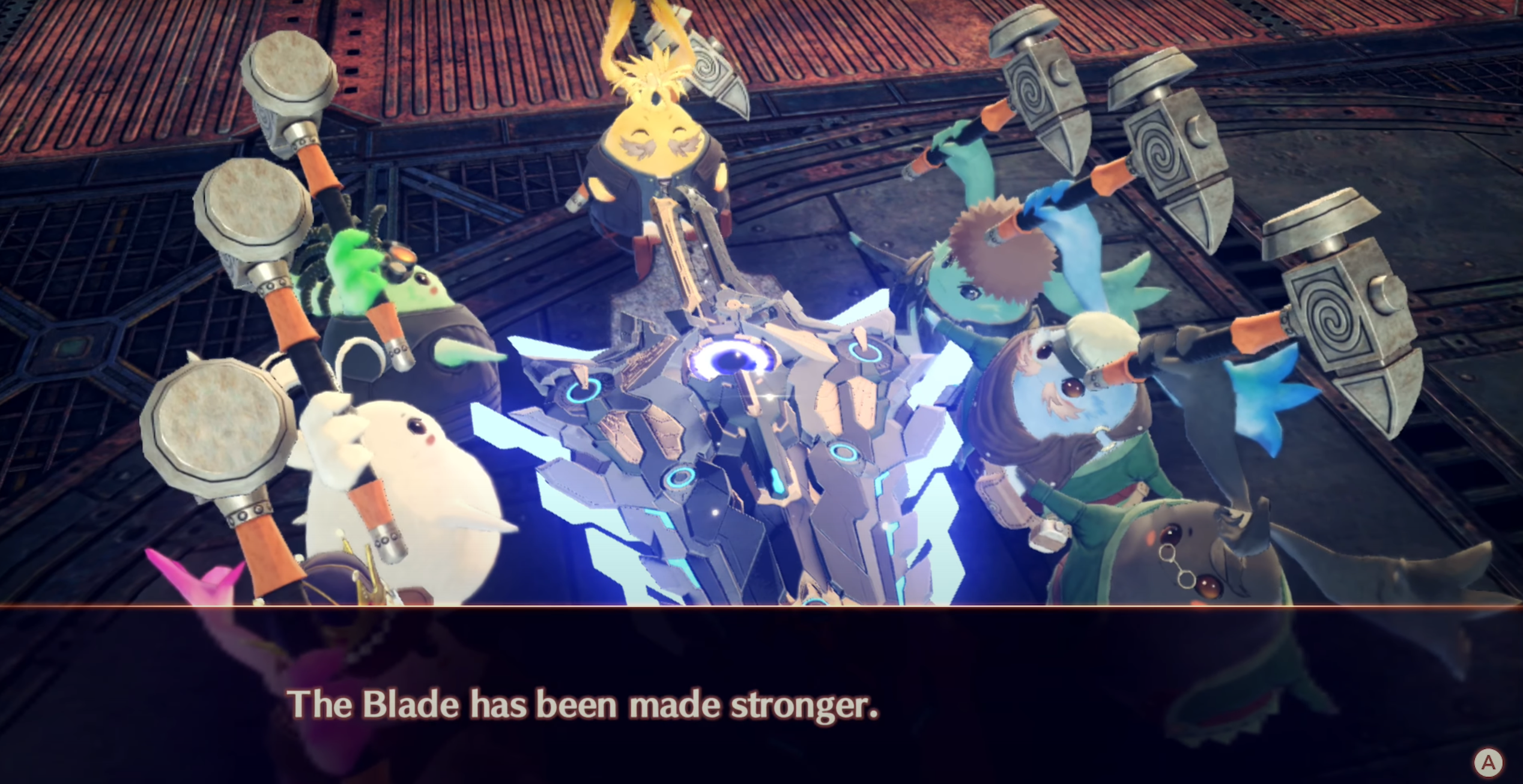
The 7 legendary Nopon smiths improving Lanz’s original Blade with Origin Shards.
Ouroboros is not a power bestowed upon, nor emanating from, these six individuals whom we follow most closely throughout the game: more than once, the story draws our attention to the plurality of Nia’s trinkets, the Ouroboros Stones, along with the plurality of those who have filled those roles in the past or were other candidates to fill them in the present.[475] It’s a mode of thinking about and interacting with the world, others, and oneself, and while there are some prerequisites to it—in particular, having someone else in a sufficiently similar form of life to Interlink with you—there’s nothing to suggest that anyone is barred from it by anything more than Moebius denying its possibility.
In the presence of Moebius, it’s all the more pressing for those chosen as Ouroboros to fully realize their potential: not just reconceiving themselves, not just starting new kinds of conversations with others, but also reintegrating all these new language-games into a cohesive sense of self—not unlike the Nopon smiths who can use Origin Shards (more trinkets) to reinforce Ouroboros’ original Blades before the final confrontation, drawing out the full potential of those tools only once they have been situated in the proper context as some of many possible tools available to the bearer (S16, C2).[476]
The magic of this, in our reading of Wittgenstein 2, is that such an evolution of individual capacity seems superhuman, Ouroboros’ destruction of a world on a par with Shulk’s felling of a god, yet it is merely and exactly human: by looking and seeing how they really engage with their lives as opposed to how Moebius would have it that they do, people empower themselves to surmount both the picture holding them captive and the solipsistic despair motivating that picture (C3). They destroy Moebius’ world simply by seeing it as one of many: when all is said and done, all it takes to fracture the seemingly omnipotent field of Z and the Consuls’ influence is Noah drawing his sword, as if to gesture that tools are nothing more than tools.[477]
§2.24: Heroes’ Family Resemblance, and Colonies’ Cultures
The Heroes and their homelands in Xenoblade Chronicles 3 don’t serve as supporting characters and setting: they are diverse, self-sufficient agents whom Ouroboros can support, collaborate with, and converse with. Through conversation and joint missions, Ouroboros and the Heroes are able to propose and accept new interpretations of each other: Ouroboros uses their own special language-game as context enabling them to show Heroes ways to individuate themselves beyond the world of Moebius, but the Heroes also give members of Ouroboros new ways to interpret themselves by noting the family resemblance between themselves and particular Ouroboros members—a process codified into gameplay through the mechanic of specific Inheritors, members of Ouroboros who are initially sufficiently similar to particular Heroes to add their Class to their toolkit (S2, S9, C2, C3).
That’s not to say that Class Inheritance is an immediate process: as with Interlinking, Ouroboros can’t hope to play an identity-centric game with Heroes unless they have sufficient context from those Heroes’ worlds, their traditions. And “Tradition is not something that anyone can learn, it’s not a thread, that someone can pick up, if & when he pleases; any more than you can choose your own ancestors”:[478] to gain that context requires spending time in their homes, interacting with its inhabitants, and coming to understand the ecosystems on their own terms. This emphasis on empowering oneself and the other only by clearly seeing and honoring the other in her own light carries through all dimensions of Ouroboros’ time with the Heroes, from their first Hero Quest with Ethel to a finale that underscores this ethos by highlighting not just Ouroboros’ struggle against Moebius, but the crucial efforts offered by the Colonies, the City, the Nopon, and the Heroes of their own volition, on their own terms.[479]
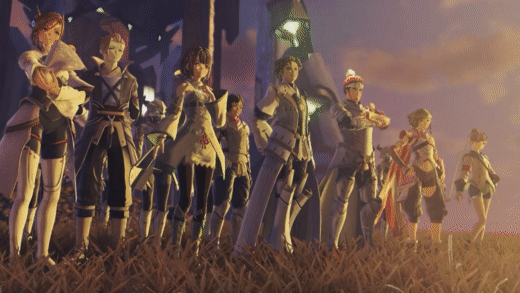
The Heroes and their fellows look on as the worlds prepare to separate.
As Wittgenstein 2 is not like Wittgenstein 1, so the portraiture of Xenoblade Chronicles 3’s Heroes is not like the alphabet soup of Moebius: there is no perspicuous way in which to arrange these individuals because they do not “fold into” the totalitarian imposition of a single worldview. Where Z sought to erase the individual in favor of generality, Ouroboros rejects generality to celebrate the individual. Rather than composing a single narrative of theory from a litany of Consuls, therefore, we need to look clearly at particular portraits to appreciate the spectrum of distinct forms of life Ouroboros criss-crosses in their exploration of family resemblances, cultural exploration, self-discovery, and empowerment of the other (S1, S10, S14). With that in mind, I want us to stand before 5 such portraits:[480]
- Dutiful Zeon, who develops from a newly minted Commander into someone prepared to cede the role for the sake of Colony 9
- Craftmaiden Alexandria, who invents new language-games and learns how trust can contribute to strategy
- No. 7 Segiri, who, through language, moves beyond seeing herself and her fellows as tools, treating them as human for the first time
- Wrathfist Ghondor, who explores her own network of resemblances that inform her concept of ‘motherhood’
- Artificial Blade Ino, who translates a metaphysically robust game—one with which players are familiar—into a metaphysically deflationary game that accomplishes the same ends
§2.241: Zeon: Breathing a Form of Life into Roles
Zeon shows Ouroboros the life of a man who organizes himself according to duty, and they show him the many roles according to which he might satisfy that principle.
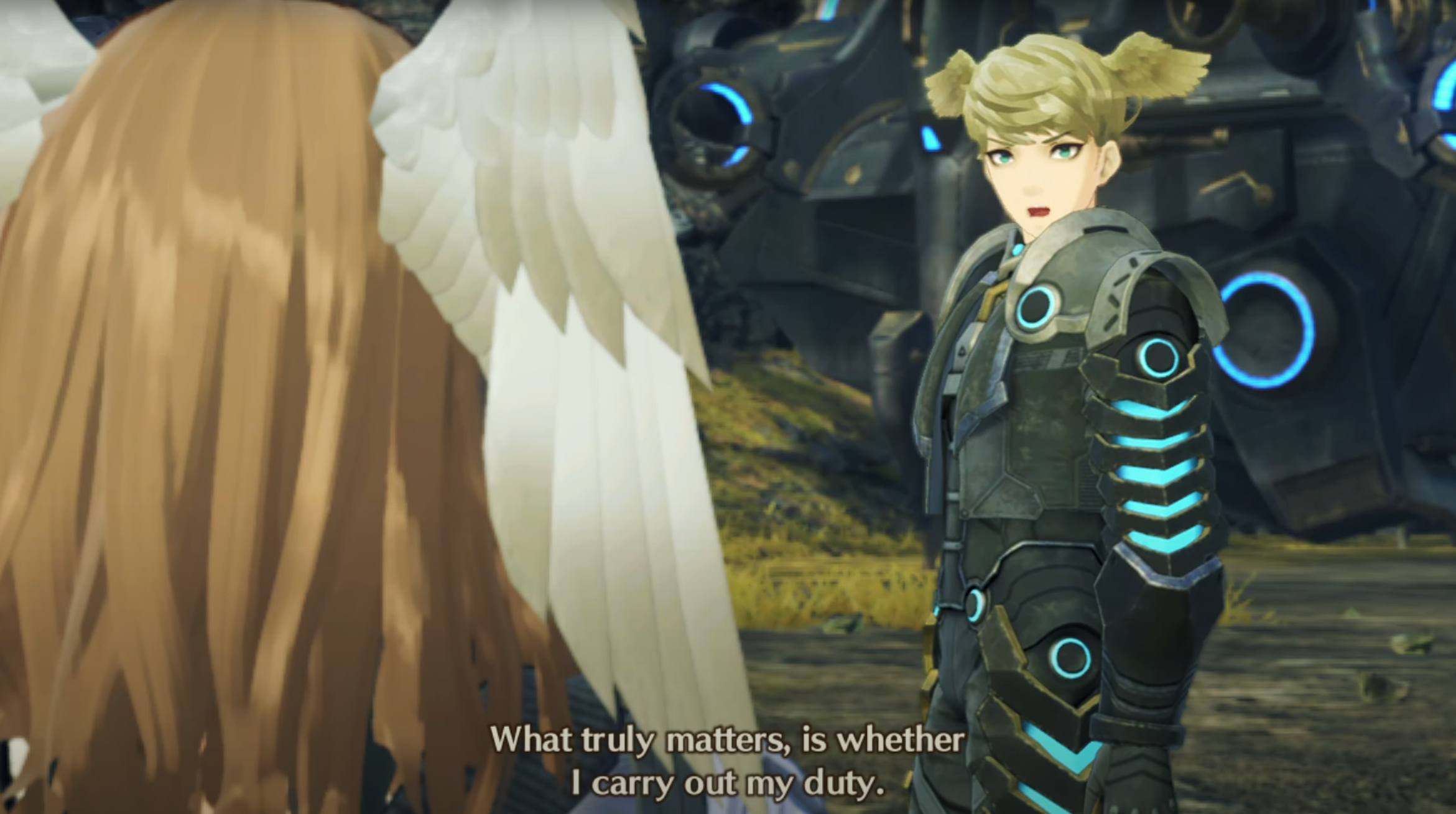
Zeon, asserting the principle through which he views his place in the world.
Ouroboros first encounters Zeon after the former friend of Noah, Eunie, and Lanz is promoted to the role of Colony 9 Commander, in the aftermath of Ouroboros’ unwitting “defection” and Consul B stripping Colony 9 of its rank.[481] In Zeon’s new role, the sense of duty he feels to Colony 9 manifests by joining the Consul in denouncing his former comrades as traitors, taking them to task for the pain he believes them to have caused Colony 9 through their abrogation of duty.[482]
Through their actions over the course of an Agnian attack on Colony 9, Ouroboros demonstrates to Zeon that they do not treat the Colony in a way that dishonors those within it (as Eunie says, they acknowledge that they “owe a debt” to Colony 9), a demonstration that leaves Zeon willing to follow Noah’s lead in the idea that they can “build something new” in the place where their old friendships were, even if their new roles of Commander and Ouroboros preclude them from returning to their own roles.[483] That receptivity makes it easy for Zeon to listen to Ouroboros explain the truth of the Flame Clocks—which makes it all the easier for him to choose sides between Consul B, “an idle man who orders others around,” and Ouroboros, who upheld duty by “risk[ing] their lives for [Colony 9].”[484]
Ouroboros met Zeon at a time when he was caught in the habit of treating roles as naming fixed aspects of a person’s character: to him, they were “traitor,” and he “Commander.” By the time they “alter the equation”[485] by freeing the Colony from its Flame Clock, he recognizes that upholding a duty is not about maintaining a title to which one is bound: rather, it’s about doing what fulfills the duties which one feels, regardless of role (S9, S10, S11, C3). Where the traitors were once the complete cause and explanation of the Colony’s food shortage,[486] Zeon now sees an opportunity to fulfill the duty he owes his people by spearheading an effort to solve the food shortage as a Colony. In so doing, he and Ouroboros alike discover the value of putting not just people, but also cultures with sufficiently overlapping contexts in conversation: Juniper and Colony Tau—not only an Agnian Colony, but also one that was previously isolated from almost all cross-Colony pollination by its Consul’s design[487]—are in a unique position to teach Colony 9 agriculture, and to gain a broader education in Aionian society in the bargain (S8, S9, C2).[488]
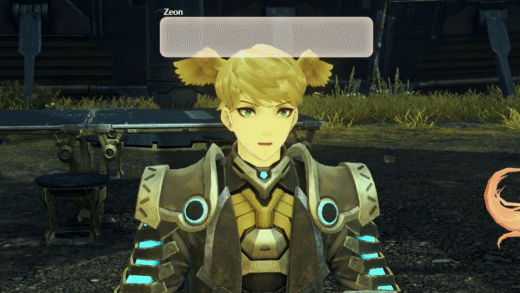
Zeon reflects on the role Ouroboros has had in his development.
But Zeon gains something more personal from this effort, too: an understanding that misunderstanding one’s role in the context of one’s relationships risks dishonoring both the role and the relationships (S3, C2). One of the key utterances offered by Ouroboros to help Zeon reinterpret his relationship with his Lieutenant, Kite, is that he speaks to Kite “on a commander-lieutenant level” rather than a “man-to-man” level,[489] disenfranchising one of the Colony’s most passionate advocates by “issuing him orders instead of talking to him on an equal footing.”[490] Especially after living through multiple roles in his military career and clinging to them through a sense of duty, it’s therapeutic for Zeon to see that it can be positive to “fail” at something and “start anew”[491]—an insight, perhaps, that leads him not only to help Kite shine as the crops’ guardian, but also to ask Queen Melia to “let the colony elect their commander, of their own volition, and to “gladly relinquish [his] position as commander” if they will it so.[492]
By the end of his time with Ouroboros, Zeon is more concerned with doing his duty to Colony 9 by empowering someone with “the qualities needed in a commander” at a given time to take on the role, rather than doing his duty by forcing himself to execute the role as best he can simply because a Consul placed him in it (S15, C2, C3).[493] The lesson goes both ways: a newly-minted Ouroboros is wont to focus on prioritizing the development and use of a small number of roles, despite the ease with which they can change them; it takes a change in perspective to actively adopt roles and let them go as the situation demands. (Perhaps, like me, you found yourself focusing on Noah as an Attacker long after he had access to many Defender and Healer Classes, only over time absorbing the context required to update the party’s roles collectively based on the needs of particular battles.)
§2.242: Alexandria: Of Tool-Makers and Tool-Users
In Alexandria, Ouroboros finds someone who invented a language-game to surpass Moebius, yet who did so from an emotional solipsism none too distant from that of Wittgenstein 1. By the time she and Ouroboros have maximally contributed to each other’s causes, she has taken the lead from others’ inventions to reinterpret herself as designing new systems for mutual benefit rather than self-preservation.
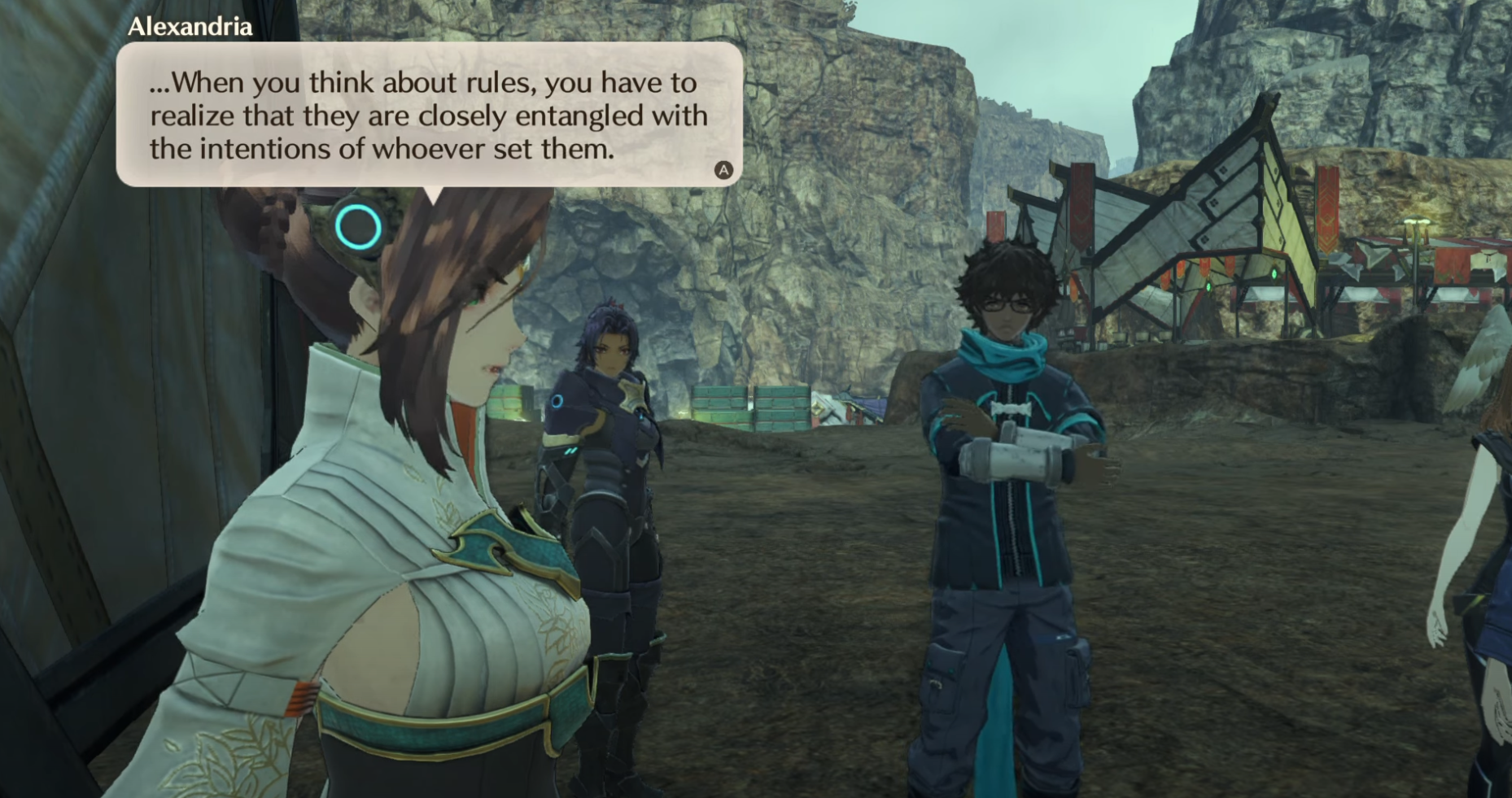
Alexandria articulates to Ouroboros her view on the rules of the Consuls’ world—and, implicitly, on the intentions behind her own Collectopaedia—upon first introducing them to Colony Iota.
After Alexandria tricks Ouroboros into defeating Colony Iota’s Consul E, her explanation of why she designed the Collectopaedia system and how she uses it is par for the course: she and her Colony “[read] the flow of goods to learn of the war,” allowing them to prepare strategies less generic than those of the “musty old textbooks”—a form of life that allows her to pursue “what life’s like outside of those confines” imposed by the Colonies and war’s rules, “closely entangled with the intentions of whoever set them.”[494] What Alexandria has invented basically amounts to a new medium in which to play a language-game: with the Collectopaedia, people (and Nopon) can call to others for the provision of materials, not unlike the first language-game Wittgenstein stipulates in the Philosophical Investigations, where a builder calls out “block,” “pillar,” “slab,” or “beam,” and his assistant brings whatever material he has learned to retrieve in response to one call or another.[495]
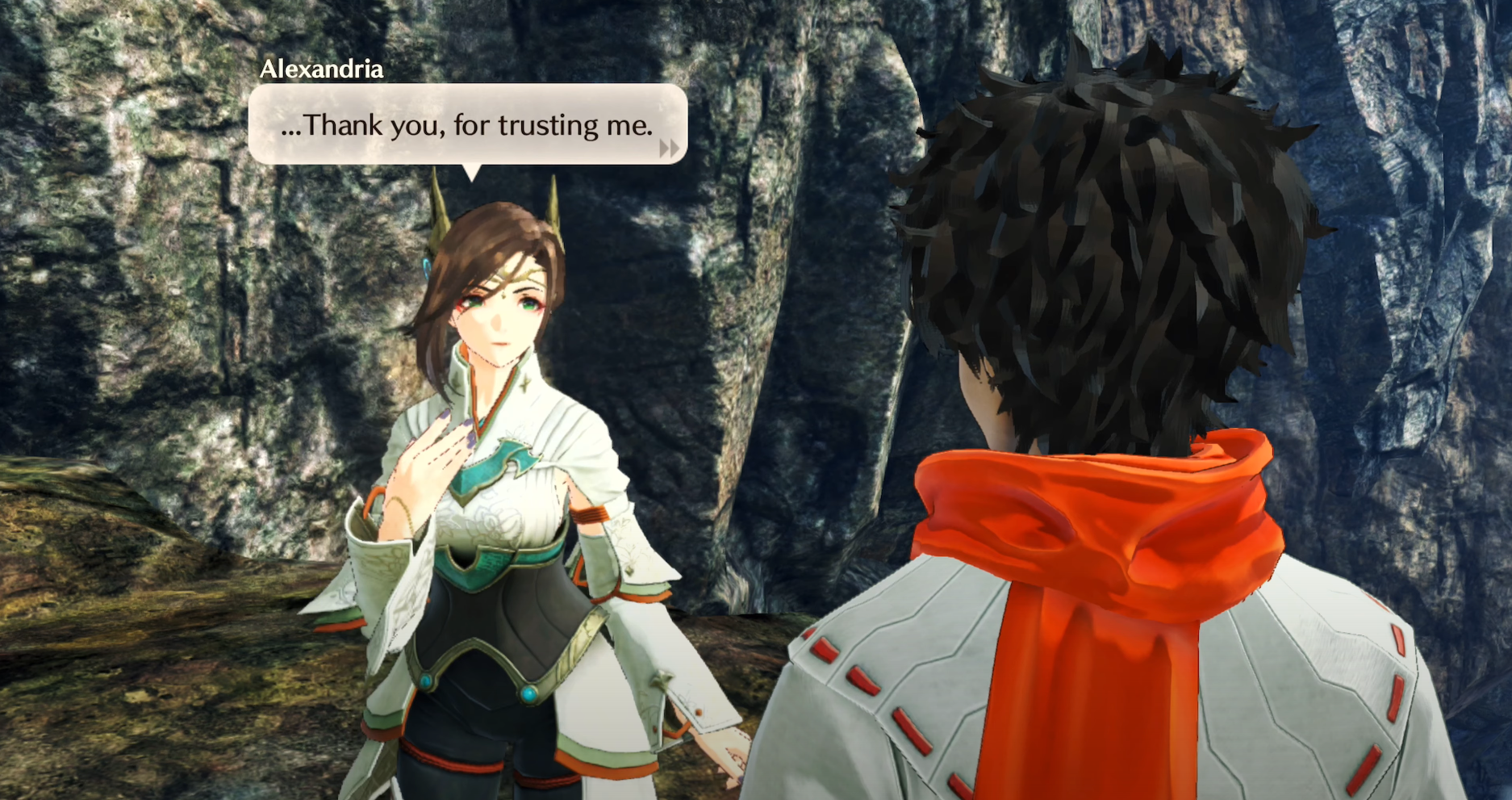
Alexandria thanks Taion for choosing to trust her after Ouroboros saves her from Consul Q’s ambush.
We come to see that the intention closely entangled with the rules of Alexandria’s system is a deep-seated fear of cultivating trust with others and letting them see her for who she is. As with hiding her real age,[496] she initially explains her design in terms of pure strategic advantage over other Colonies—yet, as with her deception of Ouroboros, it is designed in a way that forbids others from participating in that strategy, merely observing everyone else’s actions and supply needs from a distance as a means of calculating her own plans. It’s only once Valdi and Ouroboros show her that mutual trust can improve strategies that she begins to let down the walls with which she’s isolated herself: Valdi by showing her that he’s willing to cooperate with her Agnian Colony purely on the basis of the fact that they both trust Ouroboros, and Ouroboros by overcoming Consul Q’s own strategy to kill Alexandria by virtue of trusting each other and (as Taion says) strategically “choosing to trust” Alexandria after Q divulges her treacherous act of poisoning Iota’s former Commander.[497] In changing Alexandria’s perspective, though, Ouroboros doesn’t lead her to abandon her former prioritization of strategy: they help her to revise her concept of ‘strategy’ by showing her a new connection between the utility she seeks to maximize and the actions they achieve by trusting each other (S2, C2).
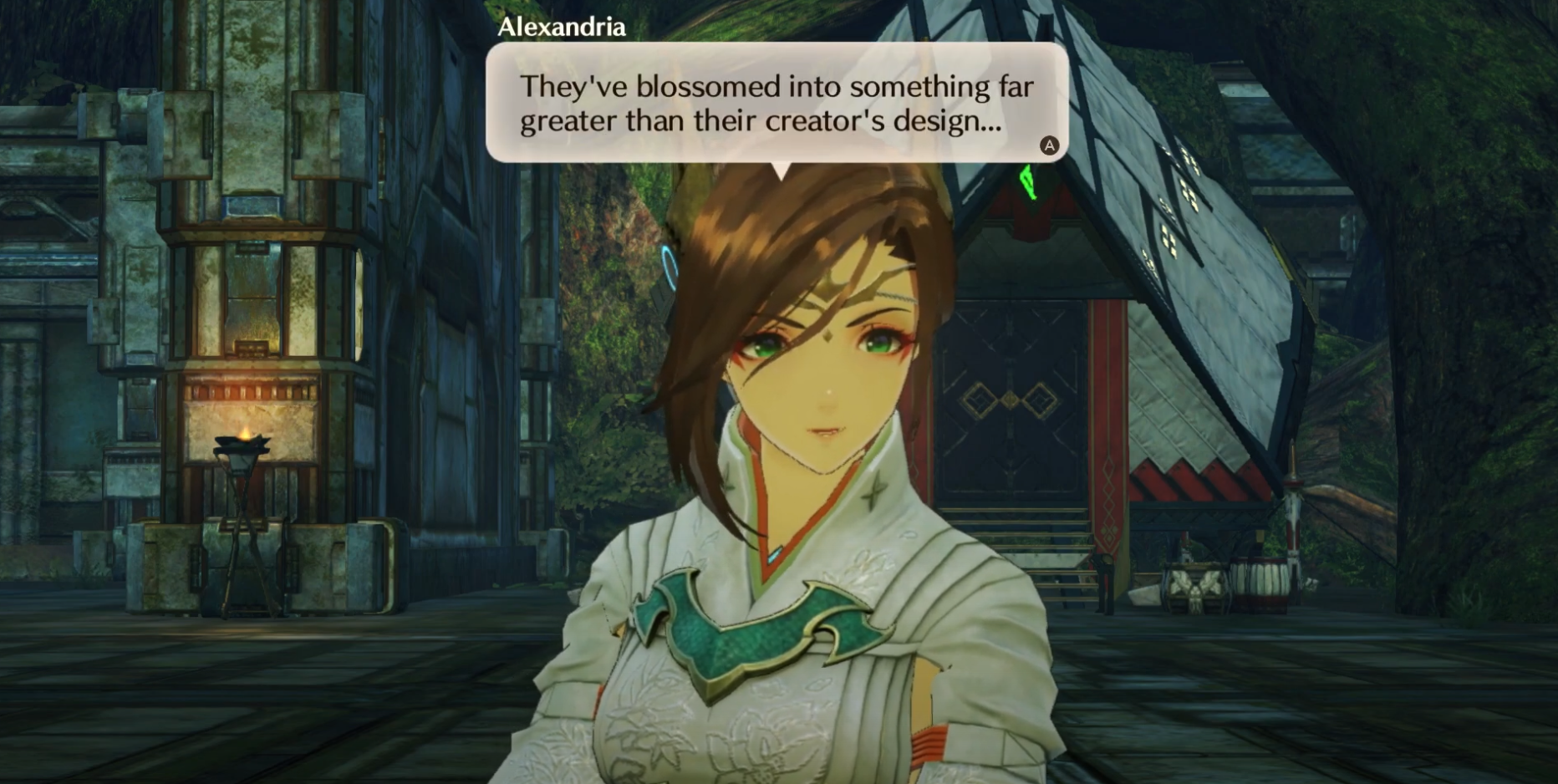
Alexandria, marveling at the new games people are playing with her Collectopaedia system.
Revising her concept allows Alexandria to trade Colony staff with Valdi for the sake of strategic, mutual benefit,[498] and it allows her to revise her interpretation of why she created the Collectopaedia system in the first place (C2, C3). From her own new language game, “new types of language, new language-games, as we may say, come into existence”[499] before her eyes: when his communication methods are jammed by black fog, Colony Lambda’s Sif, trapped from a cave-in, “spams” the same request for materials local to his position until Ouroboros and Colony Iota’s Sequoia put the pieces together and rescue him;[500] Valdi collaborates with no fewer than 7 Colonies to construct a thank-you Levnis for Colony Iota, reaffirming that cross-Colony collaboration, only possible with trust, pays strategic dividends.[501] With a fresh view of her own creations and her place in the world, Alexandria ultimately reflects to Chickadee that while she’d thought she designed the Collectopaedia “to see what life looks like from the outside, unbound by rules,” she might have been mistaken: “perhaps,” she says, “I only wanted to see how people change.”[502]
Of course, with a view to Wittgenstein 2, this doesn’t really point to some intention of hers that was hidden from her back when she was designing the system: what she’s offering, like Freud, is a new interpretation of her past actions (S11). This interpretation’s utility is determined by Chickadee’s reply: ‘I’m so glad. We’re finally seeing things in the same light.”[503] Alexandria finally sees in her life the same aspect that her fellows do; the acknowledgment of this only paves the way for more productive, trust-dependent games in the future (S7, S9, C1).
§2.243: Segiri: Therapy for the Mechanized
While the overall activity of Wittgenstein 2 in Xenoblade Chronicles 3 is therapeutic, nowhere in the game do we see a more focused case of one-on-one therapy than Sena helping a living parody of the Tractatus to see herself as human.
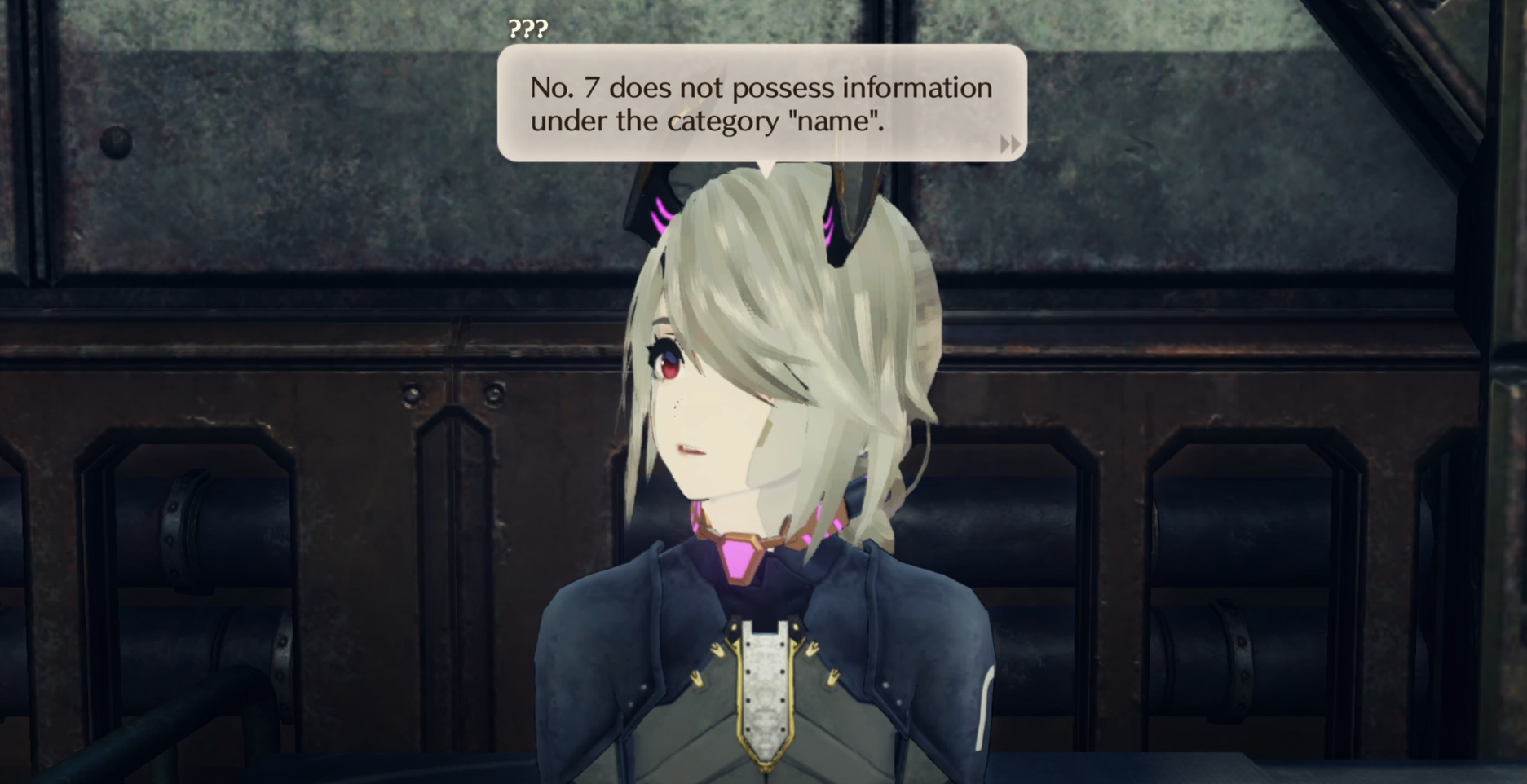
No. 7, before Sena names her “Segiri,” lacking the information (and self-concept) needed to answer Sena’s question of what her name is.
Commander for Colony 0, the mobile combat unit we studied in Part 1, No. 7, like the rest of her cohort, lacks the personal information given to other Colonists through their growth modules:[504] she and her ilk are raised to treat themselves and each other as “components” serving as something between batteries and pilots for their Ferron mechs, and therefore don’t see themselves as the kinds of things to which names apply.[505] After Ouroboros rescues her from her damaged Ferron, Sena sees firsthand how truly dehumanizing this cultivation is—not only in the sense of disrespecting someone’s value, but also in the sense of barring No. 7 and her fellows from participating in virtually any human forms of life: they don’t even have the prerequisites for culture, and so can’t use language for much of anything.
The No. 7 whom Sena meets is unable to meet Sena in conversation, basically running everything Sena asks her through a Tractarian logic-processor and calling an error if she either cannot determine the sentence’s significance or cannot provide a significant answer. With Sena as versed in linguistic use at this point as you’d expect of Ouroboros, this verges on comedy: when she asks No. 7, “could you tell me something about yourself?”, No. 7 responds that “[t]he question lacks specificity,” a determinate meaning, and so she “cannot respond’; yet Sena, assuming in No. 7 a capacity to use language to achieve a multitude of ends, apologizes, wrongly inferring that No. 7 was reproaching her for being “wishy-washy” in how she posed the question.[506]
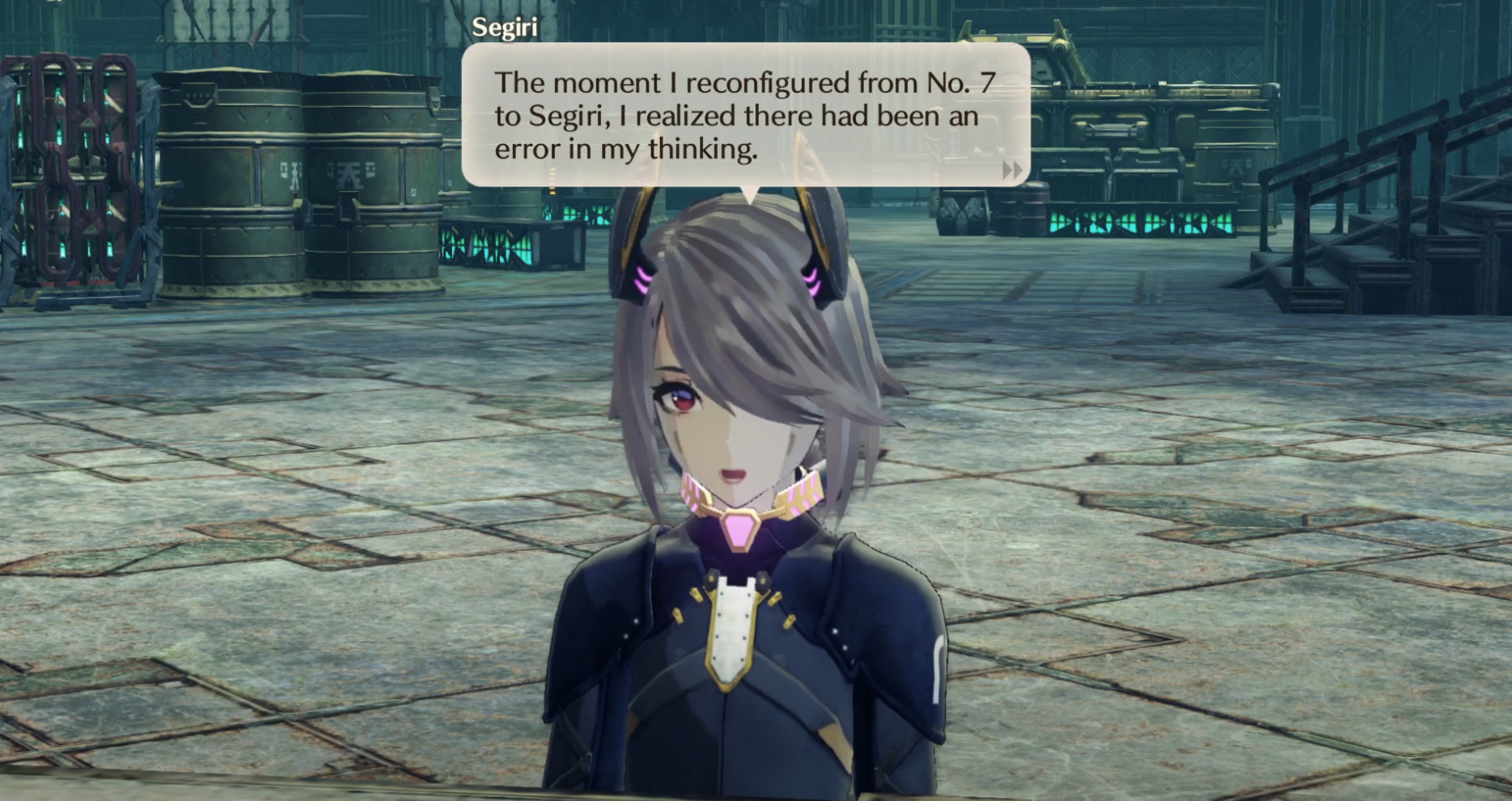
Segiri shares how Sena’s act of naming her gave her a conception of herself as human—a gift she wishes to share with the rest of her Colony.
Naming is not a way of logically capturing something’s essence in a way that allows reference through language: “naming is something like attaching a name tag to a thing. One can call this a preparation for the use of a word. But what is it a preparation for?”[507] Sena names No. 7 in preparation for No. 7 using herself in whatever ways she wants to: in language evocative of the tool-based picture of language, Sena “just took the ‘se-‘ part from ‘seven’ and tacked on the ‘giri’ from ‘onigiri’,” the food which Sena prepared for her, and which was possibly one of the first experiences Segiri had of enjoying something in her life.[508] The preparation for considering herself a part of the human stream of life is thinking of herself as something that is not merely referred to (a language-game for which ‘Number Seven’ sufficed) but also an agent acting to achieve her desired ends (like eating Sena’s onigiri) (S10, S11, C2, C3).
We’ve seen how language shapes thought, and so Segiri is being characteristically precise when she tells Sena, after just being freed from Consul F, that she “does not have thoughts matching that description [of ‘things Segiri would really like to do’].”[509] Sena’s naming game, then, gives her a bridge to the thoughts that humans have: by interpreting herself, through a name, as the kind of thing that can issue orders to itself (“Segiri gives orders to No. 7”[510]), she can literally and metaphorically overcome Consul F, thinking about the world in new ways that allow her to conceive of finding a permanent home for Colony 0[511]—and to ask Sena to provide names for her friends as well, allowing them to share these human forms of life with each other (S9, C1, C3).[512]
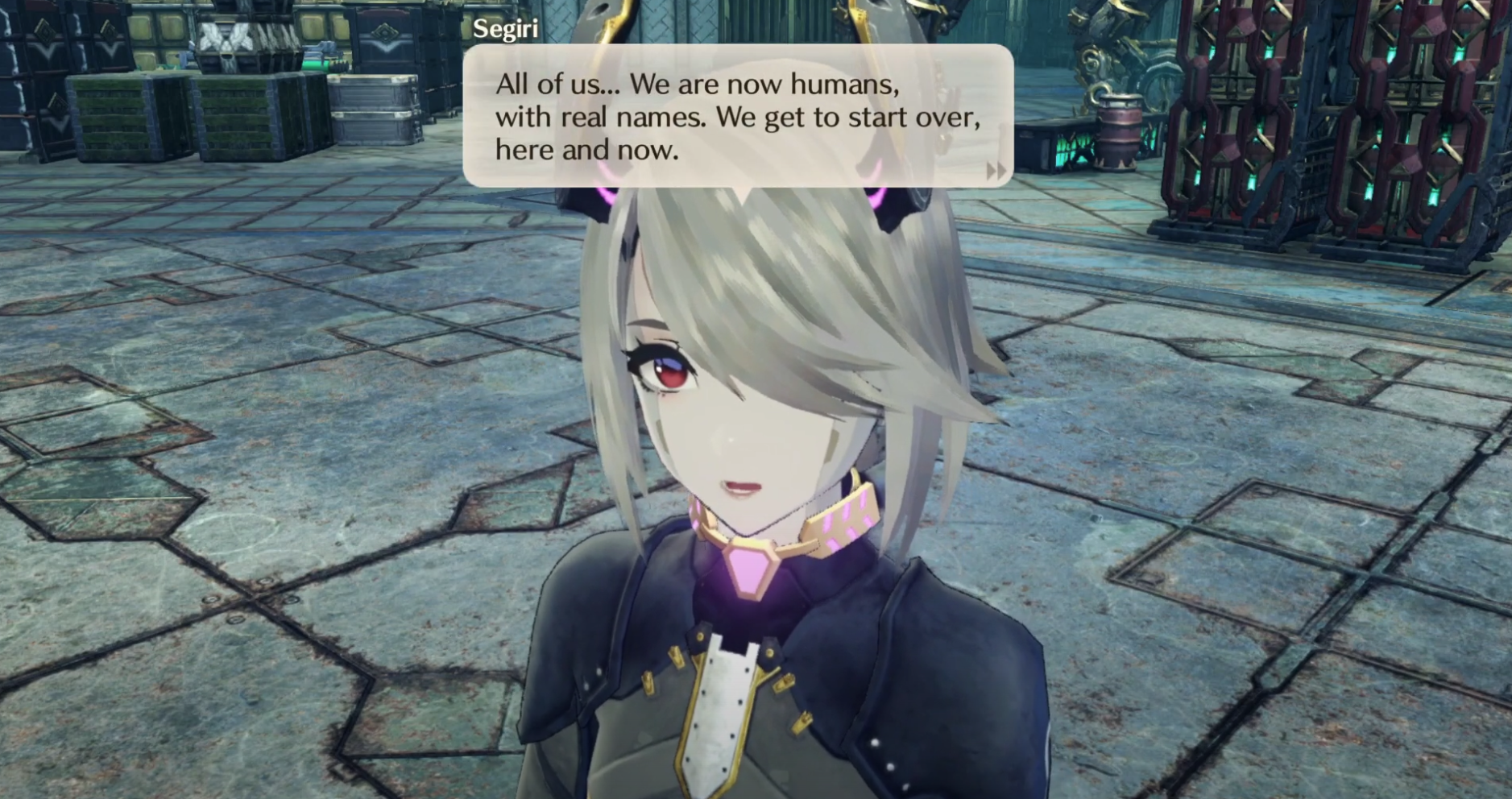
Segiri celebrates the opportunity for Colony 0 to start over as a human community after Sena names the rest of the Colony members.
Though Noah never shares as much, Segiri shows Ouroboros a moving complement to Noah’s own tragedy with N. Where N shows the pain of reducing your entire world of value to one reductive worldview in an effort to ease your inner despair, Segiri shows how radically your world can expand when you’re given the gift of seeing yourself as human for the first time. When Segiri reunites with her ill-fated twin,[513] No. 13, the parallel is stark. Rebuilding her life alone in a cave after getting separated from Colony 0, No. 13 superficially makes the same realization which Sena helped Segiri to make: “[f]rom the moment we were born, we didn’t actually have to follow any of the orders we were given!”[514] Yet No. 13 is led to the opposite impulse of Segiri—rampant destruction, rather than fostering community—because she discovered this autonomy in a vacuum, rather than through preparation to use autonomy in forms of life with other humans (C1).
Before reconciling with N, Noah tells him, “If I had been in your shoes, I’m sure I would have chosen the same”[515]; after quelling No. 13’s rampage, Segiri tells her, “if our roles were reversed, I would have chosen just as you have.”[516] Between the two of them, they show how hope can be just as robust and virtuous a cycle as despair, if only we start by being shown how to think of ourselves as a person who can choose to do things with and for people (C1, C2, C3). Maybe we wouldn’t understand a lion if it could speak[517]—but how heartbreaking to think that we in fact could understand it, and stopped ourselves, with this thought, from ever trying to teach it to speak.
§2.244: Ghondor: Aspects of Motherhood
Where Segiri shows us the power of having a name at all, Ghondor expresses how the aspects of a name can lead us to different ways of seeing ourselves—and of seeing the network of connections defining related concepts, such as ‘motherhood’ (S2).

2 generations of Vandham gesturing their unity with Ouroboros ahead of finally facing Z.
‘Ghondor’, the name of the youngest of 3 Vandham generations whom Ouroboros encounters, is a microcosm of the network of connections by which Ghondor makes sense of the parent-child relationship: on the one hand, she routinely expresses that she can’t stand her name;[518] on the other hand, as she admits to Shania while Shania dies in her arms, her name “makes her feel connected,” a “special” name tag precisely because Monica gave her that name (perhaps the same reason that only a renaming by Monica, which she insinuates wanting, is her only acceptable release from the name[519]).[520]
We can interpret the first half of this sentiment as Ghondor’s feeling that children ought to be able to do things of their own volition, regardless of whatever they inherited from their parents (S11, C3). We see this in the way she advocates for Shania to pursue her talent of painting rather than her House’s involvement in the Ouroboros legacy,[521] even goading her—in typical Ghondor fashion—that Shania’s “House Reid couldn’t hold a candle” to House Vandham,[522] as if to further underscore that Shania has no reason to feel beholden to her House when Ghondor happens to have Ouroboros talent and Shania’s talent happens to lie elsewhere (S14, C2). It’s this same perspective at work when she prioritizes gathering enough food for the children of the Jumbo Tirkin who seeks to move to more hospitable surroundings, trusting that “[t]he lurching monstrosity” himself will survive on less food if need be—and the same perspective in which she insists that those children “scratch for their own grain” in Agnus Castle, forcing them to forge their own path after their parent’s passing.[523] I think that this also captures the use to which Ghondor puts language when she calls Monica, her own mother, ‘the Bitchqueen’: as she says when Noah challenges her about this locution, Ghondor can call her own mother “whatever the hell [she likes],”[524] which is to say that Monica’s daughter has the right to cast their relationship in whatever light she wants, including one that creates distance between the mother’s desires and what the daughter chooses to do (S9).
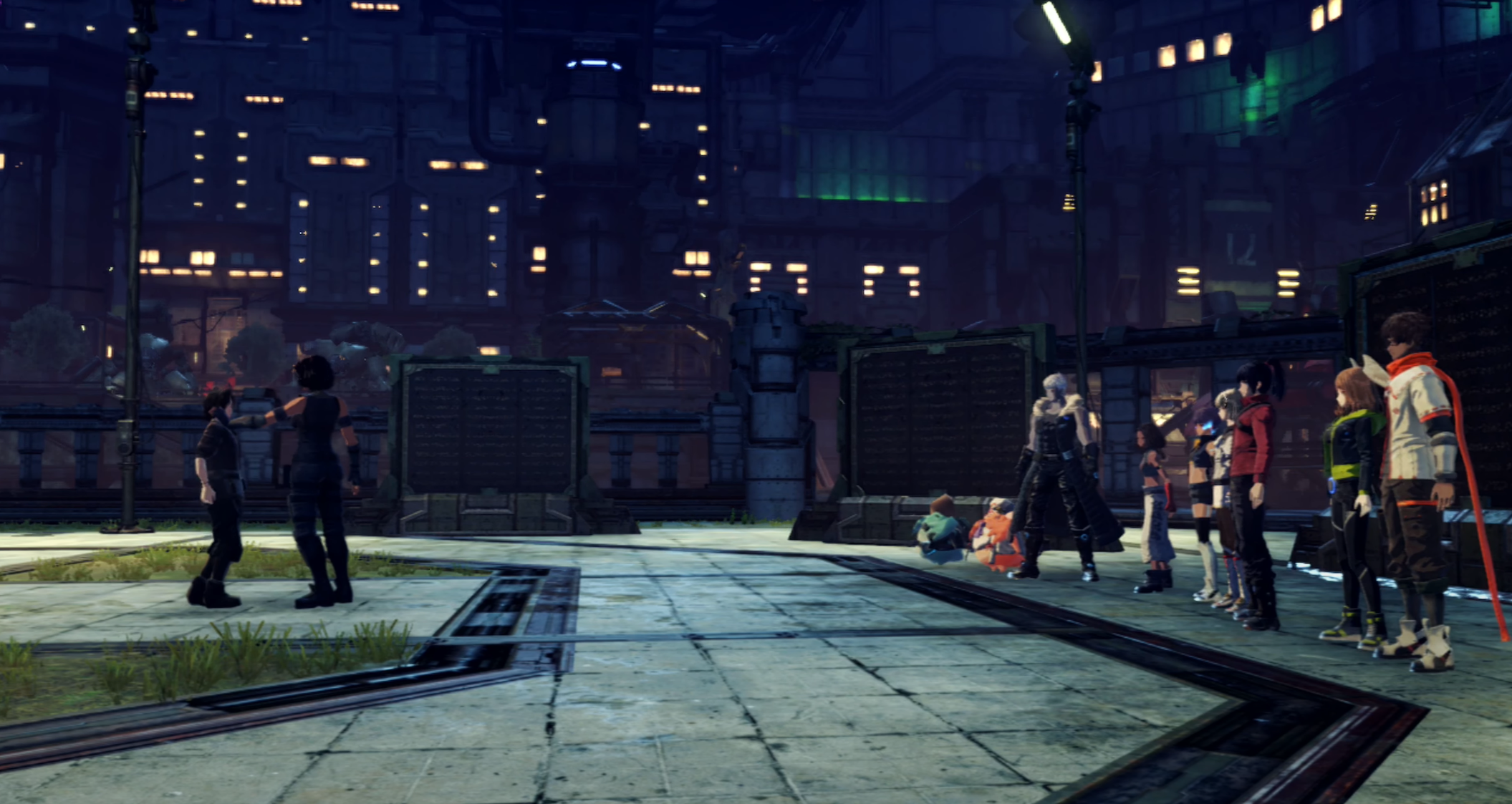
As Monica’s daughter and Ouroboros look on, Monica wordlessly renders judgment on Shania’s resentful mother following Shania’s death.
Yet by the same network of family resemblances, Ghondor recognizes that parents are uniquely positioned to empower their children to discover and hone their own talents, which are by that very fact connected to the concept of ‘family’, regardless of whether the parent has a separate investment in that particular talent or not (S2, S14, C1). We see this aspect when she insists to Shania that Shania’s talent for painting is like the name ‘Ghondor’: both things which their parents gave them, and which, in Shania’s case, Shania’s father saw and encouraged, regardless of whether it served some notion of family heritage.[525] This aspect shines, too, in the moments when Ghondor calls Monica ‘Mother’ rather than ‘Bitchqueen’: when Shania’s mother accosts the fallen Moebius Shania’s grave and calls her a ‘pathetic child’, for instance, Monica’s wordless reproach—followed by her sharing with Ouroboros that the meaning of the parent-child relationship is “up to” those within it—is enough to elicit Ghondor’s one-word recognition of the bond they share—calling the one who selflessly empowers others, just as Ghondor does, “Mother” (C1).[526]
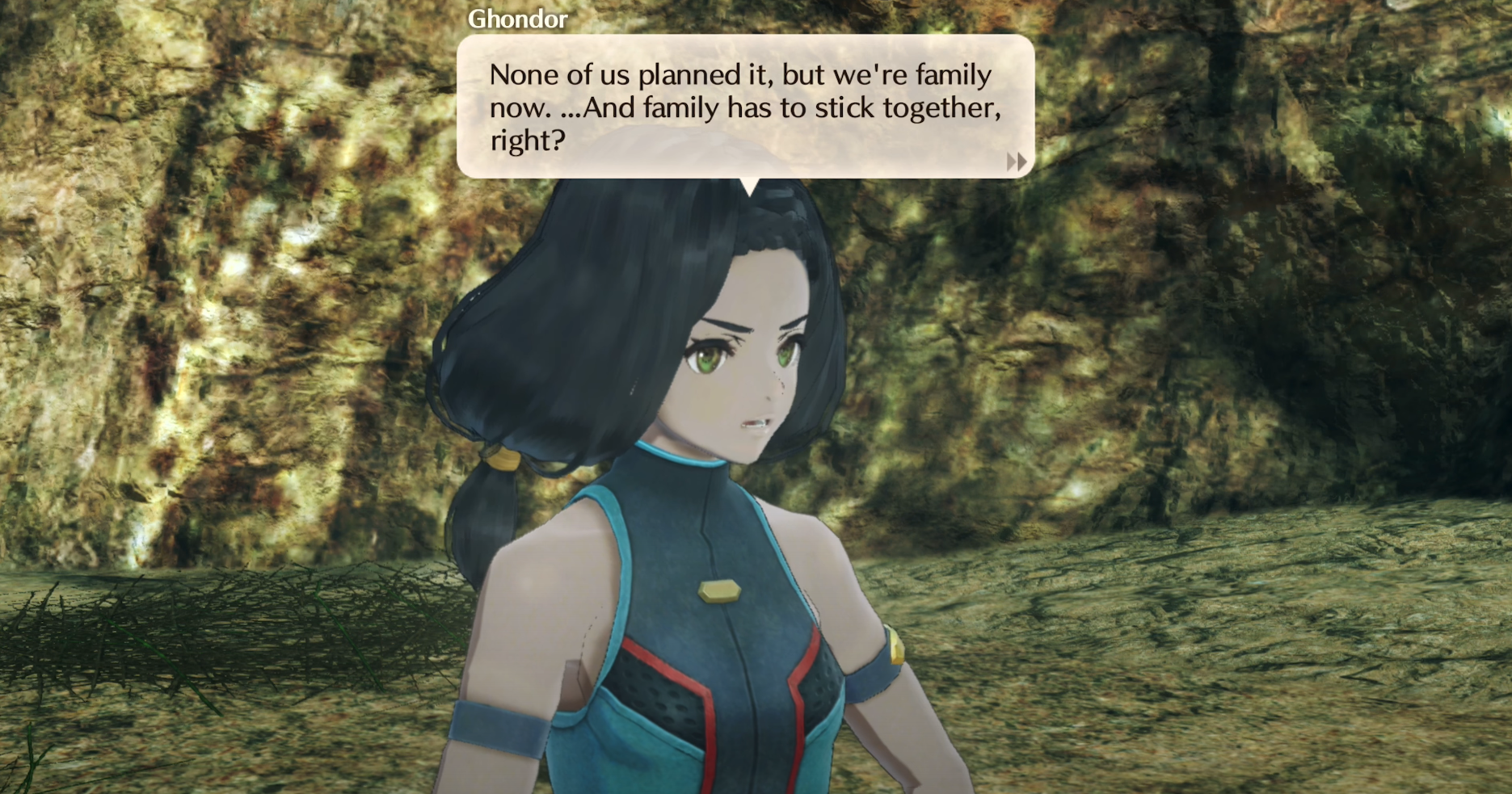
Ghondor, expressing her reasoning behind adopting the Jumbo Tirkin’s children and taking them back to Agnus Castle.
By seeing Ghondor through the lens of a Hero—and one more intimately related to the Main Story than others, at that—we don’t witness some sort of radical change in character, as in Zeon’s election to cede his role as Commander or Alexandria’s willingness to let down her guard. Instead, we see something more closely aligned with what we might call the “everyday experience” of Wittgenstein 2: a gradual shift in the family resemblances determining a concept for someone. In this case, that concept is ‘motherhood’. Outside the broader context of Ghondor’s stream of life through Aionios, her fate of adopting two orphaned “Tirklets” might seem like something between a joke and a non sequitur. But step into that stream, and throw out your notion of Tirkins as essentially monsters by virtue of them being something that avatars battle in combat. Suddenly, these barely verbal birds start to bear their own family resemblance to Ghondor’s experience with Shania: Ghondor saw how the figurative death of Shania’s only remaining parent—in the form of the parent forcing the weight of House Reid following Shania’s sister’s death—turned Shania into a monster, both a traitor to the City and a member of Moebius for Ouroboros to defeat. Should it be any wonder, then, that she would see two children equally on the verge of either becoming civilized creatures or mindless brutes, following the literal death of a parent, and take it upon herself to nurture them in the civilized direction? (S2, S11.)
The Ghondor whom we first meet, in the liminal space between hating and honoring her name, already has suggestions of this disposition in her nature. Her treatment of Aggy, Oggy, and the rest of her City cohort in Li Garte Prison is like that of a mother presiding over her brood, albeit with the toughest of love: it’s this motherly figure who, after the Ouroboros expresses concern over downed City folk in the prison yard, tells those prisoners, “[y]ou get up right now, or so help me, I’ll tear you limb from limb and feed you to the Ferises my-bloody self,” reassuring Ouroboros thereafter that she’ll “pile ‘em up somewhere outta the way.”[527] Yet this behavior manifests in the context of the City and serving Ouroboros, contexts that pertain to Ghondor’s family unit of House Vandham, dedicated to the City and the Ouroboros for which it stands. It’s a further step to empower those beyond her existing family unit to pursue their talents, and this is what the resolution of Shania’s tragedy makes possible (S16).
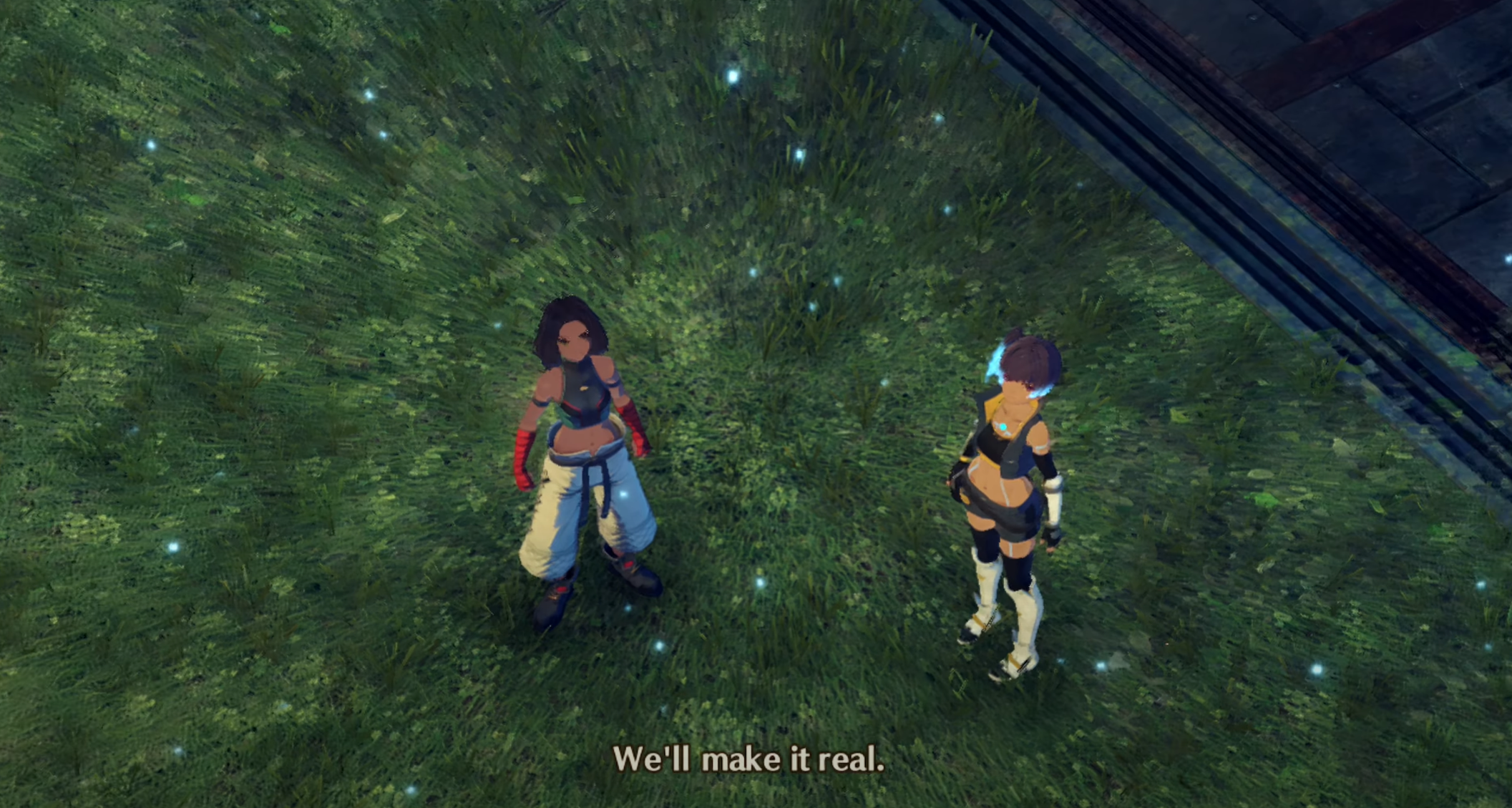
Ghondor and Sena after Shania’s death, resolving to create a world in which someone with Shania’s talents would have a place.
Ghondor may be apt for these more subtle adjustments of her concepts because she’s a Hero from the City, a place that was born of Ouroboros and is therefore able to naturally accommodate a plethora of worldviews, contra the Colonies under Moebius. That aspect of her heritage carries all the way through to her Class Inheritor, Sena.
Most Heroes confer their Classes on Inheritors who see something of themselves in the Hero, as when Taion recognizes that he and Alexandria both “fight when [they’re] confident.”[528] Ghondor and her Class Inheritor, Sena, aren’t really like this: Ghondor acknowledges that Sena’s blow in their first (mock) confrontation was “[o]ne helluva hit,”[529] but the substance of their connection seems to be more thoroughly described by the importance of their relationships with Shania—Ghondor seeing her as a peer whom she sought to help out of a toxic family situation, and Sena seeing her as a cautionary tale of what she could become if not for her friends in Ouroboros and the forms of life they afford her. As with her stance on family itself, Ghondor’s own balance between her heritage in the City and what she chooses through her interactions with Ouroboros makes it effortless for her to negotiate complex networks of relationships, and to see herself in someone like Sena not because of their identities per se, but rather because of what a mutual third party means to each of them (S2, S15, C2).
§2.245: Ino: How to Turn a Metaphysics into a Language-Game without Destroying a World
If Sena’s Inheritance of Ghondor’s Class shows how family resemblances can make new connections between people possible, then Ino’s introduction to the party shows how important family resemblances are to communicating with people at all.
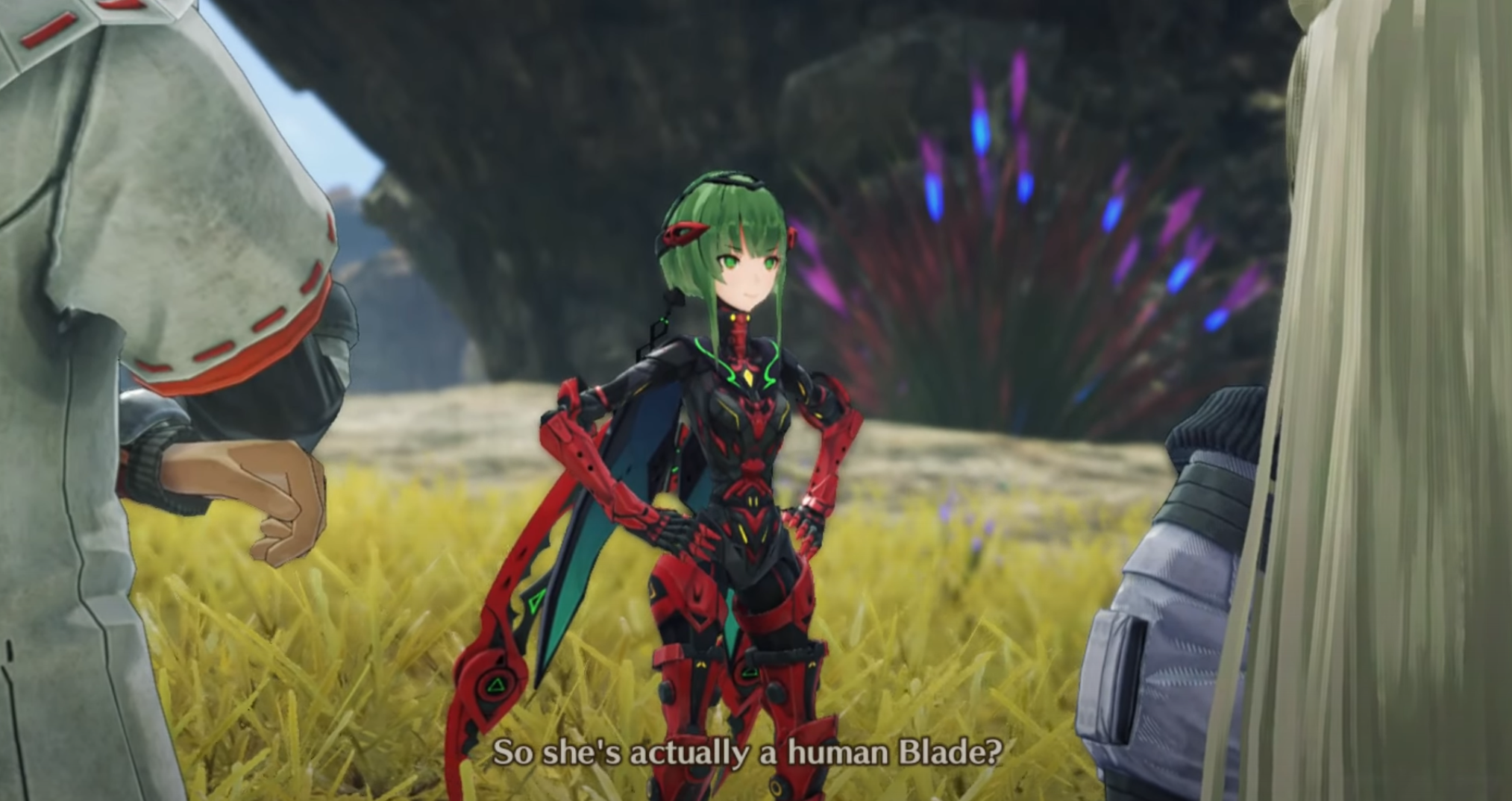
Ouroboros tries to wrap their heads around what exactly Ino is after meeting her in the Dannagh Desert.
Ouroboros tries to wrap their heads around what exactly Ino is after meeting her in the Dannagh Desert.
From Ouroboros’ perspective, it’s hard to imagine meeting someone more categorically a non sequitur than Ino:
- Her body is mechanized, and she describes herself as “artificial.”[530]
- She identifies herself as having been created to “bring about peace and harmony for all Nopon throughout the world,” despite not being a Nopon, and adds that her creator instructed her not to “get involved in affairs of humans”[531]—a startling new nuance to the Nopon culture that, despite interacting with Colonies, is largely an inscrutable culture unto itself, following “[its] own unique rules” outside of those governing those born into Moebius war game.[532]
- She refers to herself as a “Blade” and to Noah as her “Driver,” a paradigm for which Ouroboros’ only frame of reference is the idea of a “Blade” as a weapon they call according to their Class.
Of course, the player of Xenoblade Chronicles 2 has different frames of references available for Ino’s appearance and language: this player knows the Blade-Driver relationship as a part of Alrest, describing a specific, symbiotic bond that emerges between two different kinds of lifeform;[533] she knows the lineage of a particular Nopon, Tora, to have engineered mechanical versions of those lifeforms called Blades to allow those such as Tora, who lacks the potential to awaken a Blade, to become a Driver.[534] But remember, the player doesn’t appear in Aionios, and this background is no more useful to Ouroboros, no more present in their world, than the histories that Nia and Melia withhold from them (S7, S8).
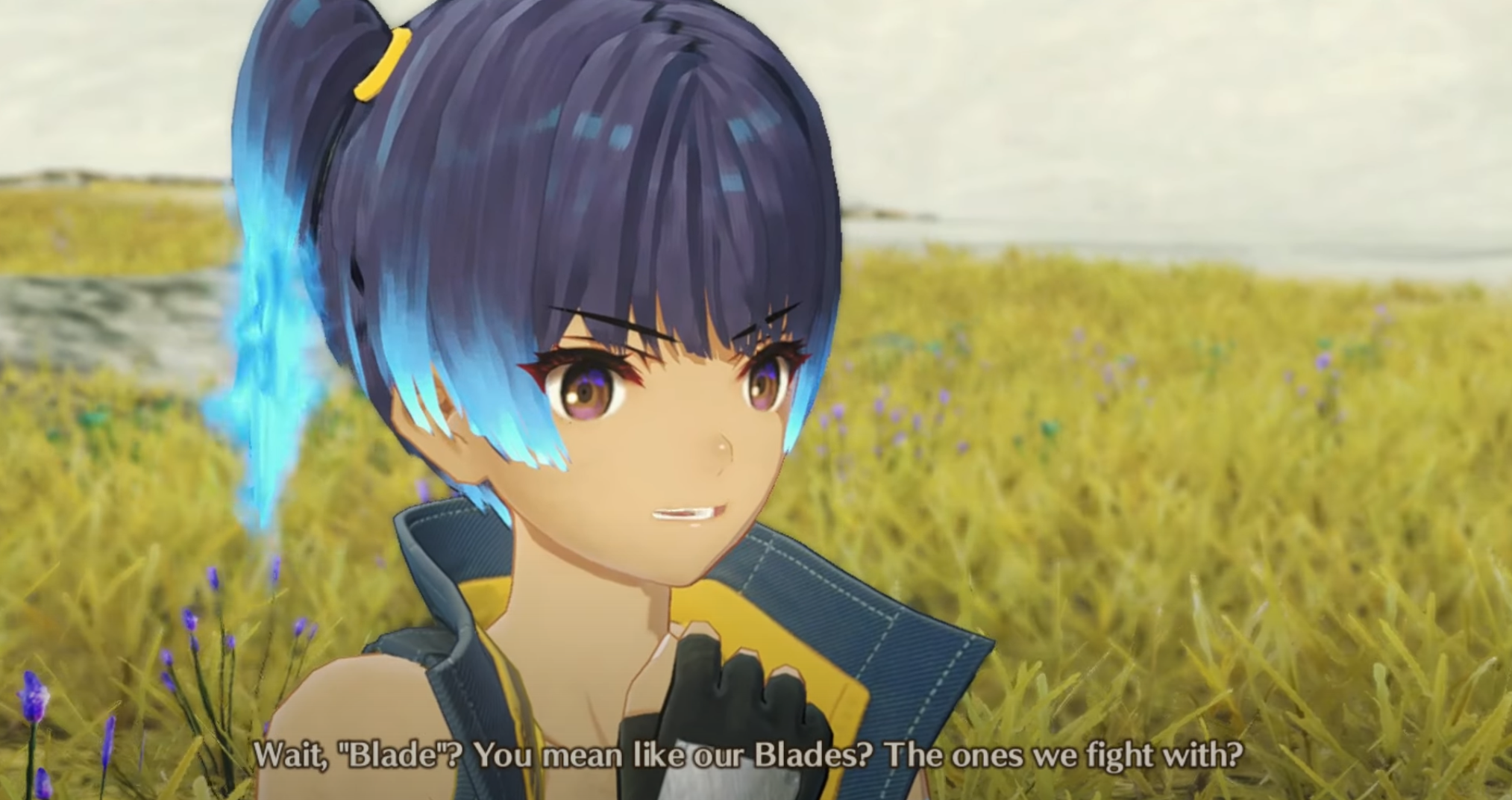
Sena tries to understand Ino’s language-game.
What’s remarkable about Ino is that her worldview, characteristically similar to Z’s, integrates into Ouroboros rather than being destroyed by their language-games. Seen in this light, I think this shows us a different way in which to appreciate just how thoroughly Ouroboros forgives antagonists like Z and even N—that it really is “OK” for them to have chosen an action like preserving the present rather than moving ahead.[535] For both Wittgenstein 1 and Ino insist in their language-games on the essences that explain and limit things: this is the one thing that constitutes meaningful expression in the world; this is the nature of the Hero-Inheritor relationship that makes possible their collaboration inside and outside of battle. Treated as such, these games can render mutual understanding impossible; however, treated as just one language-game of many, the games’ emphasis on the essential can be “deflated,” and the game can be discovered to have a use after all (S3, S10, C3).
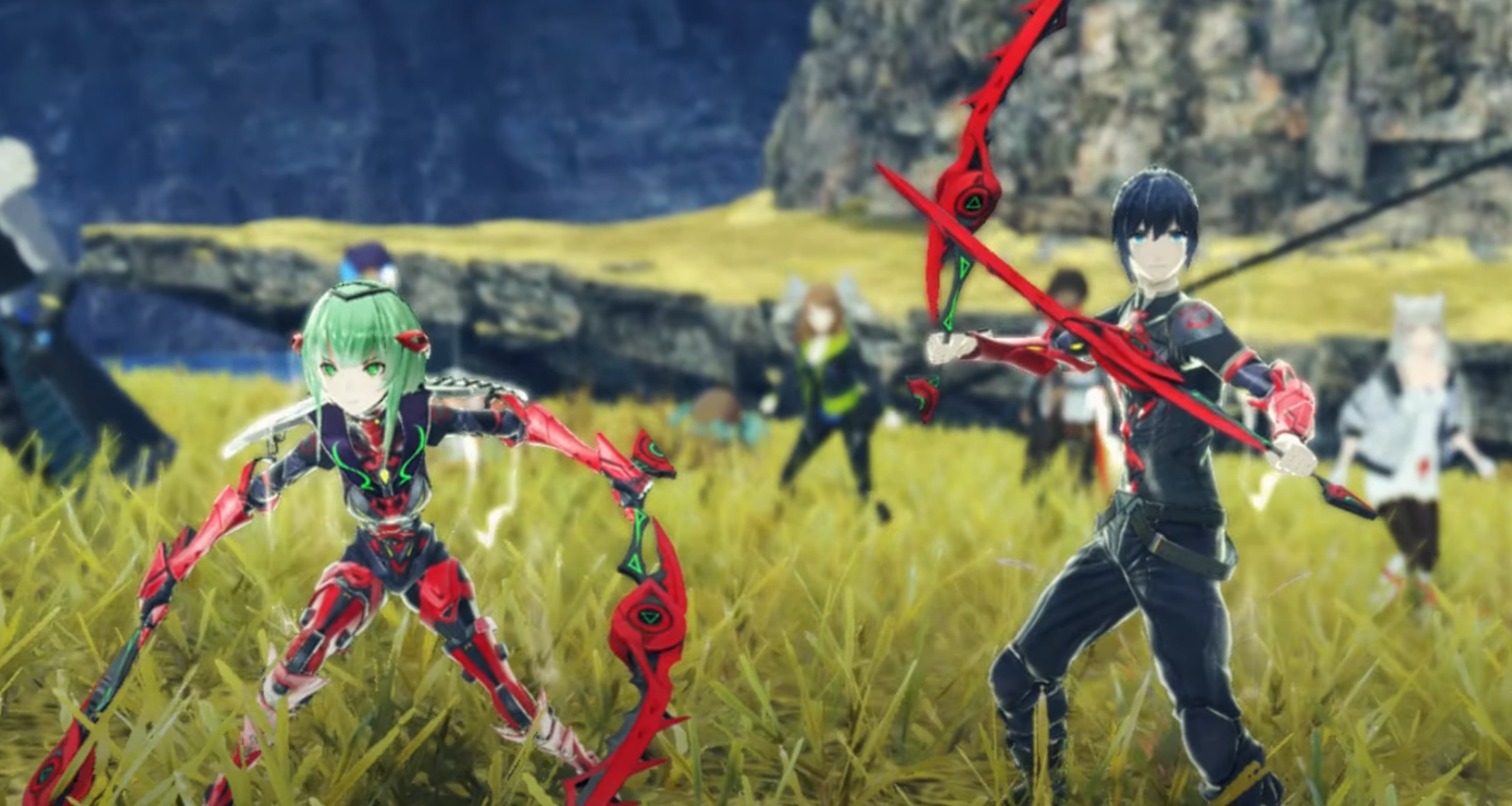
Ino and Noah achieving a sort of “affinity” in battle with the Nopon Eater.
Look and see how Ino and Ouroboros interact through language. Lanz, Sena, and Taion try helplessly to puzzle out what Ino means by ‘artificial Blade’ by conceptually ramming the reality of her appearance against their familiar notion of Blades, a square peg in a round hole—thus we see Lanz (again, accurately) complaining that “[t]his is making less sense by the minute,” Taion suggesting that she is an “anthropomorphic Blade,” and Sena remarking that the whole affair is “fishy.”[536] Notice that they were led down this path by a flustered Taion asking “[w]hat in the world” Ino is:[537] Ino sees this as the right question to ask, but her perspective and language-game is one that prioritizes answering these questions of essence, which is exactly where the massive gulf of misunderstanding opens up between her picture of the world and Ouroboros’ experience of it. In contrast, Noah enters the conversation and focuses on what Ino has already done: he notes that “well before we ever turned up… you were protecting the Nopon caravan,” which is enough for him to believe what Ino says even with contextual distance between them—and this is enough for him to Inherit her Class (S8, S9, C2).[538]
This refocusing on action makes communication possible where it wasn’t before (S1). What is a ‘Driver’ to Ino is made useful to Ouroboros through description as ‘humanperson who fight by side of Ino’; their unity of purpose in saving the Nopon is made meaningful to Ino as under the description of ‘best and truest manifestation of affinity between Ino and Masterpon’, which the player and the other Ouroboros (Taion, as least) sees as a “glow” around them both (S9, C1).[539]
Don’t look at this glow, reach back to essentialism, and infer that the Driver-Blade relationship of Affinity on Alrest has somehow been passed down to Aionios; don’t look for the Architect in the sky and wonder whether his Cloud Sea, Core Crystals, and hand-tailored lifecycle have poked through, from some far-flung dimension, into Xenoblade Chronicles 3. To do so would be to go the way of realists, idealists, and solipsists, inferring something ontological from a language-game (S3). Look instead to Ouroboros, and how we’ve spent most of the game staring at Interlinks representing the relationships of two characters in different aspects (S9). In Noah and Ino, too, we are seeing a new aspect “lighting up,” literally and figuratively; our being struck by their alignment doesn’t imply a new metaphysics for the world. We’re bearing witness, in one moment, to the full realization of person-to-person collaboration across an interpretive divide: Ino and Noah know each other and move as one despite interpreting those actions in different terms (C2). With all Heroes, Ouroboros does something that only someone with their linguistic facility can do: they find enough common ground with someone else to participate in a form of life in them, without reducing either party to something less than itself in the process—something we see in game mechanics as simple as Class Inheritors taking on the names of some Hero Arts verbatim, yet translating many of them into something with a different name.[540]
The portraits of Aionios’ Heroes, then, are opportunities—and challenges—to understand ourselves and others in a multitude of new interpretations without treating a person, as N does, like an actual portrait (S11, C2). That capacity is what it takes to recognize that the Endless Now that Moebius holds absolute is just a group of people playing one of many games inside a portrait of their own design—and only once that activity is seen clearly can N, J, and everyone else clinging to it put it down (C3).
§2.25: Life’s Inevitability: The City and the Lost Colony
Why did Z demand that Noah destroy the City in order to join Moebius?
In the stream of the game, having just seen Noah wrestle with his past and the agony of N, my own first reaction was to think about this in the light that Noah and N seem to:[541] the challenge was for Noah to entirely do away with what he had created with Mio, choosing one thing he valued (Mio) over the other (the City).

The City as Ouroboros first encounters it after the events at Keves Castle.
There’s another light in which to see this directive. As Crys says of the City while he dies, the new lives of the City—“never recorded in Origin”—are “proof of the coming winds of change”; like Ouroboros, they are “our hope.”[542] In the light I’m talking about, I don’t mean that the City is hope to overcome Moebius through their many military activities against Moebius: I mean “hope,” “proof of change” in the fact that their mere existence demonstrates that Moebius’ game is only a game, and nothing which anyone has to play. It’s an ecosystem in which a person like Shania may choose to participate in Moebius’ form of life, but may just as well choose to raise a child,[543] or make straw dolls,[544] or create works of fiction.[545] The mere existence of such a place exposes Moebius’ house of cards, putting it in Z’s crosshairs.
More so than the sights of families, wrinkles, and births—the sort of experiences that might convince you perhaps you had been to the moon after all (S8)—what seems to linger with Ouroboros from this bastion of culture is the number of different forms of life it supports, the options it affords for interpreting one’s place in the world (S11). Heroes like Ghondor, Monica, and Gray don’t just demonstrate what a biological family is: they also illuminate how many different things can count as ‘family’, as the Storyspinner Taleb echoes in his utterance that “love takes many forms. There are as many ways to show it as there are people”[546]—as we’ve seen our three Ouroboros pairs embody throughout their journey. Before the City, Joran was a traumatic casualty who was now defined to all as the enemy; after the City, maybe Joran could have walked a different path, had he been empowered to acknowledge doll-making as his form of life[547]—and maybe it’s possible to present a different interpretation of Joran to J. All it takes is putting on an eyepatch to stop the Wittgenstein 1 picture from finding us,[548] and suddenly, we see a menagerie of language-games where once stood the single directive of war.

The Lost Colony, Nimue’s home.
In the sense that I’m describing it, the City isn’t the only “City.” Nimue’s home, the Lost Colony, shows us how self-defeating Moebius can be even without active resistance helping them along. The Saffronia-papered land is a Colony that Moebius seemingly forgot, abutting the ruins of a long-gone castle, its people tending the landing rather than fighting, free from Flame Clocks and Consuls.[549] The only Consul interaction we see with it underscores how blind Moebius is to the Colony: the incompetent V (our same Consul who plays the stage rendition of a war game with R) accidentally stumbles upon its vicinity from the errant signal of a broken Ferronis, only to find himself swiftly overwhelmed by Ouroboros without ever learning of the community.[550] While some (such as the Commander) seem to feel guilty about abstaining from the war,[551] Taion and a reborn Nimue are ultimately able to acknowledge the Lost Colony as nurturing a form of life rarely found anywhere, even in the City: rest.[552]
The Lost Colony shows us that, even in the absence of Ouroboros and its method of relating to one another, the infinite war Moebius takes itself to have imposed upon the world is illusory. Moebius claims that they have determined how the world will proceed ad infinitum, but that determination, when all is said and done, is purely a preparatory proposal for a language-game: we must agree to follow the proposed rule each step of the way, and we can simply stop playing it, for whatever reason, at any point in the series (S6, S7, C1, C3). This is where our view of Wittgenstein 2 overlaps with the Moebius defectors whom we studied in Part 1: just as Triton simply forgot what had driven him to Moebius and stopped acting as a Consul, so the state of the world which Z would claim to be essential takes constant, obvious work and upkeep—namely, all the machinery we saw at work in the anatomy of the Endless Now. The grip of solipsistic despair can be alluring and is deeply relatable, but it remains an impetus to act; once we stop reading the action as a compulsion, we realize we can participate in any number of other forms of life, like appreciating and tending to the natural beauty of the Saffronias.
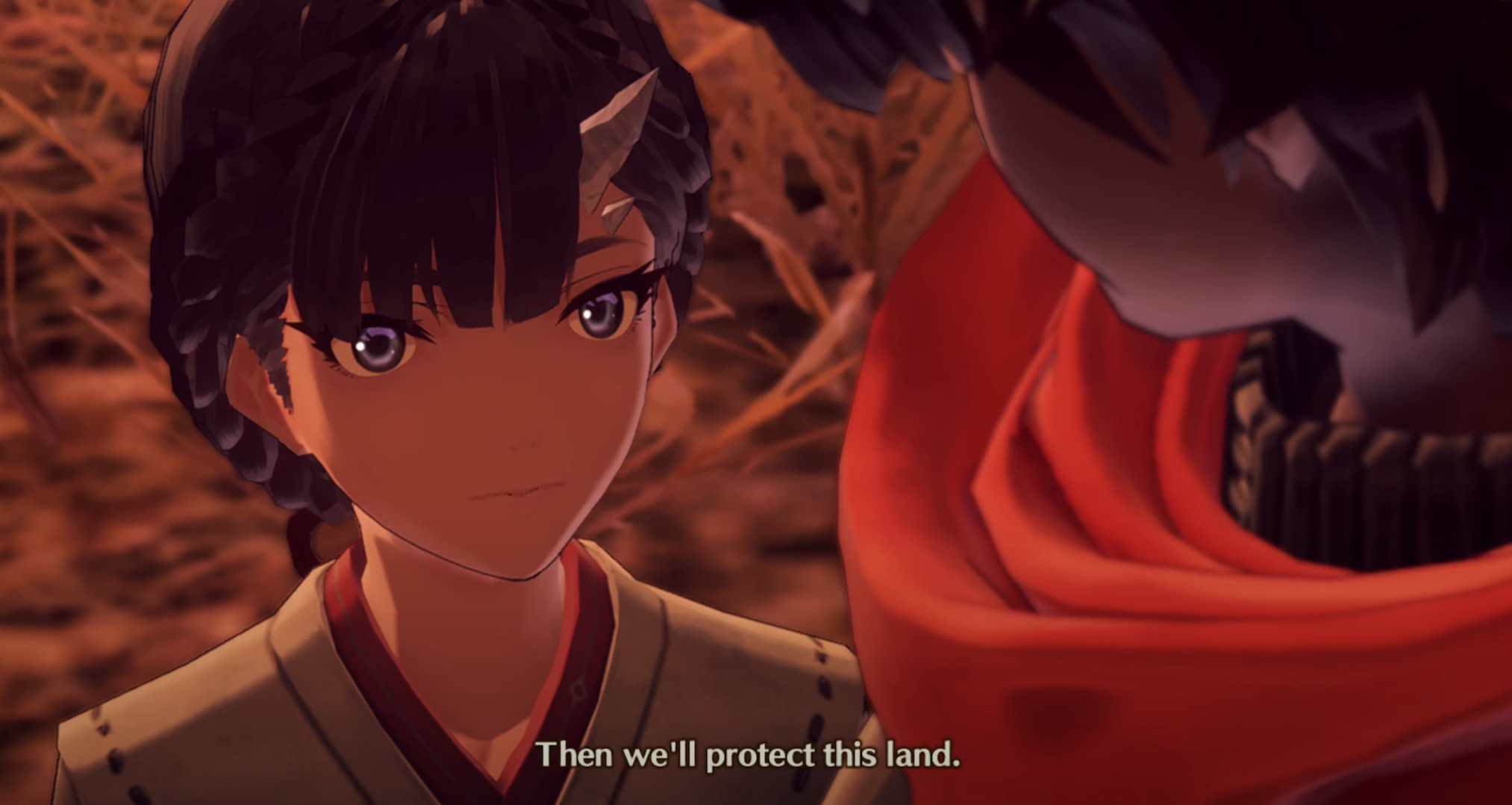
Nimue, agreeing through conversation with Taion to maintain the way of life made possible in her Lost Colony.
Jointly, these communities, the City and the Lost Colony, are two signposts pointing the way for Ouroboros to act within the world therapeutically (S11). If we find ourselves tangled up in a particular picture of how we are limited within the world, we need only speak with others to give ourselves new interpretations and wrest the picture from our minds. As the Tractatus itself says, “[t]he world of the happy is quite another than that of the unhappy,” and “[if] good or bad willing changes the world, it can only change the limits of the world.”[553] Yet rather than stay inside of the Tractatus and remark, as it does, on the inexpressibility of such changes, Ouroboros can put the Tractatus down—as the Lost Colony does—and look upon other forms of life, other language-games, according to which those conversations with others can effect new, productive ways of valuing our place in a community of many values—like the City. Once this is seen to be possible, it becomes a contagion: every Colony is a City, every Hero the bearer of a new form of life as precious as Nimue’s.
Where Moebius seemed impregnable and total, Ouroboros is obvious: just look closely at the lives and actions of yourself and others, and what once seemed total becomes a mere aspect. Our next task is to see the steps Ouroboros takes to empower themselves, others, and the player to let that aspect of despair go in favor of hope.
§2.26: Ending the Endless Now
There are 7 main propositions in the Tractatus, and there are 7 Chapters in Xenoblade Chronicles 3. In finally examining the activity by which Ouroboros unravels Moebius, Wittgenstein 2 overcoming Wittgenstein 1, I want us to play a game together: reading the 7 propositions and Chapter names as a call-and-response between Wittgenstein 2 and Wittgenstein 1.
The biographical Wittgenstein once told Norman Malcolm an anecdote that, during a conversation with friend and Italian economist Piero Sraffa about the Tractatus’ idea that propositions and the things they describe need to share a logical form, Sraffa made a Neapolitan hand gesture expressing disgust at Wittgenstein and asked him, “What is the logical form of that?”[554] In the way that this gesture demonstrates there’s more to expression than pictures of facts, we’ll look at the events of each Chapter as therapeutic gestures helping Moebius, Ouroboros, and the player alike to look beyond Aionios, Moebius’ picture of the world, and feel peace in walking on—perhaps similar to the sort of gesture Wittgenstein had in mind when he contemplated publishing the Philosophical Investigations side-by-side with the Tractatus.[555]
And now don’t say, “This will give me a theory of the reason why Xenoblade Chronicles 3 consists of 7 Chapters that are named as they are.” What we are doing together is playing a language-game; if we agree, when all is said and done, that this language-game casts the narrative structure of Xenoblade Chronicles 3 in a useful light within the broader context of this interpretive work, then that acknowledgment is what marks it as useful.
§2.261: The First Chapter
Tractatus 1: The world is everything that is the case.
Xenoblade Chronicles 3, Chapter 1: Ouroboros.
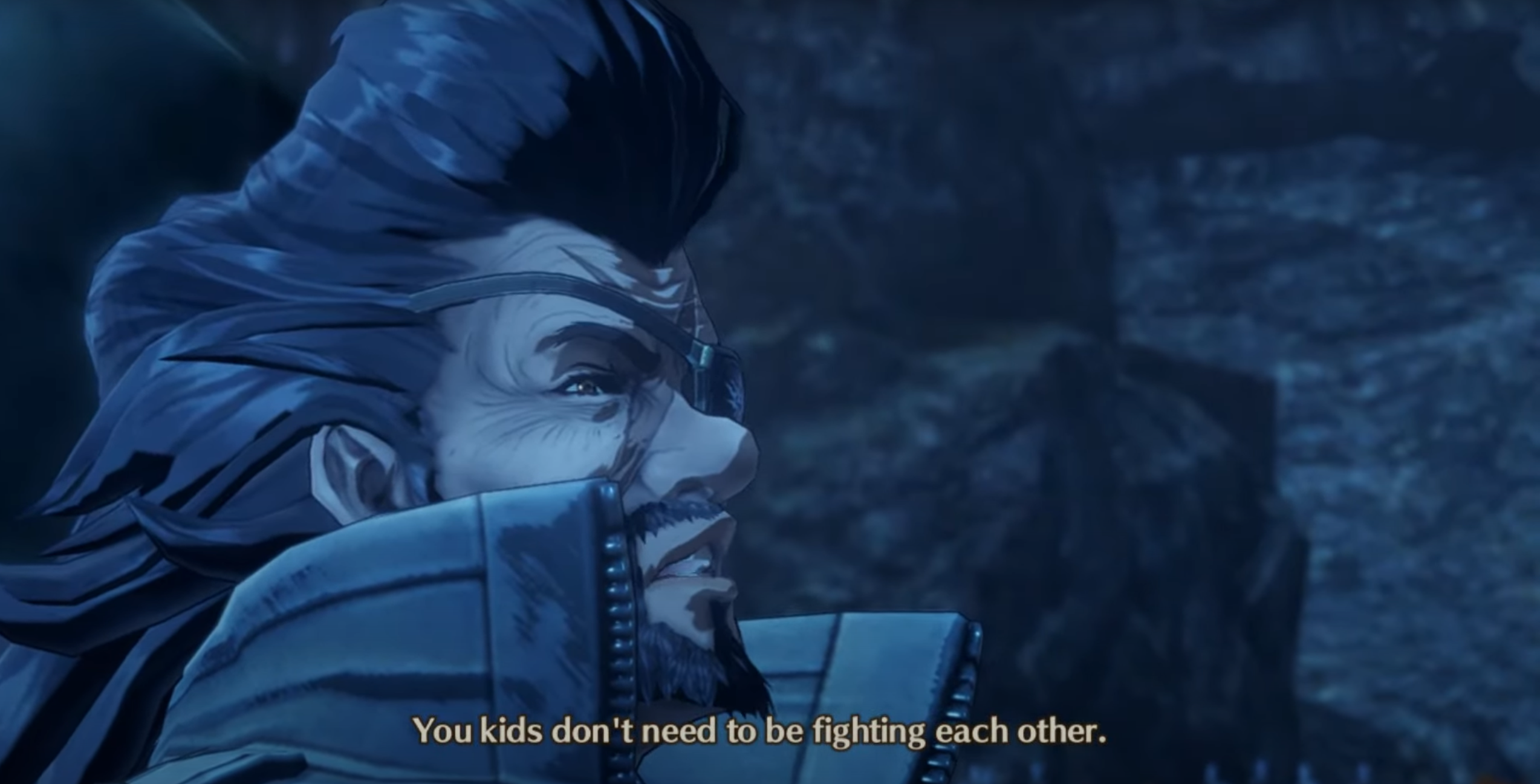
Guernica Vandham explains Ouroboros’ freedom from the war game that previously limited their forms of life.
Noah, Eunie, Lanz, Mio, Taion, and Sena are born into a world defined by war, never given the tools to think of themselves or each other in any other role than that of the soldier; when they bathe together communally, there’s no thought to separating the sexes because there’s no mode of thought to which intimacy applies.[556] Even without knowing of Moebius, they act only as pawns in Moebius’ game, with any thoughts or feelings that don’t apply to the game limited to the solipsistic world of thinking without acting (as with Noah’s inner speech, which he can’t even identify as his[557]). Only once Guernica confers Ouroboros to them can they see beyond the facts as Moebius would have them, with Noah and Mio instantly freed from seeing Z’s picture of the world as the only one by being thrust into a new context that shows the possibility of conversation about the emotional content they previously took to be inexpressible. They don’t yet know each other, but through Ouroboros, they know that they can know each other—giving them a vantage point from which to see that they “don’t need to be fighting each other,” and to participate in their first joint, musical expression: the sending off of a man who belongs to no Colony, already a form of life beyond the scope of Moebius’ language-game.[558]
Wittgenstein 1 calls that the world is everything that is the case, an empirical totality that we can engage by affirming or denying—keeping our interiority interior, since it doesn’t belong out there in the world. Wittgenstein 2 looks at the other, looks at itself, and responds: “The world is more than my world, more than assertoric content about things beyond myself. It’s the conversations between people, the form of life that is Ouroboros, and seeing clearly both the people in the world of that game, not the world you gesture at out ‘there’.”
§2.262: The Second Chapter
Tractatus 2: What is the case, the fact, is the existence of atomic facts.
Xenoblade Chronicles 3, Chapter 2: Moebius.
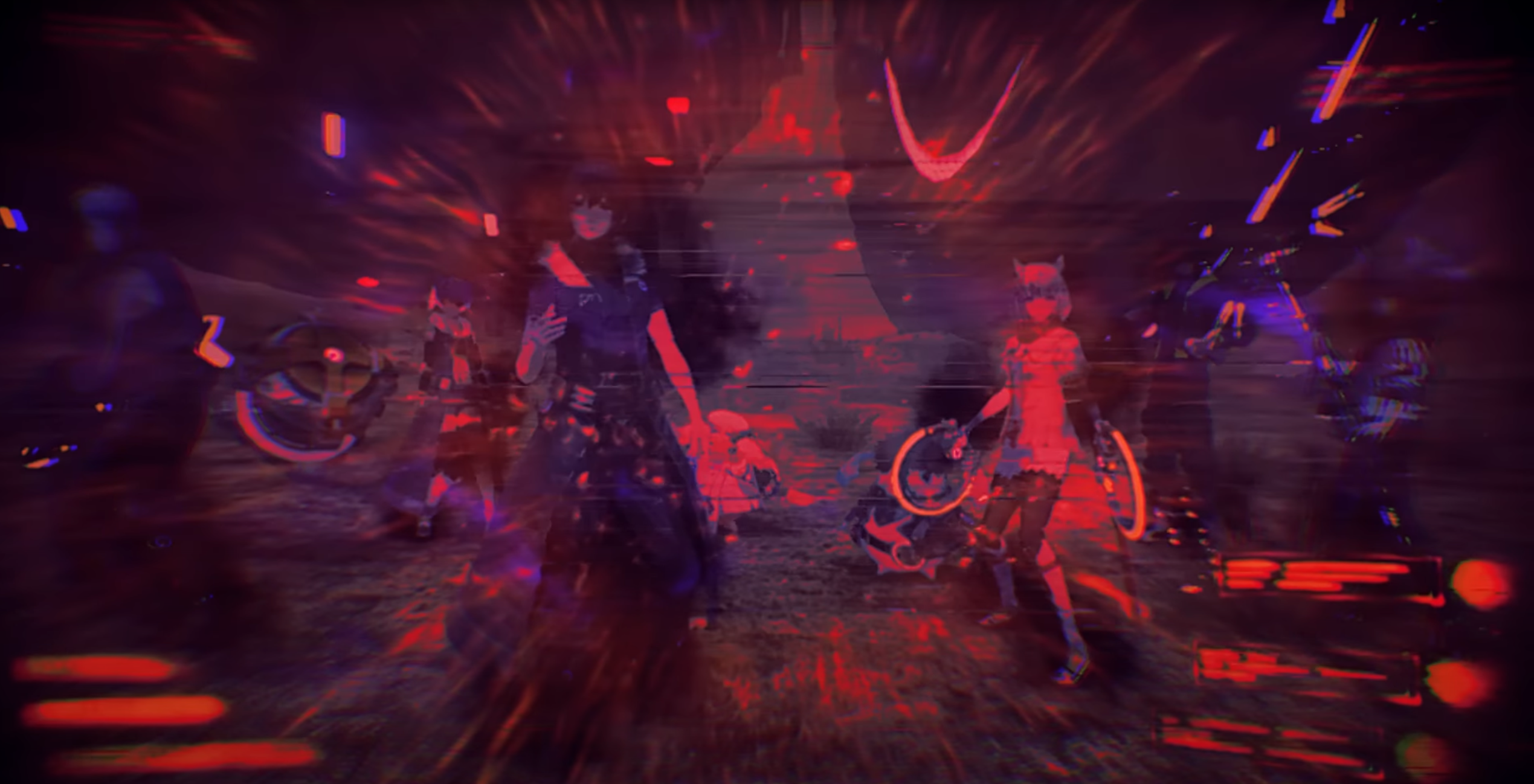
Ethel’s visual field, after Noah and the rest of Ouroboros are able to stop K’s picture from obtruding itself upon her mind.
Enfolded by the new language-game that is Ouroboros, Noah and his friends gradually discover the variety of uses to which they can put those aspects of themselves they previously took to be essential, unsharable. Identity-shaping Classes become name tags, a new UI symbol that can be shared as easily as a conversation[559]—or, indeed, as easily as Ouroboros Interlinking can be shared between different pairs of people with sufficiently aligned riverbeds of thought.[560] What was previously unthinkable becomes a tactic for overcoming those bound to one way of seeing a multifarious world: the black fog—which, like an Interlink, precedes an annihilation event between elements from distinct worlds[561]—becomes an edge, a way to navigate the world which Moebius like K literally can’t see because it doesn’t fit within their picture of a single, reductive set of atomic facts as the source of all significance.[562] With these new tools, they’re able to show Ethel that the monstrosities she sees when she looks at them are just one picture forced upon her mind by K, by Moebius;[563] with these new tools, Noah is able to draw Lucky Seven for the first time because he’s found a use for it worth endorsing, undermining Moebius’ war games rather than furthering them.[564] Ouroboros smashes the Clock like Wittgenstein smashed the idea of clocks ‘measuring a fraction of infinity’, a meditation from Street & Smith’s Detective Story Magazine, in his 1936 Cambridge lectures on sense data and private experience:
The clock becomes a bewildering instrument here because [the narrator] says about it ‘it measures a fragment of infinity, measuring something which does not exist perhaps’. What makes the clock bewildering is that he introduces a sort of entity which he then can’t see, and it seems like a ghost.[565]
Wittgenstein 1 calls that what is the case is the existence of atomic facts, mutually independent states of affairs that jointly constitute all there is, and all that can be verified through infinite operations of significant language. Wittgenstein 2 looks at its tools—at its own, fresh language-games—and responds: “What you take to be the essence of the world is just a set of name tags preparing us to play one game, the game of Moebius, in the world. To present those tags as fundamental to experience is to reduce the diversity of two people in conversation with one another to one, which is the error your Möbius strip symbol commits.”
§2.263: The Third Chapter
Tractatus 3: The logical picture of the facts is the thought.
Xenoblade Chronicles 3, Chapter 3: Saffronias.
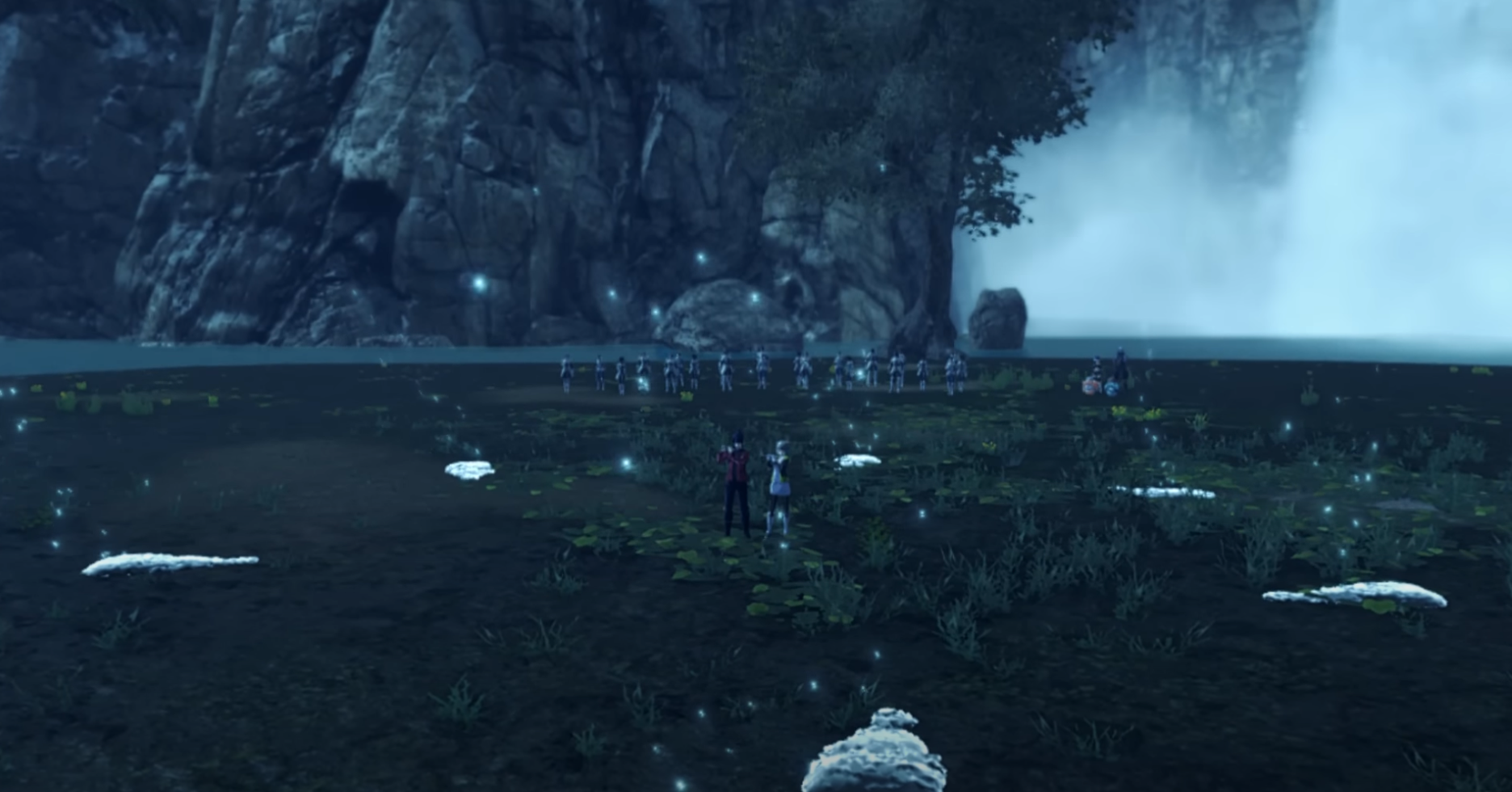
What is the logical form of playing music for puddles of mud?
“[T]he [musical] theme is a new part of our language, it becomes incorporated in it; we learn a new gesture.”[566] As Ouroboros begins to recognize the previously invisible limits of Moebius’ game, they become correspondingly aware of the wide range of other gestures they can make in order to strengthen the bonds between themselves and others according to forms of life for which Moebius has no frame of reference. Beyond showing Ethel forms of expression outside of Moebius, she and Noah discover, through the sharing of a supply raid and the community in Colony 4, their similar commitment to serving their causes, even if it sometimes comes at the expense of their own well-being[567]—and Ouroboros discovers Hero Quests, a gesture to Inherit Classes and cultures from Heroes.
Through conversation, Sena and Mio feel their way into the concept of other Interlink forms, other aspects to the Ouroboros relationships, before they’re able to define them in a way that the aspect “lights up” for all of us. Facility with gestures leads to deepening Ouroboros relationships: where once the same picture of war was forced categorically upon them, now Noah has the language to suggest to Taion that Nimue shared a picture of a Saffronia from the Lost Colony in order to “share [her] memory” of home with him;[568] even before Eunie puts words to her terror over seeing her Husk, Taion is able to bring about a different language-game that’s just as much “about” her fear by noticing their shared physical behavior—tremors—and speaking with her over a cup of his soothing tea.[569] So quickly does their once-impoverished toolkit overflow that when Joran faces them with mudpuppets which he takes to represent “all [a person is] feeling, deep inside,”[570] he’s already revealed himself as someone trapped in emotional solipsism, taking people to house essential despair rather than express feelings as language. If the logical form of a mudpuppet is the same as a person’s thought, then what is the logical form of sending off those mudpuppets?
Wittgenstein 1 calls that the logical picture of facts is the thought, that the only way of sensibly relating oneself to the world is by picturing it as Z does in his Amphitheatre; Wittgenstein 2 surveys and enacts the gestures of a human life, and responds: “Just from the fact that you can picture some things, it doesn’t follow that the meaning of such pictures in verifying your preferred facts holds some primacy in the myriad of meaningful uses to which we can put our thoughts and words. A picture of a Saffronia tree shared with a loved one is no more a logical picture of the facts than Moebius holds dominion over the Colony nestled in a grove of those Saffronias.”
§2.264: The Fourth Chapter
Tractatus 4: The thought is the significant proposition.
Xenoblade Chronicles 3, Chapter 4: Life.
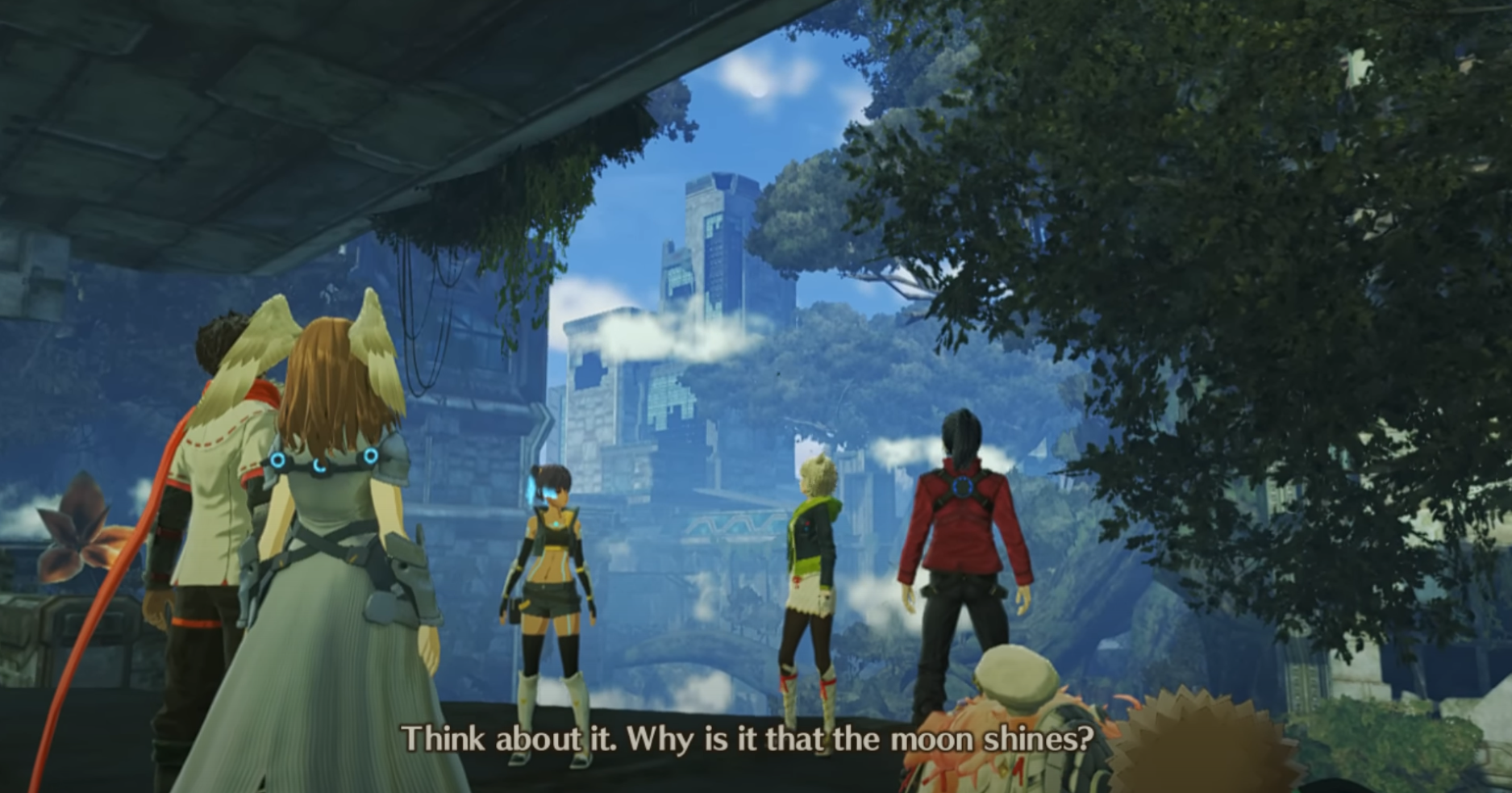
Noah plays an interpretive game with the moon.
On their way through Maktha Wildwood, Ouroboros plays an interpretive game with the moon. If the world itself is evil because of the order that Moebius has forced upon it, is the only morally defensible option, as Taion warns, suicide? Noah looks at the moon, and responds, “The world doesn’t just vanish because you’ve closed your eyes”:
Think about it. Why is it that the moon shines? Just because we’re watching? Of course not. Even if humans were gone, it would shine on, illuminating the land beneath. And yet… We’re the ones that give meaning to it. We say “bit dim tonight,” or… “Looks brighter than usual, eh?” Similarly, we can now imbue the world with meaning, or change it. It’s a privilege we were lucky to obtain. […] We’re obliged to use it. We can make a difference.[571]
Noah’s interpretation implies that what the party has just done by calling the world bad, a “supervillainpon,”[572] is already an instance of the party’s developing privilege, as Ouroboros, to “imbue the world with meaning”: they can highlight aspects of experiences within a form of life to give themselves and others new understandings of their place in the world sub specie aeternitatis (S11). As the moon is useful to us according to the interpretations we give it in conversations with others—measuring time, measuring tides, marking astrology, marking the progress of the industrial age—so, too, can our very idea of our own place in the world be molded as to make practical use for us and others.
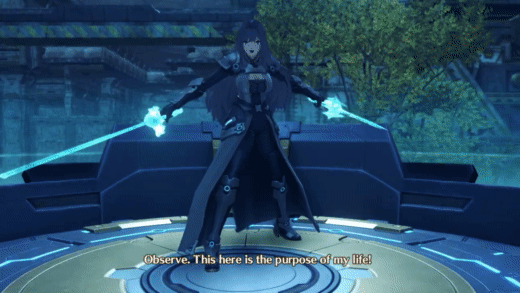
Ethel expresses gratitude to Ouroboros for showing her how to be herself, beyond the confines of Moebius.
This is a privilege afforded to Ouroboros, but, as even N recognizes, it’s a contagious privilege that spreads through contact with them:[573] regardless of whether Moebius feels it won by harvesting Ethel and Cammuravi’s lifeforce, Ethel and Cammuravi claimed their victory by freeing themselves from the Wittgenstein 1 paradigm and freely enacting their relationship’s form of life, their “dream” of pure rivalry unsullied by any expectations external to the two of them.[574] This is like the case of pupils who are seemingly able to extend a series of numbers with the same number, but do so by applying different methods:[575] Moebius may think Ethel and Cammuravi have complied with the Endless Now’s formula, but the Heroes were playing a different game altogether.
This power of interpretation brings Noah and Mio closer than N and M, before the former pair has even met the latter pair, through their exchange of flutes—an exchange of worldviews, helping them to knit their melodies together into a new form of life.[576] This power, too, overwhelms the monolithic D & J Interlink when Eunie and Taion toggle Interlink forms mid-battle, preying on Joran’s expectation of a “deep-inside despair” through an act that’s only possible by interpreting yourself according to multiple lenses. Melia’s simulacrum is almost right when she says that Ouroboros “seek[s] to bring ruin to this world”: Ouroboros seeks to dethrone (pun intended) a falsely reified worldview, putting Moebius’ picture in its place as one of many such interpretations of one’s place in the world.[577]
Wittgenstein 1 calls that the thought is the significant proposition, that our relations between ourselves and the world are basically affirmations or denials of facts-of-the-matter. Wittgenstein 2 looks at the innumerable ways in which one can think about oneself and others sub specie aeternitatis and what actions those uses of language facilitate, and responds: “A thought outside the stream of life is hardly a thought at all. Within that stream, life has so many forms through which to share ourselves with others that an insistence on the priority of asserting claims about the world is toothless.”
§2.265: The Fifth Chapter
Tractatus 5: Propositions are truth-functions of the elementary propositions. (An elementary proposition is a truth-function of itself.)
Xenoblade Chronicles 3, Chapter 5: Eclipse.
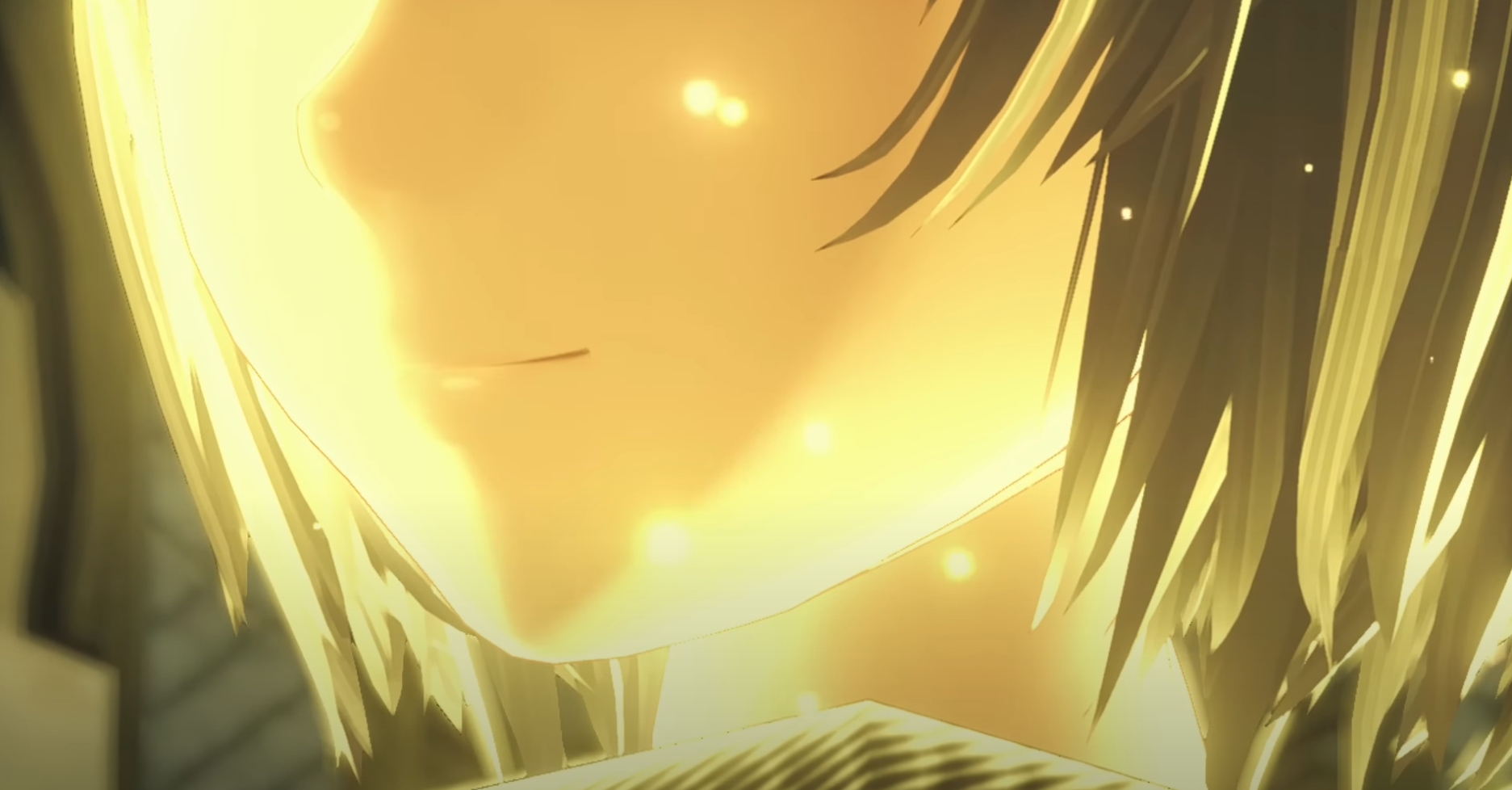
Disguised to all as Mio, M allows herself to be sacrificed on the Eclipse atop Agnus Castle.
There are 2 games of allowing oneself to be imprisoned to achieve ulterior ends in Chapter 5: Ouroboros’ elective imprisonment at Li Garte Prison, and M’s elective imprisonment—and execution—at Agnus Castle. Both follow a key lesson Ouroboros learns in the City: more resonantly than merely learning that humans can live a long time and create more humans (like learning that humans can travel to the moon after all), they see a bastion for forms of life whose raw materials existed in the Moebius-dominated Colonies, imperceptible only because there existed no conceptual vantage point from which to see them as such (like learning what our world and life all along had to do with something like traveling to the moon). The model of literal family units[578] and the non-uniqueness of the party as inheritors of Ouroboros[579] make it easier to see family resemblances in any number of concepts, not least of all non-biological families like combat teams, term-mates, or Ouroboros itself; excited participation in a doll-making game[580] makes it easier to see Joran’s talent for what it was; an economy of works of fiction[581] makes it easier to see that things can be made up with words, not just asserted about the world in the manner of their textbooks.
Even the forms of life available to the player at this stage in the game reinforce this lesson. With the opening up of Erythia Sea, there have been no radical revisions to the raw materials the player has with which to engage the game (aside from a faster rate of travel, with the Boundary), yet the suddenly vast array of different islands, quests, and avenues of exploration challenges the player fully explore the various forms of life within which she can play the game before returning to the form of ‘following the game’s Main Story’ (I lost several full days to this challenge, personally).

Erythia Sea, as the player and Ouroboros first encounter it.
“Lying is a language-game that needs to be learned like any other one,”[582] and the same goes for the closely related language-game of being authentic in a context where lying is understood to be possible. We see both on display in the subsequent motions of Chapter 5. In the first case (lying), Ouroboros acts like “model prisoners”[583] in Li Garte Prison to manufacture the conditions for an escape undermining the very system that imprisons them; M and Mio deceive everyone through a conversation, context, and plan all their own, to help N “realize what it is that [M] wishes,” and giving Noah and Mio the context “to walk the path [N and M] ought to have walked.”[584] In the second case (authenticity), Sena rejects Shania’s offered interpretation of them as “the same”[585] to sacrifice herself for others where Shania would collapse inward to deception and solipsism;[586] M, acting as Mio, finally calls Noah by his name, preparing them for participation in the form of life that is love, and smiles at him upon her departure.[587]
The authenticity of these gestures cannot be negated by Moebius’ intervention or preferred interpretation, whether that’s the intercession of X or the execution of M: they are said exactly within the context of, and yet without regard for, the Endless Now. “Could someone have a feeling of ardent love or hope for one second – no matter what preceded or followed this second? What is happening now has significance – in these surroundings […] And the word ‘hope’ refers to a phenomenon of human life. (A smiling mouth smiles only in a human face.)”[588]
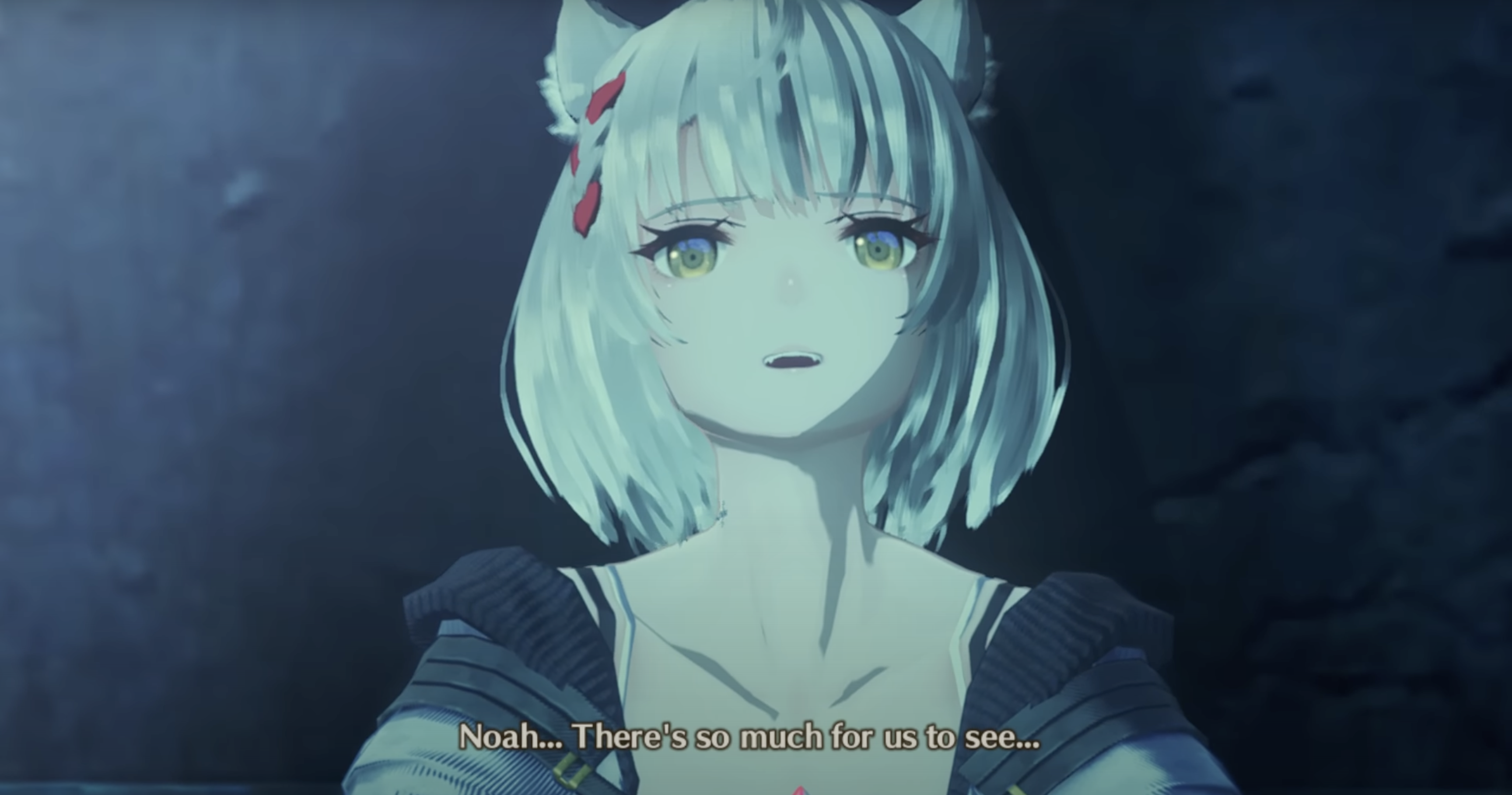
“What is happening now has significance – in these surroundings […] And the word ‘hope’ refers to a phenomenon of human life” (Philosophical Investigations: 583).
§2.266: The Sixth Chapter
Tractatus 6: The general form of truth-function is ![]() . This is the general form of proposition.
. This is the general form of proposition.
Xenoblade Chronicles 3, Chapter 6: Choices.
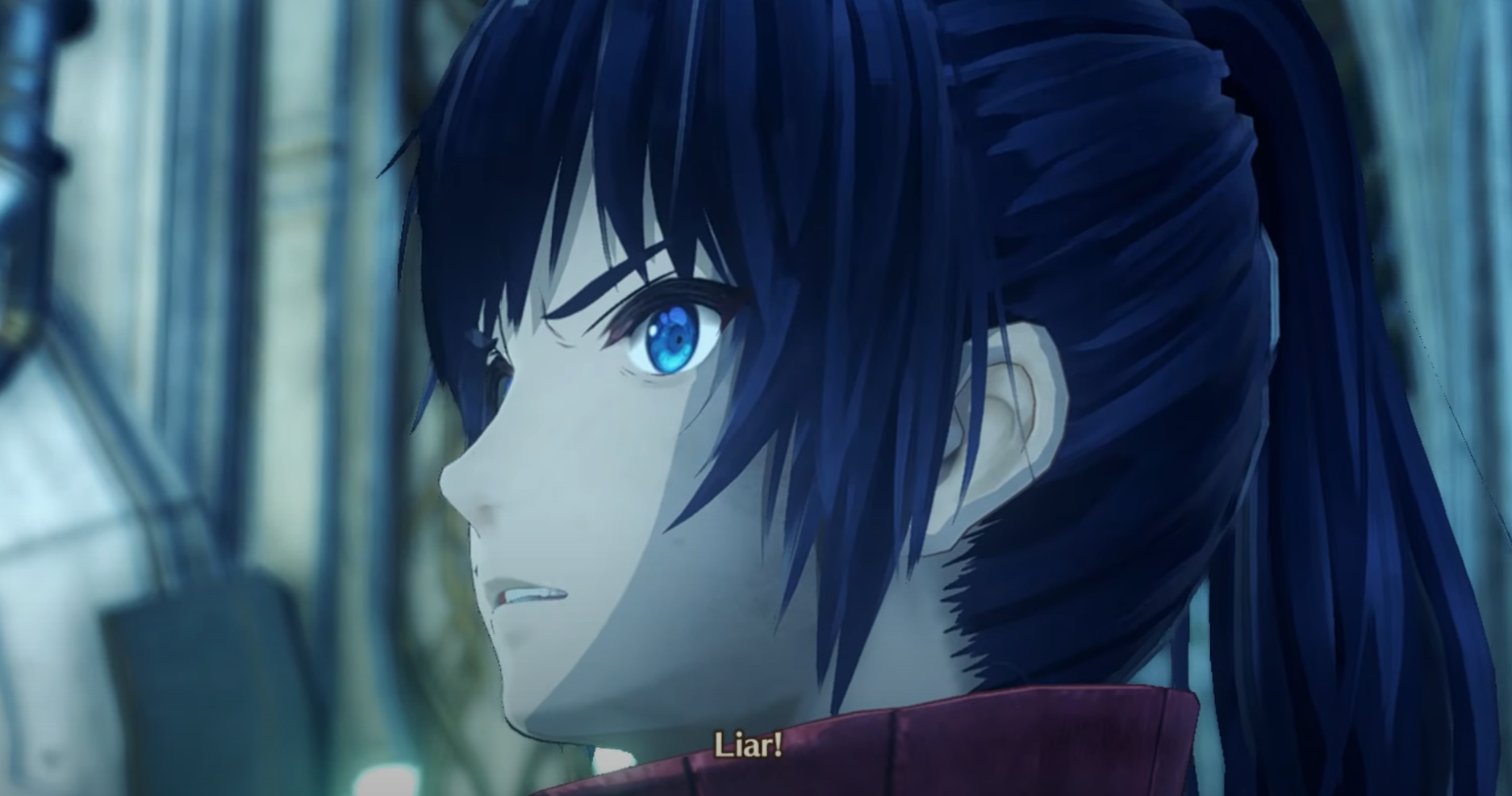
Noah directly accuses Joran of misinterpreting himself.
If we were to attempt to share our beliefs with someone who believed radically different things than we did, “[w]e should be trying to give him our picture of the world. This would happen through a kind of persuasion.”[589] (Not unlike, perhaps, Bursting through the rage that colors someone’s whole field of vision—a core enemy debuffing mechanic that’s only formally introduced through tutorial in this Chapter.[590]) In the case of Moebius, the gulf between their solipsism and Ouroboros’ transparent conversation is so great that Ouroboros cannot attempt this persuasion, these philosophical therapies, until they have completed the groundwork of conversing with themselves, the world, and the world as others—including Moebius—see it. Now, in Chapter 6, those therapies begin.
By seeing M’s memories of her past with N, Noah integrates his sense of despair from losing Mio with his interpretive, musical goals: off-seeing in order to understand “the meaning behind the smile”[591] of those who chose their deaths, like Crys, M, and Joran (S13). What was previously an inescapable law of the universe—the law of war, the law of 10 years until death, the law of inescapable despair—becomes a rule that one may choose to follow, or else set down—even if that means leaving others to carry on the game (S6). That’s the right perspective from which to see that the choice Z offered to N was a false one:[592] two pictures of infinite series (endless struggle against Z, or persistence within the Endless Now) are just pictures, and we decide at each moment whether to act in accordance with one of those, or with some other game entirely. N didn’t have that perspective; Noah makes a choice to walk a path in both a path and position not represented to N on the “Two Paths” of the Amphitheatre projection.[593]
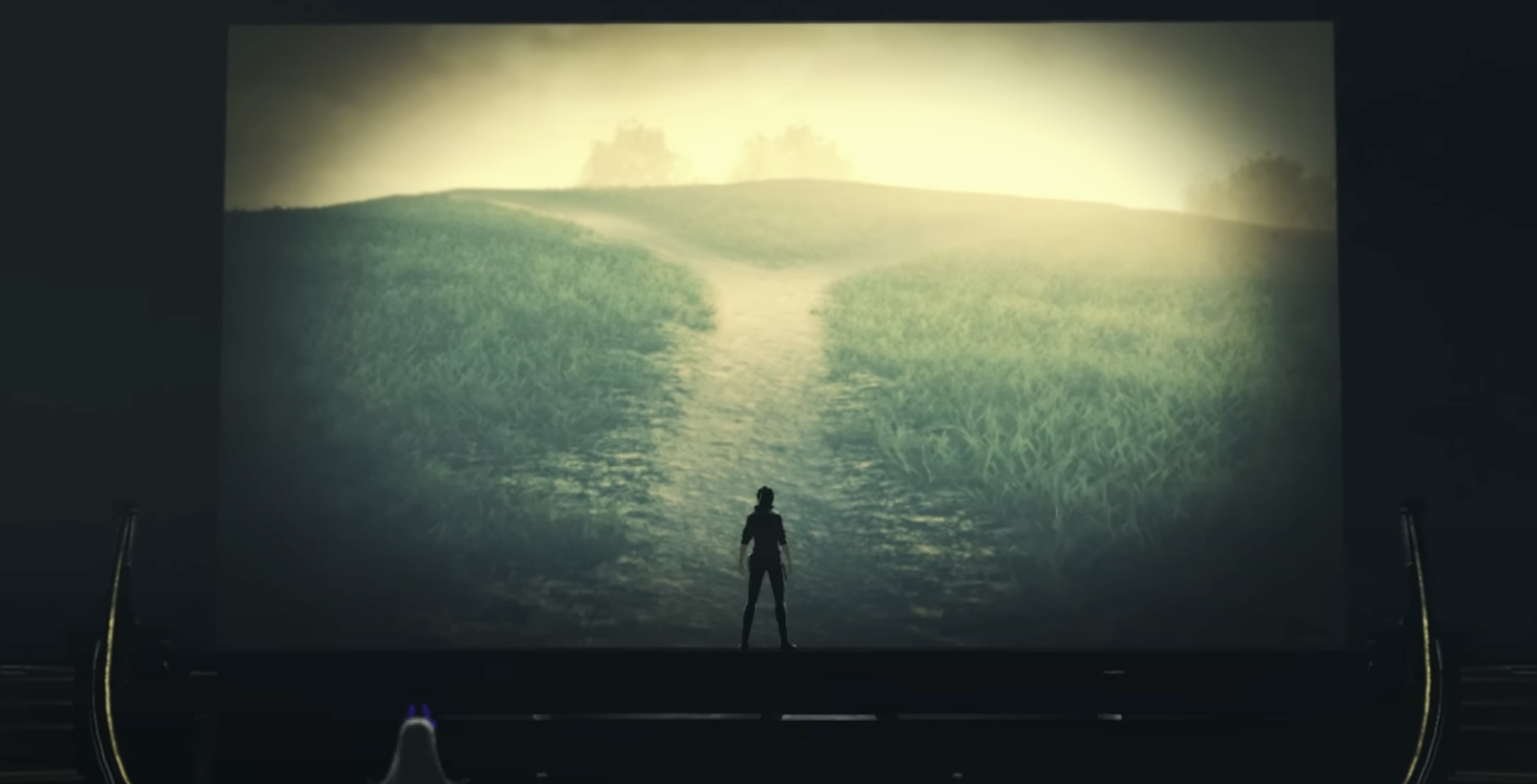
Z’s projection of 2 pictures of infinite series, which led Noah to become N.
The Sword of the End is the trinket that Noah and Mio pry out of themselves, out of the Interlink core housing the conversation and shared memories that made possible all their conversations, from their awakening as Ouroboros through to Noah’s exposure to N’s memories—a trinket that they use as a tool to project that conversational facility and perspective outward, a “weapon” in the sense of being able to correct and overcome the worldview of even Moebius. It’s not the right kind of thing for Z’s power to hold any dominion over;[594] it is the right kind of trinket to make possible the uses of language Ouroboros needs in order to save Joran.
Joran is not saved by any empirical fact that he had forgotten, nor by any force of will on his or Ouroboros’ part: he is saved through a kind of persuasion, a therapy by which Noah and the rest of Ouroboros get him to look and see clearly what he really did in the past. When Joran expounds his view of his essential worm-ness and his path to Moebius as someone with talent, wings, and abilities, Noah doesn’t offer him more overtures about real value, the diversity of choice, or how much his friends care about him: he calls him a “liar,” accuses him of having committed an error in interpreting himself.[595] He points Joran to the context they all shared: weakness by virtue of only having one role, one lens through which to see themselves. He points to that smile he always wanted to understand—Joran’s smile after sacrificing himself to save his friends—and tells Joran that that act, the smile as much as the sacrifice, showed he’d “made it” and “spread his true wings” in protecting his friends.[596]
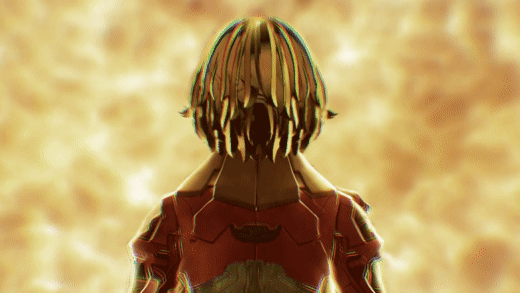
Prompted by conversation with Ouroboros, Joran considers whether his act of self-sacrifice showed a version of himself other than worm-ness.
Joran, like all Moebius, has been playing at playing a private language-game: looking back at his reel of memories and putting down a little ‘worm’ mark in his diary every time it strikes him. But our memories of a sensation aren’t sufficient to justify our naming of that sensation (S5): the moment he utters those words aloud to Ouroboros—who has had sufficient preparation to understand that sort of realm of memories, how to converse about it, how to take that conversation out into communities, and how to relate it to Moebius’ language-game—they lose their meaning. Joran can put down his despair in favor of choice.
Wittgenstein 1 calls that the general form of truth-function is a variable, an endless function of elementary propositions and their negations, and that this is the general form of proposition through which all significant expressions of language can be captured. Wittgenstein 2 looks Wittgenstein 1 dead in the eye, and responds: “Your mistake was already made when you sought a general form of proposition. Expressions have meaning in their particular circumstances, in the choices we make to participate in games—and your general form of proposition no more binds you to it than a picture of a series’ infinite rails binds you to the choice of taking each step in it.”
§2.267: The Seventh Chapter
Tractatus 7: Whereof one cannot speak, thereof one must be silent.
Xenoblade Chronicles 3, Chapter 7: Time Moves Again.
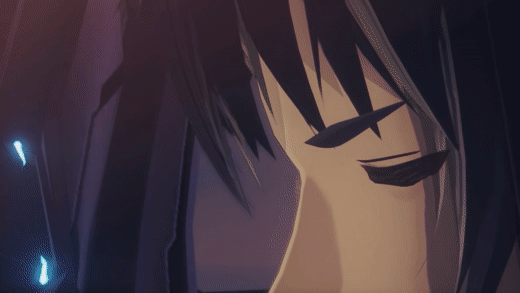
“The real discovery is the one that enables me to break off philosophizing when I want to.” (Philosophical Investigations: 133.)
The peace made possible in Chapter 7 is the difference between kicking down a ladder and putting down a tool.
After meeting Queen Nia and hearing her story (“Queen Nia’s Story,” not “Queen Nia’s Explanation of the World,” in Event Theater), Ouroboros has all of the context they need to step back from engaging with the world and its interpreters, and to instead fortify themselves. As relics from the world’s far-flung past became trinkets to fortify Leeanne with new ideas for her storytelling in the City,[597] so far-flung pieces of Origin become trinkets for the party to reinforce roles and abilities that bear a special relationship to them: the Boundary becomes the Bravery, able to pierce the vortex that obfuscates Moebius seat of influence upon the world;[598] original Blades become stronger, improving the parties’ original roles not by the default of Moebius’ war games assigning those roles, but rather through a new context for how roles can relate to a person’s character, after having adopted and drawn analogies with so many other roles (S15, S16).[599] Chapter 6 already showed us Ouroboros’ capacity for therapy of the other; fortification of the self is useful in preparing the way for therapy of the self.
N and Noah are the first participants in such a therapy. Noah has already gained the perspective he needed to make a choice different than N, and he already recognized how close he came to making the same choice—but he made this recognition in the context of having support from Mio, who was able to quickly take his hand and reassure him, “For my part, this is all I need.”[600] Now, fortified, Noah is able to directly address N and admit their similarities on his own, by the side of Mio and the rest of Ouroboros, but not depending on them for his assuredness of character. He’s able to discern the unwellness in N’s expression, and to notice the aspect-blindness N has cultivated within his solipsistic prison: unable to read Noah’s face, he sees only the aspect of smugness,[601] his own dogma of significant proposition taking his personal despair and telling him “This is how things are” in the world he sees within his visual field. He confronts N in much the same way that he did Joran, albeit driving even more directly at the heart of self-undermining despair that motivates Wittgenstein 1 and Moebius: when N proclaims that Ouroboros cannot defeat him while he stands “at the brink of the void,” as if that void were some metaphysical force from which he drew strength, Noah calmly and reflectively corrects him: what N hypostatizes as ‘void’ is just ‘sadness’, grief that he has elevated to a lens that colors his entire world.[602]
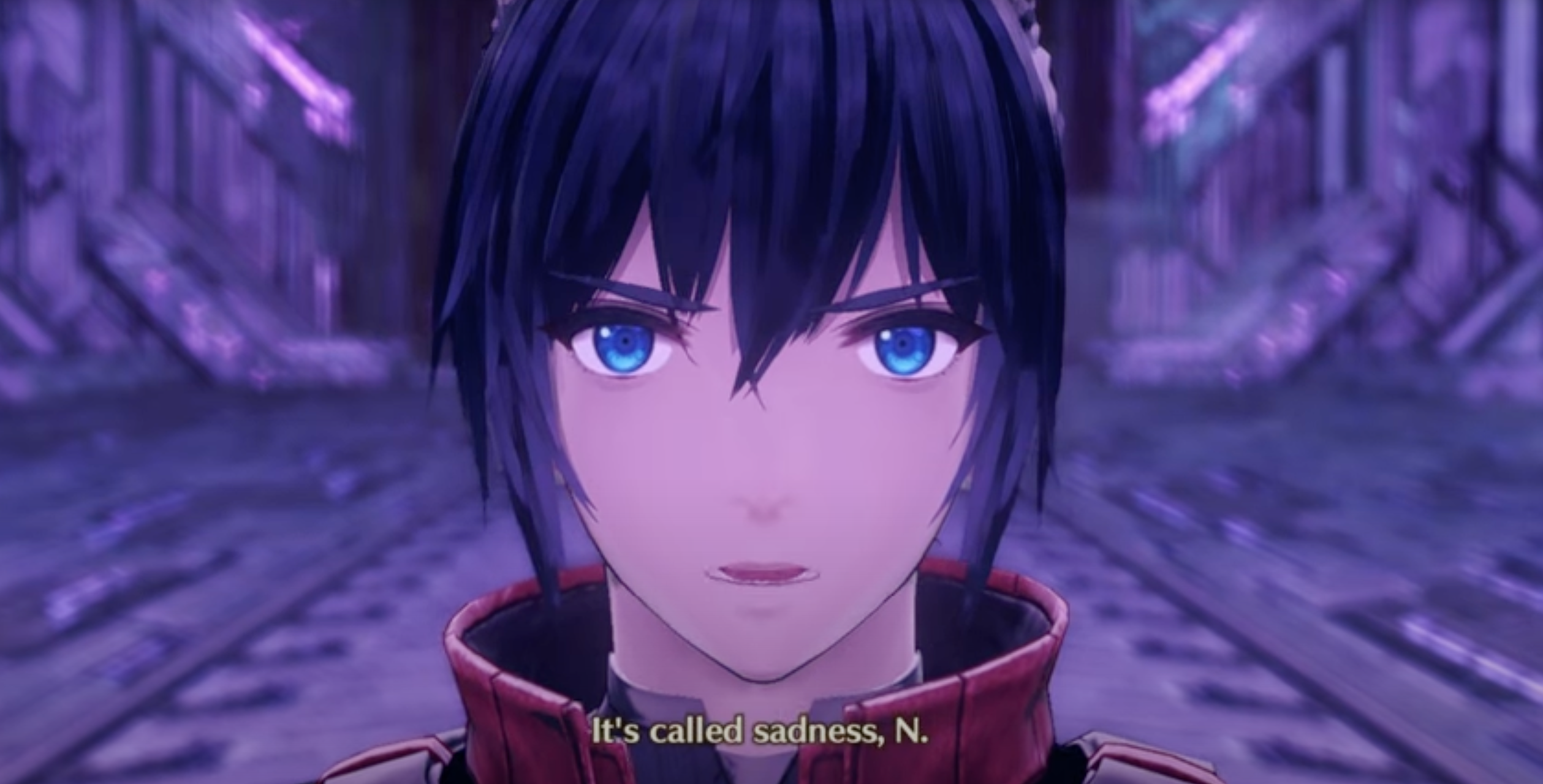
Noah brings N’s void out of the metaphysical and into the conversational.
In 1948, while the biographical Wittgenstein stayed in Rosro to work on finishing what would become the Philosophical Investigations, he found himself plagued by grief—perhaps over the death of Francis Skinner, whose love he felt he didn’t authentically reciprocate—and wrote to himself in an effort to process it:
Don’t let grief vex you. You should let it into your heart. Nor should you be afraid of madness. It comes to you perhaps as a friend and not as an enemy, and the only thing that is bad is your resistance. Let grief into your heart. Don’t lock the door on it. Standing outside the door, in the mind, it is frightening, but in the heart it is not.[603]
This is like the language-game Noah plays with N to show the wriggling fly “the way out of the fly-bottle”:[604] the tragic irony is that, by turning his grief into a concrete figure to better manage, he has become ruled by it in a way that would dissolve it, if only he could name it and use it in conversation, rather than as an impetus for pushing himself beyond the world, beyond the realm of his duet with M. As Noah says, N’s whole perspective, down to his prerogative as “creator” of the Cityfolk to slaughter them, is a form of self-punishment: despairing at his place in the world and therefore removing himself from life’s flow by holding dominion over it, keeping that which he loves most at a reductive distance.[605] Noah recognizes that N’s choice to seek peace for his inner life in a place outside of the world committed him to his dogma, so that he “just had to keep walking that path,” insisting that he was not walking but rather recognizing the reality of an infinite void. As N insists resolutely on the impossibility of hope in this kind of world, he might as well be saying, “‘But, surely you can see…!’ That’s precisely the characteristic explanation of someone who is compelled by a rule.”[606]
The duet between Noah and Mio is what ultimately saves N: as Noah is able to acknowledge that only “chance encounters,” or connections and conversations out there within the world, made the difference between him choosing the Endless Now or walking beyond it, so Mio is able to say, as herself and M alike, that’s it’s possible to consistently hope for a form of love that evolves with time, and also understand the expression of a love that wants to preserve the present moment—even if the latter undermines itself, when taken to the Moebius conclusion.[607] Noah ultimately sets N aright by convincing him to “move forwards again” with them into the future regardless of whatever picture of loss one’s feelings might project onto that future: they “fight [their] way out of these ten years. That’s all.”[608] A simple answer to the seemingly impossible problem of the Endless Now—yet, as we’ve already seen, that clarity of action to take one step at a time is all it really takes.
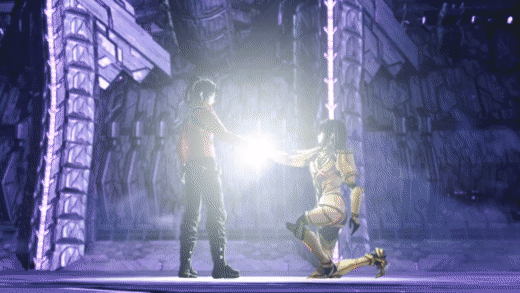
N chooses to reintegrate with Noah and walk a different path than either of the pictures presented by Z.
For all the conversation in Xenoblade Chronicles 3, there’s something uncanny about the “dialogue” that takes place between Ouroboros and Z when they finally meet in the Amphitheatre, especially in the context of facing a final boss at the end of a JRPG. Ouroboros makes very few attempts to reason with Z or understand his point of view: rather, the focus is on Z expounding his point of view while Ouroboros asserts their convictions to each other and to him—Taion “refus[ing] to be controlled by [Z],” Lanz giving Z “a real good thanking” for inadvertently spurring them to learn about the world as Ouroboros and form their own views, Noah affirming that they themselves will build “[a] world with the freedom to choose,” Mio acknowledging this as the moment for which Miyabi’s words of “fighting in order to live” were meant, and so forth.[609] We know the reason for this: as Melia told Ouroboros, Z is “not a person, but a concept,”[610] and that concept is a worldview so total that it cannot be critiqued—to do so would go beyond the scope of assertoric propositions about Moebius’ world of Aionios, and “[w]hereof one cannot speak, thereof one must be silent.[611] From Ouroboros’ perspective, when faced with someone who is absolutely incapable of regarding their expressions as reasons, all that’s left is “using our language-game as a base to combat theirs,”[612] through a kind of “persuasion” that has less to do with therapy and more to do with “what happens when missionaries convert natives” (though perhaps the more appropriate analogy, in this case, is of natives converting missionaries).[613]
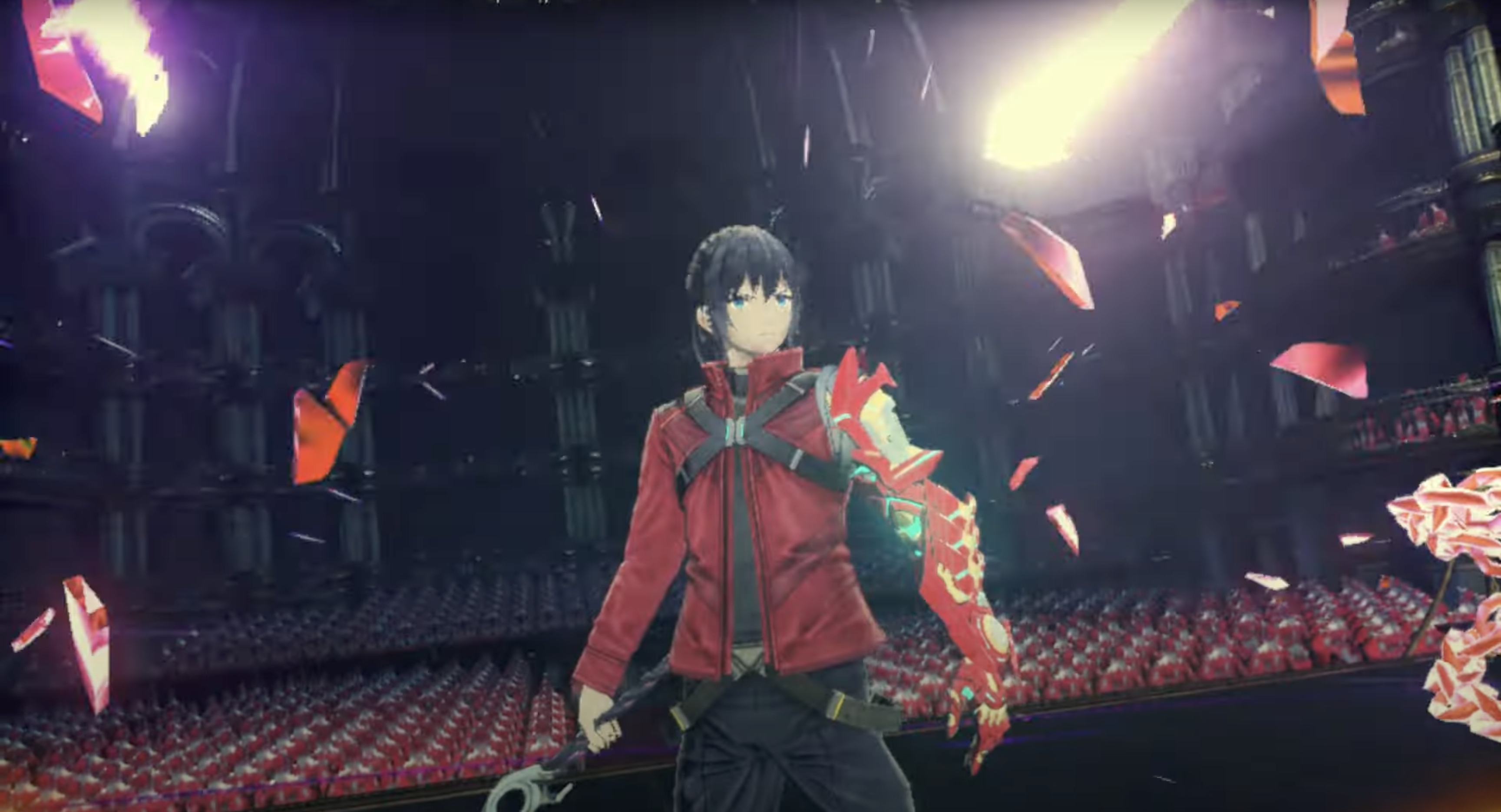
Noah freeing himself from Z’s fetters.
This combat begins before the boss fight and continues throughout it. When Sena shouts at Z that he “can’t just invent some rule” according to which people are bound to take lives, she’s not decrying him for doing what we all do in language-games, but for doing what Z himself points to, without understanding, in his response to her: inventing a rule and then declaring that “[t]he world itself has set that rule,” erasing the reality of the rule’s invention from how the rule is perceived.[614] Wittgenstein 1 has no vantage point from which to understand this distinction, though it’s obvious to Wittgenstein 2 at this point in the journey.
Z thinks that he is offering people the choice to act differently at any given “time” within his bewildering clock’s fragment of infinity; the significance is lost on him when Noah declares Ouroboros’ united defense of the “common right” of people to “choose our own actions, moment to moment,” though it directly contradicts the hypostatization of infinity on which Z’s existence is predicated.[615] This combat culminates in Ouroboros doing exactly what N could not: when presented on the Amphitheatre projector with images of moments from their personal history conducive to despair—4 of which are some of the same moments that haunted the party at the start of the game, before the Interlink showed them the possibility of conversation about that content—they reject outright the picture presented, instead using its content, as they learned long ago, to play a language-game reasserting their own value and conviction. This is what it takes, and what it means, to restore Interlink functionality in the presence of Z.[616]
“Tractatus Logico-Philosophicus (4.5): “The general form of propositions is: This is how things are.” — That is the kind of proposition one repeats to oneself countless times. One thinks that one is tracing nature over and over again, and one is merely tracing round the frame through which we look at it.”[617] When the frame refuses to relent in obtruding upon our lives, the only remaining option is to shatter it, as Noah literally does when he exposes the Amphitheatre as a “sham.”[618]
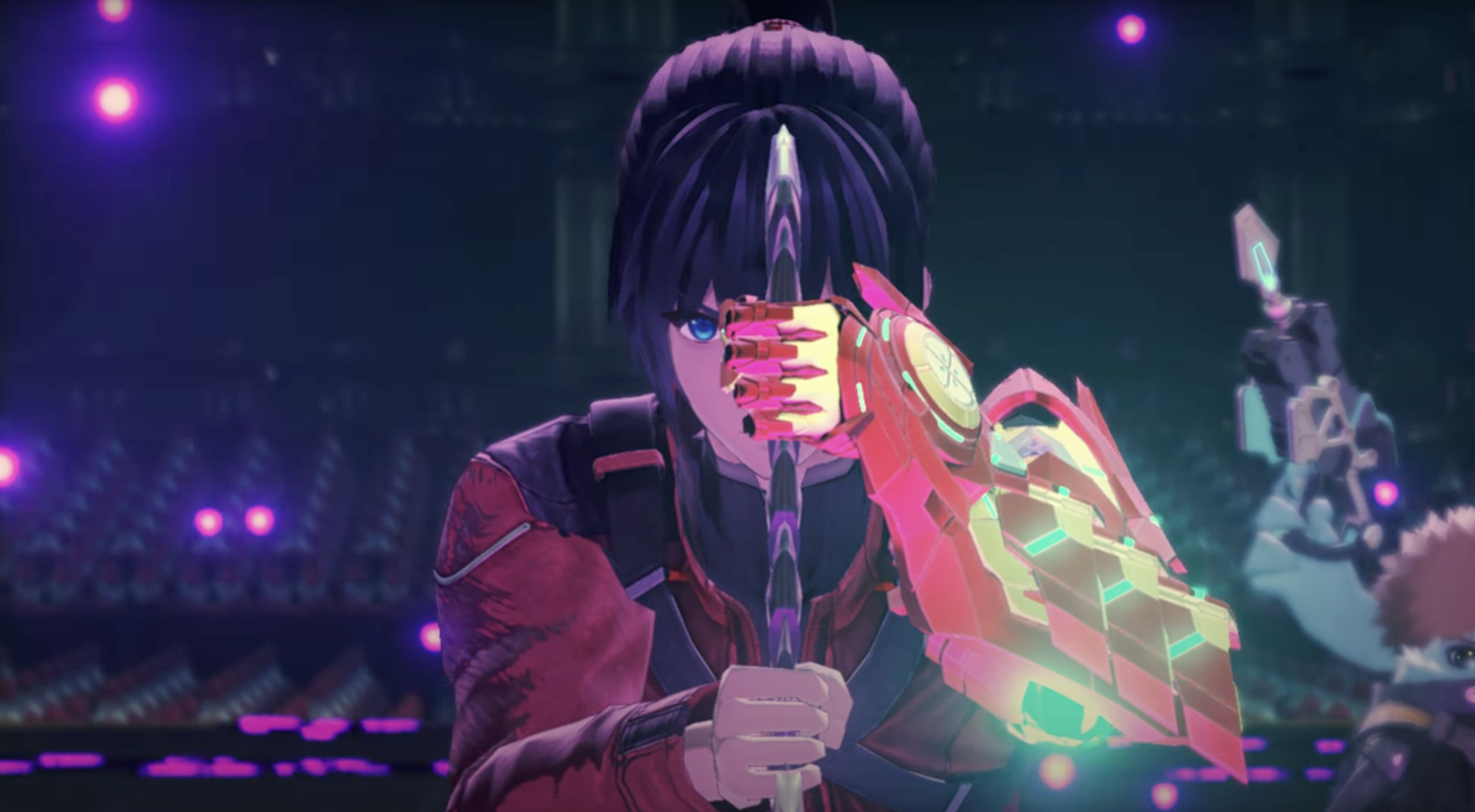
Noah shattering the Amphitheatre: stage, projector, and all.
Even before the metamorphosed, “pure,” desire-based form of Z despairingly declares that “the self is all that exists,”[619] the extended family of Ouroboros has already taken all the steps to show that this is not the case: Colonies, City, rank-and-file, Queens, Nopon, and Heroes all descend on Origin, supporting all forms of life and directly supporting Ouroboros through their separation by X and Y in ways that are only possible because of interactions with Ouroboros, yet which do not reduce to the activities or agency of Ouroboros, the player, or anything else beyond themselves. Once Z’s trapped Ouroboros within his visual field and they finally see him for what he is—“being scared of ourselves […] and los[ing] track”; “cut[ting] off our own way to the future”[620]—the solution is the same: to believe in whatever comes next, one step at a time, and “[i]n the path we’ve walked this far,”[621] the activity in which everyone on Aionios has uniquely shared. The conclusion of this activity, this therapy, is the quieting of Z by N and M recognizing the way out of solipsism that Ouroboros taught them: to seek the safety of a home beyond the world to house your passions and comfort your fears is an “egotistical dream,” but to voice that dream aloud to others makes it possible to introduce and enact its motivating feelings in positive, collaborative forms of life—in their case, the legacy of a child, ”the chance to weave new life” in a way that honored their feelings as the duet they rightly are.[622]
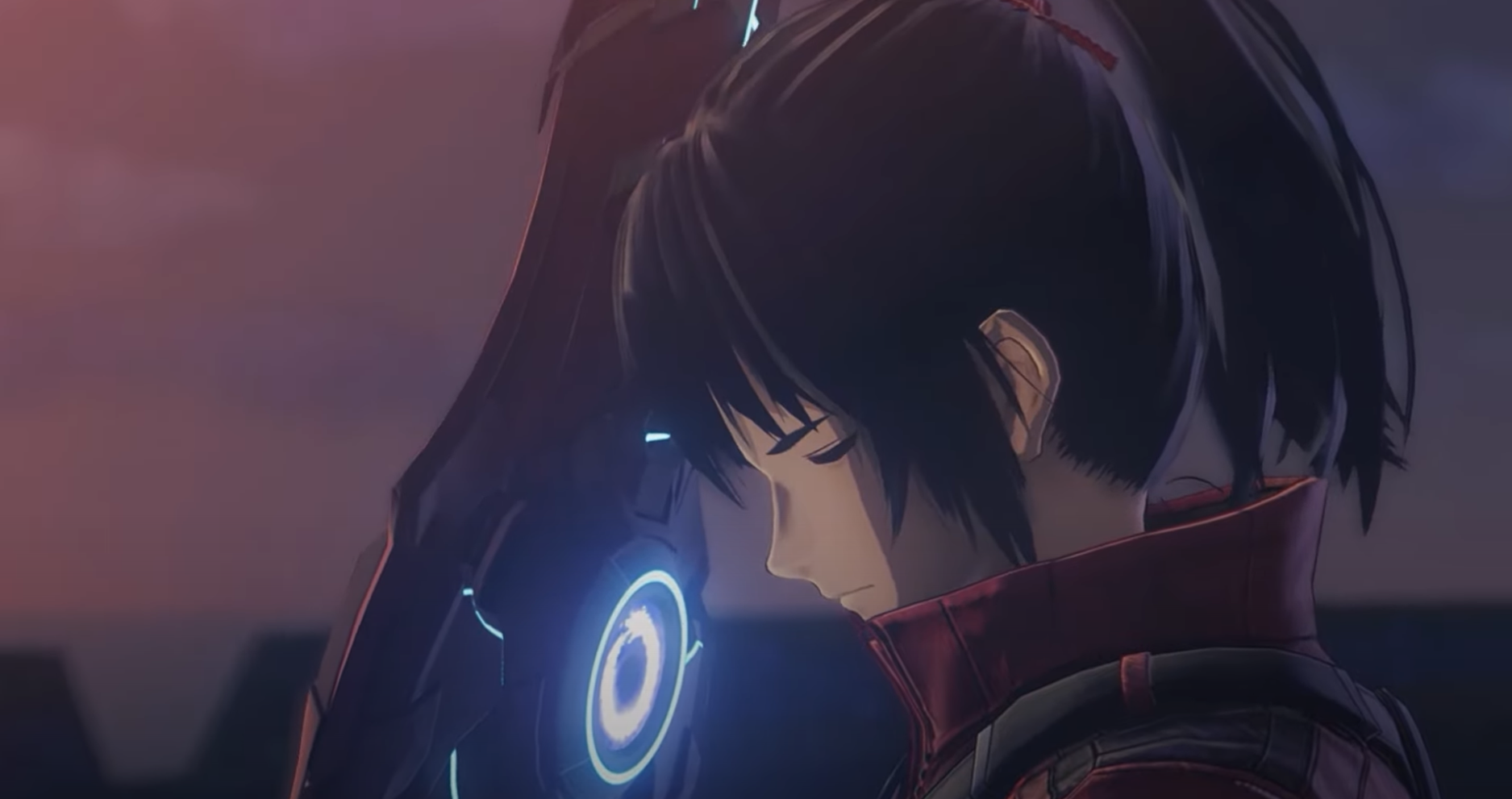
At the last, Noah prepares to put down his sword.
Wittgenstein 2’s philosophy is a toolkit for diffusing philosophical problems by pointing us to the here-and-now of our words and lives. It is not the “[s]trong…yet somehow fragile”[623] quietism of Wittgenstein 1, peering in upon the world after placing itself beyond: “if the place I want to reach could only be climbed up to by a ladder,” our fully realized heroes might say, “I would give up trying to get there. For the place which I really have to go is one that I must actually be at already.”[624] For all the countless criss-crossing journeys across Aionios, and all the diversity of life experienced and made possible in the process, this is what allows Noah to “break off” his journey and let go of his tool when he wants to: throwing his sword to the sea, “no longer tormented by questions which bring [philosophy] itself into question.”[625]
What if he needs the sword later? Don’t worry. It’s a trinket. The use will come back to him. Let him be, for now: the journey of Wittgenstein 2 can only end with him returning to living in the stream of life without interrogating that stream. He will walk on step by step, even apart from his friends, attuned to those interpretations and forms of life in which he wants to participate. Don’t ask from whom or what the melody is emanating when Noah hears it and changes his path following the worlds’ separation: his is the choice to hear it as something that resonates with him, and to choose to walk toward it, step by step. We can no more know its origin than Z could be sure of the worlds obliterating each other following the restarting of Origin.[626] You left Noah when your screen went black and he walked on;[627] this is no longer a form of life in which you participate.
Leave him be.
Wittgenstein 1 calls, in a whisper as hollow as the fiction of the Endless Now,[628] “Whereof one cannot speak, thereof one must be silent”—and then falls silent, letting the myriad enforces of the Endless Now speak on its behalf. Noah squares himself as Time Moves Again right before his eyes; he faces the horizon, and answers:
This…is the truth of our world. Memories melt in the morning light, and then, a new day begins. Roads stretch out before us. So many paths. Which do you choose? That’s up to you. Sometimes, you might run astray. You’ll stop, maybe cry in frustration. But you know, that’s all right. For the roads… They go on without end. So look up, face forward, toward your chosen horizon… And just…walk on.[629]
§2.3: Enlightened Empowerment
Then [Wittgenstein and I] rode to the top of the hill near the library and looked over the town. The moon was in the sky. “If I had planned it, I should never have made the sun at all. See! How beautiful! The sun is too bright and too hot.” Later, he said, “And if there were only the moon there would be no reading and writing.”
O. K. Bouwsma, August 5th, 1949[630]
Xenoblade Chronicles 3 is remarkable to me because it facilitates a kind of enlightened empowerment in both its cast of characters and the player: not the empowerment of a triumph over a god, nor that of evolving into something different than yourself, but the empowerment of recognizing a kind of “villain” in yourself and reintegrating that into your character through a therapeutic philosophy. Wittgenstein 2’s focus is on seeing ourselves as we are, including the impulse to seek comfort through solipsism and pictures we control. The union of Moebius and Ouroboros, as we see in Noah and Mio’s Irises, shows that very impulse to a single-sided infinity, bound within the context of a 2-headed, 2-sided Ouroboros circle, the strength that comes from making those pictures public and putting them back into our stream of life.
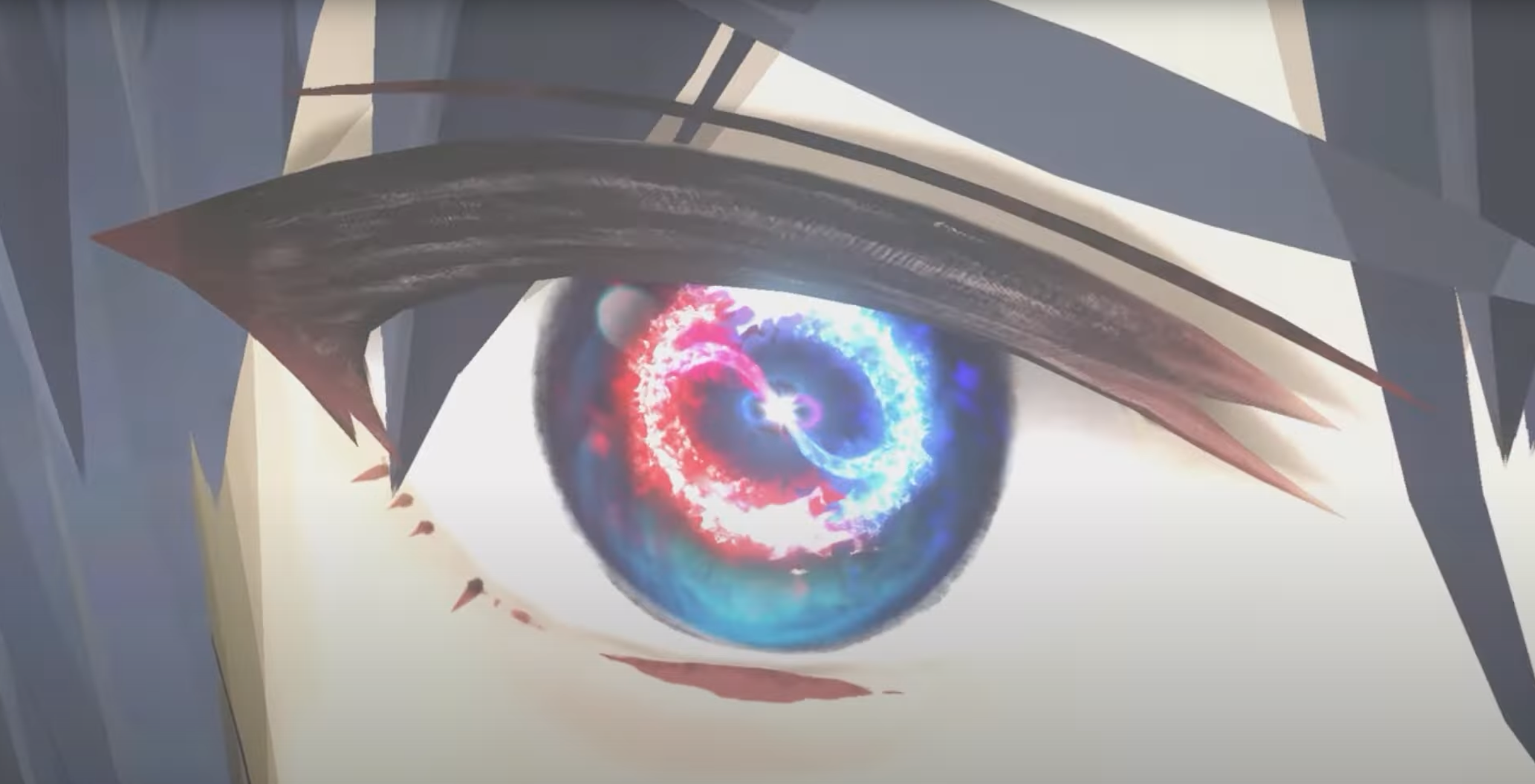
Noah’s Iris after reintegrating N into his being.
As a whole, I think the game provides the player with the opportunity to give herself this Iris as she plays this and future games. Art forms are all interactive in one way or another by their very nature, but the interactivity of video games gives players the opportunity to actively decide, reflect upon, and discuss many decisions that relate to their engagement with the artwork—say, every time they input something on their controllers—in a way that takes more effort with some other media—such as, say, visual art at a museum, where aids beyond the artwork (like tremendously valuable docents) help to facilitate active reflection and discussion.
Among video games, Xenoblade Chronicles 3 is especially well-suited to present this mode of engagement through a Wittgenstein-inspired lens: of his writing, Wittgenstein wrote, “Really I want to slow down the speed of reading with continual punctuation marks. For I should like to be read slowly.”[631] I can think of few better methods to slow down the speed of gaming than a game with a vast Main Story, a vast world with myriad other ways to engage it (Standard Quests, Hero Quests, conversations around campfires, hunting monsters, improving gear, appreciating the scenery…), and sufficient dialogue and relationships to afford you time and interest invested in virtually every character—not to mention a game that provides all of this within the context of two previous, vast games with their own worlds, histories, themes, and characters, leaving the knowledgable player processing the game through trifocals (Bionis/Mechonis, Alrest, Aionios) for much of the game.
Especially with the constant flood of new games and new announcements in the modern gaming world, we might try to speed through at the beginning and bristle at your discovery that it’s simply impossible—“You’ll stop. Maybe cry in frustration.”[632] But keep going, change the role you assume as a player, and you can treat it—like Wittgenstein 2, like Wittgenstein’s writing—as a different style of game, a different form of life containing a wide array of different language-games in which to participate.
And then, perhaps, you’ll play another language-game: an interpretive one. Perhaps after playing Xenoblade Chronicles 3, you’ll want to make sense of your multitude of experiences in it—of your place in the game, sub specie aeternitatis. Maybe you’ll gush to a friend who played it, or who needs to play it. Maybe you’ll make a YouTube video sharing the game as you interpreted your experience of it. Maybe you’ll write an essay about a different game you wished you’d played: exactly like Xenoblade Chronicles 3, but with one different event in the plot, or one character missing. Maybe you’ll be inspired to pick up another game based on a family resemblance, or aspect it shares, with Xenoblade Chronicles 3, and play it consciously acting in that same form of life that took you through Xenoblade Chronicles 3—or simply to stay in your interpretation of the world just a little longer, or develop a new one, by playing a New Game Plus again and again.
These interpretations will come from your own feelings, your experiences, with the games you played within Xenoblade Chronicles 3. And you may be tempted to hit the ‘capture’ button on your Switch controller, transmuting the new language-game you want to play into a claim about “The Truth” of Xenoblade Chronicles 3: you might tell another player, “You’re misunderstanding the game if you don’t play the first 2 and relate it to them,” or publish a declaration that this video “EXPLAINS the TRUE ENDING of XENOBLADE CHRONICLES 3,” or you might say “Here is how the story should have gone”—or, like the author of this work’s introduction, you might claim that “Only through the lens of a philosopher at war with himself can we understand a game at war with itself.” That’s all right: it’s relatable, and alluring, to place yourself beyond something yet keep your face pressed up against the screen, coloring that thing for everyone with your choices, your experiences, your sentiments.
But perhaps, if we remember Noah’s final Iris, we can look to the game, look to the life we shared with it, and offer a conversation: “What I am doing is playing another language-game. I am discussing my experiences of this game with you and inviting you to play with me, to come to see this new kind of thing, this interpretation, that has a family resemblance with Xenoblade Chronicles 3 and also with myself. I hope that, as we discuss it, that very discussion will show me something about the participants as much as the game, and I hope that it can do that for you, too.” And then, once we’ve laid bare the context in which our language-game relates to ourselves and Xenoblade Chronicles 3, we can look and see exactly what is there: with any luck, a new form of life within which to engage Xenoblade Chronicles 3 and any number of other subjects, and the peace to love the meaning of our games without binding ourselves to a picture.
To put it down when we want to, and reenter the form of life that is gaming.
§3: References
§3.1: Non-Game-Screenshot Images
With the exceptions of “Kaninchen und Ente” and Aaron Suduiko’s personal photographs, non-game-screenshot images taken from Wikimedia Commons and were initially sourced from Ludwig Wittgenstein: The Duty of Genius. For all of those images, per Wikimedia Commons, “This non-U.S. work was published in 1928 or later, but is in the public domain in the United States because it was simultaneously published (within 30 days) in the U.S. and in its source country and is in the public domain in the U.S. as a U.S. work (no copyright registered, or not renewed).” For “Kaninchen und Ente,”—also sourced from Wikimedia Commons—per Wikimedia Commons: “This work is in the public domain in the United States because it was published (or registered with the U.S. Copyright Office) before January 1, 1928.”
Malcolm, Norman. Photograph of Wittgenstein in Trinity College’s Fellows’ Garden, 1939. Source: Wikimedia Commons.
Richards, Ben. Photograph of Wittgenstein in Swansea, 1947. Source: Wikimedia Commons.
Sjögren, Clara. Portrait of Wittgenstein on being awarded a Trinity College scholarship, 1929. Source: Wikimedia Commons.
Suduiko, Aaron. Photograph of The Legend of Zelda: Collector’s Edition game case and instruction booklet, 2023.
——. Photograph of Nintendo Switch Pro Controller, 2023.
Unknown. Drawing, “Kaninchen und Ente” (“Rabbit and Duck”). Captioned: “Welche Thiere gleichen einander am meisten?” (“Which animals are most like each other?”) In Fliegende Blätter, October 23, 1892. Source: Wikimedia Commons.
Vienna Kriegsarchiv. Wittgenstein’s military identification card from World War I. Source: Wikimedia Commons.
§3.2: Video Games
Game Freak. Pokémon Violet. Nintendo and The Pokémon Company, 2022.
Monolith Soft. Xenoblade Chronicles: Definitive Edition. Nintendo, 2020.
——. Xenoblade Chronicles: Future Connected. In Xenoblade Chronicles: Definitive Edition.
——. Xenoblade Chronicles 2. Nintendo, 2017.
——. Xenoblade Chronicles 2: Torna — The Golden Country. Nintendo, 2018.
——. Xenoblade Chronicles 3. Nintendo, 2022.
——. Xenoblade Chronicles 3 Expansion Pass: Volume 2. Nintendo, 2022.
Nintendo. The Legend of Zelda: Collector’s Edition. Nintendo, 2003.
Nintendo EAD. The Legend of Zelda: The Wind Waker. Nintendo, 2003.
——. The Legend of Zelda: A Link Between Worlds. Nintendo, 2013.
§3.3: Written Works
Barrett, Cyril, ed. Lectures and Conversations on Aesthetics, Psychology and Religious Belief. University of California, 1967.
Biletzki, Anat and Anat Matar, “Ludwig Wittgenstein,” The Stanford Encyclopedia of Philosophy (Winter 2021 Edition). Ed. Zalta, Edward N.
Bouwsma, O. K. Wittgenstein: 1949-1951. Ed. Craft, J. L., and Hustwit, Ronald E. Hackett, 1986.
Copi, I. M. and Beard, R. W., ed. Essays on Wittgenstein’s Tractatus. Routledge, 1966.
Diamond, Cora, ed. Wittgenstein’s Lectures on the Foundations of Mathematics: Cambridge, 1939. Harvester, 1976.
Fann, K. T., ed. Ludwig Wittgenstein: The Man and His Philosophy. Harvester, 1967.
Gasking, D. A. T. and Jackson, A. C. “Wittgenstein as a Teacher.” In Ludwig Wittgenstein: The Man and His Philosophy.
Grant, R. T. and Reever, E. B. Observations on the General Effects of Injury in Man. HMSO, 1951.
Hacker, P. M. S. and Schulte, Joachim. “The Text of the Philosophische Untersuchungen.” In Philosophical Investigations (Wittgenstein), pp. xviii-xxiii.
Holy Bible, New International Version. Biblica, 2023. Accessed from Bible Gateway.
HowLongToBeat. “Search: ‘Xenoblade’.” Ziff Davis, LLC, 2022.
Jastrow, Joseph. Fact and Fable in Psychology. Houghton Mifflin, 1900.
Malcolm, Norman. Ludwig Wittgenstein: A Memoir. Kindle Edition. Oxford, 2001.
McGuinness, B. F., ed. Letters from Ludwig Wittgenstein with a Memoir by Paul Engelmann. Blackwell, 1967.
Monk, Ray. Ludwig Wittgenstein: The Duty of Genius. Penguin, 1991.
Moore, G. E. “A Defence of Common Sense.” In Philosophical Papers.
——. Philosophical Papers. George Allen & Unwin, 1959.
——. “Proof of an External World.” In Philosophical Papers.
Phillips, D. Z., ed. Philosophical Investigations. Blackwell, 1978-2023.
Pinsent, David Hume. A Portrait of Wittgenstein as a Young Man: From the Diary of David Hume Pinsent 1912-14. Ed. Wright, G. H. von. Blackwell, 1990.
Ramsey, F. P. “Critical Notice of L. Wittgenstein’s Tractatus Logico-Philosophicus.” Mind, XXXII, no. 128 (October 1923), pp. 465-478.
Rhees, Rush, ed. Recollections of Wittgenstein. Oxford, 1984.
——. “Postscript.” In Recollections of Wittgenstein.
——. “The Language of Sense Data and Private Experience – I (Notes taken by Rush Rhees of Wittgenstein’s Lectures, 1936).” In Philosophical Investigations (Phillips), VII, no. 1 (1984), pp. 1-45; continued in Philosophical Investigations (Phillips), VII, no. 2 (1984), pp. 101-140.
Russell, Bertrand. “Introduction.” In Tractatus Logico-Philosophicus.
Suduiko, Aaron. “Critical Review: Okami’s Lessons on Religion, Video Games, and Storytelling.” With a Terrible Fate, 2018.
——. “Critical Review: Xenoblade and Leibniz.” With a Terrible Fate, 2015.
——. “Game as Mind: A Psychoanalytic Explanation of Returnal.” With a Terrible Fate, 2021.
——. “The Real Architect of Xenoblade Chronicles 2 is Plato.” With a Terrible Fate, 2018.
——. “A Three-Stage Method for Analyzing Video-Game Stories.” With a Terrible Fate, 2017.
——. “Video Games as a New Mode of Storytelling.” With a Terrible Fate, 2017.
Tagore, Rabindranath. The King of the Dark Chamber. Trans. Sen, Kshitish Chandra. Macmillan, 1914.
Tolstoy, Leo. The Gospel in Brief: The Life of Jesus. Trans. Condren, Dustin. HarperCollins, 2011.
Verlag, Braun, & Schneider, 1845-1944. Fliegende Blätter.
Whitehead, Alfred North and Russell, Bertrand. Principia Mathematica, Volumes I-III, Second Edition. Cambridge, 1968.
Wikipedia. “Free Variables and Bound Variables.” 2022.
Wittgenstein, Ludwig. Culture and Value, Revised Edition. Ed. Wright, G. H. von. Trans. Winch, Peter. Blackwell, 2006.
——. Lecture on Ethics: Ludwig Wittgenstein, First Edition. Zamuner, Edoardo, Di Lascio, Ermelina Valentina, and Levy, D.K., ed. Wiley-Blackwell, 2014.
——. Notebooks 1914-16. Ed. Anscombe, G. E. M., and Wright, G. H. von. Blackwell, 1961.
——. On Certainty. Ed. Anscombe, G. E. M., and Wright, G. H. von. Trans. Paul, Dennis and Anscombe, G. E. M. Harper, 1972.
——. Philosophical Investigations, Revised Fourth Edition. Ed. Hacker, P. M. S. and Schulte, Joachim. Trans. Anscombe, G. E. M., Hacker, P. M. S., and Schulte, Joachim. Wiley-Blackwell, 2009.
——. “Some Remarks on Logical Form.” Proceedings of the Aristotelian Society, IX (1929), pp. 162-171. Reprinted in Essays on Wittgenstein’s Tractatus.
——. Tractatus Logico-Philosophicus. Trans. Ogden, C. K. Chiron, 2016.
Wright, G. H. von, “A Biographical Sketch.” In Ludwig Wittgenstein: A Memoir.
Zamuner, Eduardo, Di Lascio, Ermelina Valentina, and Levy, D.K., ed. Lecture on Ethics: Ludwig Wittgenstein, First Edition.
- On Certainty: 471. ↑
- This work is to Bernhard Nickel, who taught me the language of philosophy and supported my philosophy of video-game storytelling before anyone else; and, for Warren Goldfarb, without whom I would not have studied philosophy. Thanks to Daniel Muñoz and James Hillenbrand for review of an earlier draft of my treatments of Wittgenstein’s work and life. Thanks to my friends, family, and the With a Terrible Fate team throughout for every manner of support. And thanks to Eevee Suduiko—whom, if she could talk, I would certainly be able to understand. ↑
- See my “Critical Review: Xenoblade and Leibniz” and “The Real Architect of Xenoblade Chronicles 2 is Plato” on With a Terrible Fate. ↑
- The only other philosophical work he published publicly was a brief set of remarks in preparation for speaking at a conference; when the time came for him to speak, he dismissed those remarks and decided to discuss another topic entirely. See Section “The Confederates of Moebius: Recruits from Aionios” in Part 1, as well as Note 117 to that section. Note that Wittgenstein’s Blue and Brown Books circulated privately within groups of British philosophers during his lifetime, and according to Norman Malcolm, “he had always regarded his lectures as a form of publication” (Ludwig Wittgenstein: A Memoir, Kindle Locations 612-614). ↑
- Ludwig Wittgenstein: The Duty of Genius, p. xviii. ↑
- On Wittgenstein’s concerns over being personally understood, see, for instance, his insistence in 1936-1937 on a formal confession, to those close to him, of what he viewed as moments of indecency and dishonesty from across his life (discussed in Ludwig Wittgenstein: The Duty of Genius, pp. 367-372). On doubt over his work being understood and properly expressed, see, for instance, MS 154 1v: 1931, MS 134 76: 28.3.1947, MS 134 143: 13.-14.4.1947, and MS 137 104a: 21.11.1948, all reprinted in Culture and Value. See also Wittgenstein’s final introduction to Philosophical Investigations, in which he discusses his work on the book being partly motivated by seeing his ideas “in circulation, frequently misunderstood and more or less watered down or mangled” (p. 4). ↑
- See especially Section 2.4 on “interpretive problems” of the Tractatus Logico-Philosophicus and Section 3.8 on “interpretive problems” of the Philosophical Investigations. ↑
- This is, at least, my current sense, which is based on having played through Xenoblade Chronicles: Definitive Edition, Xenoblade Chronicles 2, and Xenoblade Chronicles 3 for all quest and story content in the last year. My own playthrough of Xenoblade Chronicles took about 115 hours, Xenoblade Chronicles 2 about 182 hours, and Xenoblade Chronicles 3 about 237 hours. (While I also played Xenoblade Chronicles: Future Connected and Xenoblade Chronicles 2: Torna — The Golden Country, I don’t include these in my comparison because the third game has also promised a story-focused DLC which we don’t yet have). This experience doesn’t seem to be standard, at least by the standards of HowLongToBeat, which, at the time of my writing, put the first game at an average of 134 hours for what they call a “completionist” playthrough, 254 hours for the second game, and 166 hours for the third game (you can see their current data here). Without having explored the discrepancy further, my guess would be that it’s mostly explained by the unavoidable randomness in how long it takes a player of Xenoblade Chronicles 2 to acquire unique Blades, each of whom has an associated storyline. I confess that I did give up on trying to acquire them all in my most recent playthrough, in part from the exhaustion of trying to acquire them and in part from familiarity with the rest of them from my previous playthroughs. ↑
- This is a JRPG-specific instance of my broader approach to the derivation of an interpretation of a video-game story from one’s experiences with that video-game story, which I call object holism and outline in my “A Three-Stage Method for Analyzing Video-Game Stories” on With a Terrible Fate. ↑
- MS 112 225: 22.11.1931. In Culture and Value. ↑
- Melia explains the nature of Z to the party within Origin after they free her in Chapter 7, “Meeting Queen Melia” in Event Theater. ↑
- It’s true that Zanza is supported by his trinity (Dickson, Lorithia, and Alvis) and Malos is supported by the Torna faction (Jin, Mikhail, Akhos, Patroka, and (briefly) Nia), but these organizations are less monolithic, in the sense of a leader exerting absolute authority over the whole, than Z and Moebius. In Xenoblade Chronicles, Alvis is shown to have different existential concerns, in his capacity as “the administrative computer of a phase transition facility” (Xenoblade Chronicles: Definitive Edition, Chapter 17, “A World Without Gods” in Event Theatre), than Zanza has, and I find it at least doubtful that Dickson’s allegiance lies with Zanza rather than with Shulk following the party’s final confrontation with him (Xenoblade Chronicles: Definitive Edition, Chapter 17, “The Teacher is Surpassed” in Event Theatre). Meanwhile, one of the core conflicts that drive Torna’s role in the plot of Xenoblade Chronicles 2 is the fact that the other members of Torna are seeking a kind of intimate connection and sense of community that they all understand from their own histories (Jin with Lora, Akhos with Patroka, etc.)—the exact connection and community which Malos laments as being beyond “[his] role in this world,” in the party’s final confrontation with him (Xenoblade Chronicles 2, Final Chapter, “Words Can Be a Curse” in Events Theater). Both Zanza and Malos are ultimately left alone, then, whereas Z faces the party in an Amphitheatre filled with Moebius. ↑
- Noah, Chapter 1, “Prologue” in Event Theater. ↑
- See, for instance, Sections 4 and 5 of the Stanford Encyclopedia of Philosophy entry on Wittgenstein. ↑
- Tractatus Logico-Philosophicus: footnote to Proposition 1. ↑
- Ibid.: Preface. ↑
- Ibid.: Preface. ↑
- Ludwig Wittgenstein: The Duty of Genius, p. 118. Cf. G. H. von Wright’s “A Biographical Sketch,” in introduction to Norman Malcolm’s Ludwig Wittgenstein: A Memoir, Kindle Locations 90-97. ↑
- Tractatus: 1.1, 2.1, 2.12. ↑
- Ibid.: 2.1-2.151. ↑
- Ibid.: 2.1511. ↑
- Ibid.: 4.002. See also F. P. Ramsey’s critical notice on the Tractatus in Mind Vol. XXXII. No. 128, pp. 465-466, on distinguishing this intention from the inference that Wittgenstein’s goal, as Bertrand Russell puts it in his introduction to the Tractatus, is to determine “the conditions that would have to be fulfilled by a logically perfect language” (p. 7). ↑
- Tractatus: 4.022. ↑
- Ibid.: 4.031-4.0312. ↑
- Ibid.: 4.121. ↑
- Tractatus: 5.633-5.6331. ↑
- Ibid.: 5.62-5.63. ↑
- Ibid.: 6.432. ↑
- Ibid.: 6.54. Emphasis mine. ↑
- Ibid.: 6.54. ↑
- Ibid.: 7. ↑
- Undated letter from Wittgenstein to friend and publisher Ludwig von Ficker, in Ludwig Wittgenstein: The Duty of Genius, p. 178. Monk dates its writing, with near certainty, to November 1919 (p. 604). ↑
- Tractatus: 6.521; 6.522. Emphasis mine. ↑
- Holy Bible, New International Version. ↑
- This, at least, seems to be Wittgenstein’s reading of the doctrine, as we see in the below passages and in MS 138 13b: 2.2.1949: “Suppose someone were taught: There is a being who, if you do this & that, live in such & such a way, will take you after your death to a place of eternal torment; most people end up there, a few get to a place of eternal joy. – This being has picked out in advance those who are to get to the good place; &, since only those who have lived a certain sort of life get to the place of torment, he has also picked out in advance those who are to lead that sort of life.” (In Culture and Value.) ↑
- MS 138 14a: 2.2.1949. In Culture and Value. ↑
- MS 137 57a: 26.6.1948. In Culture and Value. ↑
- MS 137 130a: 22.12.1948, in Culture and Value. ↑
- MS 120 8: 20.11.1937. In Culture and Value. ↑
- See Ludwig Wittgenstein: The Duty of Genius, Chapters 6 & 7. ↑
- Ibid., Chapters 6 & 7. ↑
- Ibid., p. 112. ↑
- Wittgenstein’s diaries, in Rush Rhees’ “Postscript” to Recollections of Wittgenstein, pp. 172-209; quoted in ibid., p. 112. ↑
- Wittgenstein’s personal correspondence with Rowland Hutt, March 17th, 1944; quoted in Ludwig Wittgenstein: The Duty of Genius., p. 460. ↑
- Ibid., pp. 115-116. It’s worth mentioning in the context of Wittgenstein 1 that Tolstoy focused on retelling the teachings of Jesus without many of the supernatural or metaphysical elements found elsewhere—almost as though Wittgenstein was seeking God, he who “does not reveal himself in the world” (Tractatus: 6.432), in the world. Thanks to James Hillenbrand for making this observation. ↑
- Ibid., p. 140. ↑
- Ibid., pp. 11-12. ↑
- Diary of David Pinsent, 1.6.1912. In A Portrait of Wittgenstein as a Young Man, p. 6. ↑
- MS 101 9.8.14, translated and quoted in Ludwig Wittgenstein: The Duty of Genius., p. 115. ↑
- Letters from Ludwig Wittgenstein with a Memoir by Paul Engelmann, pp. 76-77, quoted in Ludwig Wittgenstein: The Duty of Genius, p. 185. ↑
- Ludwig Wittgenstein: The Duty of Genius, pp. 124-126; quote from MS 102 13.1.15, translated and quoted on p. 124. ↑
- Diary of David Pinsent, 24.9.13. In A Portrait of Wittgenstein as a Young Man, p. 80. Quoted in Ludwig Wittgenstein: The Duty of Genius, p. 89. ↑
- Ludwig Wittgenstein: The Duty of Genius, pp. 358-362. ↑
- Ibid., p. 360. ↑
- MS 119 25.9.37, quoted in Ludwig Wittgenstein: The Duty of Genius, p. 376. ↑
- Ludwig Wittgenstein: The Duty of Genius, p. 428. ↑
- Letter from Wittgenstein to Paul Engelmann, 16.1.18. Quoted in Ludwig Wittgenstein: The Duty of Genius, pp. 152-153. ↑
- Ludwig Wittgenstein: A Memoir, Kindle Locations 296-298. ↑
- Helen Andrews in conversation with Ray Monk, quoted in Ludwig Wittgenstein: The Duty of Genius, pp. 449-450. ↑
- Mio, Chapter 6, “At Hope’s Rest” in Event Theater. ↑
- Nia, Chapter 7, “Queen Nia’s Story, Part 2” in Event Theater. ↑
- In Noah’s final confrontation with Crys, Crys indicates that Z altered the form of himself (i.e. Crys), Joran, Noah, and Mio, and I read him as implying that this is also the case for other Aionians who became Consuls (Crys, Side Story: Noah, “Sing Your Song for All to Hear” in Event Theater). However, Nia makes clear in her conversation with Ouroboros that not all members of Moebius are aware of Aionios’ history and Origin, without which knowledge they couldn’t really know the full extent of Z’s nature even if they had a nominal relationship with him (Nia, Chapter 7, “Queen Nia’s Story, Parts 1 and 2” in Event Theater). ↑
- Melia, Chapter 7, “Meeting Queen Melia” in Event Theater. ↑
- Nia, Chapter 7, “Queen Nia’s Story, Parts 1 and 2” in Event Theater. Cf. Note 60, above. ↑
- Z, Chapter 7, “Moebius’ Leader” in Event Theater. ↑
- Ibid., “Moebius’ Leader” in Event Theater. ↑
- Y, Side Story: Mio, “Consul Y” in Event Theater. ↑
- Z, Chapter 6, “To the Cloudkeep” in Event Theater. ↑
- See the case of R and V playing out such a game in Chapter 3, “*We* Are Still Alive” in Event Theater (analyzed further in the main text below). ↑
- Nia, Chapter 7, “Queen Nia’s Story, Part 1” in Event Theater. ↑
- Z, Chapter 7, “Moebius’ Leader” in Event Theater. ↑
- Y, Side Story: Mio, “Consul Y” in Event Theater. ↑
- Tractatus: 4.002. ↑
- This is a popular paradox within the philosophy of film with a very interesting literature. I offer a more detailed overview in Section 1.3 of my “Video Games as a New Mode of Storytelling,” pp. 10-18, on With a Terrible Fate. ↑
- Chapter 3, “What Lies Beyond Old Age” in Event Theater. ↑
- Nia, Chapter 7, “Queen Nia’s Story, Part 1” in Event Theater. ↑
- Ibid. ↑
- This move is in Z’s final form as a Moebius amalgam, which Ouroboros fights after destroying the Amphitheatre in Chapter 7. Not logged in Event Theater. ↑
- Nia, Chapter 7, “Queen Nia’s Story, Part 1” in Event Theater. ↑
- Melia, Chapter 7, “Meeting Queen Melia” in Event Theater. ↑
- Mio, Side Story: Noah, “A Familiar Melody” in Event Theater. ↑
- One might object that these are the only three Moebius who show up in the final form because these are the only three Moebius who remain by the time of the final confrontation, but that would overlook (1) the fact that they remain the only three Moebius represented even if the player foregoes optional content in order to leave alive certain members of Moebius who can be defeated (e.g., Consul R at the end of Ashera’s storyline) and (2) the fact that, based on the Amphitheatre filling with Moebius in Z’s first confrontation with Ouroboros in the finale, it seems doubtful that X, Y, and Z are the only survivors regardless of the player’s previous choices. ↑
- Chapter 6, “To the Cloudkeep” in Event Theater ↑
- Joran and Shania’s stories, in particular, suggest that those who are “granted a Moebius body” are given a characteristic ability that relates to their favored talent (discussed further below). ↑
- It’s true that X attributes responsibility for the Colony Rank system to Moebius rather than to herself personally (“It was us who made up all the Colony ranks. Good old Moebius” (Side Story: Eunie, “The Truth Behind Colony Ranks” in Event Theater)), whereas Y specifically calls the Flame Clocks his “gift” (Side Story: Mio, “Consul Y” in Event Theater). I think that the parallelism between X and Y elsewhere, as discussed in the main text, supports reading X’s involvement in the Colony Rank system as similar to Y’s involvement in the Flame Clock system—particularly given the fact that, despite other Moebius members being involved in harvesting the lives of Gold-Ranked colonies, X’s scythe weapon suggests a special involvement in that task, “harvesting” and “reaping” lives (Side Story: Eunie, “The Truth Behind Colony Ranks” in Event Theater; Chapter 6, “Shania the Traitor” in Event Theater). (X is clear that the Blade- and Ouroboros-sealing staff she wields outside Li Garte Prison and atop Agnus Castle is not her characteristic ability, but rather a tool lent to her by Z (e.g., X, when the staff fails: “Why isn’t Z’s power doing its thing?!” (Chapter 6, “Two Paths” in Event Theater.); Z’s own act of sealing the party’s Ouroboros powers during their battle in the Amphitheatre (Chapter 7, not logged in Event Theater)). Think of it as a player giving an avatar a temporary “power-up.”) ↑
- “Critical Review: Okami’s Lessons on Religion, Video Games, and Storytelling,” With a Terrible Fate. ↑
- N, Chapter 4, “Mounting Tension” in Event Theater. ↑
- Y, Side Story: Mio, “Consul Y” in Event Theater. ↑
- P, Chapter 4, “Ethel and Cammuravi” in Event Theater. ↑
- Tractatus: 4.001; 4.21; 4.22; 3.22, 5. ↑
- Wittgenstein is following the syntax of Alfred North Whitehead and Bertrand Russell’s Principia Mathematica here and doesn’t discuss it much directly, but see 4.24-4.243 in the Tractatus on indicating variable names in logic with x, y, and z, particular names with a and b, and particular propositions with p, q, and r. ↑
- Wikipedia offers a helpful introduction to the difference between real and apparent variables in “Free variables and bound variables.” ↑
- X, Side Story: Eunie, “The Truth Behind Colony Ranks” in Event Theater. ↑
- Letter from Wittgenstein to Paul Engelmann, 16.1.18, quoted in Ludwig Wittgenstein: The Duty of Genius, pp. 152-153. ↑
- Young Noah, Chapter 5, “Reflecting on Joran” in Event Theater. ↑
- Joran, ibid., “Reflecting on Joran” in Event Theater. ↑
- Joran, Chapter 6, “D and Joran Return” in Event Theater. ↑
- Joran, Chapter 3, “Unexpected Reunion” in Event Theater. ↑
- Joran: Chapter 6, “Joran’s Soul, D’s Darkness” in Event Theater; Joran, Chapter 3, “Unexpected Reunion” in Event Theater. ↑
- See Chapter 6, “D and Joran Return” in Event Theater. ↑
- Chapter 3, “What Lies Beyond Old Age” in Event Theater. ↑
- Chapter 5, “Reflecting on Joran” in Event Theater. ↑
- Shania, Side Story: Sena, “The Battle with Shania” in Event Theater. ↑
- See Side Story: Sena, “Shania Reflects” and “The World as Shania Pictures It” in Event Theater. ↑
- Shania’s mother, Side Story: Sena, “Shania Wakes Up” in Event Theater. ↑
- Shania, Chapter 5, “N and M” in Event Theater; cf. R, Chapter 3, “*We* Are Still Alive” in Event Theater. ↑
- M’s memories, which Mio shows to Noah, are logged as “The Endless Now,” “Remnants of Memories,” “A Tragedy on Loop,” “Torn Apart,” and “Two Paths” in Chapter 6 within Event Theater; the events of Noah and the party’s capture and imprisonment are logged as “Taken By Surprise” and “It’s Been Fun… Noah” in Chapter 5 within Event Theater. Noah admits that, at the moment of the eclipse, he “wished time would stop […] Just like N” in Chapter 6, “Breaking the Never-Ending Curse” in Event Theater. ↑
- See Ludwig Wittgenstein: The Duty of Genius, pp. 158-166. ↑
- Z to Noah, Chapter 6, “Two Paths” in Event Theater. ↑
- Chapter 1, “A Brief Respite” in Event Theater. ↑
- Chapter 6, “At Hope’s Rest” in Event Theater. I don’t know whether or how the following observation can be extended to our broader study of Xenoblade Chronicles 3, but I notice that this relationship of activity/reactivity shows up in a range of threads that distinguish Keves from Agnus. The player meets Noah and his Kevesi cohort before Mio and her Agnian contingent; the Kevesi Ouroboros members all achieve Interlinks in which they take the lead before their Agnian counterparts do; Melia, the Kevesi Queen, focuses on acting within Aionios in her Hero Quest, whereas Nia, the Agnian Queen, focuses on reacting to Ouroboros’ quest and giving them more context about the world in her Hero Quest (all discussed further in Part 2). I do wonder whether it’s possible to extend these observations to Xenoblade Chronicles and Xenoblade Chronicles 2, the “source codes” of Keves and Agnus, respectively. If one were so inclined, one might read Shulk’s journey to overcome Zanza’s hold over him and seize control of the world’s future as similarly active, and read Rex’s journey to understand how to authentically see and support Pneuma as reactive. ↑
- Chapter 3, “What Lies Beyond Old Age” in Event Theater. X doesn’t say this verbatim, but in speculating as to what N is thinking, X muses, “I’m sure M could tell you. Not that she’s shown herself recently.” ↑
- Chapter 7, “Homecoming Commences” in Event Theater. ↑
- Mio, Chapter 6, “Torn Apart” in Event Theater. ↑
- N, Chapter 7, “Regret and Hope” in Event Theater. ↑
- Chapter 6, “To the Cloudkeep” in Event Theater. ↑
- Chapter 6, “At Hope’s Rest” in Event Theater. ↑
- Chapter 3, “*We* Are Still Alive” in Event Theater. ↑
- Ibid., “*We* Are Still Alive” in Event Theater. ↑
- Hero Quest: Alexandria, dialogue before battle with Consul E. Not logged in Event Theater. ↑
- K, Chapter 2, “The Merciless K” in Event Theater. ↑
- K, Chapter 2, “Ceasefire” in Event Theater. ↑
- Taion, Chapter 6, “Spreading His True Wings” in Event Theater. ↑
- Eunie says as much in the introductory sequences of dialogue within Colony 9: “You won’t feed the Flame Clock unless we take ’em out with a Blade. Be careful, innit?” Not logged in Event Theater. ↑
- Tractatus: 4.5-5.01. See also Russell’s Introduction to the Tractatus, pp. 13-14. ↑
- “Introduction,” p. 13. ↑
- Ibid.: 5.134-5.135. ↑
- Chapter 2, “Silvercoat Ethel” in Event Theater. ↑
- Ibid.: 4.1-4.113. ↑
- Y, Chapter 7, “The Final Fight – Y” in Event Theater. ↑
- Z, Chapter 7, in-combat dialogue between Z and X boss fights in the finale. Not logged in Event Theater. ↑
- F. P. Ramsey raises this objection in his critical notice on the Tractatus in Mind Vol. XXXII. No. 128, p. 473. ↑
- In Proceedings of the Aristotelian Society, IX; reprinted in Essays on Wittgenstein’s Tractatus. Wittgenstein’s views were rapidly changing at this time, and these remarks were actually printed in anticipation of a conference at which he subsequently dismissed the paper and talked about something else altogether; see Ludwig Wittgenstein: The Duty of Genius pp. 272-274 on the relationship between Ramsey’s objection and Wittgenstein’s subsequence abandonment of atomic propositions’ independence from each other. ↑
- Discussed at the end of Triton’s Hero Quest, “Doing It My Way.” Not logged in Event Theater. ↑
- Ibid. ↑
- This is the subject of Triton’s Ascension Quest, “My Memories.” ↑
- Conclusion of Triton’s Hero Quest, “Doing It My Way.” Not logged in Event Theater. ↑
- Crys, Side Story: Noah, “Sing Your Song for All to Hear” in Event Theater. ↑
- This, at least, strikes me as the best reading of Y’s statement that off-seers “prop… up” their troop, “enabl[ing] them to realize dreams” by “convey[ing] peace” to them, which I take to be the most direct explanation available to us of Moebius’ reasons for implementing the role of off-seeing (Y, Side Story: Mio, “Miyabi’s Melody” in Event Theater). The notion of off-seers managing “tacked-on afterthoughts” of Aionian memories and feelings coheres with the earlier discussion in the main text of Moebius controlling Aionian motivation and output: the “dreams” Y refers to Aionians realizing are obviously not authentic personal aspirations, but rather the battle-oriented goals of Colonies—and the off-seer’s tempering of their human responses to war and death facilitates exactly the alignment of those human responses with those goals (Y: Side Story: Mio, “Consul Y” in Event Theater). ↑
- Crys, Side Story: Noah, “Noah’s Conviction” in Event Theater. ↑
- Ibid., “Noah’s Conviction” in Event Theater. ↑
- See Crys and Noah’s conversation in Side Story: Noah, “Sing Your Song for All to Hear” in Event Theater. ↑
- I recognize that the ‘Möbius’/‘Moebius’ distinction may be confusing given the fact that ‘Moebius’ is just an alternative stylization of ‘Möbius’. Rather than choosing one or the other throughout the study, I’ve chosen to retain the distinction to make clearer when I’m referring to the fictional concept within Xenoblade Chronicles 3 (‘Moebius’) versus when I’m referring to the mathematical object (‘Möbius strip’). ↑
- Nia, Chapter 7, “Queen Nia’s Story, Part 1” in Event Theater. ↑
- Z, Chapter 7, “Moebius’s Leader” in Event Theater. ↑
- See for instance Nia describing the party’s Ouroboros powers as being “external to the flow” (without making the party themselves entirely beyond the flow) in Chapter 7, “Queen Nia’s Story, Parts 1 & 2,” as well as Crys identifying the Sword of the End as outside of the flow in Chapter 7, “Homecoming Commences,” in Event Theater. ↑
- Z, Chapter 7, “Moebius’s Leader” in Event Theater. ↑
- Mio, Chapter 7, “All Aboard Origin!” in Event Theater. ↑
- Tractatus.: 5.62. ↑
- Ibid.: 6.375; 5.135-5.1363. ↑
- Cf. ibid.: 6.4312-6.432. ↑
- Ibid.: 6.45. ↑
- In Wittgenstein’s Notebooks 1914-1916, p. 79. Quoted in Ludwig Wittgenstein: The Duty of Genius, p. 143. ↑
- MS 138 14a: 2.2.1949. In Culture and Value. ↑
- Lanz, Chapter 7, “Moebius’s Leader” in Event Theater. ↑
- Chapter 3, “*We* Are Still Alive” in Event Theater. ↑
- See, e.g., Consul E’s involvement in Cammuravi’s skirmish represented following the scene of the tabletop game in the Amphitheatre: Chapter 4, “N and Cammuravi” in Event Theater. ↑
- Z, Chapter 7, “Epilogue: Time Moves Again” in Event Theater. ↑
- Tractatus: 5.62. ↑
- See, for instance, Ethel’s acknowledgment of the Flame Clock disappearing from her own Iris after Ouroboros liberates Colony 4 (Chapter 2, “Ceasefire” in Event Theater). ↑
- Chapter 2, “The Merciless K” in Event Theater. ↑
- For a late-game rather than early-game example of this in Xenoblade Chronicles 2, see my discussion of the player’s relationship with Pneuma’s unique combat abilities in “The Real Architect of Xenoblade Chronicles 2 is Plato,” section “How to Turn Plato’s Unwritten Doctrines into a Video Game,” especially what I call “Theoretical Advantage #3” within that section. Put briefly, I argue that the incredibly long introduction of the Xenoblade Chronicles 2 combat system—with the player still being introduced to new core combat features close to the end of the game—captures an active give-and-take between (1) the player learning more about the extent of her authority and (2) Pyra and Mythra resisting the power that this authority would afford them. ↑
- In the game menu’s Tips section, subsection Field, under “The Flame Clock”; the liberation from this system is logged in the Tips section’s System subsection, under “Freedom from the Clock.” ↑
- Chapter 4, “Ever Dwindling Life” in Event Theater. ↑
- Chapter 4, “Supervillainpon?” in Event Theater. ↑
- Chapter 4, “Our Dream Will Not Perish” in Event Theater. ↑
- Lanz, Chapter 1, “Inherited Hope” in Event Theater. ↑
- Chapter 4, “Ever Dwindling Life” in Event Theater. ↑
- Chapter 1, “Scars of War” in Event Theater. ↑
- Chapter 2, “Noah’s Blade” in Event Theater. ↑
- Chapter 5, “Taken By Surprise” in Event Theater. ↑
- Y, Side Story: Mio, “Miyabi’s Melody” in Event Theater. See Note 136 above. ↑
- Taion, Chapter 3, “*We* are Still Alive” in Event Theater. ↑
- Consul I, Hero Quests: Fiona, “Irma the Traitor” in Event Theater. ↑
- Hero Quests: Fiona, “Irma’s Feelings” in Event Theater. ↑
- X, Side Story: Eunie, “The Truth Behind Colony Ranks” in Event Theater. ↑
- See Hero Quest: Zeon, “The Future of Colony 9,” “Comparing Spuds,” and “Bonds formed by Spuds” in Event Theater. ↑
- Kite’s objection is in Hero Quest: Zeon’s Hero Quest, “Where the Heart Is,” “The Future of Colony 9” in Event Theater. ↑
- In the conclusion of the “New Names” quest. Not logged in Event Theater. ↑
- This is the subject of the “Shut-In” quest. Not logged in Event Theater. ↑
- Chapter 7, “All Aboard Origin!” in Event Theater. ↑
- Tractatus: 5.63. ↑
- Remarked to Maurice Drury; in Recollections of Wittgenstein, p. 106. Quoted in Ludwig Wittgenstein: The Duty of Genius, p. 450. ↑
- Cited, for instance, in the above dialogue in Colony 9, as the party and world learn more about their captors. Not logged in Event Theater. ↑
- See, e.g., the fake Nia’s speech during the events of the eclipse, Chapter 5, “It’s Been Fun… Noah” in Event Theater. ↑
- Melia: “I have been watching you, all this time, through the eyes of my simulacrum” (Chapter 7, “Meeting Queen Melia” in Event Theater). After Mio asks Nia how she had knowledge of events in the world while she slept, Nia gestures at the machinery of the Cloudkeep (which Tora may have been responsible for building, based on her allusion to the involvement of “a certain Nopon engineer” involvement in the same scene) and says, “Even as I sleep, I learn. Information on everything in this world collects right here” (Chapter 7, “Visiting Queen Nia Again” in Event Theater). Thus, while there’s an important antiparallel between Melia imprisoned, forced perspective and Nia’s electively immobilized view of the world, they do share the experience of reduced agency in a world where they watch Moebius puppets masquerading as them. ↑
- Side Story: Mio, “Colony Omega,” “The Battle with the Mixed Unit,” and “Consul Y” in Event Theater. ↑
- Hero Quest: Segiri, dialogue in meeting Segiri and meeting Consul F. Not logged in Event Theater. ↑
- Tractatus: 6-6.01. ↑
- Ibid.: 6.1-6.1224. ↑
- Ibid.: 6.1-6.1224; ‘zero-method’ defined specifically in 6.1203-6.121. ↑
- Chapter 4, “The Annihilator” and “Mission Briefing” in Event Theater. ↑
- Ludwig Wittgenstein: The Duty of Genius, p. 489. ↑
- Tractatus: 4.2211. ↑
- Chapter 4, “Supervillainpon?” in Event Theater. ↑
- Ibid., “Supervillainpon?” in Event Theater. ↑
- Tractatus: 6.43. ↑
- N discusses the void in Chapter 7, “The Battle with N” in Event Theater. Z identifies the voices in Chapter 7, “Homecoming Commences” in Event Theater; they return throughout Chapter 7, culminating in their role in the Amphitheatre boss fight, not logged in Event Theater. ↑
- Chapter 7, “The Battle with N” in Event Theater. ↑
- That’s not to say that Shulk and Rex’s relationships with the other party members are somehow disingenuous or opportunistic, but Shulk’s unique authority is exemplified when Alvis dubs him alone, as the bearer of the third Monado and the destroyer of Zanza, the world’s “new god,” whose right it is to choose the world’s future (Xenoblade Chronicles: Definitive Edition, Chapter 17, “A World Without Gods” in Event Theatre); in Rex’s case, not only is his relationship with Pneuma the direct focus of the Architect’s explanation for his newfound hope in the world order he created, but that relationship—along with Rex’s relationship with Nia—is codified within the Driver-Blade paradigm, in which even seemingly equitable and authentic relationships (e.g., Rex and Pneuma’s shared Core Crystal, the give-and-take of Jin and Lora’s uniquely dynamic relationship on and off the battlefield) derive from a metaphysical relationship that subordinates the life of one party to the life of the other (Xenoblade Chronicles 2, Final Chapter, “Memories of This Planet” in Events Theater). There are, of course, many further nuances to the relationships in Xenoblade Chronicles and Xenoblade Chronicles 2, but I take this as sufficient evidence that the distinction between these avatar relationships and those of Xenoblade Chronicles 3 is a noteworthy difference of balance and equity, not just in terms of combat roles and narrative focus but also in terms of interpersonal bonds. ↑
- Philosophical Investigations: Preface. ↑
- Ibid.: 118. ↑
- Chapter 7, “Epilogue: Time Moves Again” in Event Theater. ↑
- Ibid.: 191-194. ↑
- Ibid.: 7. ↑
- Ibid.: 2. ↑
- Ibid.: 2-11. ↑
- Ibid.: 23. ↑
- Ibid.: 65. ↑
- Ibid.: 59. ↑
- Ibid.: 65-67. ↑
- Wittgenstein meditated on this danger in comparing his idea of family resemblance with Oswald Spengler’s philosophy of history, which he felt was framed in such a way as to make the temptation to fall into this prejudice more acute than necessary (MS 111 119: 19.8.1931; in Culture and Value). ↑
- Philosophical Investigations: 24. ↑
- Ibid.: 398. ↑
- Ibid.: 400-402. ↑
- Ibid.: Preface. ↑
- Ibid.: 593. ↑
- Ludwig Wittgenstein: A Memoir, Kindle Locations 540-544. ↑
- Ibid.: 256-258. ↑
- Ibid.: 257; 261. ↑
- Ibid.: 258. ↑
- Ibid.: 258. ↑
- Ibid.: 258. ↑
- Ibid.: 265. ↑
- Ibid.: 270-271. ↑
- Ibid.: 245. ↑
- Ibid.: 270. ↑
- “Math (4): Mathematics of Stat Boosts” in Uva Academy class selection menu. ↑
- Philosophical Investigations: 201. ↑
- In, for instance, ibid.: 185, in which a pupil taught to add 2 to each number in a series begins adding 4 to each number after reaching 1000, telling the teacher, “isn’t it right? I thought that was how I had to do it.” ↑
- Ibid.: 198. ↑
- Ibid.: 201. ↑
- Ibid: 201. ↑
- Ibid.: 201. ↑
- Ibid: 239-241. ↑
- Ibid.: 228. ↑
- Ibid.: 218. ↑
- Ibid.: 230. ↑
- Ibid.: 352. ↑
- Ibid.: 219. ↑
- Ibid.: 242. ↑
- See On Certainty: Preface. ↑
- Ibid.: 94-95. ↑
- Ibid.: 279. ↑
- Ibid.: 358. ↑
- Ibid.: 96. ↑
- Ibid.: 126-131. ↑
- Ibid.: 140. ↑
- Ibid.: 92. ↑
- Lectures on the Foundations of Mathematics: Cambridge, 1939, p. 102. Quoted in Ludwig Wittgenstein: The Duty of Genius, p. 419. ↑
- On Certainty: 203 & 321. ↑
- Ibid.: 106. ↑
- Ibid.: 237. ↑
- Ibid.: 641. ↑
- Ibid.: 617. ↑
- Ibid.: 231. ↑
- Ibid.: 239. ↑
- Ibid.: 238. ↑
- Ibid.: 262. ↑
- Philosophy of Psychology—A Fragment (PPF): 118. ↑
- Ibid.: 111-113. ↑
- Ibid.: 118 & 136-140. ↑
- Ibid.: 237-241. ↑
- Ibid.: 160. ↑
- Ibid.: 224. ↑
- Ibid.: 251. ↑
- Ibid.: 245. ↑
- Ibid.: 137. ↑
- Ibid.: 139-140. ↑
- See Ludwig Wittgenstein: The Duty of Genius, p. 514. ↑
- Also known as Philosophical Investigations, Part II. See “The Text of the Philosophische Untersuchungen,” pp. xxi-xxiii. ↑
- PPF: 133, 214, & 132. ↑
- Ibid.: 161. ↑
- Ibid.: 161. ↑
- Ibid.: 321-322. ↑
- Ibid.: 168. ↑
- Ibid.: 325. ↑
- Ibid.: 178. ↑
- Ibid.: 209. ↑
- Ibid.: 257. ↑
- Ibid.: 180. ↑
- Ibid.: 345. ↑
- “Wittgenstein as a Teacher,” p. 51. Quoted in Ludwig Wittgenstein: The Duty of Genius, p. 502. ↑
- Philosophical Investigations: Preface. ↑
- See “The Text of the Philosophische Untersuchungen,” pp. xviii-xxi. ↑
- Philosophical Investigations: 132. ↑
- Ibid.: 116. ↑
- Ibid.: 116. ↑
- Ibid.: 122. ↑
- Ibid.: 124. ↑
- Ibid.: 125. ↑
- Ibid.: 133. ↑
- Tractatus: 6.54. ↑
- Philosophical Investigations: 129. ↑
- MS 109 204: 6-7.11.1930. In Culture and Value. ↑
- No one will believe me, but it really is a hilarious coincidence that I find myself returning to Freud after treating Returnal through his psychoanalytic lens last year (“Game as Mind: A Psychoanalytic Explanation of Returnal,” on With a Terrible Fate). ↑
- MS 154 15v: 1931. In Culture and Value. ↑
- MS 136 137a: 22.1.1948. In ibid. ↑
- Wittgenstein: Lectures and Conversations on Aesthetics, Psychology and Religious Belief, from Rush Rhees’ notes on conversations with Wittgenstein, p. 45. ↑
- Ibid., p. 49. ↑
- Ibid., p. 48. ↑
- Ibid., p. 43. ↑
- MS 168 1r: January 1949. In Culture and Value. ↑
- MS 131 163.31.8.1946. In ibid. ↑
- MS 173 35r: 12.4.1950. In ibid. ↑
- See Ludwig Wittgenstein: The Duty of Genius, pp. 568-569. ↑
- MS 173 75v: 1950. In Culture and Value. ↑
- PPF: 327. ↑
- MS 109 28: 22.8.1930. In Culture and Value. ↑
- MS 136 137a: 22.1.1948. In ibid. ↑
- MS 109 28: 22.8.1930. In ibid. ↑
- Tractatus: 6.522. ↑
- Philosophical Investigations: 122-124. ↑
- Ludwig Wittgenstein: A Memoir. Kindle Locations 761-765. ↑
- Lecture on Ethics: Ludwig Wittgenstein, p. 47. ↑
- Ibid., p. 48. ↑
- Ibid., p. 50. ↑
- Ibid., pp. 50-51. ↑
- Ludwig Wittgenstein: A Memoir. Kindle Locations 782-787. ↑
- MS 154 1r: 1931. In Culture and Value. ↑
- See Ludwig Wittgenstein: The Duty of Genius, pp. 408-412. Fragment of Wittgenstein and Smythies’ translation in possession of Peg Rhees, shown to Ray Monk by Rush Rhees, who also provided him with a copy of the fragment. ↑
- Ibid., p. 408. ↑
- Ibid., p. 412. Monk uses the play’s conclusion in service of a different point, on the paradoxical and unsayable nature of the religious, than my point in the main text, which focuses on absolute safely and its implications for the relationship between the religious person and God. ↑
- The King and the Dark Chamber, Trans. Kshitish Chandra Sen, Scene XX. ↑
- Ibid., Scene XX. ↑
- Recollections of Wittgenstein, p. 160. Quoted in Ludwig Wittgenstein: The Duty of Genius, p. 537. ↑
- MS 118 71v c: 9.9.1937. In Culture and Value. ↑
- G. H. Von Wright, “A Biographical Sketch.” In Ludwig Wittgenstein: A Memoir. Kindle Locations 84-85. ↑
- Ludwig Wittgenstein: The Duty of Genius, pp. 5-6. ↑
- Ibid., p. 8. ↑
- Ibid., pp. 11-13. ↑
- Ibid., pp. 49-50. ↑
- Ibid., p. 88. ↑
- Ibid., p. 213. ↑
- MS 131 2: 10.10.8.1946. In Culture and Value. ↑
- MS 138 28a: 27.2.1949. In ibid. ↑
- MS 136 110b:14.1.1948. In ibid. ↑
- MS 110 12:12.-16.1.1931. In ibid. ↑
- Tractatus: 4.011. ↑
- MS 132 59: 25.9.1946. In Culture and Value. ↑
- MS 162b 22r c: 1939=1940. In ibid. ↑
- MS. 162b 24r: 1939-1940. In ibid. ↑
- See Ludwig Wittgenstein: The Duty of Genius, pp. 28-35. ↑
- Ibid., pp. 28-35. ↑
- Recollections of Wittgenstein, p. 2. Quoted in ibid., p. 35. ↑
- Bertrand Russell to Lady Ottoline Morrell, 27.11.1911. Quoted in ibid., p. 40. ↑
- Diary of David Pinsent, 1.6.1912. In A Portrait of Wittgenstein as a Young Man, p. 6. ↑
- Bertrand Russell to Lady Ottoline Morrell, 9.10.1913. Quoted in Ludwig Wittgenstein: The Duty of Genius, p. 92. ↑
- Recollections of Wittgenstein, p. 121. Quoted in ibid., pp. 6 & 334. ↑
- See Ludwig Wittgenstein: The Duty of Genius, pp. 264-265. ↑
- See ibid., pp. 359-360. ↑
- Ludwig Wittgenstein: A Memoir, Kindle Locations 319-325. ↑
- See Ludwig Wittgenstein: The Duty of Genius, p. 359. ↑
- Remarked to Maurice Drury, Recollections of Wittgenstein, p. 127. Quoted in ibid. ↑
- See, e.g.: Philosophical Investigations 124-125 & 254; PPF 346-350. ↑
- Recollections of Wittgenstein, p. 121. Quoted in ibid., pp. 6 & 334. ↑
- See “§1.13: Wars Within, and Wars Without,” above. ↑
- Wittgenstein to his sister, Hermine Wittgenstein, Recollections of Wittgenstein, p. 4. Quoted in Ludwig Wittgenstein: The Duty of Genius, p. 170. ↑
- Hermine Wittgenstein, Recollections of Wittgenstein, p. 5. Quoted in ibid., p. 194. ↑
- Ibid., pp. 195-196. ↑
- Ibid., p. 191. ↑
- Hermine Wittgenstein, Recollections of Wittgenstein, pp. 6-7. Quoted in ibid., 237. ↑
- See ibid., pp. 235-238. ↑
- Ibid., p. 236. ↑
- Ibid., p. 424. ↑
- Ibid., pp. 431-432. ↑
- Ibid., pp. 444-452 ↑
- Introduction to the Observations on the General Effects of Injury in Man. Quoted in ibid., p. 452. ↑
- See ibid., pp. 356-357 & 388. ↑
- Philosophical Investigations: 5 & 6. ↑
- Ibid.: 53. ↑
- Ibid.: 460. ↑
- Ibid.: 217. ↑
- Ibid: 403. ↑
- Ibid.: 416. ↑
- Ibid.: 88. ↑
- Ibid.: 624. ↑
- Ludwig Wittgenstein: A Memoir, Kindle Locations 1088-1091. ↑
- Xenoblade Chronicles: Definitive Edition, Chapter 17, “The Third Monado” and “A World Without Gods” in Event Theatre. ↑
- Xenoblade Chronicles 2, tutorial to Pneuma’s combat abilities. Not logged in Events Theater. ↑
- Xenoblade Chronicles 2, Final Chapter, “Memories of This Planet” in Events Theater. ↑
- On Xenoblade Chronicles, see my “Critical Review: Xenoblade and Leibniz,” and on Xenoblade Chronicles 2, see my “The Real Architect of Xenoblade Chronicles 2 is Plato,” both published on With a Terrible Fate. ↑
- Y, Side Story: Mio, “Consul Y” in Event Theater. ↑
- Tractatus: 6.432. ↑
- Cf. “Taion’s Past” at the beginning of the chapter and “Isurd Reminisces” at the end of the chapter in Event Theater. ↑
- Cf. “The Colony Theta of Old” at the beginning of the chapter and “Taken by Surprise” at the end of the chapter in Event Theater. ↑
- During the first battle with Z in Chapter 7. Not logged in Event Theater. ↑
- Noah, Chapter 1, “Clash” in Event Theater. ↑
- Ibid., “Clash” in Event Theater. ↑
- Philosophical Investigations: 361. ↑
- Chapter 4, “Mission Briefing” in Event Theater. ↑
- Chapter 2, “Which Route to Take?” in Event Theater. ↑
- Chapter 5, “The Next Target” and “Mio’s Resolve” in Event Theater. ↑
- Chapter 3, “Journey to the City” in Event Theater. ↑
- Chapter 7, “Incomplete Engine” in Event Theater. ↑
- Chapter 7, “Visiting Queen Nia Again” in Event Theater. ↑
- Chapter 5, “It’s Been Fun…Noah” in Event Theater. ↑
- Chapter 6, “Breaking the Never-Ending Curse” in Event Theater. ↑
- Chapter 7, “Regret and Hope” in Event Theater. ↑
- Chapter 3, “Isurd Reminisces” in Event Theater. ↑
- Side Story: Noah, “What Lies Behind a Smile” in Event Theater. ↑
- Side Story: Noah, “Noah’s Conviction” in Event Theater. ↑
- Chapter 3, “*We* are Still Alive” in Event Theater. ↑
- Chapter 6, “Joran’s Soul, D’s Darkness” in Event Theater. ↑
- K, Chapter 2, “Ceasefire” in Event Theater. ↑
- Chapter 5, “Taken by Surprise” in Event Theater. ↑
- See Chapter 4, “Annihilation Event” in Event Theater. ↑
- The King and the Dark Chamber, Trans. Kshitish Chandra Sen, Scene XX. ↑
- The subject of the “Tau-Tirkin Alliance” Standard Quest, not logged in Event Theater. ↑
- Dimwitted Tirkin. ↑
- The subject of Ghondor’s Ascension Quest, “Knowing Your Family,” is meeting, coming to understand, and ultimately resolving the care of the family of a big Tirkin (discussed further below in the main text, §2.244). ↑
- Ethel’s story frames Chapter 2 (see “Silvercoat Ethel” and “Ceasefire” in Event Theater); Ethel and Cammuravi’s rivalry begins Chapter 4 and serves as its climax, though the events at Keves Castle continue the chapter beyond this arc (see “N and Cammuravi” and “Our Dream Will Not Perish” in Event Theater). ↑
- “Can’t logically invest” in the sense that, while the player (as we’ve already noted) can certainly empathize with Z, Shania, etc., the grammar of the language-game the player engages by advancing the plot and defeating Moebius isn’t consistent with her extending that same kind of unbiased focus to them as she can extend to other entities. ↑
- Chapter, “Shania the Traitor” in Event Theater. ↑
- See Xenoblade Chronicles 2, Chapter Three, “Exit Vandham, Enter Mythra” in Events Theater. ↑
- Ibid., Final Chapter, “Memories of This Planet” in Events Theater. ↑
- Xenoblade Chronicles: Definitive Edition, Chapter 17, “A World Without Gods”; Xenoblade Chronicles 2, Final Chapter, “The Birth of a Universe” in Events Theater. ↑
- Nia’s Ascension Quest, “Grasping My Future.” Not logged in Event Theater. ↑
- Ibid., “Grasping My Future.” Not logged in Event Theater. ↑
- Ibid., “Grasping My Future.” Not logged in Event Theater. ↑
- Ibid., “Grasping My Future.” Not logged in Event Theater. ↑
- Ibid., “Grasping My Future.” Not logged in Event Theater. ↑
- Ibid., “Grasping My Future.” Not logged in Event Theater. ↑
- Chapter 7, “Meeting Queen Melia” in Event Theater. ↑
- Nia, Nia’s Ascension Quest, “Grasping My Future.” Not logged in Event Theater. ↑
- Ibid., “Until This World Ends…” in Event Theater. ↑
- Melia, Melia’s Ascension Quest, “From Atop Her Throne.” Not logged in Event Theater. ↑
- Ibid., “From Atop Her Throne.” Not logged in Event Theater. ↑
- Xenoblade Chronicles, Chapter 17, “Melia and Tyrea” in Event Theatre. ↑
- Xenoblade Chronicles: Future Connected, “The Ramparts are Breached” in Event Theatre. ↑
- Melia’s Ascension Quest, “From Atop Her Throne,” “The Future is Ours!” in Event Theater. ↑
- Philosophical Investigations: 580. ↑
- Melia’s Ascension Quest, “From Atop Her Throne,” “The Future is Ours!” in Event Theater. ↑
- Cf. ibid.: 188 & 219. ↑
- Chapter 7, “Queen Nia’s Story, Part 1” in Event Theater. ↑
- Ibid., “Queen Nia’s Story, Part 1” in Event Theater. ↑
- Ibid., “Queen Nia’s Story, Part 1” in Event Theater. ↑
- Ibid., “Queen Nia’s Story, Part 1” in Event Theater. Melia echoes this when she says to Noah that “[t]he Sword of the End you carry, and Ouroboros, they take their shape from these thoughts [of the countless people persisting inside of Origin]” (Chapter 7, “Meeting Queen Melia” in Event Theater). ↑
- Chapter 7, “Meeting Queen Melia” in Event Theater. ↑
- Tractatus: 5.62-5.63. ↑
- See Chapter 1, “The Ouroboros Awaken” (Noah & Mio Interlink) and Chapter 2, “Cutting down the Flame Clock”(Lanz & Sena Interlink; Eunie & Taion Interlink) in Event Theater. ↑
- Philosophical Investigations: 397. ↑
- Ibid., 398-401. ↑
- Chapter 7, “Time Moves Again” in Event Theater. ↑
- Chapter 4, “Ever Dwindling Time” in Event Theater. ↑
- Side Story: Mio, “Colony Omega” in Event Theater. ↑
- Chapter 2, “Cutting down the Flame Clock” in Event Theater. ↑
- Chapter 5, “Recognizing Your Own Purpose” in Event Theater. ↑
- Chapter 5, “N and M” in Event Theater. ↑
- Chapter 5, “Taken By Surprise” in Event Theater. ↑
- Melia, Melia’s Ascension Quest, “From Atop Her Throne.” Not logged in Event Theater. ↑
- MS 128 49: ca. 1944. In Culture and Value. ↑
- Chapter 6, “Two Paths” in Event Theater. ↑
- Chapter 1, “Clash” in Event Theater. ↑
- Philosophical Investigations: 209. ↑
- MS 131 2: 10.10.8.1946. In Culture and Value. ↑
- Crys, Side Story: Noah, “Sing Your Song for All to Hear” in Event Theater. ↑
- Ibid., “What Lies Behind a Smile” in Event Theater. ↑
- Miyabi, Side Story: Mio, “My Days with Miyabi, Part 2” in Event Theater. ↑
- Chapter 3, “*We* Are Still Alive” in Event Theater. ↑
- Chapter 7, “Meeting Queen Melia” in Event Theater. ↑
- Crys, Side Story: Noah, “Sing Your Song for All to Hear” in Event Theater. ↑
- Side Story: Taion, “This’ll Be Different This Time” in Event Theater. ↑
- Eunie, Chapter 7, “Epilogue: Time Moves Again” in Event Theater. ↑
- Sena and Mio, Chapter 3, “Interlink” in Event Theater. ↑
- Chapter 3, “Unexpected Reunion” in Event Theater. ↑
- Cf. Philosophical Investigations: 209. ↑
- I don’t see any clear statement within the game that Interlinking Consuls have only one form available to them (vs. Ouroboros’ two), but it’s consistent with the broader Moebius philosophy of reduction to a single form and interpretation that this would be the case—and the facts that we only ever see D & J’s Interlink manifested as a single form, along with the two-headed Interlink of P & O described as “the true form of Interlinking […] in which two worlds become one,” support that this would be the case (Chapter 4, “Our Dream Will Not Perish” in Event Theater). ↑
- Chapter 4, “The Annihilator Activates” in Event Theater. ↑
- See their reflections in Chapter 7, “Epilogue: Time Moves Again” in Event Theater. ↑
- Lanz, Chapter 5, “Recognizing Your Own Purpose” in Event Theater. ↑
- Philosophical Investigations: 397. ↑
- Noah, Chapter 2, “Acquiring Classes” in Event Theater. ↑
- Notice, too, that this marriage of interpretation and action bears a family resemblance to the complementary approaches Nia and Melia take in engaging the Ouroboros themselves. ↑
- See, e.g., Chapter 5, “Growing Distrust” and “What Are the Ouroboros?” in Event Theater. ↑
- Standard Quest, “Uniting the Seven Nopon.” Not logged in Event Theater. ↑
- See, for instance, Noah shattering the Colony 4 Flame Clock with his sword (Chapter 2, “Cutting down the Flame Clock” in Event Theater), Noah and Mio rendering the influence of Z ineffective with the Sword of the End (Chapter 6, “The Sword of the End” in Event Theater), and Noah interrupting the influence of Shania’s Moebius ability by drawing his sword (Side Story: Sena, “The Battle with Shania” in Event Theater). ↑
- MS 137 112b: 29.11.1948. In Culture and Value. ↑
- See Bolearis and Colony 4’s involvement in Chapter 7, “The Showdown with Z” and “Royal Commands” in Event Theater; Heroes come to the aid of a divided Ouroboros against the X and Y manifestations of Z’s final form, not logged in Event Theater. ↑
- Notice, too, that we could play a different language-game with Nia and Melia than the one we played above and count them among our portraits, too: what we previously interpreted as the Queens only offering Ouroboros elements of their background that could be useful in Ouroboros’ language-games, we could also interpret as their providing access to their culture in a way that serves the use-case of Ouroboros better understanding the forms of life in which the Queens participate. ↑
- Zeon’s Hero Quest, “Where the Heart Is.” Not logged in Event Theater. ↑
- Ibid., “Zeon” in Event Theater. ↑
- Ibid., “Where the Heart Is.” Not logged in Event Theater. ↑
- Zeon, ibid., “The Battle with Consul B” in Event Theater. ↑
- Noah, ibid., “Where the Heart Is.” Not logged in Event Theater. ↑
- Zeon, Fox, and Eilis, ibid., “Where the Heart Is.” Not logged in Event Theater. ↑
- This is the subject of Juniper’s Ascension Quest, “Survivors.” ↑
- Zeon’s Ascension Quest, “Reasons to Evolve,” “Bonds Forged By Spuds” in Event Theater. ↑
- Eunie, ibid. Not logged in Event Theater. ↑
- Zeon, ibid. Not logged in Event Theater. ↑
- Ibid., “Reasons to Evolve.” Not logged in Event Theater. ↑
- Zeon, Melia’s Ascension Quest, “From Atop Her Throne.” Not logged in Event Theater. ↑
- Ibid., “From Atop Her Throne.” Not logged in Event Theater. ↑
- Alexandria, Alexandria’s Hero Quest, “Her Reasons.” First quote logged in “How Iota Fights” in Event Theater; others not logged in Event Theater. ↑
- Philosophical Investigations: 2. ↑
- Alexandria, Alexandria’s Hero Quest, “Her Reasons.” Not logged in Event Theater. ↑
- Taion, Alexandria’s Ascension Quest, “Inescapable Past,” “Q Strikes Back” in Event Theater. ↑
- Alexandria, ibid., “Inescapable Past.” Not logged in Event Theater. ↑
- Philosophical Investigations: 23. ↑
- This is the subject of the Standard Quest, “Bugs.” Not logged in Event Theater. ↑
- Valdi, Standard Quest, “Bearing Fruit.” Not logged in Event Theater. ↑
- Alexandria, ibid., “Bearing Fruit.” Not logged in Event Theater. ↑
- Chickadee, ibid., “Bearing Fruit.” Not logged in Event Theater. ↑
- Segiri’s Hero Quest, “Inhumanity.” Not logged in Event Theater. ↑
- Segiri, Segiri’s Ascension Quest, “Invisible Bond.” Not logged in Event Theater. ↑
- Sena and No. 7, Segiri’s Hero Quest, “Inhumanity.” Not logged in Event Theater. ↑
- Philosophical Investigations: 26. ↑
- Sena, Segiri’s Hero Quest, “Inhumanity.” Not logged in Event Theater. ↑
- Segiri, ibid., “Inhumanity.” Not logged in Event Theater. ↑
- Ibid., “Inhumanity.” Not logged in Event Theater. ↑
- Standard Quest, “In Search of a Home” in Event Theater. ↑
- Standard Quest, “New Names.” Not logged in Event Theater. ↑
- And don’t ask how we can know whether they’re biological twins! Look to whether their relationship and behavior in relation to one another bears resemblance to what we think of as ‘twins’ (S2). ↑
- No. 13, Segiri’s Ascension Quest, “Invisible Bond,” “Reunion with No. 13” in Event Theater. ↑
- Chapter 7, “Meeting Queen Melia” in Event Theater. ↑
- Segiri’s Ascension Quest, “Invisible Bond.” Not logged in Event Theater. ↑
- PPF: 327. ↑
- See, e.g., Chapter 5, “The Night Before” in Event Theater, Chapter 7, “Epilogue: Time Moves Again” in Event Theater. ↑
- Chapter 7, “Epilogue: Time Moves Again” in Event Theater. ↑
- Side Story: Sena, “The World as Shania Pictures It” in Event Theater. ↑
- Side Story: Sena, “The World as Shania Pictures It” in Event Theater. ↑
- Side Story: Sena, “The Battle with Shania” in Event Theater. ↑
- Ghondor’s Ascension Quest, “Knowing Your Family.” Not logged in Event Theater. ↑
- Ghondor, Chapter 5, “The Night Before” in Event Theater. ↑
- Side Story: Sena, “The World as Shania Pictures It” in Event Theater. ↑
- Ibid., “The World as Shania Pictures It” in Event Theater. ↑
- In the prison yard on the second day of Ouroboros’ imprisonment. Not logged in Event Theater. ↑
- Taion, Alexandria’s Hero Quest, “Her Reasons,” “How Iota Fights” in Event Theater. ↑
- Ghondor, Chapter 5, “The Night Before” in Event Theater. ↑
- Ino’s Hero Quest, “Champion of the Nopon,” “Ino’s Driver” in Event Theater. ↑
- Ibid., “Ino’s Driver” in Event Theater. ↑
- Taion, Alexandria’s Ascension Quest, “Inescapable Past.” Not logged in Event Theater. ↑
- The Architect describes the origin and nature of this relationship in Xenoblade Chronicles 2, Final Chapter, “Memories of This Planet” in Events Theater. ↑
- Tora, ibid., Chapter Two, “An Ironclad Plan” in Events Theater. ↑
- Mio, Chapter 7, “Meeting Queen Melia” in Event Theater. ↑
- Ino’s Hero Quest, “Champion of the Nopon,” “Ino’s Driver” in Event Theater. ↑
- Ibid., “Ino’s Driver” in Event Theater. ↑
- Ibid., “Ino’s Driver” in Event Theater. ↑
- First quote from Ino, Ino’s Hero Quest, “Champion of the Nopon,” not logged in Event Theater; second and third quotes from Ino and Taion, Ino’s Ascension Quest, “The Hope of Noponkind,” not logged in Event Theater. ↑
- Ino’s Arts, for instance, are ‘Dual Flash’, ‘Dazzling Illusion’, ‘Shining Refrain’, ‘Starry Beat’, ‘Afterglow’, ‘Photon Storm’. In the Noponic Champion Class, Noah has the first three of the arts assigned the same names, but the others are translated into ‘Tri-Slash’, ‘Lustrous Spike’, and ‘Refractive Edge’. ↑
- Chapter 6, “At Hope’s Rest” in Event Theater; Chapter 7, “Regret and Hope” in Event Theater. ↑
- Side Story: Noah, “Sing Your Song for All to Hear” in Event Theater. ↑
- Chapter 5, “A New Life is Born” in Event Theater. ↑
- Chapter 5, “Reflecting on Joran” in Event Theater. ↑
- This is the subject of the Standard Quest “Writer’s Block.” Not logged in Event Theater. ↑
- Melia’s Ascension Quest, “From Atop Her Throne.” Not logged in Event Theater. ↑
- Chapter 5, “Reflecting on Joran” in Event Theater. ↑
- Chapter 5, “Guernica’s Daughter” in Event Theater. ↑
- Side Story: Taion, “Nimue’s Birthplace” in Event Theater. ↑
- Ibid., “Shrewd Taion” and “A Successful Ambush” in Event Theater. ↑
- Ibid., “Punishment” in Event Theater. ↑
- Ibid., “A Refuge” in Event Theater. ↑
- Tractatus: 6.43. ↑
- Ludwig Wittgenstein: A Memoir, Kindle Locations 751-757. As Malcolm notes, Wittgenstein also shared a version of this anecdote with G. H. Von Wright (see ibid., Kindle Locations 1752-1754). ↑
- Philosophical Investigations: Preface. ↑
- Chapter 1, “A Brief Respite” in Event Theater. ↑
- Noah, Chapter 1, “Clash” in Event Theater. ↑
- Guernica, “Inherited Hope” in Event Theater. ↑
- Chapter 2, “Acquiring Classes” in Event Theater. ↑
- Chapter 2, “Cutting down the Flame Clock” in Event Theater. ↑
- On the relationships between black fog, annihilation events, and Interlinking, see: Chapter 2, “Refreshing!” in Event Theater; Chapter 4, “Mounting Tension,” “Annihilation Event,” and “Mission Briefing” in Event Theater. ↑
- Chapter 2, “Black Fog” & “Cutting down the Flame Clock” in Event Theater. ↑
- Chapter 2, “The Merciless K” in Event Theater. ↑
- Chapter 2, “Noah’s Blade” and “Cutting down the Flame Clock” in Event Theater. ↑
- “The Language of Sense Data and Private Experience – I (Notes taken by Rush Rhees of Wittgenstein’s Lectures, 1936)”, Philosophical Investigations, VII no. 1 (Jan. 1984), pp. 1-45. Quoted in Ludwig Wittgenstein: The Duty of Genius, p. 355. ↑
- MS 132 59: 25.9.1946. In Culture and Value. ↑
- Ethel’s Hero Quest, “No Want of Courage.” Not logged in Event Theater. ↑
- Chapter 3, “Saffronia Tree” in Event Theater. ↑
- Chapter 3, “Eunie’s Nightmare” in Event Theater. ↑
- J, Chapter Tree, “Saffronia Tree” in Event Theater. ↑
- Chapter 4, “Supervillainpon?” in Event Theater. ↑
- Manana, ibid., “Supervillainpon?” in Event Theater. ↑
- Chapter 4, “Mounting Tension” in Event Theater. ↑
- Chapter 4, “Our Dream Will Not Perish” in Event Theater. ↑
- Philosophical Investigations: 151. ↑
- Chapter 4, “Ever Dwindling Time” in Event Theater. ↑
- Chapter 4, “Cradle” in Event Theater. ↑
- Chapter 5, “A New Life is Born” in Event Theater. ↑
- Chapter 5, “Growing Distrust” and “What are the Ouroboros?” in Event Theater. ↑
- Chapter 5, “Reflecting on Joran” in Event Theater. ↑
- Standard Quest, “Writer’s Block.” Not logged in Event Theater. ↑
- Philosophical Investigations: 249. ↑
- Ghondor, Chapter 5, Li Garte Prison. Not logged in Event Theater. ↑
- M, Chapter 6, “Two Paths” in Event Theater. ↑
- Shania Chapter 5, “Sena and Shania” in Event Theater. ↑
- Chapter 5, “Taken By Surprise” in Event Theater. ↑
- Chapter 5, “It’s Been Fun…Noah” in Event Theater. ↑
- Philosophical Investigations: 583. ↑
- On Certainty, 262. ↑
- “Purging Rage Status” in Tips menu. Introduced during Ouroboros’ first visit to the Upper Aetia Region. ↑
- Noah, Chapter 6, “Two Paths” in Event Theater. ↑
- Z, ibid., “Two Paths” in Event Theater. ↑
- Chapter 6, “Two Paths” in Event Theater. ↑
- Chapter 6, “The Sword of the End” in Event Theater. ↑
- Chapter 6, “Joran’s Soul, D’s Darkness” in Event Theater. ↑
- Ibid., “Joran’s Soul, D’s Darkness” in Event Theater. ↑
- Standard Quest, “Writer’s Block.” Not logged in Event Theater. ↑
- Standard Quest, “The Ultimate Vessel.” Not logged in Event Theater. ↑
- Standard Quest, “Uniting the Seven Nopon.” Not logged in Event Theater. ↑
- Chapter 6, “Breaking the Never-Ending Curse” in Event Theater. ↑
- Chapter 7, “The Battle with N” in Event Theater. ↑
- Ibid., “The Battle with N” in Event Theater. ↑
- MS 137, 29.6.48. Translated by Ray Monk. Quoted in Ludwig Wittgenstein: The Duty of Genius, p. 534. ↑
- Philosophical Investigations: 309. ↑
- Chapter 7, “Regret and Hope” in Event Theater. ↑
- Philosophical Investigations: 231. ↑
- Chapter 7, “Regret and Hope” and “Meeting Queen Melia” in Event Theater. ↑
- Noah, Chapter 7, “Meeting Queen Melia” in Event Theater. ↑
- Chapter 7, “The Showdown with Z” in Event Theater. ↑
- Chapter 7, “Meeting Queen Melia” in Event Theater. ↑
- Tractatus: 7. ↑
- On Certainty: 609. ↑
- Ibid.: 612. ↑
- Z, Chapter 7, “The Showdown with Z” in Event Theater. ↑
- Ibid., “The Showdown with Z” in Event Theater. ↑
- Initial battle with Z. Not logged in Event Theater. ↑
- Philosophical Investigations: 114. ↑
- Chapter 7, “Royal Commands” in Event Theater. ↑
- Chapter 7, “Epilogue: Time Moves Again” in Event Theater. ↑
- Eunie and Sena, Chapter 7, “Royal Commands” in Event Theater. ↑
- Noah, ibid., “Royal Commands” in Event Theater. Emphasis added. ↑
- M, Chapter 7, “Epilogue: Time Moves Again” in Event Theater. ↑
- Crys, Side Story: Noah, “Sing Your Song for All to Hear” in Event Theater. ↑
- MS 109 204: 6-7.11.1930. In Culture and Value. ↑
- Philosophical Investigations: 133. ↑
- Chapter 7, “Royal Commands” in Event Theater. ↑
- Noah, Chapter 7, “Epilogue: Time Moves Again” in Event Theater. ↑
- Mio, Chapter 7, “The Showdown with Z” in Event Theater. ↑
- Noah, Chapter 7, “Epilogue: Time Moves Again” in Event Theater. ↑
- Wittgenstein: Conversations 1949-1951, p. 12. Quoted in Ludwig Wittgenstein: The Duty of Genius, p. 555. Bouwsma spent time with Wittgenstein at and around Cornell near the end of Wittgenstein’s life, during Wittgenstein’s U.S. visit at Norman Malcolm’s home. ↑
- MS 136 128b: 18.1.1948. In Culture and Value. ↑
- Noah, Chapter 7, “Epilogue: Time Moves Again” in Event Theater. ↑



